

Switzerland Road Trip: The Best Itinerary + Map & Tips
This post may contain affiliate links, from which we earn an income.
Best Road Trip in Switzerland from Zurich
Our ultimate Switzerland road trip takes you along a breathtakingly scenic route, exploring beautiful cities, incredible natural scenery, and UNESCO World Heritage sites. This Switzerland itinerary is the perfect adventure for those who love to explore.
From discovering charming lakeside towns and the dramatic Swiss Alps to tackling some of Switzerland’s most famous driving roads, you can also take time to stop and visit local wineries, discover adrenaline sports, and sample delicious Swiss cuisine on this road trip through Switzerland.
In this Switzerland road trip planner, we share travel tips, the best route between towns and cities, things to do and see along the way, and hotel recommendations to help you plan your perfect Swiss itinerary.
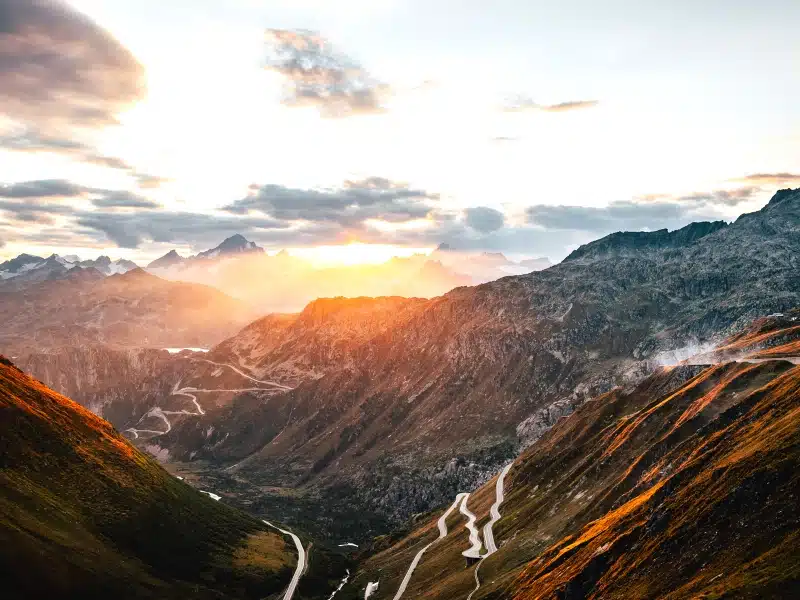
Where is Switzerland?
Switzerland is a small mountainous country located in central Europe, most famous for the Dufourspitze, the second-highest mountain in the Alps, deliciously creamy Swizz chocolate, secretive Swiss banks, and Heidi, Switzerland’s most well-known literary character.
This landlocked country is home to 451 mountains and is about the size of New Jersey and is sandwiched between France and Italy , and also bordered by Austria , Germany , and Liechtenstein, which lend a cosmopolitan culture and outlook to the country.
Switzerland is not a member of the European Union or European Economic Area but it is part of the Schengen Area, meaning any time spent touring Switzerland by car counts toward your 90 in 180 days allowance.

Getting to Switzerland
Whether you’re taking a road trip to Switzerland in a car, motorcycle, or campervan, self-driving is absolutely the best way to explore this spectacular European country.
You can stop whenever you want, try new activities, visit places you see along the route, and have the freedom to change plans at the last minute.
Fly into Zurich Airport to start your Switzerland road trip. With direct flights from America, Europe, and the UK, we recommend booking through Skyscanner for live deals and the best prices.
Are you planning to rent a car in Switzerland? As one of the largest car hire aggregator companies in the world, we recommend Rentalcars.com because they have massive purchasing power which enables them to secure the best car rental prices, which benefits you when you’re planning a road trip.
For a real adventure, hire a motorhome or campervan in Switzerland. We recommend Motorhome Republic , an aggregate booking site who pull together all the best deals from a number of rental agencies, to offer you a wide choice of options alongside an excellent English speaking expert motorhome Concierge Team.
Traveling in Switzerland by Car
The Swiss make it easy to see their breathtakingly beautiful country, with great roads and a well-managed and maintained network of trains, boats, and cable cars. It’s surprisingly easy to see the mountains and gain real elevation without being a super-fit hiker – everywhere you go, there are mechanical means to help you enjoy the peaks.
Although this is a Swiss Alps road trip guide, you will definitely be using trains, cable cars, and boats to see some of the top sights and attractions. If you prefer to arrange your own trips, a virtual Swiss Travel Pass offers unlimited travel on all Swiss trains, buses, and boats and discounted or free admission to many Swiss attractions including museums and mountains.
An alternative is the Swiss Half Fare Card which gets you 50% discounted tickets on standard fares for trains, buses, boats, and cable cars in Switzerland, for one month. This is not a virtual card, however, and you’re still required to physically purchase your tickets.
RELATED POST: Driving in the Alps: Top Tips & Best Routes
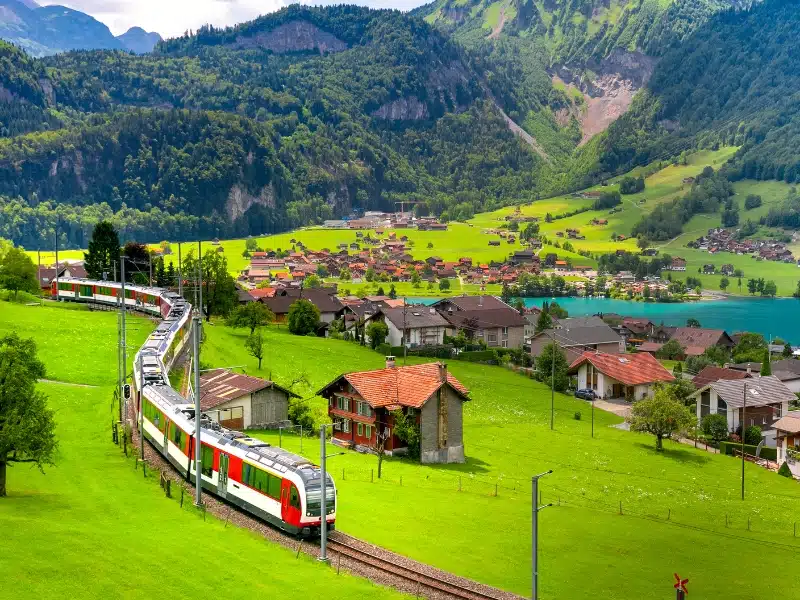
Looking for the best SIM card deals in Europe for your trip? Check out our guide to the best data SIMs in Europe and get the best deal for your trip to Switzerland.
Road Trip Switzerland: Best Time to Go
March to may.
Spring is a wonderful time to visit Switzerland, with temperatures warming up across the country. Blooming wildflowers, vibrant greenery in the mountains and cows heading out to pasture mean spring is a fantastic time to experience Switzerland by car. You’ll find the roads and cities less crowded, and most attractions will be open.
June to August
In summer, Switzerland enjoys beautiful weather and the prospect of water sports, mountain hiking, and dining al fresco. This is when locals and visitors alike head to the lake shores and mountains, meaning heavier crowds and more traffic.
September to November
Autumn is a fantastic time for a Swiss road trip . The grapes and crops are being harvested, food festivals celebrate the bounty of the land, and you might enjoy an Indian summer, with the fall colors of the vines aflame.
December to February
The winter months in Switzerland can be very cold, but most people come to Switzerland during the months of December to March for winter sports like skiing and snowboarding. It’s not the best time for a road trip, as the spectacular mountain passes will be closed and roads can be challenging to drive.
RELATED POST: The Best of Switzerland in Summer: 17 Amazing Highlights
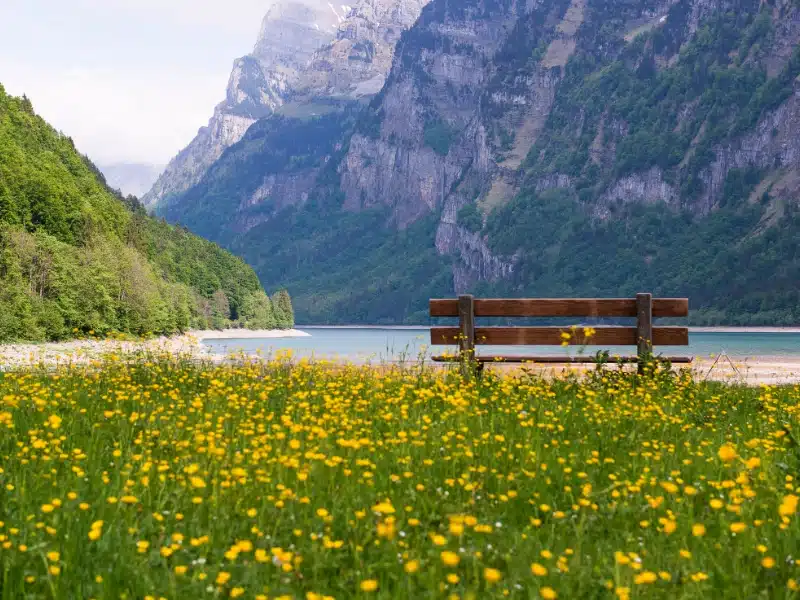
Make sure you have travel insurance you can trust when visiting Switzerland. We recommend True Traveller for their 5-star TrustPilot reviews, variety of cover options, best activities cover as standard, great prices, and excellent service.
Switzerland Road Trip Map & Route
We recommend completing a circular route during your road trip around Switzerland, starting and ending in Zurich. Zurich, the global capital of banking and finance, is home to Switzerland’s largest international airport.
Our two week Switzerland road trip will take you on a spectacular, circular drive through Switzerland’s iconic landscapes, covering roughly 1000km south across western Switzerland to Geneva before heading east towards Zermatt and eventually back north to Zurich.
Starting in Zurich, your first stop will be Bern, found within the curves of the Aare river. Bern is the capital city of Switzerland and is known for its 12th century architecture that forms the old town or Alstadt . Your visit to Bern would be incomplete without exploring Lake Brienz, just north of the Alps, which offers breathtaking mountain views.
After your trip to Bern, begin traveling south to Lausanne, Geneva, and Montreux, visiting Lac Léman en route.
The following stretch of your trip will provide unrivaled views of Les Diablerets as you head towards Zermatt where you will be met with the iconic Matterhorn, a mountain in the Swiss Alps.
At this point, your road trip will begin taking you north. Drive towards Interlaken, Lauterbrunnen, and Grindelwald where we recommend stopping at the famous Victoria Jungfrau Grand Hotel located in the mountains of Bernese Oberland, the perfect place to celebrate a special occasion.
As you leave Grindelwald, make sure you save time for the Furka Pass as you head to Lucerne. Our Swiss road trip itinerary will continue north to our initial starting point, the city of Zurich.
- Get the Travel Guides
- Lonely Planet Switzerland
- The Rough Guide to Switzerland
- DK Eyewitness Switzerland
Switzerland Road Trip Itinerary
Zurich – Bern – Lausanne – Geneva – Montreux – Nendaz – Zermatt – Interlaken – Lauterbrunnen – Grindelwald – Furka Pass – Lucerne – Zurich
- Distance 991km
- Duration 10-14 days
- Drive Time 17 hours
How to use this map – Use your fingers (or computer mouse) to zoom in and out. Click or touch the icons to get more info about a place, and click the arrow in the box top left to open the index. To add to your own Google Maps account, click the star next to the title of the map.
Flying into Zurich and renting a car is the easiest way to kickstart your Switzerland road trip. Get our one day Zurich itinerary complete with map, recommendations & Zurich travel tips to help plan your trip to this stylish and cultured Swiss city.
Zurich’s old town is full of cobbled streets with cozy bars, traditional Swiss restaurants, and art museums. It is also home to some of Zurich’s famous Romanesque churches. You can indulge in fabulous shopping on the Bahnhofstrasse with its luxury boutiques, visit Lindenhof Hill with its fantastic views of the city, and sample the famous Lindt chocolate.
If you prefer to have your day organized for you, check out this popular and highly rated private tour with a local guide and get to know the beautiful city of Zurich with a professional guide who will show you the city’s hidden gems and also help you experience this popular destination like a real local.
In the evening, head for Seebad Enge , one of Lake Zurich’s swimming pools, which turns into a lively bar at night. Stop here for a cold beer and a homemade grilled snack to start your evening off the right way, before heading to Oepfelchammer . A mainstay of Zurich dining since 1801, Oepfelchammer is the place to go if you want traditional Swiss food made with regional and seasonal produce.
- Where to Stay in Zurich
Upmarket: Marktgasse Hotel – Booking.com | Agoda
Mid-Range: Placid Hotel Design & Lifestyle – Booking.com | Agoda
Budget: Meininger Hotel – Booking.com | Agoda
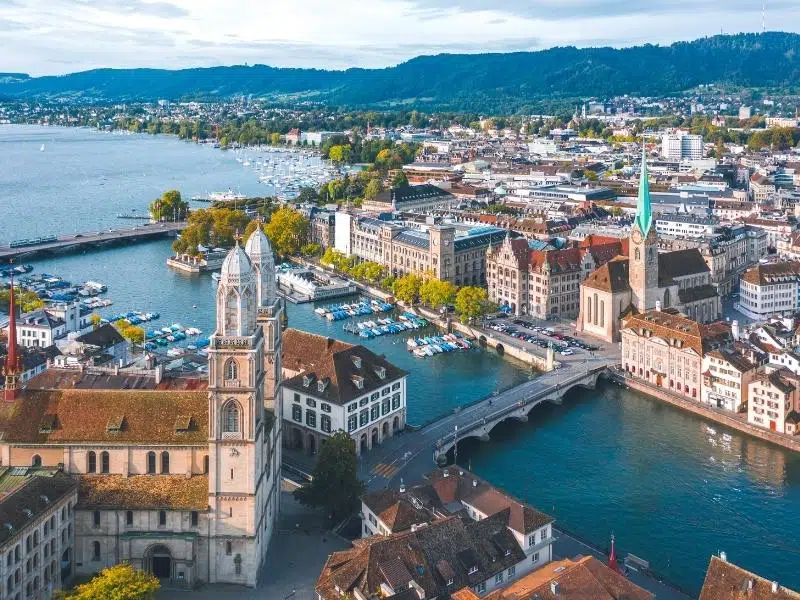
Rhine Falls Side Trip
Just under an hour away from Zurich in Schaffhausen are the Rhine Falls, the largest waterfall in Europe with a width measuring 150m (492ft) and a height of 23m (75ft). Over 600,000 liters of water per second plunge over the falls in the summer.
There is an elevator to take you up from Laufen Castle to the viewing platforms for a breathtaking view of the falls. A boat ride to the falls basin is also on offer, and well worth the time. Across the river is a huge rope park, so you can glide from tree to tree and admire the falls from every angle.
If you prefer not to drive, there are lots of day trips to the Rhine Falls from Zurich, but we think this highly recommended Rhine Falls day trip from Zurich is the best. Your driver will take you through a scenic landscape of charming villages to visit the Rhine Falls, you’ll cross the river to the Belvedere Trail viewing platform for incredible views, and learn about the medieval history of Stein am Rhein.
Driving from Zurich to Bern is a scenic journey that takes approximately an hour and 20 minutes, depending on traffic conditions. From Zurich, you will head towards the Swiss Alps, passing through picturesque villages along the way.
Travel Tip: We would highly recommend taking a detour on your drive from Zurich to Bern to visit the UNESCO Biosphäre Entlebuch . This Swiss national park is a biosphere reserve that encompasses approximately 39,000 hectares and is an incredible expanse of the untouched Swiss landscape.
Bern, the capital of Switzerland, is renowned for its well-preserved old town, a UNESCO World Heritage Site, its historic clock tower, the Zytglogge, which is one of the city’s most recognizable landmarks, and the Bear Pits, or Bärengraben , where bears have been housed since 1513 and have come to symbolize the city.
Bern has a variety of unique experiences to offer and the best way to see the city is with our recommended guided walking tour where you’ll have the opportunity to admire Bern’s fountains, towers, quaint streets, and arcades as you learn about the city’s 800 years of history from a local guide.
- Where to Stay in Bern
Upmarket: Stay KooooK Bern City – Booking.com | Agoda
Mid-Range: Los Lorentes Hotel Bern City – Booking.com | Agoda
Budget: Bern Backpackers Hotel Glocke – Booking.com | Agoda
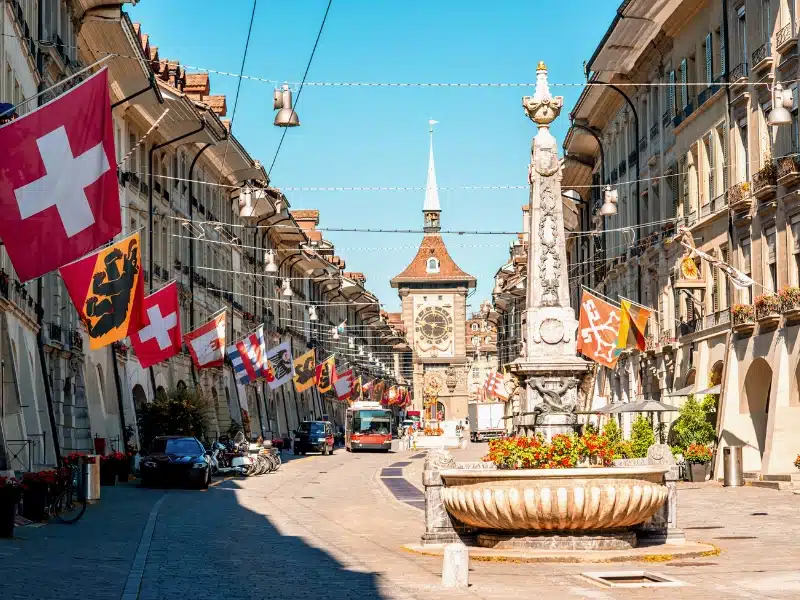
Don’t forget your road trip essentials! Our free road trip checklists help you remember everything, including road trip snacks , podcasts , and road trip songs for the journey!
As you leave Bern and head towards Lausanne, you will be surrounded by the Swiss Alps, offering breathtaking views of the country’s mountainous natural beauty. However, as you draw closer to Lausanne, the scenery will change from mountains and rolling hills to the shores of Lake Geneva, also known as Lac Leman, where the city of Lausanne is located.
Lausanne is home to a number of historic churches, including the Cathedral of Notre Dame, as well as several museums and art galleries, including the Olympic Museum , a must-visit for sports fans.
Lausanne is a foodie’s paradise. Be sure to sample some of the local specialties, such as fondue, raclette, and rosti, while enjoying the stunning views of Lake Geneva.
Travel Tip: From Lausanne, you can take a day trip to Glacier 3000 , an alpine experience near Les Diablerets. A 15 minute cable car journey will give you 360-degree views of the Swiss mountains. Once at the summit, you will enjoy spectacular views of Lac Leman. The Glacier 3000 Peak Walk, the only bridge in the world connecting two summits, provides daring visitors with panoramic views of the alpine landscape.
- Where to Stay in Lausanne
Upmarket: Hotel Angleterre & Résidence – Booking.com | Agoda
Mid-Range: Moxy Lausanne City – Booking.com | Agoda
Budget: Hôtel du Marché – Booking.com | Agoda
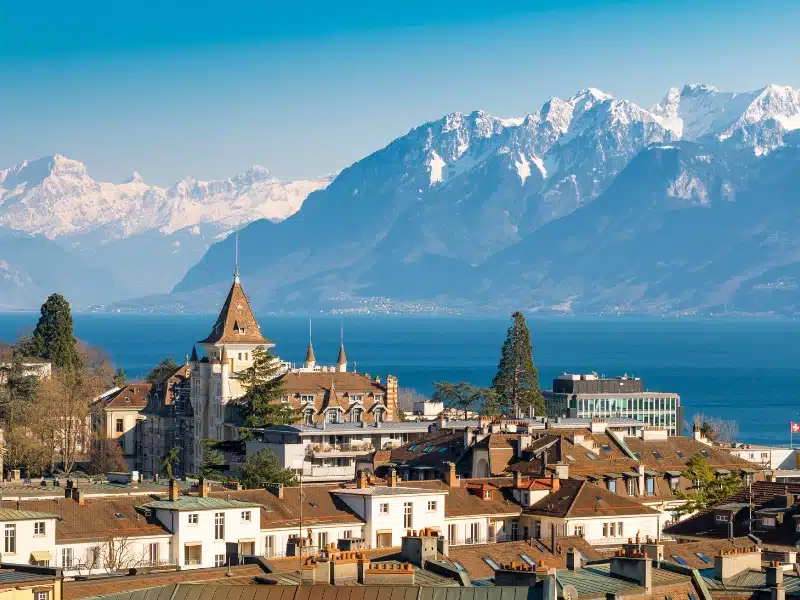
Other Nearby Road Trips
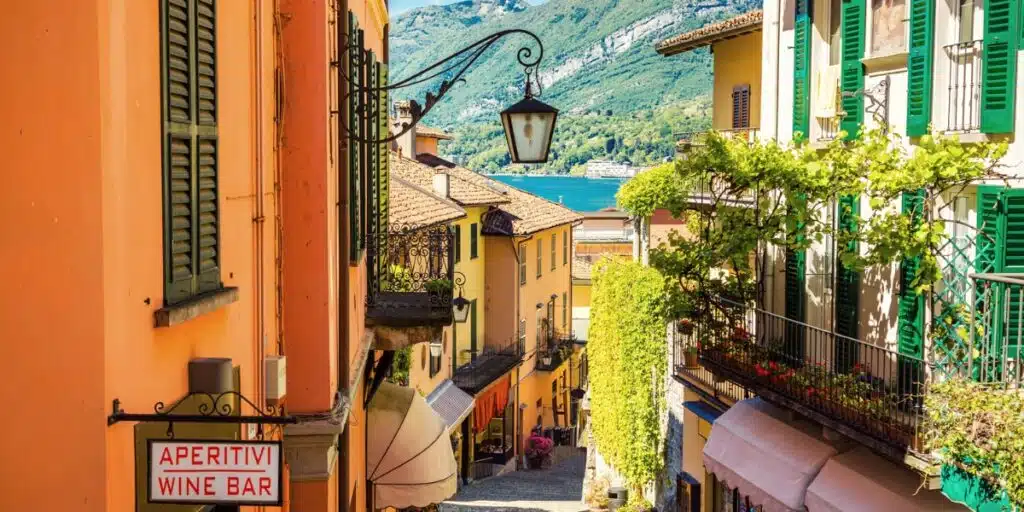
Northern Italy Road Trip: Itinerary, Map & Tips
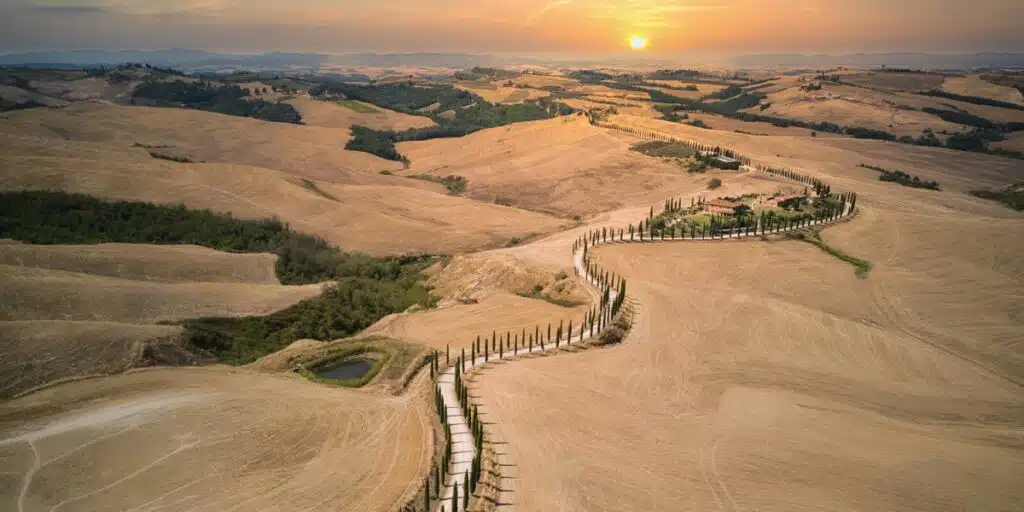
Tuscan Road Trip: Itinerary, Map & Tips
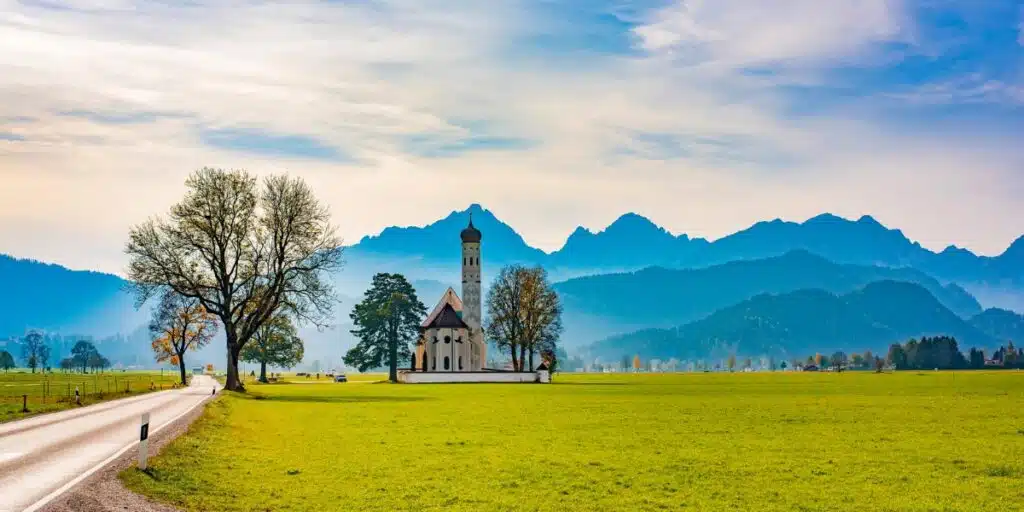
Romantic Road Germany: Itinerary, Map & Tips
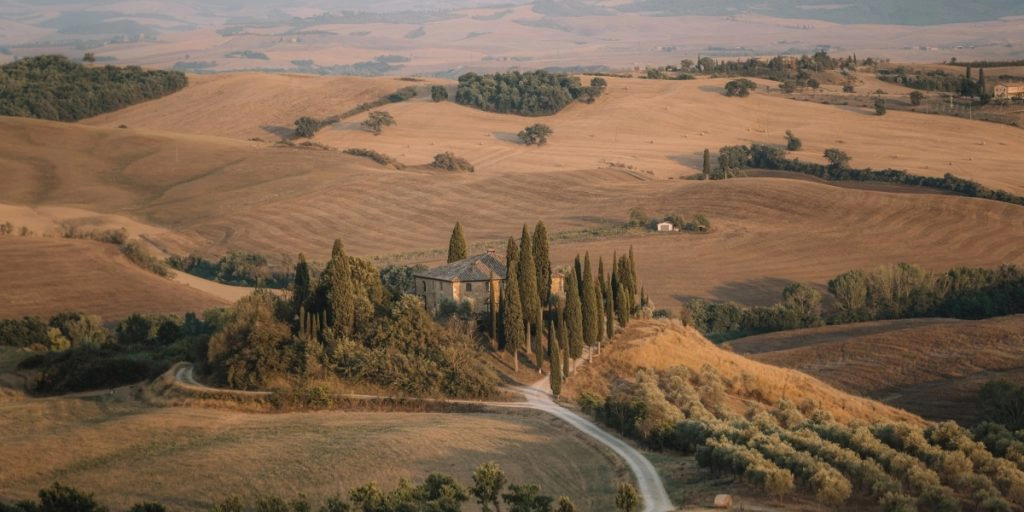
The Ultimate Bucket List Italy Road Trip
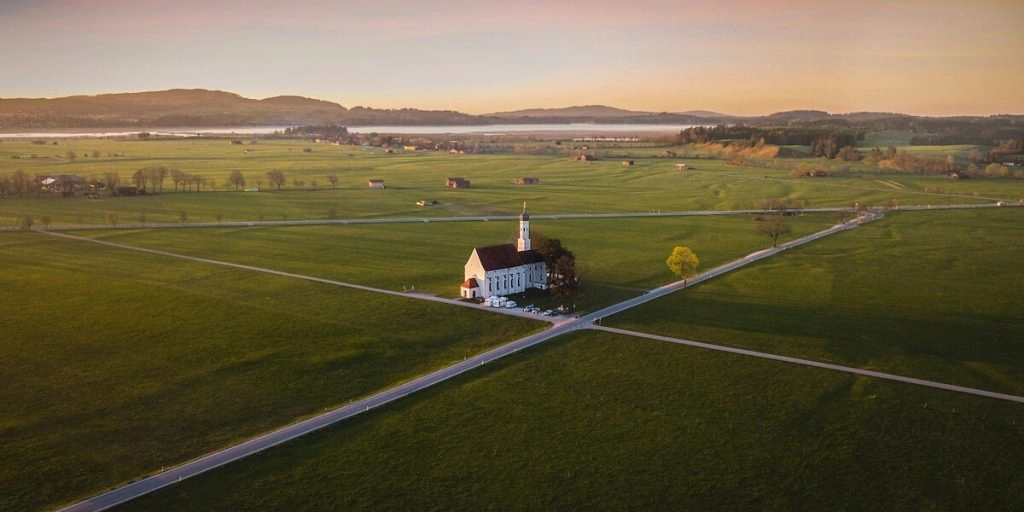
Six Unmissable Germany Road Trip Routes
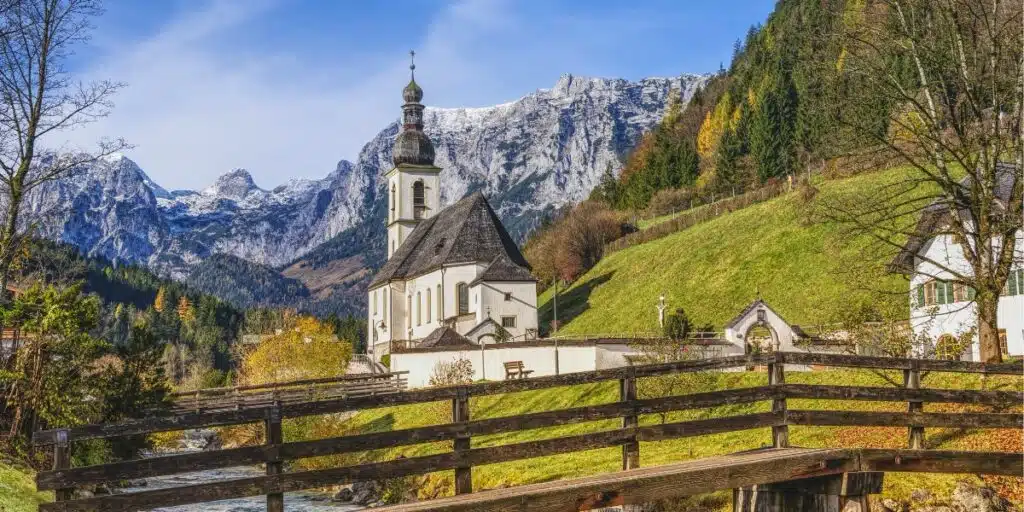
Deutsche Alpenstrasse: Route, Map & Highlights
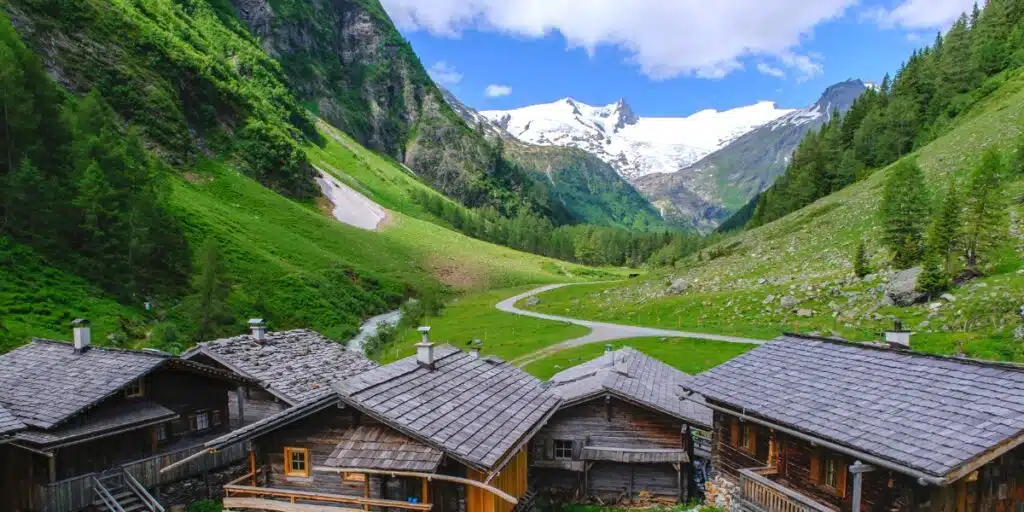
Austria Road Trip: The Best Itinerary, Map & Tips
Driving from Lausanne to Geneva takes approximately 45 minutes and takes you along the shores of Lake Geneva, offering stunning views of the lake and the surrounding mountains. Geneva is also the place where our Switzerland road trip route crosses with the Grand Tour of Switzerland route, which takes in five alpine passes, twelve UNESCO World Heritage sites, and 22 lakes.
Travel Tips: There are many mountain peaks along this route. If you love walking, why not consider stretching your legs and exploring the areas surrounding La Dôle, Le Noirmont, or Crêt de la Neige?
As you approach Geneva, you will be greeted by the city’s modern skyline, punctuated by the iconic Jet d’Eau, a 140-meter-high fountain located in the heart of the city.
Geneva is renowned for its rich history, beautiful parks and gardens, and world-class museums, including the Museum of the International Red Cross and Red Crescent. We would highly recommend a Lake Geneva cruise to enjoy scenic views of the Swiss and French Alps, as well as Geneva’s landmarks, from the waters of Lake Geneva.
- Where to Stay in Geneva
Upmarket: Hôtel Longemalle – Booking.com | Agoda
Mid-Range: Hotel Mon Repos – Booking.com | Agoda
Budget: Meininger Hotel Genève – Booking.com | Agoda
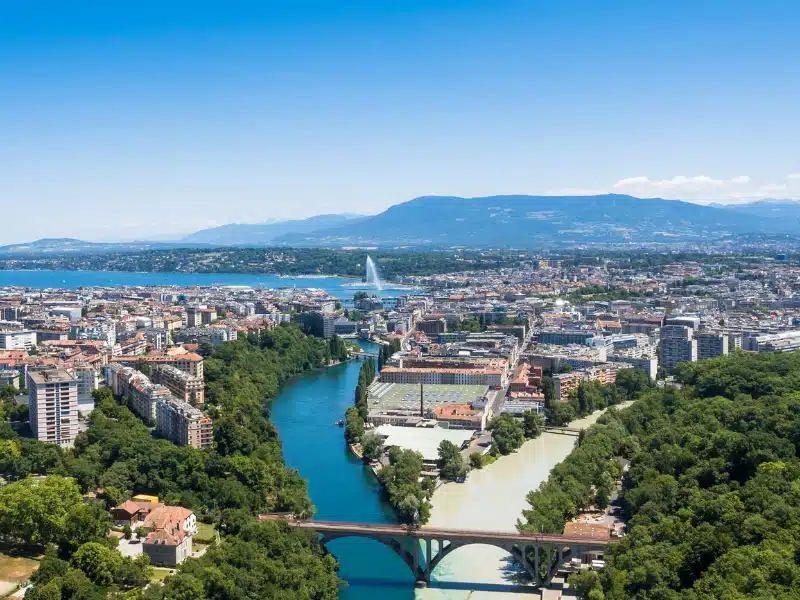
Want to plan your own road tri p? Get our step-by-step road trip planning guide to help you organize the perfect trip, or check out our Europe road trip ideas .
Montreux
Driving from Geneva to Montreux will take you further along the shores of Lake Geneva and through the picturesque Swiss countryside. The mild climate of Montreux, with a backdrop of the Swiss Alps, makes it a popular destination for both locals and tourists
Montreux is home to a number of cultural and historical landmarks, including the Château de Chillon, a medieval castle located on a small island in the lake. The city is also renowned for the Montreaux Jazz Festival , which takes place every summer and attracts music lovers from all over the world, and as the home of Charlie Chaplin and his family at Manoir de Ban in Corsier-sur-Vevey for 25 years.
Travel Tip: The Lavaux Vineyard Terraces are a UNESCO World Heritage Site located a 20-minute drive from Montreux. They feature miles of vineyards along the hillsides of Lake Geneva and are a must-see for wine lovers.
- Where to Stay in Montreux
Upmarket: Grand Hotel Suisse Majestic – Booking.com | Agoda
Mid-Range: La Rouvenaz – Booking.com | Agoda
Budget: Bon Port – Booking.com | Agoda
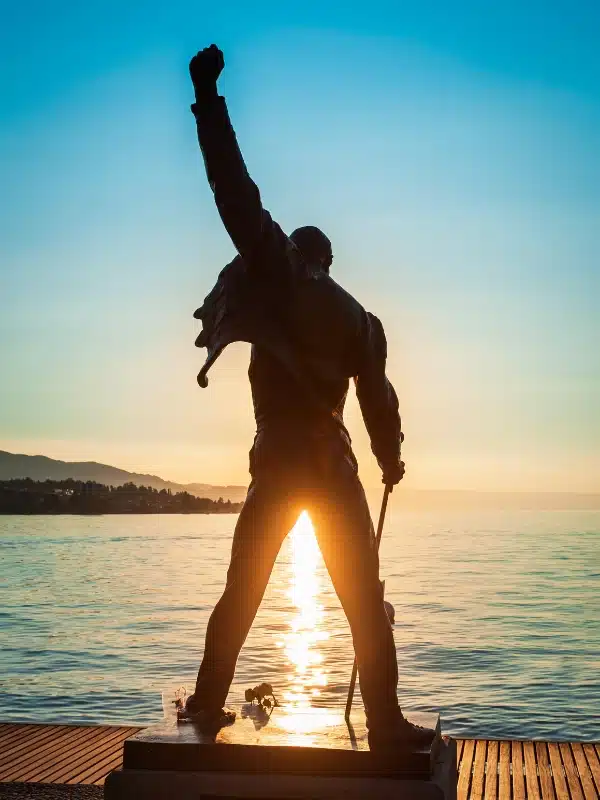
It’s worth making a stop at Nendaz, at the foot of Mount Tracouet. You won’t be surprised to learn that there is a traditional cable car up the mountain, helping you to enjoy the incredible landscape which surrounds you.
If you’re passing Nendaz in summer you may be lucky enough to experience the Swiss Alphorn Festival . This annual festival held in late July celebrates a work of Swiss tradition and history. The alphorn is a longhorn (around 11 feet) made of wood, historically used as a means of communication, and now used in Swiss folk music.
During the festival, alpenhorn blowers from the entire world descend for the official alphorn blowing competition, a trachten parade featuring folk costumes, concerts, folklore events, village balls, and an alphorn concert which involves a band with over 150 alphorn players! This really is a spectacle and very worth seeing.
- Where to Stay in Nendaz
Upmarket: Nendaz 4 Vallées & Spa – Booking.com | Agoda
Mid-Range: Le Cret Haute Nendaz – Booking.com | Agoda
Budget: Gîte de Planchouet – Booking.com | Agoda
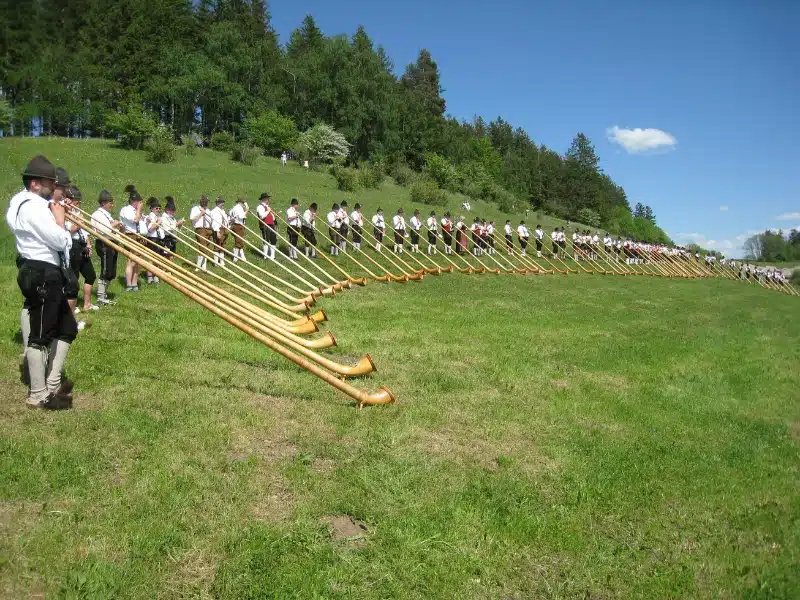
Zermatt
The drive from Montreux to Zermatt will be one of the longest legs of your trip! However, driving this incredible route will be an unforgettable experience as you further explore the beauty of the Swiss Alps.
As you approach Zermatt, you will be surrounded by towering, mountain peaks offering a glimpse into the heart of the Swiss wilderness. Zermatt is one of Switzerland’s most famous mountain resorts and is renowned for its ski slopes and breathtaking views of the Matterhorn, one of the most iconic peaks in the Swiss Alps.
Did you know that Zermatt is car free? You have to leave your car at one of the parking facilities in nearby Täsch. From there, Zermatt is 12 minutes awy by train, or you can grab a taxi direct to your hotel.
Definitely set aside time to hike in the Matterhorn Valley! We recommend the stunning five lakes hike, which passes the unique lakes of the Stellisee, Grindjisee, Grünsee, Moosjisee, and Leisee, the latter of which is good for swimming. This is a moderately easy walk and you can reach the trailhead by taking the Sunnegga funicular from Zermatt, and then the gondola to Blauherd.
As well as hiking, Zermatt offers a range of other outdoor activities. With over 360km of ski slopes, Zermatt is one of the largest ski areas in the Swiss Alps and offers skiing, snowboarding, and snowshoeing options for all levels.
A number of restaurants in Zermatt, such as Restaurant Zum See and The Cambrian , offer mountain views alongside locally sourced ingredients and traditional Swiss dishes.
Travel Tip: No trip to Zermatt is complete without a trip up the Matterhorn, which is one of the highest summits in the Alps at 4,478 meters above sea level. Take the Matterhorn Glacier Paradise Cable Car or the Gornergrat Bahn Cogwheel Train to the top for panoramic views of the Swiss Alps and the Matterhorn.
RELATED POST: Most Beautiful Places In Switzerland That You Must Visit!
- Where to Stay in Zermatt
Upmarket: Hotel Schweizerhof Zermatt – Booking.com | Agoda
Mid-Range: Le Mirabeau Hotel & Spa – Booking.com | Agoda
Budget: Hotel Bahnhof – Booking.com | Agoda
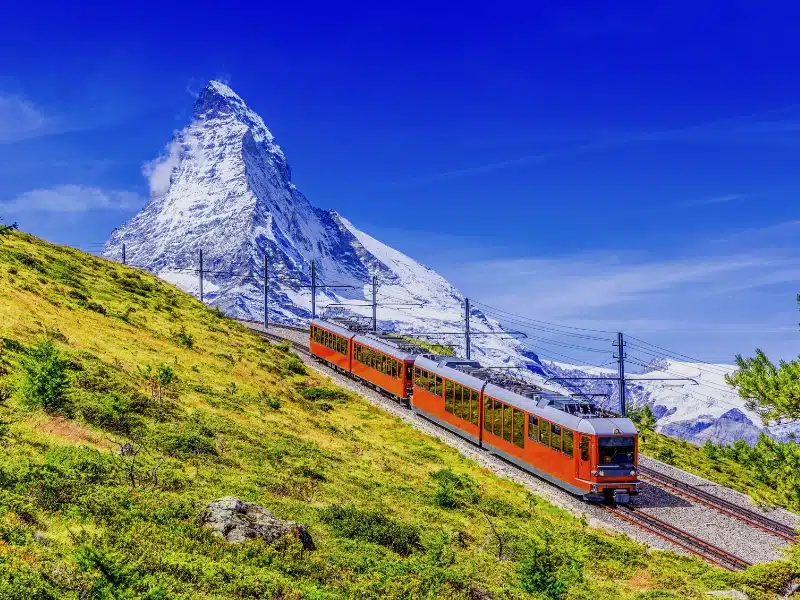
Interlaken
The drive from Zermatt to Interlaken takes you south through the towering peaks of the Swiss Alps. On route, you will pass the Weisshorngruppe. This mountain range is dominated by the Weisshorn peak, which reaches a height of 4,506 above sea level and provides a spectacular backdrop for your road trip.
There are lots of things to do in Interlaken and you can take in the cultural attractions, such as museums, churches, and traditional Swiss architecture.
Interlaken is also a popular destination for adventure sports enthusiasts, Interlaken offers a range of activities such as tandem paragliding , bungee jumping, and white-water rafting on the nearby Lütschine river .
Bordering Interlaken are Lake Thun and Lake Brienz. You can enjoy a range of activities on the emerald waters of these lakes. Lake Brienz offers jet boat tours and kayaking experiences while Lake Thun is home to the St Beatus Caves; a cave system featuring lit pathways through tunnels and chambers.
Travel Tip: While in Interlaken, take the time to visit the Harder Kulm viewpoint . With an altitude of 1,322 meters, this high vantage point allows visitors to enjoy unrivaled views of Interlaken and Unterseen.
- Where to Stay in Interlaken
Upmarket: Lindner Grand Hotel Beau Rivage – Booking.com | Agoda
Mid-Range: Hotel Chalet Swiss – Booking.com | Agoda
Budget: Walters Hostel Interlaken – Booking.com | Agoda
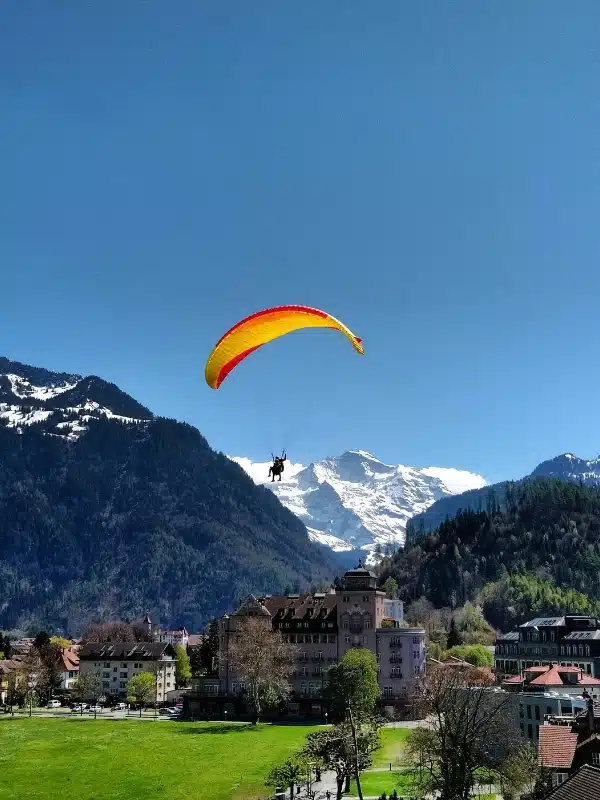
Jungfraujoch Side Trip
The Jungfraujoch is a topographical saddle connecting two major 4,000m+ mountains of the Bernese Alps – the Jungfrau and the Mönch. It lies at an elevation of 3,463 meters above sea level and is directly overlooked by the rocky prominence of the Sphinx, and the incredible Sphinx Observatory.
The Jungfraujoch Railway is the highest in Europe and trains leave Kleine Scheidegg railway station regularly throughout the year for the “top of Europe”. Once there, you can experience breathtaking views of the snow-capped Jungfrau-Aletsch region from the Sphinx Observation Deck and the Glacier Plateau, before hitting the snow park for snow tubing, sledding, and zip lining.
In the Ice Palace are intricately detailed ice carvings and sculptures of animals such as bears, penguins, and eagles, and you’ll also be able to learn about the history of the railway here. Just to top off your visit, nearby is Lindt Swiss Chocolate Heaven!
With over one million visitors a year, it’s best to book your Jungfraujoch tickets well in advance. With our recommended round trip to the top of Europe package , you get your train tickets, plus entry to all the Jungfaujoch experiences except the snow park. These tickets are on a buy now, pay later basis, so you can always cancel at no cost if your plans change.
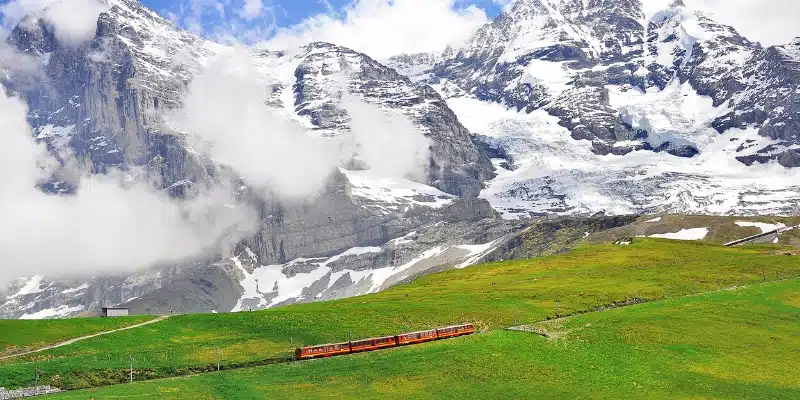
Lauterbrunnen
Driving for twenty minutes will take you from Interlaken to Lauterbrunnen. Lauterbrunnen is known for its 72 waterfalls, including the famous 300-meter-high Staubbach Falls, and the nearby Trümmelbach Falls, which gush through mountain crevices past viewing platforms.
Hiking, paragliding, rock climbing, and canyoning are all popular ways to experience what Lauterbrunnen has to offer. For a truly unique experience, consider viewing the landscape and the Bernese Alps from a hot air balloon.
Travel Tip: Lauterbrunnen and Mürren served as filming locations for the James Bond movie On Her Majesty’s Secret Service in 1969. From Stechelberg, get the Schilthorn cable cars to Bond World and the Birg Station at 2,970 meters. Once there, test your nerves on the Skyline Walk overlooking a vertical wall and tackle the Thrill Walk along a 200-meter cliff pathway, before walking the remaining distance to the iconic 007 Piz Gloria restaurant, which revolves to reveal a breathtaking 360-degree view of the Eiger, Mönch, and Jungfrau peaks.
- Where to Stay in Lauterbrunnen
Upmarket: Hotel Silberhorn – Booking.com | Agoda
Mid-Range: Hotel Schützen Lauterbrunnen – Booking.com | Agoda
Budget: Valley Hostel – Booking.com | Agoda
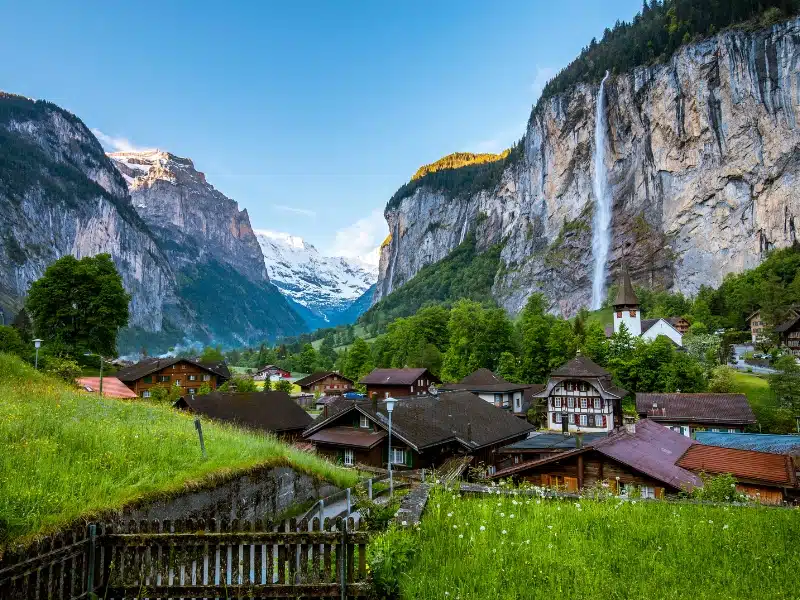
Grindelwald
The drive from Lauterbrunnen to Grindelwald takes approximately 30 minutes, depending on road conditions, passing traditional Swiss mountain chalets. These include Sulwald Stübli , a restaurant with mountain views that we highly suggest grabbing lunch in.
Grindelwald is surrounded by towering peaks including the famous Eiger mountain. The challenging hike along the Eiger Trail offers breathtaking views of this iconic mountain peak.
For a much easier walk, head to the First Cliff Walk at the summit of the First mountain at 2200m above sea level, a quick ride from the village on the Grindelwald Firstbahn cable car. The walk itself is along a metal walkway and a single-rope hanging bridge constructed along a cliff. At the end of the walkway, there is a spectacular observation platform that stretches out 45 meters above the mountains below.
We suggest experiencing the Grindelwald-Männlichen Cableway while in Grindelwald. This cable car ride offers panoramic views of the surrounding mountains and valleys, including the famous peaks of the Eiger and Wetterhorn.
Travel Tip: For an out-of-this-world experience, visit Grindelwald Glacier Canyon , an underground labyrinth carved out by the 250 million-year-old Grindelwald Glacier.
- Where to Stay in Grindelwald
Upmarket: Bergwelt Grindelwald Alpine Resort – Booking.com | Agoda
Mid-Range: Sunstar Hotel & Spa – Booking.com | Agoda
Budget: Grindelwald Youth Hostel – Booking.com | Agoda
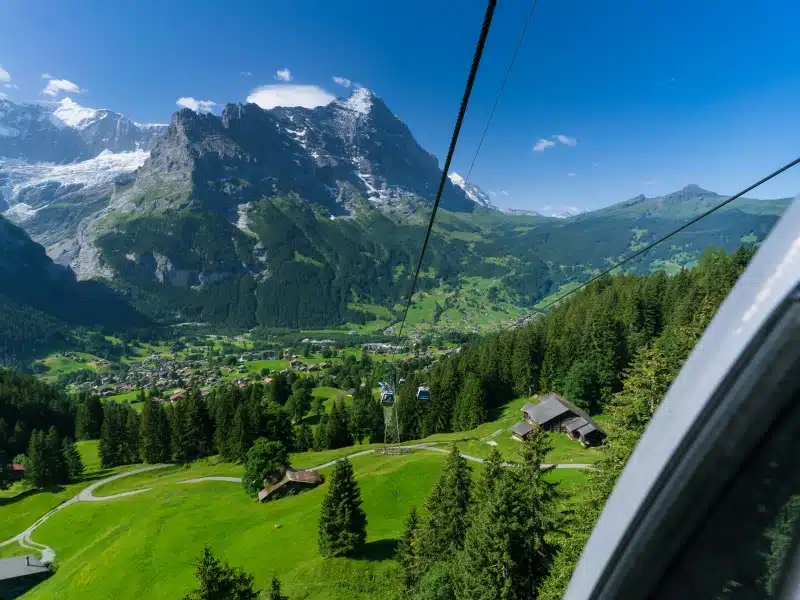
Furka Pass
To reach the Furka Pass, just over an hour from Grindelwald, you’ll first have to cross the Grimsel Pass, meaning you’ll bag two of Switzerland’s best driving roads in a day. These high-altitude mountain passes in the Swiss Alps are famous for their incredible scenic drives.
Remember, you will need to time your travel dates correctly to experience this world-renowned drive! The Grimsel and Furka Pass are only open between June and October due to travel conditions and snow on the roads, and will appear closed on our interactive map if you’re planning your route outside of the summer season.
When the road is closed you can transport your rental car by train in the Furka Base Tunnel , connecting Realp and Oberwald.
Travel Tip: The Furka Pass is located in a protected natural area, so be sure to follow Leave No Trace principles. Additionally, the road up the Furka Pass is steep, narrow, and winding, so it’s important to drive with caution, especially if you’re not used to mountain driving.
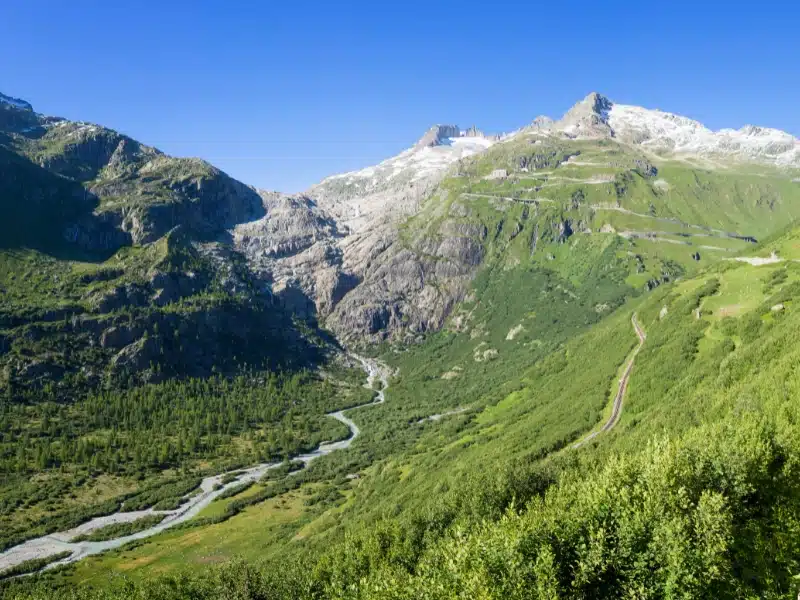
Lugano Side Trip
This is more of an optional extra than a side trip! On the other side of the Furka Pass, you have the option to head north on Route 2 to Lucerne, or south to Lugano, a good hour’s drive away. You’ll want a few days spare for this Lugano side trip!
Lugano is in an Italian-speaking region and has a distinctive Swiss-Mediterranean mix of cultures which are reflected in its architecture and cuisine. The city stands on the shore of beautiful Lake Lugano, surrounded by mountains, including Monte San Salvatore, and is full of lively squares, lakeside walks, fun shopping streets, and colorful parks.
To tick another country off your list, hop on a boat from the downtown pier of Lugano Centrale to either Porlezza or Ponte Tresa, both of which are in Italy.
The charming city of Lucerne is surrounded by rolling hills, forests, and lakes, showcasing the beauty of the Swiss countryside. A trip to Lucerne is incomplete without exploring Lake Lucerne. We would recommend experiencing the lake on a boat tour, by kayaking or paddleboarding.
While in Lucerne, we would recommend taking a Lucerne city tour to see the Chapel Bridge, the Lion Monument, and Lucerne’s historic old town. While visiting this city, you can also take a brilliant Lake Lucerne and Mount Pilatus trip , known as the golden round trip, which takes you on a boat, cogwheel railway, aerial cableway, and finally a gondola offering panoramic views of the surrounding mountains and the city itself.
Driving from Lucerne to Zurich takes approximately 1 hour and 15 minutes and is the final travel day on your ultimate Switzerland road trip.
- Where to Stay in Lucerne
Upmarket: Grand Hotel National Luzern – Booking.com | Agoda
Mid-Range: Waldstätterhof Swiss Quality Hotel – Booking.com | Agoda
Budget: Anstatthotel Horw – Booking.com | Agoda
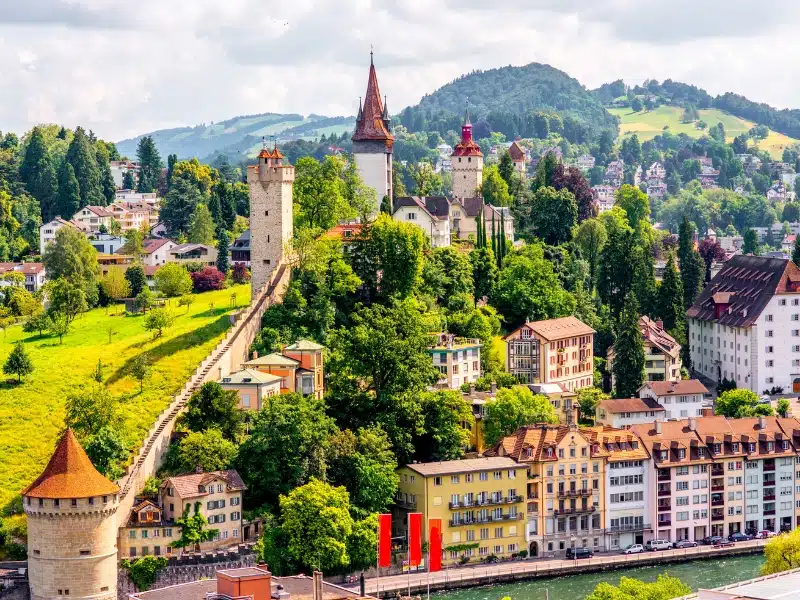
Mount Titlis Side Trip
A half-hour scenic drive from Lucerne to Engelberg will take you to an unmissable Swiss experience. The Titlis Glacier, found atop Mount Titlis is reached on the Rotair revolving cable car from Engelberg – yep, a rotating cable car!
You can also experience an unforgettable adventure on the Ice Flyer chairlift, step inside a glacier cave and cross the Titlis cliff walk bridge suspended high over the Swiss Alps.
If you prefer not to drive, this highly rated half day tour from Lucerne will transport you to Engelberg and include all the experiences Mount Titlis has to offer.
A road trip through Switzerland is filled with natural beauty, cultural richness, and adventure. From the rolling hills and pristine lakes surrounding Zurich, Bern, and Lucerne, to the stunning alpine landscapes of Zermatt, Interlaken, and Grindelwald, Switzerland offers a wealth of scenic vistas and outdoor activities.
Along the way, you can explore charming old towns, visit UNESCO world heritage sites, sample delicious Swiss cuisine, and relax in some of Europe’s most beautiful and serene natural settings.
Switzerland Road Trip Resources
Here are the websites and services we personally use and recommend for traveling in Switzerland.
- Search for affordable flights to Switzerland with Skyscanner
- Search for availability and book hotels and accommodation in Switzerland with Booking.com
- Find and book the best campsites in Switzerland with Eurocampings
- Book the cheapest and most reliable car rentals in Switzerland with Rentalcars.com
- Find and hire your perfect motorhome or campervan with Motorhome Republic
- Get highly rated, reliable, and trustworthy travel insurance with True Traveller
- Check if you need a visa and arrange your documents with Visagov
Tips for Driving in Switzerland
Travelling in Switzerland by car is a pleasure. The roads in Switzerland are well maintained and the drivers are courteous and measured. The engineering of the mountain passes and complex tunnels and bridges that ribbon across the landscape is a real marvel.
Whether you’re traveling in your own vehicle or flying in and renting a car, you need to follow these rules when you drive and travel in Switzerland;
- You must have at least three months remaining on your passport (issued in the past ten years) at your intended date of departure from Switzerland.
- You may need a visa to enter Switzerland, you can find out more on the State Secretariat for Migration website .
- You must have at least 3rd party insurance for your vehicle when you road trip in Switzerland.
- Citizens of non-EU third countries may require an IDP, you can check here .
- It is compulsory to carry a warning triangle inside the car, not in the boot.
- If you wear glasses you must carry a spare pair.
- You will require a Swiss motorway vignette or toll sticker if you want to use the autobahn. It’s almost impossible to avoid doing so, and it’s easy to buy a sticker online , at the border or at a service station just inside the country. If you’re renting a car, the vignette will be included.
- If you’re planning a winter road trip to Switzerland, you should carry snow chains. Road signs will let you know when you need to put them on the car.
- In Switzerland, motorists drive on the right and overtake on the left. Unless otherwise indicated, the vehicle coming from the right has priority at intersections.
- Drivers approaching roundabouts must give way to all traffic already on them unless otherwise indicated by signs.
- If you have a GPS navigation system that shows you where any speed cameras are, you must deactivate this function. Carrying or using radar detection equipment is illegal when driving through Switzerland.
- You may only use a mobile phone whilst driving with a hands-free device.
RELATED POST: Driving in Europe – Everything You Need to Know
Are you looking for more road trip inspiration? Check out these top posts…
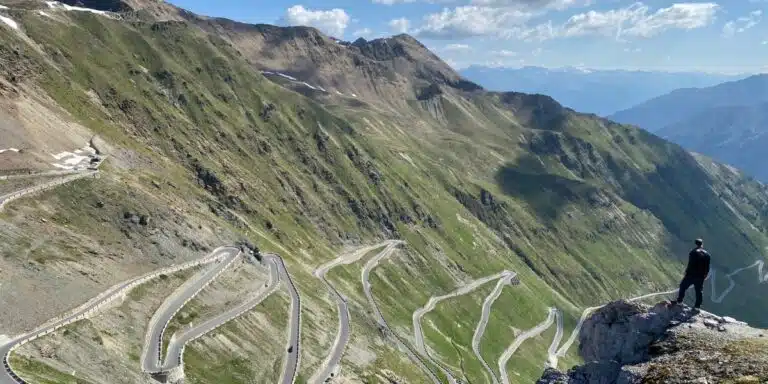
Stelvio Pass: The Best Mountain Road in Italy?
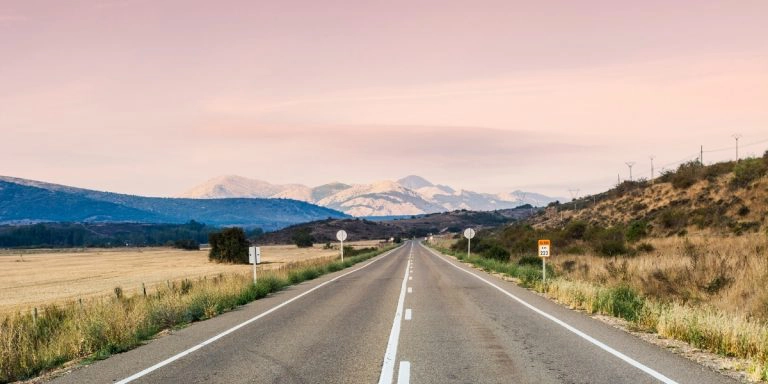
Spain Road Trip: 8 Amazing Routes for an Epic Trip
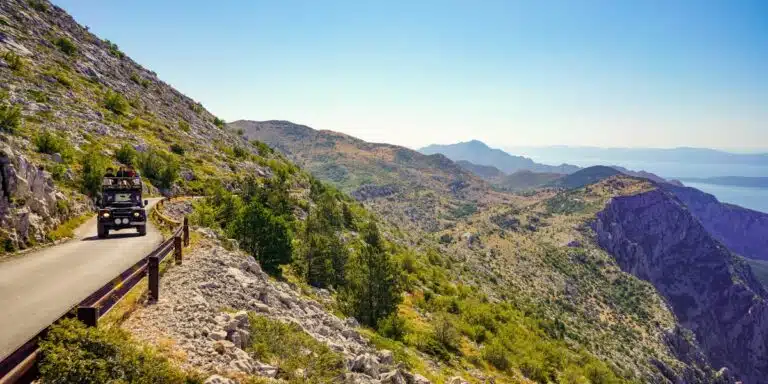
Croatia Road Trips: Five Incredible Routes
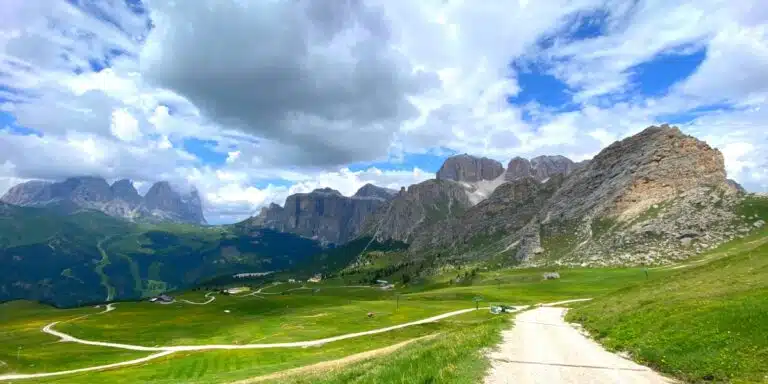
Dolomites Road Trip: Explore the Best of Northern Italy
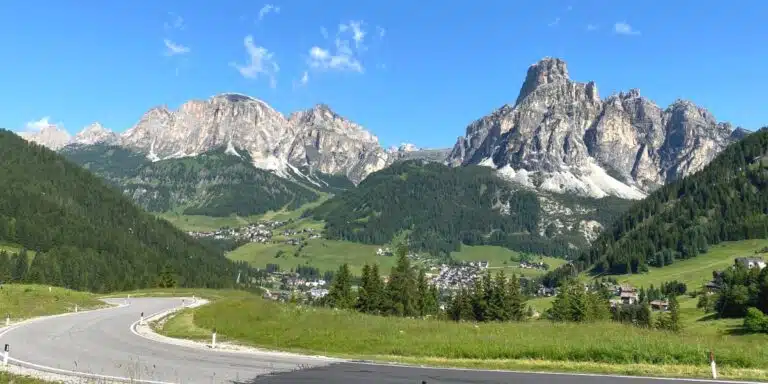
Great Dolomites Road: Absolutely Everything You Need to Know!
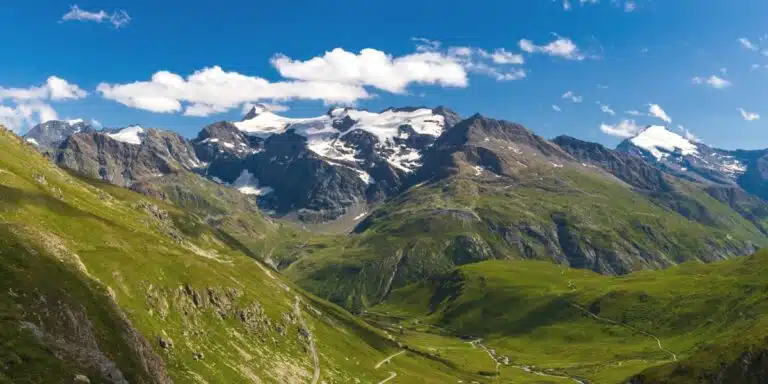
Route des Grandes Alpes: An Epic French Road Trip
Love it pin it.
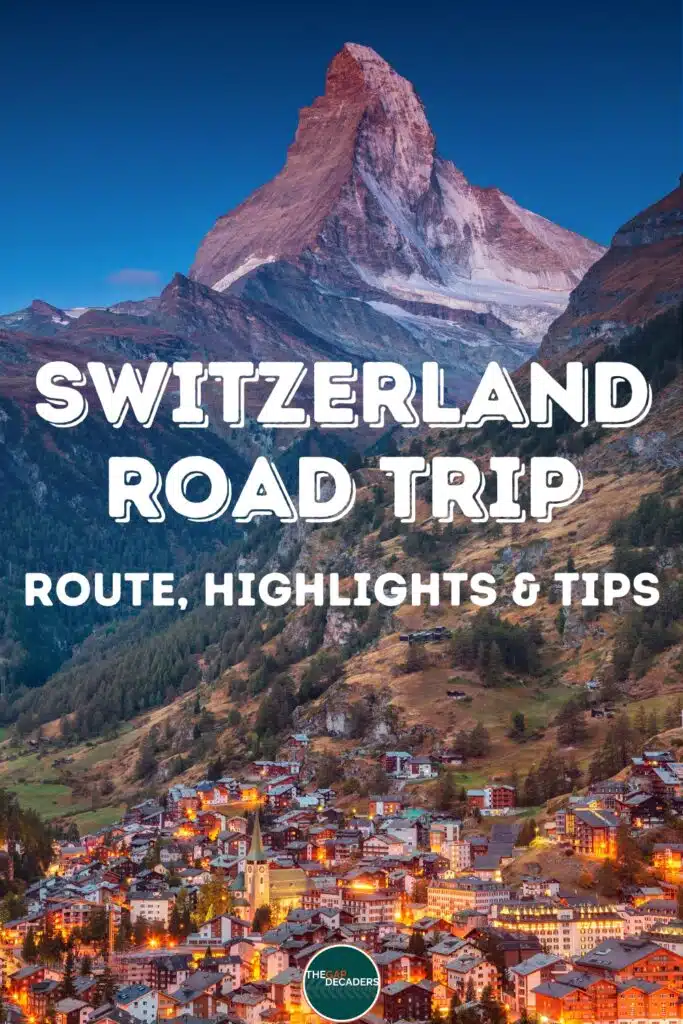

- The Ultimate Switzerland Road Trip Itinerary for 2 Weeks
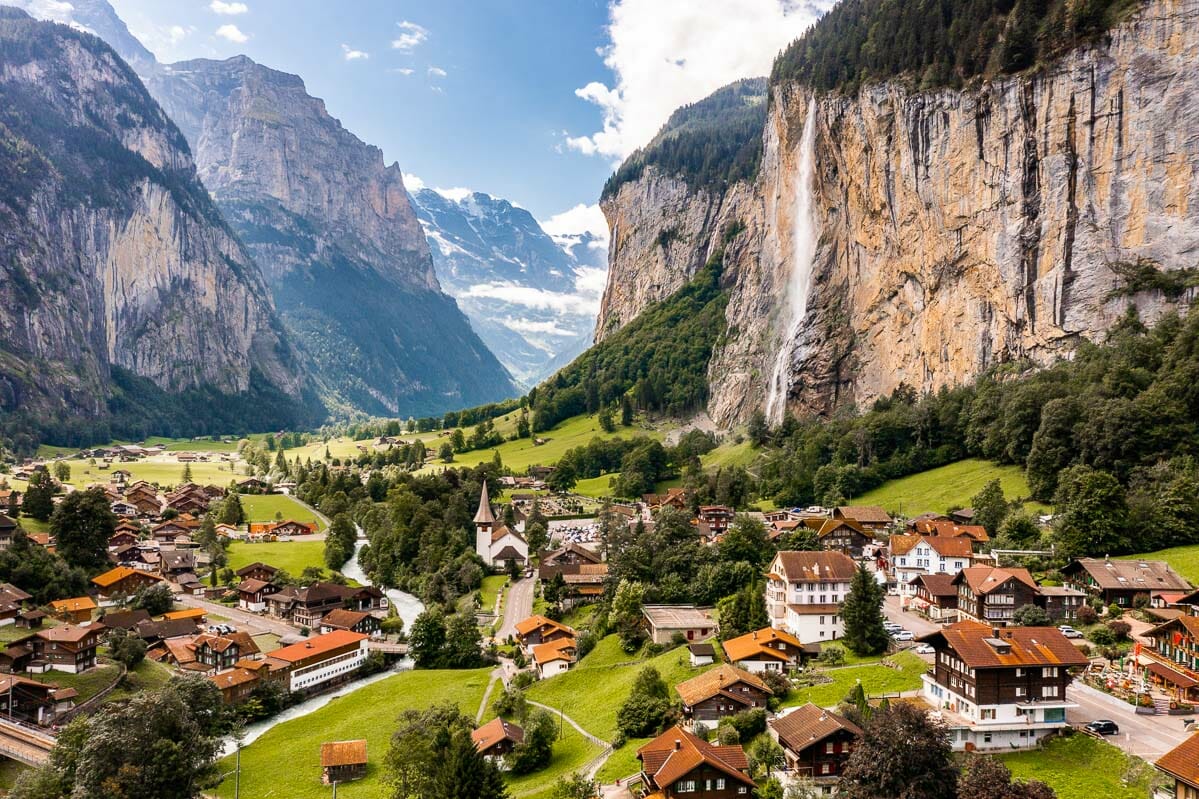
With its iconic mountains, alpine lakes, fairytale castles, and some of the most delectable chocolate on the planet, Switzerland is one of the best places in Europe to take a road trip. This spectacle of nature, history, and food are best experienced as part of a Switzerland road trip.
As there are so many regions and towns to explore in this small country, knowing where to start planning your route might feel overwhelming. Believe me, I know how you feel! I knew almost nothing about the country before we visited and it took me days (if not weeks) to put together the perfect Switzerland road trip itinerary.
We followed this same itinerary and it was absolutely perfect! This guide contains all you need to know to plan an epic 2 week Switzerland road trip and my itinerary also covers when to visit and all the most beautiful and fascinating places of interest in the country. Let’s get into it!
* Disclosure: This post contains a few affiliate links, which means I may receive a small commission, at no cost to you, if you make a purchase through my link. *
No time to read now? Pin it for later!
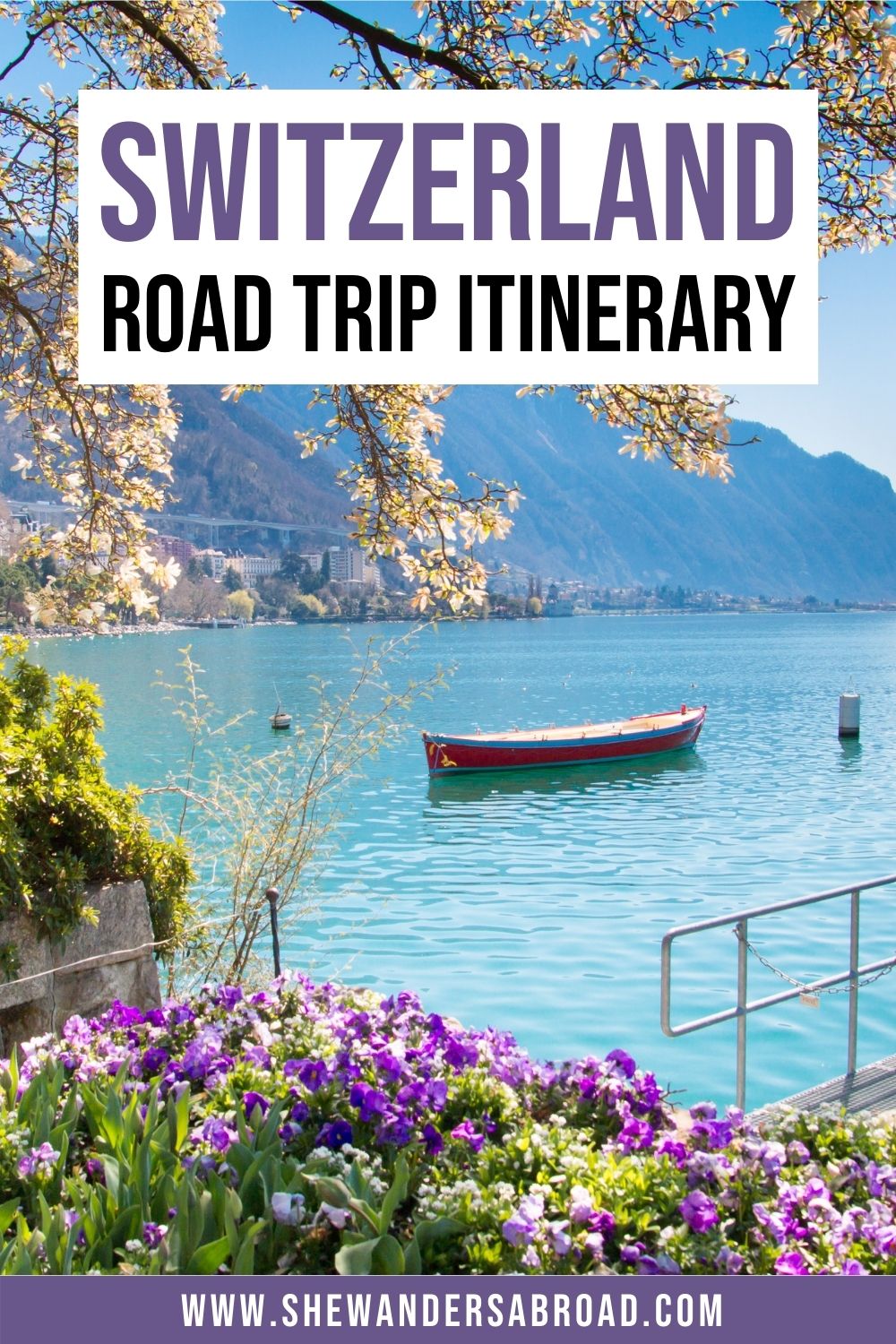
Table of Contents
Useful Info for Your Switzerland Road Trip
How to get to zurich .
This road trip starts and concludes in Zurich. The international airport, Flughafen Zürich (ZRH), is located 10 km (6.2 miles) north of the city center. You can fly direct to Zurich Airport from the vast majority of European and North American destinations.
Once at the airport, you can head into the city center by public transport as you will not need to collect your rental until the second day of your Switzerland road trip. Either hop on the S-Bahn train or take the tram (line 10) into the city.
Expect to pay 6.80 CHF (€7) or travel for free if you pick up a Zürich Card . This costs 27 CHF (€28) for a 24-hour pass which is sufficient for your one full day in Zurich .
This card covers your public transport via tram, bus, train, boat, and cableway in central Zurich and the surrounding area. It also grants free or reduced admission to a number of museums so if you’re planning to visit many museums, it’s handy to have!
If you are connecting to Zurich by train, then Zurich Main Station is located right in the heart of District 1 near the Old Town.
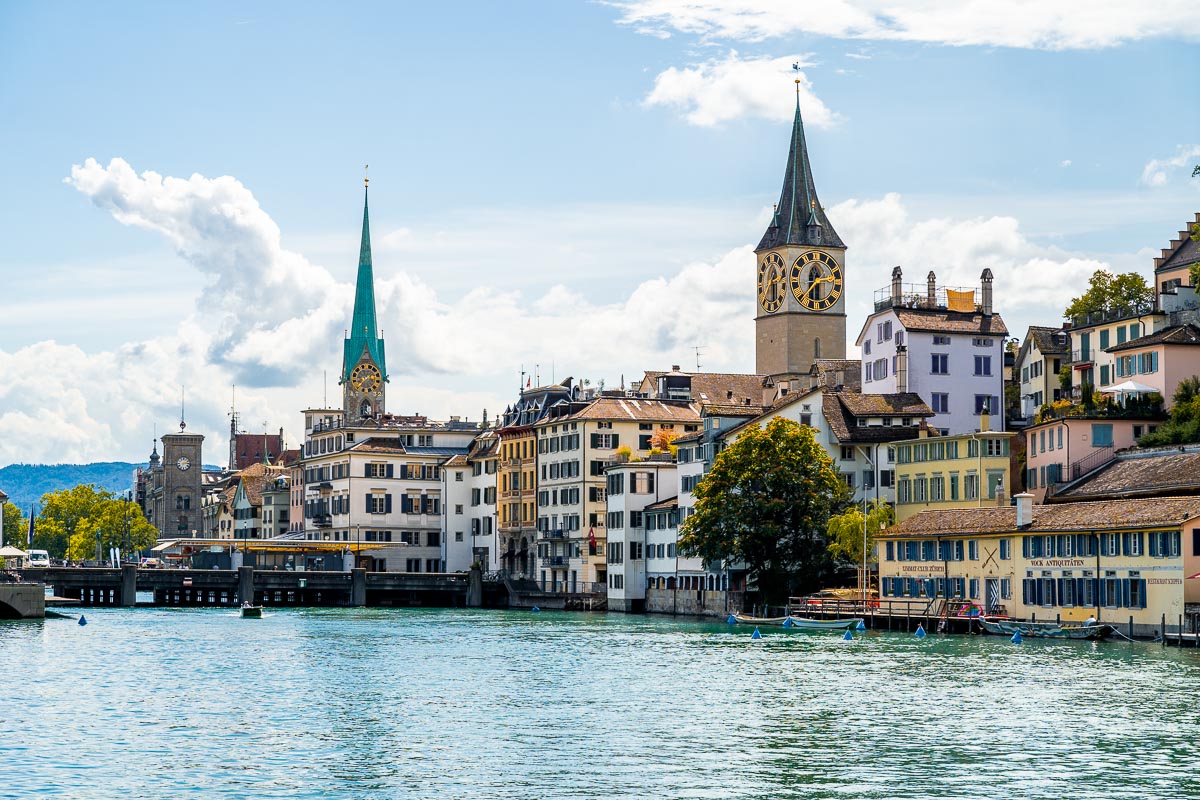
Best time to visit Switzerland
Switzerland is one of those places that you can visit at any time of year. However, for the purpose of this 2 week Switzerland road trip itinerary I recommend that you avoid the middle of winter and the peak of summer.
These are the busiest times as you will compete with summer tourists and the ski season, which means higher costs for accommodation and more crowds. It also means more challenging driving conditions and some road closures due to snowfall.
Spring, early summer, and autumn are the best time to arrange your road trip to Switzerland. During these seasons, the elevated mountain roads are open and the hikes that I’ve included in my itinerary are all readily accessible. The weather conditions are also comfortable with warm days and cooler evenings.
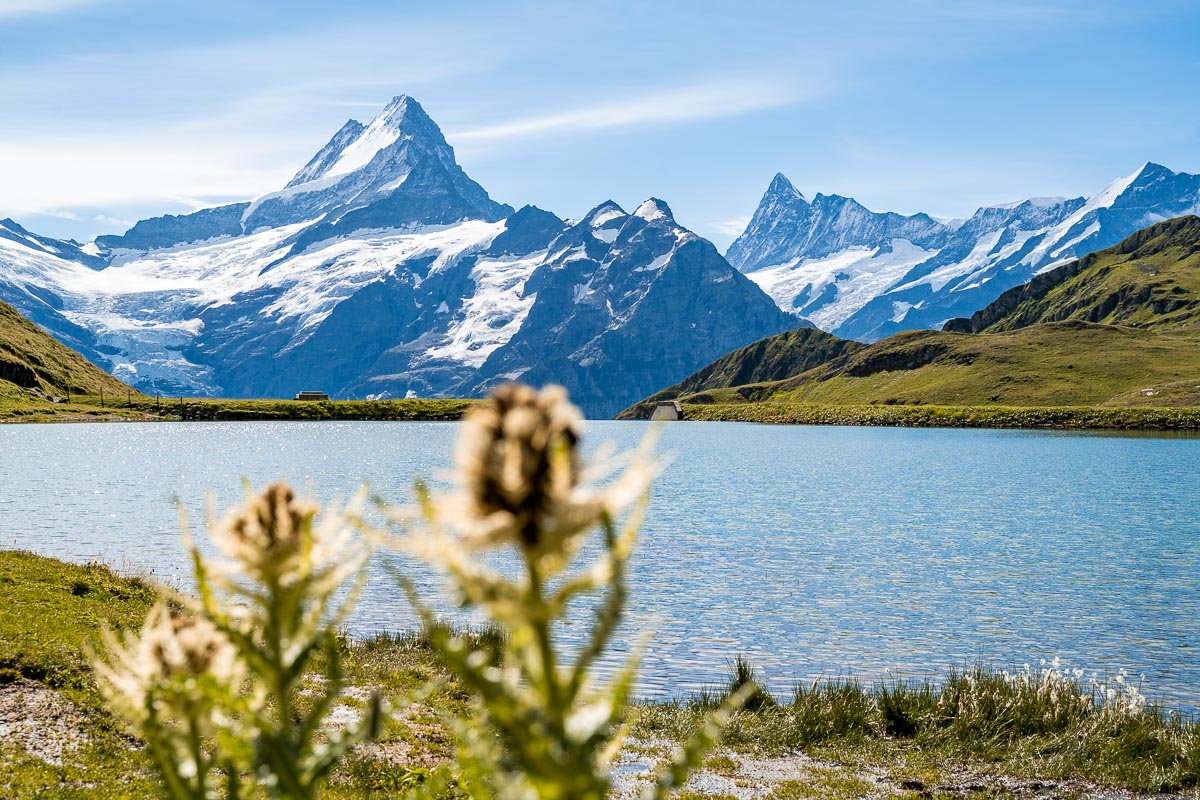
Tips for driving in Switzerland
Swiss roads are well maintained and are a joy to drive but you will need to be a confident driver to handle the narrow, twisty mountain roads.
As with all European countries, you must drive on the right and follow the general road rules and regulations. Wearing a seatbelt at all times is a given and you must never drink before getting behind the wheel.
Let me share some specific driving tips for your road trip to Switzerland:
- Before you drive or rent a car in Switzerland, you must possess a full driving license from your home country and an International Driver’s Permit (IDP). If your driving license was issued by one of the member states of the European Economic Area, you will not need the IDP as your license is valid in Switzerland.
- In general, the speed limits in Switzerland are 120 km/h (75 mph) on motorways, 100 km/h (62 mph) on highways, 80 km/h (50 mph) on other roads outside built-up areas, and 50 km/h (30 mph) in towns. Cars with a trailer may not exceed 100 km/h (62 mph) on any road. Traffic fines are really heavy in Switzerland and roads are policed so keep an eye on your speed at all times!
- You must display a motorway vignette on your vehicle. Discuss whether your car rental agency provides this automatically but if you have to buy it yourself, it will cost you 40 CHF (€42.30). The vignette will be valid for one whole calendar year – unfortunately you don’t have the option to buy a vignette for a shorter amount of time.
- Some of the Swiss mountain passes are subject to closure during winter due to snowfall, I have indicated these in the itinerary. If you do plan this road trip during winter you will need to travel with winter tires and snow chains.
- Driving with your headlights on is mandatory during daylight hours as well as when driving at night in Switzerland.
- Always stop for pedestrians at zebra crossings. Even if they are only approaching, it is etiquette in Switzerland to stop and let them pass.
- In case you lose phone reception, you can download offline maps on Google Maps or use the app Maps.me to ensure you don’t get lost.
- This 2 week Switzerland road trip itinerary features a lot of hiking and you will be driving at high altitudes in mountain passes. It’s really important to bring layers, waterproofs, hiking boots, and sufficient water and snacks. You’ll want a great playlist too!
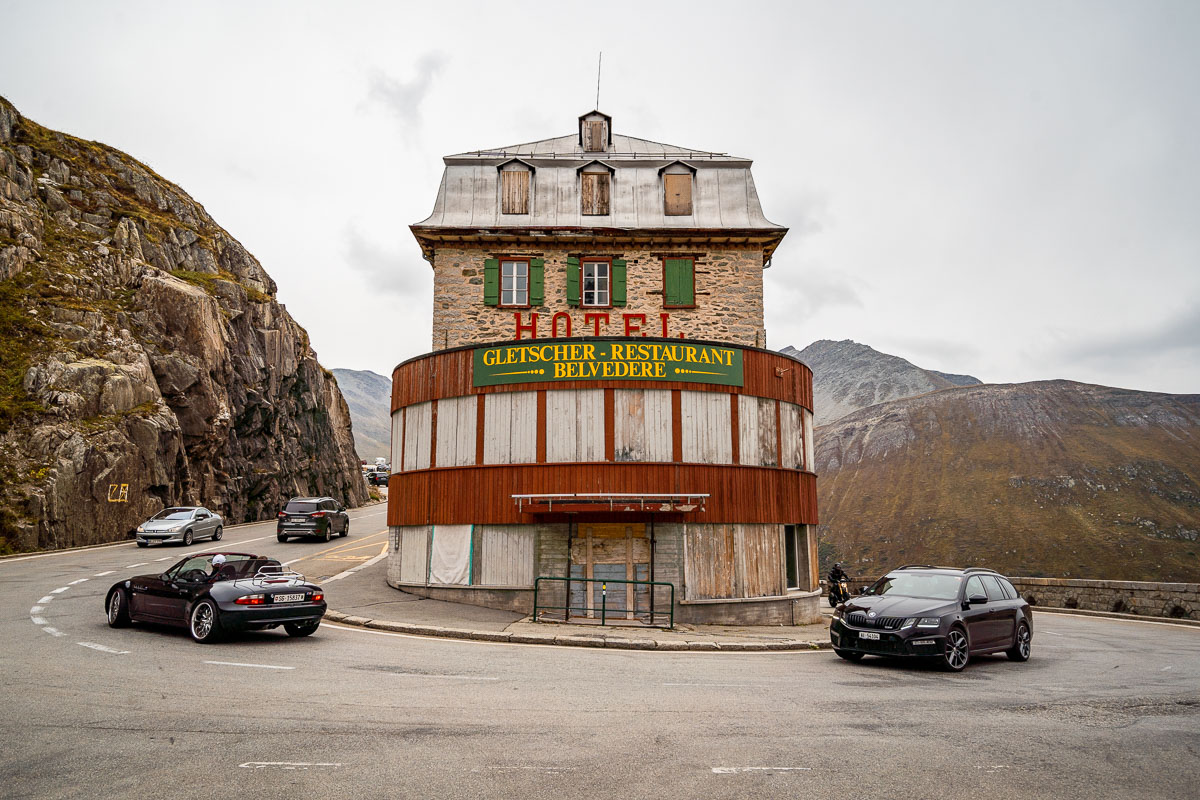
Overview of Your Switzerland Road Trip Itinerary
This road trip to Switzerland starts and ends in Zurich and includes a couple of days in neighboring Liechtenstein. The itinerary is split between visiting the most interesting Swiss cities and towns and some of the most impressive scenery in the country.
Below is a breakdown of where you will spend your days and nights.
Breakdown of your 2 weeks in Switzerland
- Day 1: Full day in Zurich (overnight in Zurich)
- Day 2: Lucerne, Lake Brienz, arriving in Interlaken (overnight in Interlaken)
- Day 3: Lauterbrunnen, Trümmelbachfälle, Harder Kulm (overnight in Interlaken)
- Day 4: Grindelwald, Blausee, Spiez Castle (overnight in Interlaken)
- Day 5: Giant Swing in Adelboden-Tschentenalp, Engstligen Falls, Thun Castle, arriving in Bern (overnight in Bern)
- Day 6: Full day in Bern (overnight in Bern)
- Day 7: Full day in Geneva (overnight in Geneva)
- Day 8: Lausanne, Chillon Castle, arriving in Zermatt (overnight in Zermatt)
- Day 9: Zermatt Five Lakes Hike, afternoon in Zermatt (overnight in Zermatt)
- Day 10: Grimselpass, Furkapass & Hotel Belvedere, Swing the World Nara, arriving in Lugano (overnight in Lugano)
- Day 11: Valle Verzasca, Foroglio (Waterfall, Swing the World), afternoon in Lugano (overnight in Lugano)
- Day 12: Liechtenstein (overnight in Liechtenstein or Appenzell District, Switzerland)
- Day 13: Ebenalp (overnight in Liechtenstein or Appenzell District, Switzerland)
- Day 14: Saxer Lücke hike, Stadtbibliothek St. Gallen, arriving in Zurich (overnight in Zurich)
Map for your Switzerland road trip
Below you can find a customized map that includes all the locations you’re going to visit on this Switzerland road trip itinerary. I marked the different parts of the road trip with different colors so you can easily see which places you’re going to visit each day.
If you open up this post on your phone and you click on the bracket in the upper right corner of the map, it will automatically save this map to your Google Maps app so you can always have it with you. Super convenient, right?
Day 1: Zurich
You will start your road trip in Switzerland in the largest city, Zurich. You will not need a car today so you can make arrangements to collect it on the second day of your vacation.
Cradled by the Swiss Alps and resting on the shores of Lake Zurich, the city is made all the more scenic by the River Limmat which flows right through the Aldstadt (Old Town). The Aldstadt is brimming with museums and historic buildings while the city also boasts a number of scenic vantage points and gorgeous gardens.
One day is the perfect amount of time to explore Zurich however you could always extend your 2 weeks in Switzerland with a few extra nights tapped onto the start or end of the road trip.
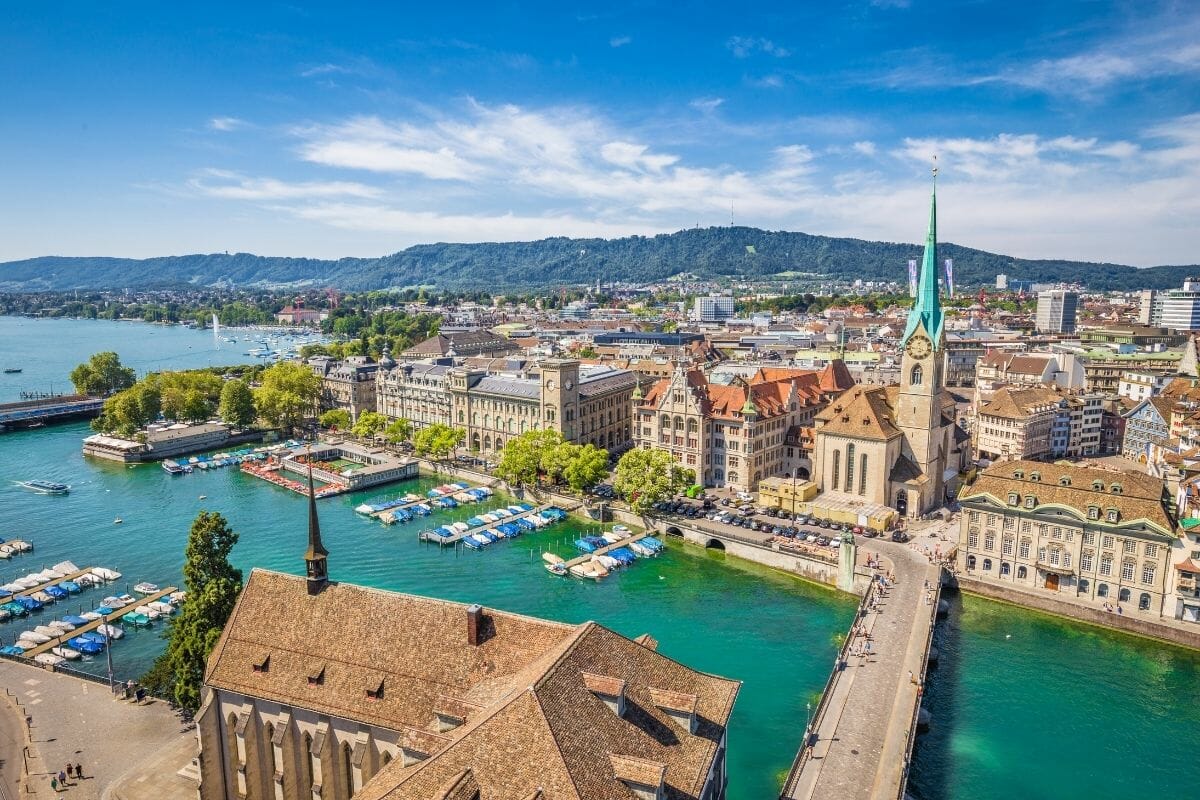
Where to stay in Zurich
As you are only spending 24 hours in Zurich, I recommend that you stay centrally in District 1. However, if you are traveling on a budget, then Districts 4 and 8 are within easy access of the center and have some more affordable options. The great news is that you will not need to worry about parking!
Below you can find my picks for where to stay in Zurich for one night.
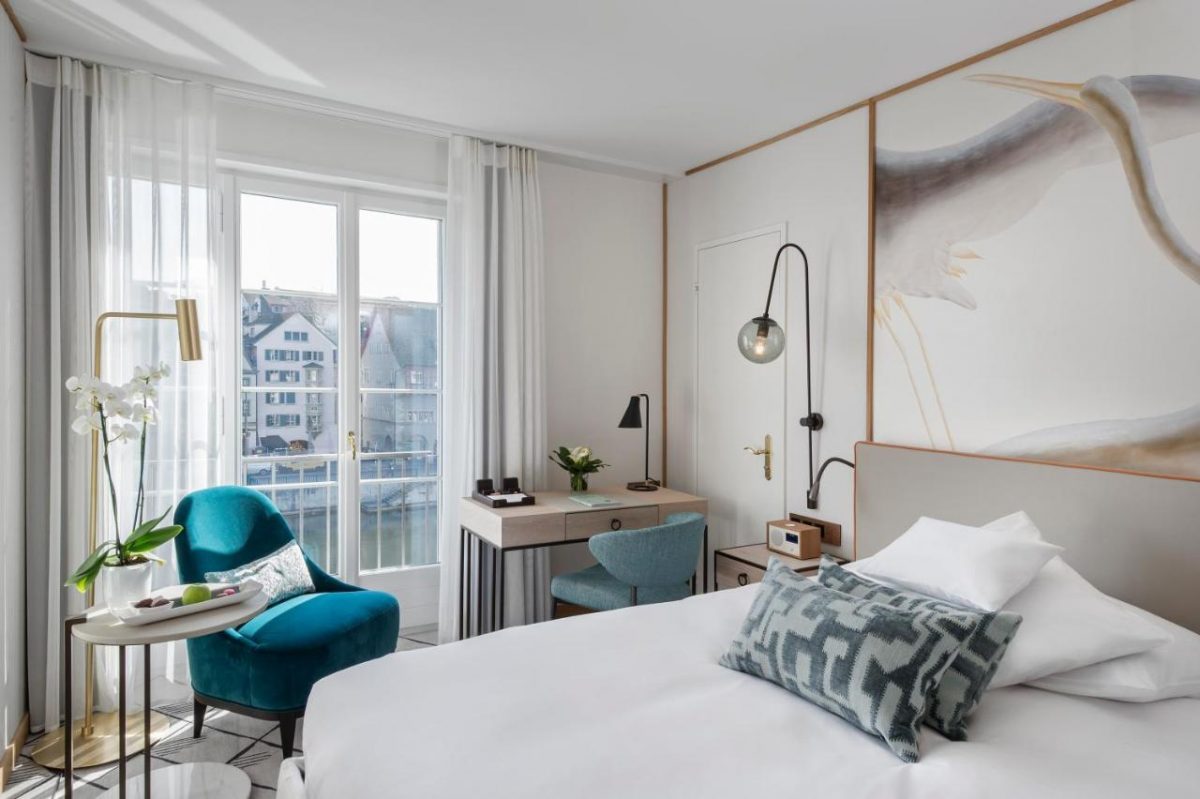
LUXURY – Storchen Zürich
This beautiful hotel is located right in the heart of Zurich and has its own boat pier directly at the Limmat River. Rooms come with classic furnishing with warm colors and modern facilities and each room offers a picturesque view of the Old Town. The hotel also has a beautiful outdoor terrace which is perfect for summertime trips.
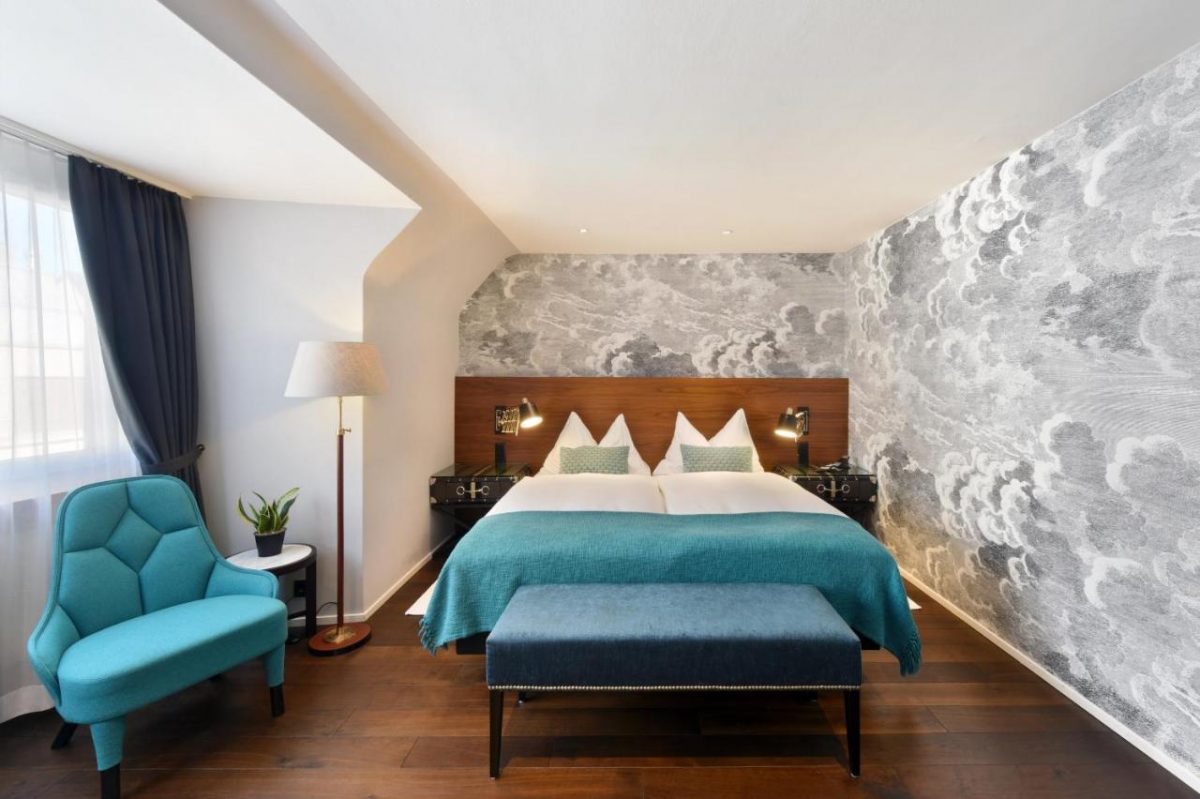
MID-RANGE – Hotel City Zürich Design & Lifestyle
Situated by the famous Bahnhofstrasse, this modern hotel is artistically presented with comfortable and spacious rooms. All rooms have a private bathroom and most include bathtubs with overhead showers.
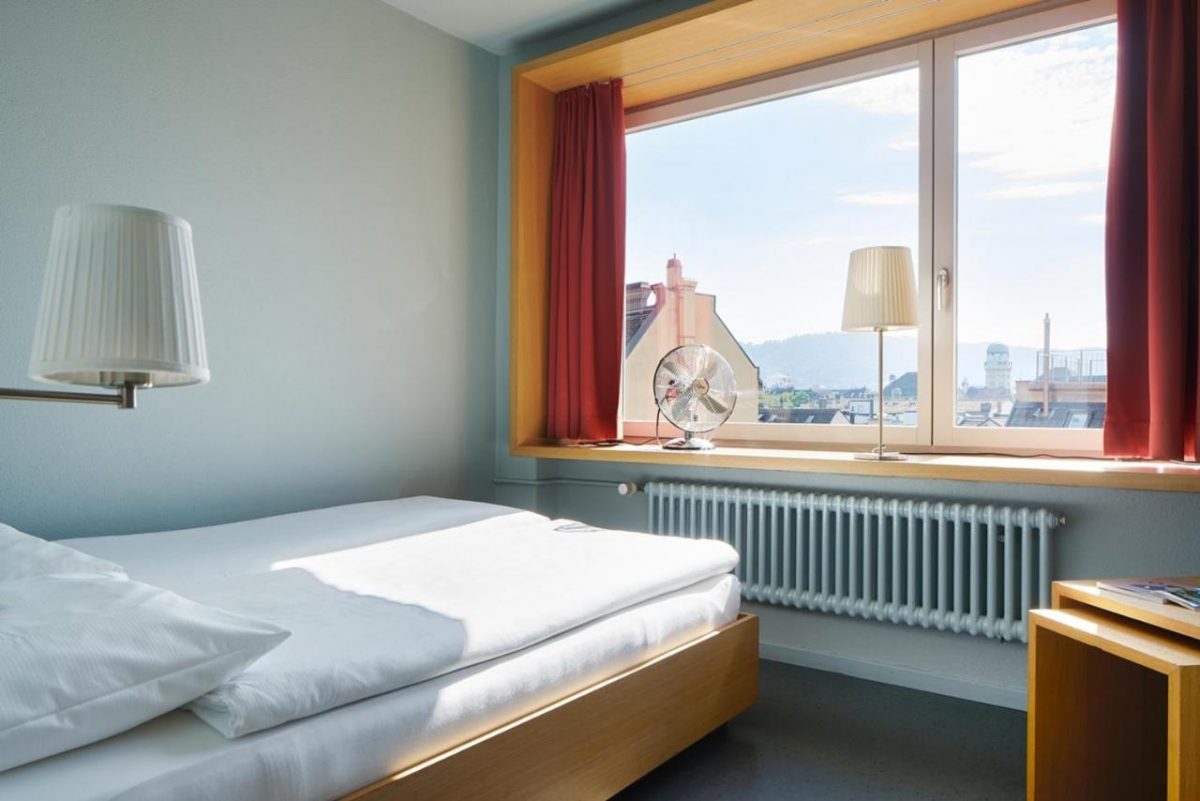
BUDGET – Hotel Marta
This no-frills hotel is clean, functional, and fabulously located in the northern point of the Niederdorf quarter of Old Town. Breakfast is included in the rate and the staff goes out of their way to take care of their guests.
Best things to do in Zurich
Zurich aldstadt .
Zurich’s Old Town straddles both sides of the River Limmat and it’s a joy to roam these historic streets. Take a few hours to stroll along Limmatquai, admire the numerous churches, and dip into an institution such as the Swiss National Museum.
My one day in Zurich itinerary will help you navigate the best things to do in Zurich Altstadt.
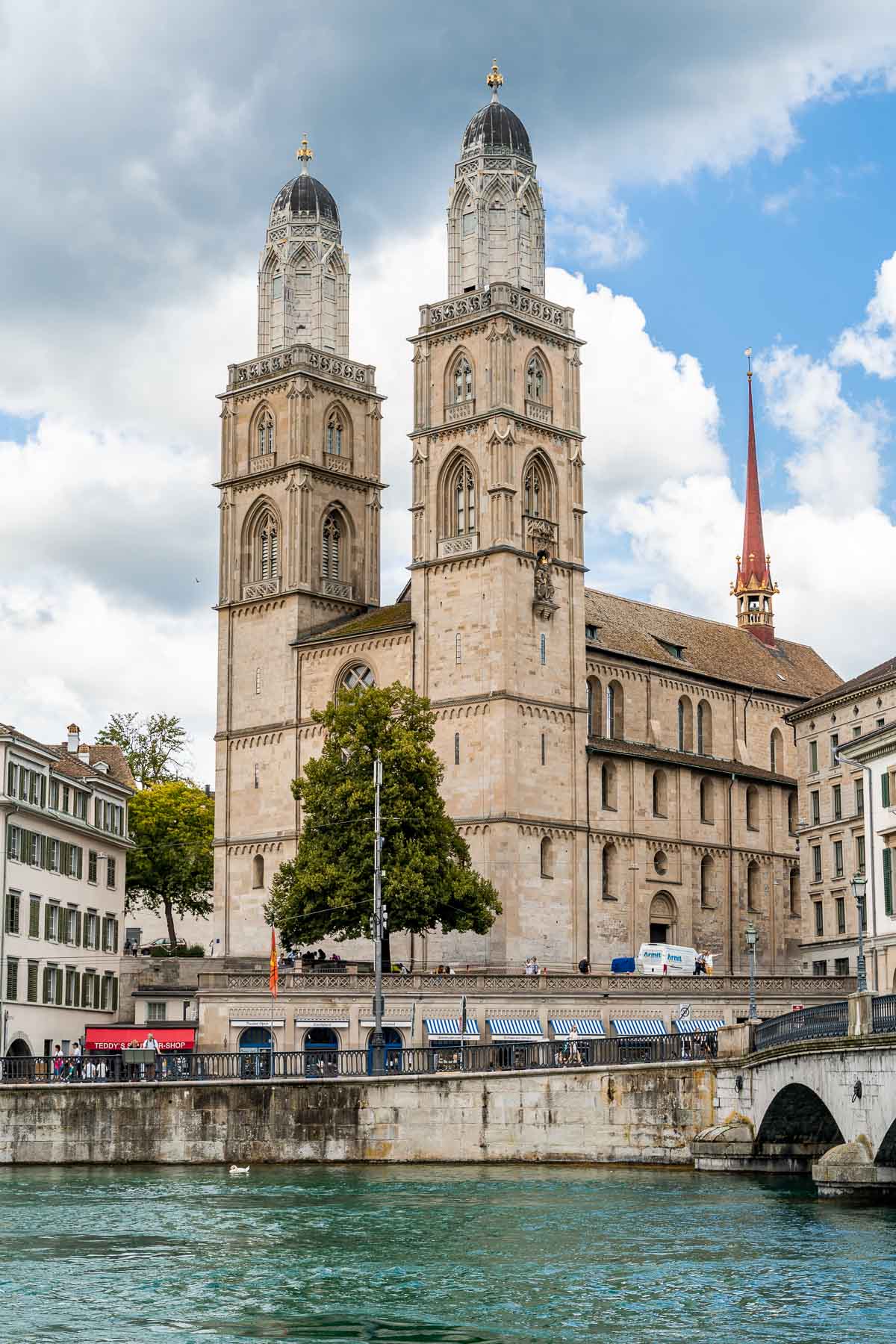
Polyterrasse
Swipe your Zürich Card and board the Polybahn, a little red funicular railway that ascends to a fabulous viewpoint at the Polyterrasse. Situated on a level with the ETH Zürich University, this is a laid-back spot to soak up city views with a great atmosphere.
Lake Zurich or River Limmat Cruise
Hop aboard a boat at Zürich Bürkliplatz and enjoy a 1.5-2 hour scenic cruise across Lake Zurich. Alternatively, you can choose a tour of the River Limmat which starts from Zürich Landesmuseum.
Note that these activities are only available during the summer season, from April until late October.
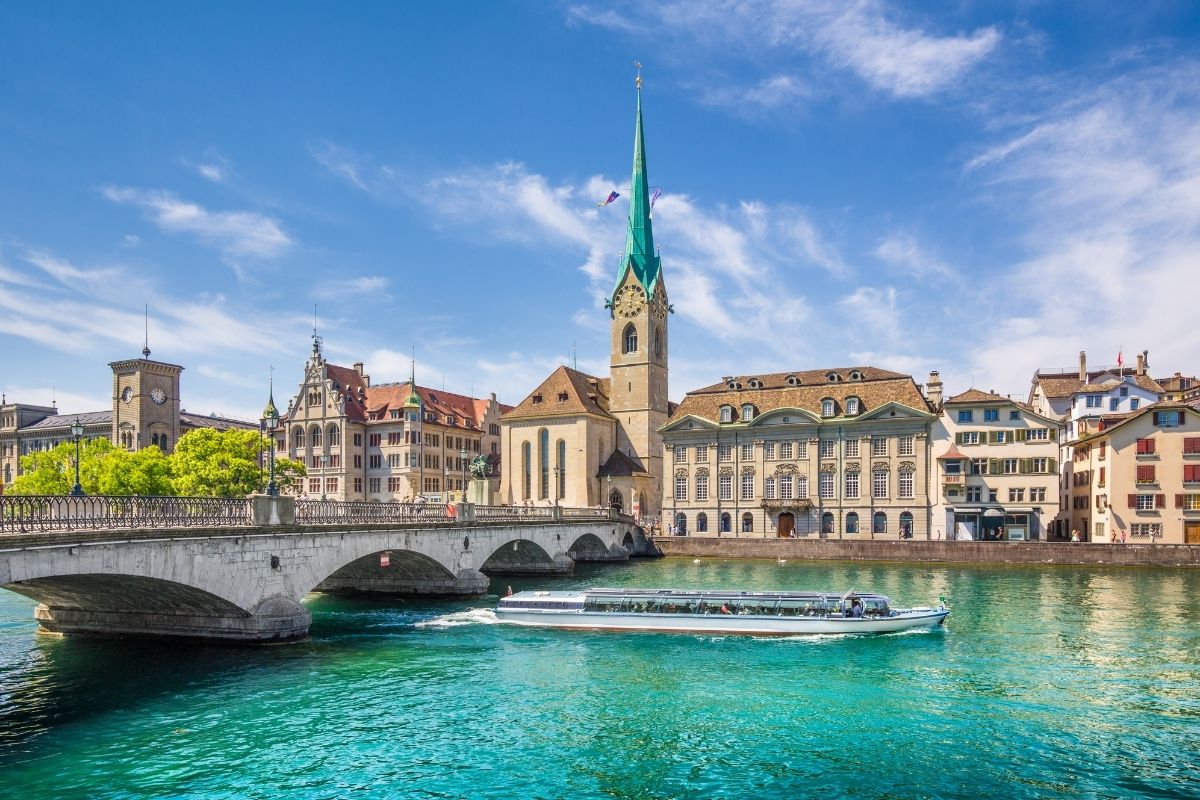
Get a taste of what’s to come later in your 2 week Switzerland road trip at this mountainous viewpoint high above Zurich. The S 10 train connects Zurich Main Station and Uetliberg in 25 minutes and this is the perfect spot for early morning or sunset.
If you are spending longer in Zurich then you might want to check out the hiking trails up here.
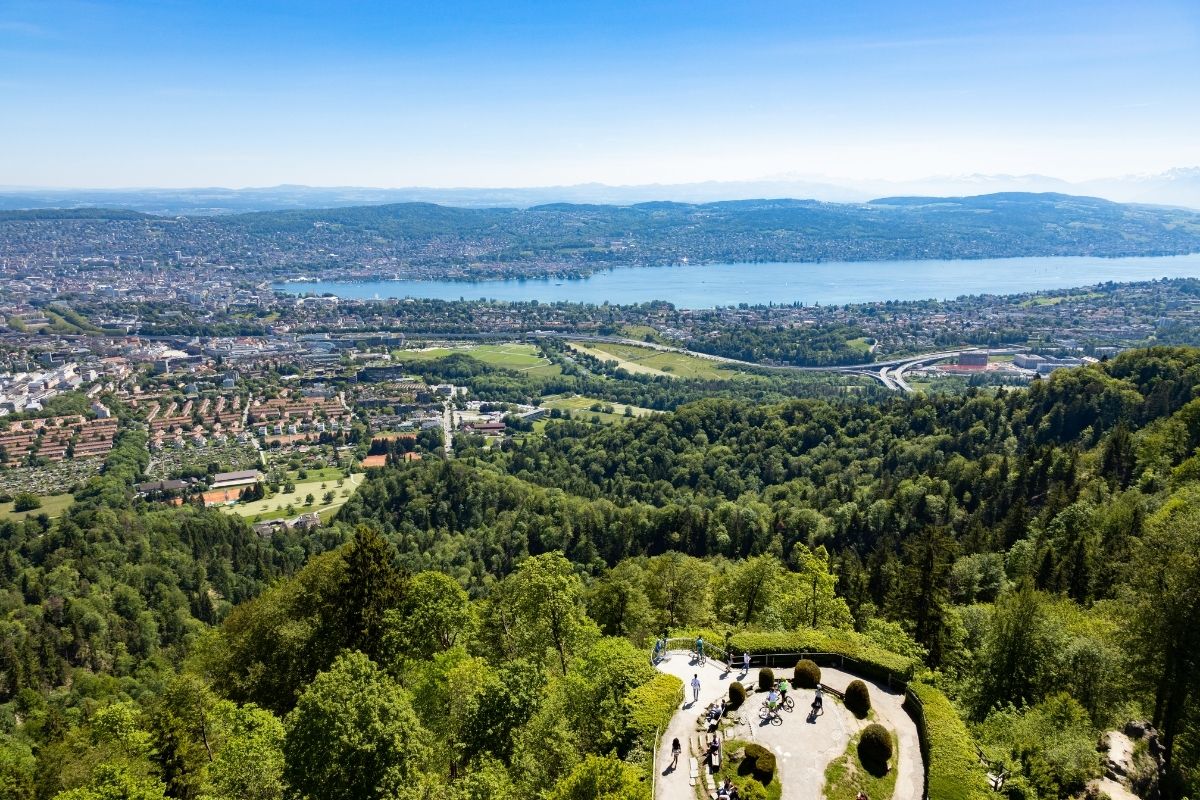
Museum Rietberg
This museum houses traditional and contemporary pieces of art and archaeological finds from Asia, Africa, Oceania, and the Americas. There are a number of galleries in Zurich but this one is particularly unusual and is located in a fantastic setting.
Visit a park
Zurich is abundant in parks and green open spaces. Take a wander around Rieterpark, which is the setting for Museum Rietberg, or explore the neighboring Belvoir Park for lake views. Other options include the lakeside Arboretum Zurich and the Old Botanic Garden in Aldstadt.
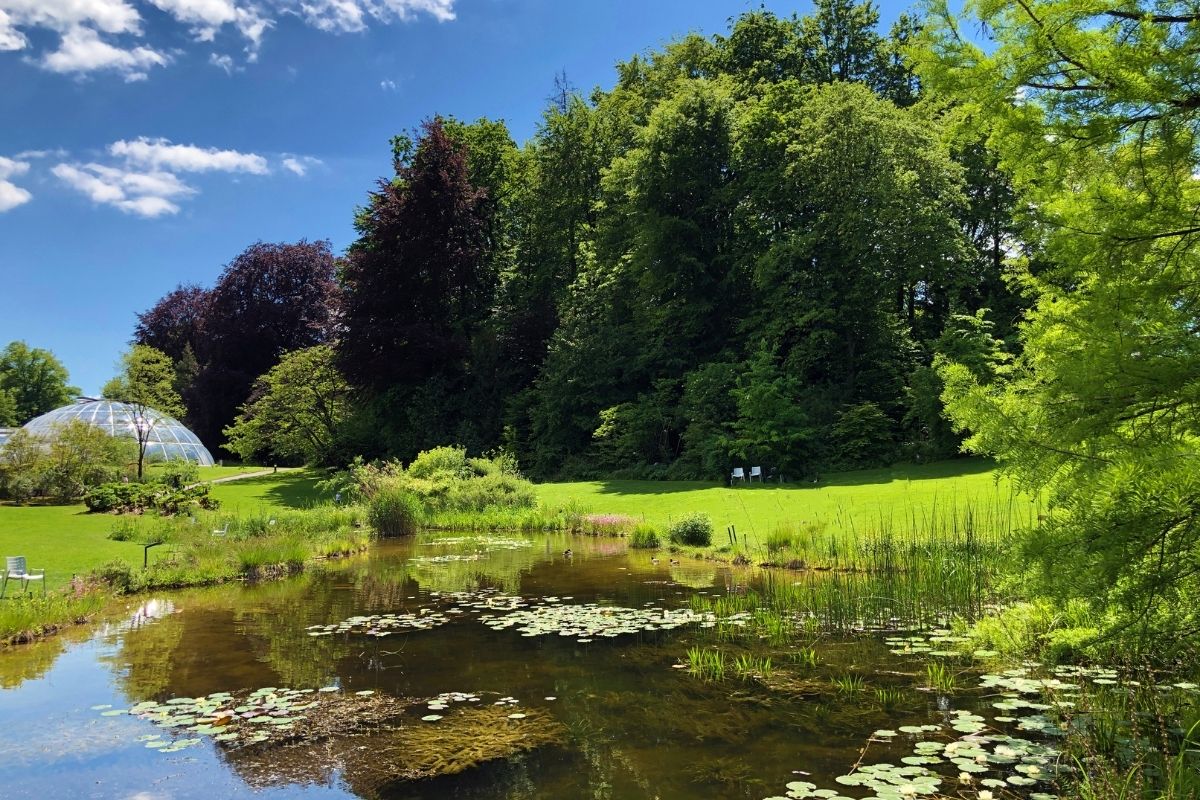
Thermalbad & Spa Zürich
Dive into these sulphuric waters at this thermal spa located in a former brewery. The view from the rooftop pool is spectacular and you can also splash out on a massage if you wish. As this Switzerland road trip concludes in Zurich, you could save this activity for the end of your adventure as well.
Where to eat in Zürich
- Raclette Factory : You can’t come to Switzerland without sampling their staple delicacy of molten cheese drizzled over buttery potatoes and pickles! The Raclette Factory is the best place to try this après-ski treat in Zurich.
- Restaurant Differente : Situated in the Hotel Krone, this stylish dining room serves Mediterranean dishes and Swiss specialties made using seasonal produce. They’re known for their exquisite tartare but the vegetarian dishes are also exceptional.
- Heugümper : This upscale restaurant fuses the flavors of Asia and the Mediterranean to create a unique culinary experience.
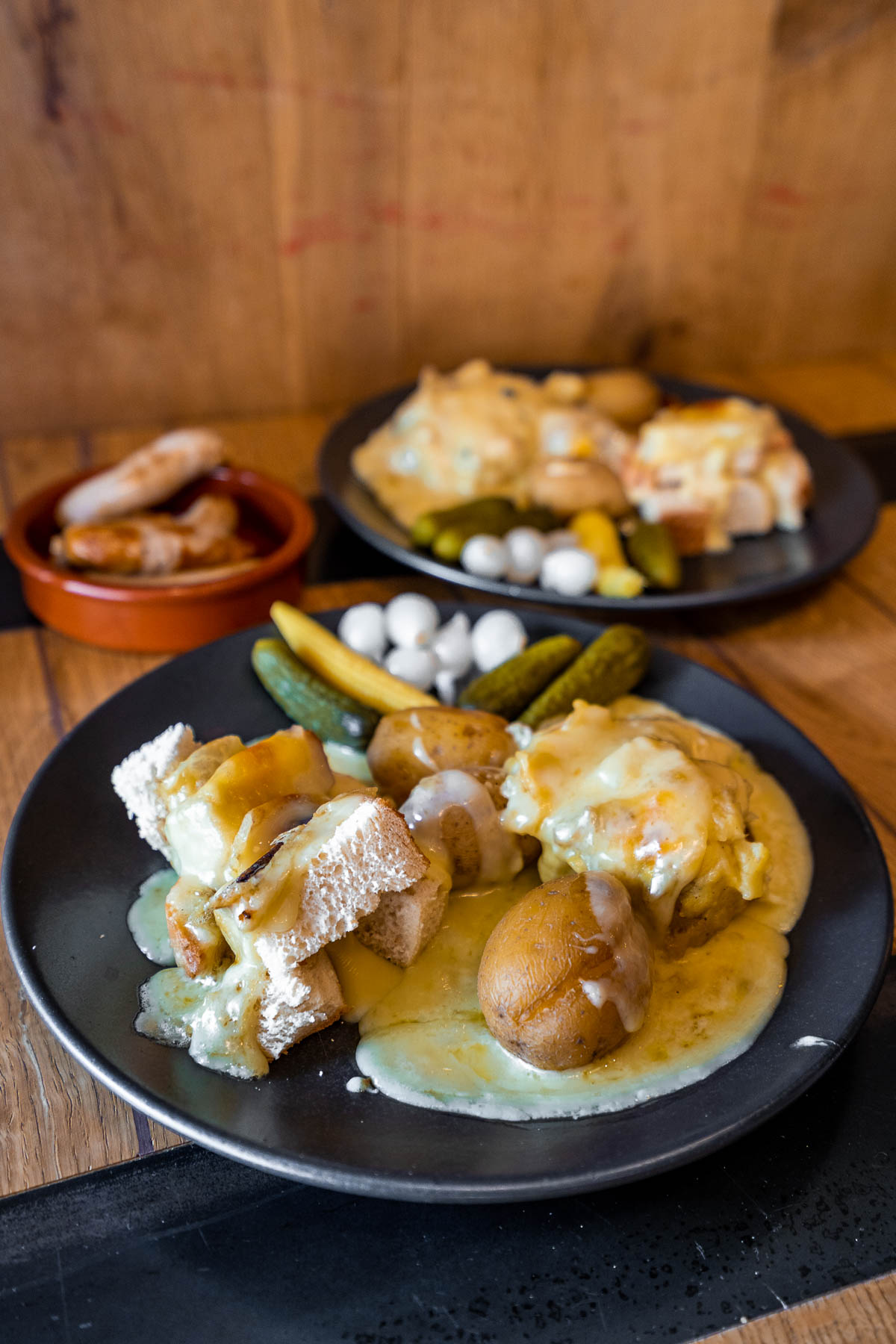
Day 2: Zurich to Interlaken via Lake Brienz
Today you will pick up your rental and officially press go on your 2 week Switzerland road trip itinerary. As you drive from Zurich to Interlaken, you will cover a distance of 123 km (76.5 miles).
This accounts for around 2 hours of driving time, factoring in the following scenic stops but excluding time spent viewing the attractions.
Driving time: 40 minutes (53 km/33 miles) from Zurich to Lucerne
Around one hour south of Zurich, Lucerne is a small city that sits on the shore of Lake Lucerne. Noted for its medieval architecture, it’s worth parking up in town and exploring the Aldstadt on foot.
Walking across the Chapel Bridge ( Kapellbrücke) is undoubtedly one of the best things to do in Lucerne . Built in the 14th century, the bridge offers scenic views over the River Reuss and Lake Lucerne, and you can also admire the interior artwork on the roof.
The Sammlung Rosengart contains a selection of artworks by Picasso while the Zytturm is an antique clocktower set among the old city wall where you can stretch your legs.
If you’re feeling hungry, you could grab a bite to eat at the plant-based cafe PURA or savor the views from the waterfront Café Bar Volière.
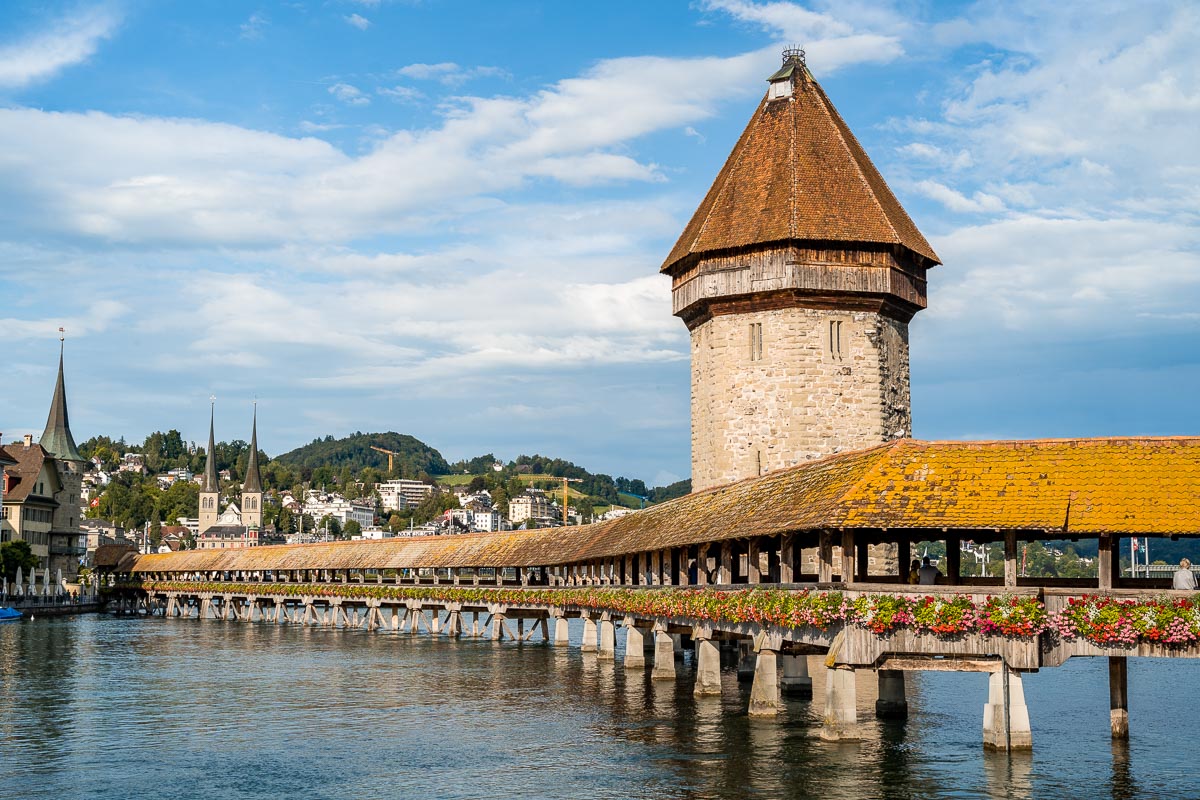
Lake Brienz
Driving time: 1 hour (60 km/38 miles) from Lucerne to Iseltwald
After taking in the views in Lucerne, get back in your car for another hour of driving down to the surrounds of Lake Brienz. Find a parking spot in the village of Iseltwald where you can get an eyeful of turquoise water.
Follow the path along the water’s edge and you will reach the dreamy Schloss Seeburg, a fairytale castle that gazes out across the lake. It is no longer possible to enter the castle but you can still take photos from outside.
My tip for lunch today is the Hotel Chalet du Lac . This chalet-style property affords a magical view across the lake towards the town, castle, and surrounding mountains. The menu is rich with fish dishes, Swiss fare, and European plates.
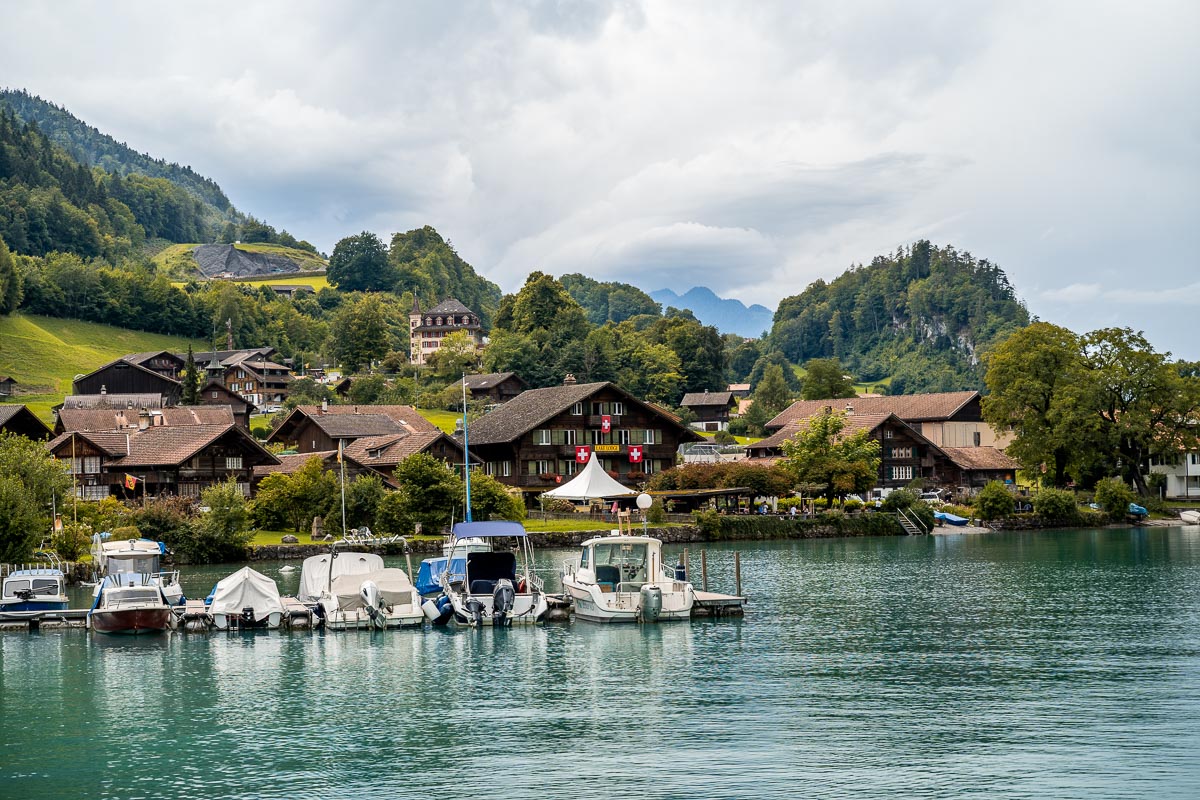
Arriving in Interlaken
Driving time: 10 minutes (10 km/6 miles) from Iseltwald to Interlaken
Interlaken, the final destination of day two of your Switzerland road trip, is located a 10-minute drive from Iseltwald so you can head there whenever you like and check into your hotel. This lakeside resort town sits astride the River Aare in between Lake Brienz and Lake Thun.
Where to stay in Interlaken (3 nights)
Once in Interlaken, you will need to book accommodation in the town for three nights as this will be your base for the next couple of days. These are my recommendations for where to stay in Interlaken.

LUXURY – Victoria Jungfrau Grand Hotel & Spa
The Victoria Jungfrau Grand Hotel & Spa enjoys a privileged and picturesque location in Interlaken, between 2 beautiful lakes at the foot of the eternally snow-capped Jungfrau. All rooms have a distinctive design and décor, ranging from classic to contemporary. Elegant interiors and spacious marble bathrooms complement the designs.
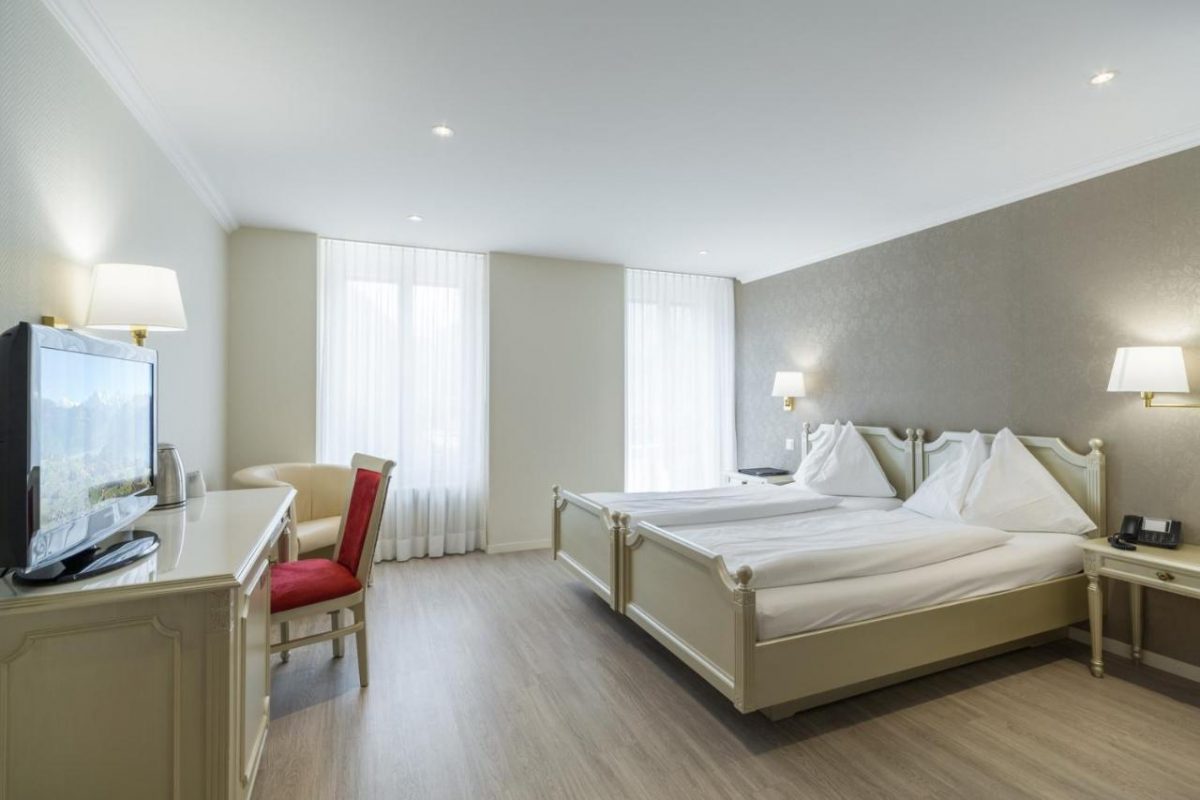
MID-RANGE – Hotel Du Nord
Offering panoramic mountain views, the traditional and historic Hotel Du Nord, dating from 1847, is located in the center of Interlaken. The rooms are all non-smoking and equipped with tea-making facilities. Some rooms have a balcony or a terrace.
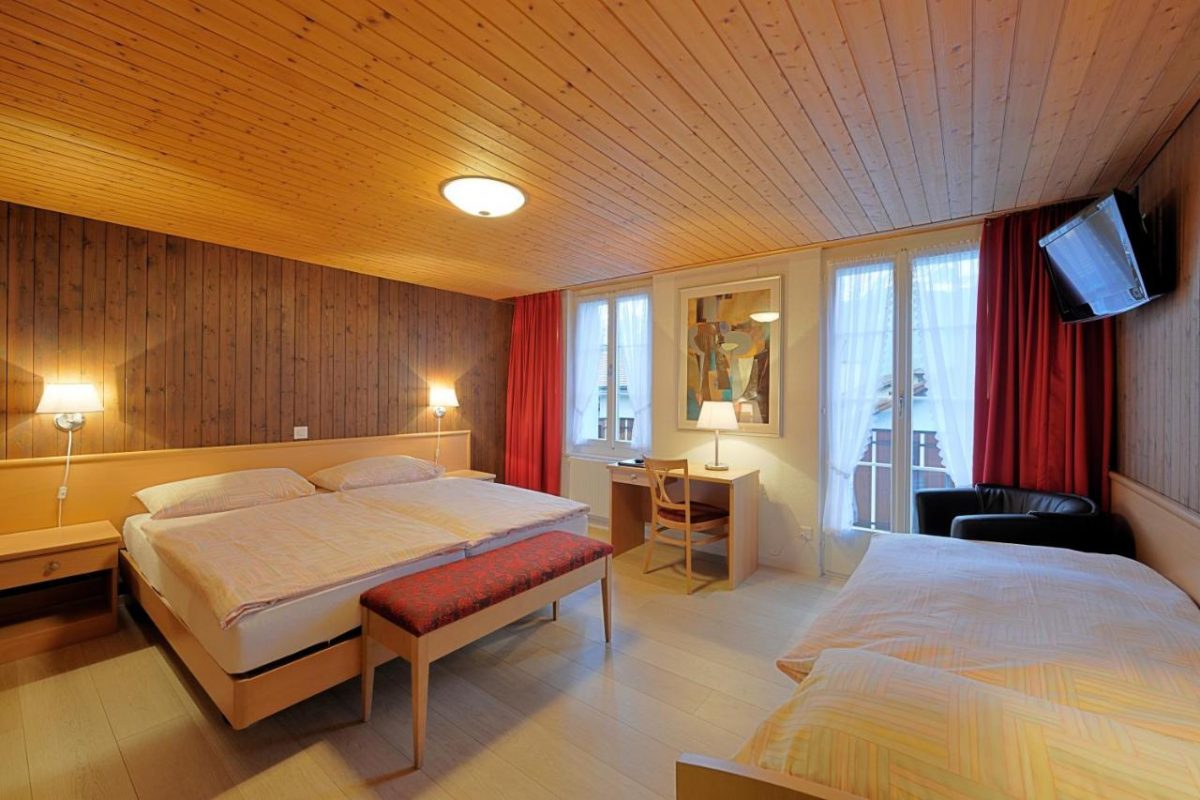
BUDGET – Hotel Rössli
This cozy hotel is located in the heart of town and parking is available at a surcharge. Some rooms include an ensuite bathroom with a tub while others come with a private balcony. Breakfast is included in the rate and the staff here are exemplary.
Day 3: Scenic Drive around Interlaken
Today you will visit some nearby towns and attractions before heading back to Interlaken for the night. You will drive a total of 30 km (18.5 miles), equal to around 40-45 minutes.
Lauterbrunnen
Driving time: 18 minutes (13 km/8 miles) from Interlaken to Lauterbrunnen
Lauterbrunnen is a village set among the eponymous municipality. It’s mostly known for its scenic views and fairytale setting and let me tell you something in advance: no pictures do justice to how beautiful this place is in real life!
Most people just take a quick walk around the town but if you have more time, there is no shortage of things to do in the area. There is a huge parking lot (Parkhaus Lauterbrunnen) right next to the train station where you can leave your car while you explore the town.
To find the most famous viewpoint, head over to Chalet Pironnet where you’ll be greeted with a breathtaking panoramic view of the town.
If you want to spend longer in the area, you can take advantage of the local cable cars and soar high into the Bernese Alps to savor the views from the peaks. Lauterbrunnen to Grütschalp is the most convenient as it’s located right in the town.
Alternatively, you can drive the 50 minutes to Wengen which connects to Mannlichen by gondola. A number of short hikes start from Mannlichen, including the Panoramaweg walk to Kleine Scheidegg which is an easy 4.5 km (2.8 miles) hike each way.
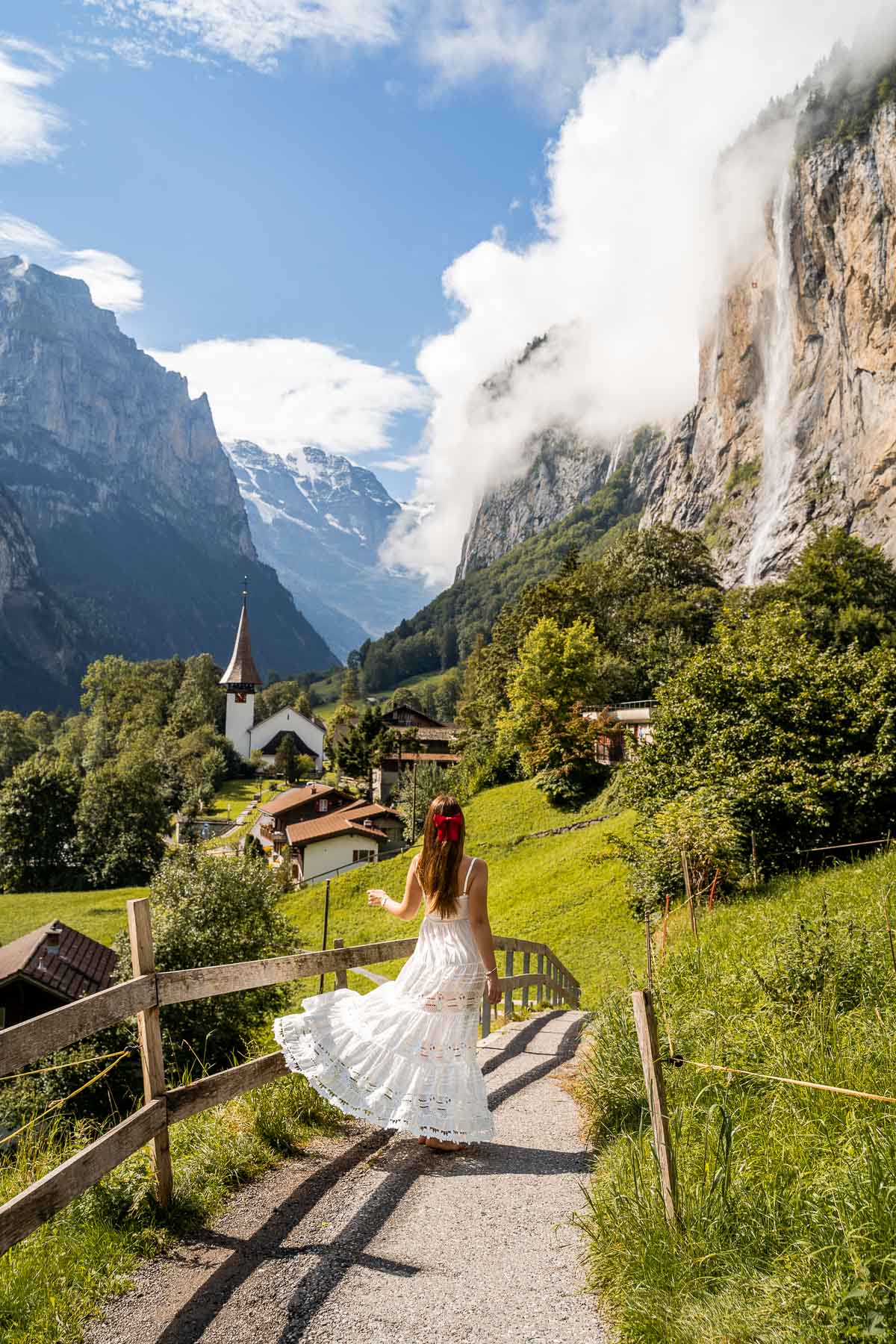
Trümmelbachfälle
Driving time: 6 minutes (4 km/2.5 miles) from Lauterbrunnen to Trümmelbachfälle
A short drive from Lauterbrunnen, Trümmelbachfälle (Trümmelbach Falls) is a stream of ten glacial waterfalls that gush down the ravine from the Eiger, Mönch, and Jungfrau peaks.
There is a parking lot right at the entrance where you can leave your car but if you’re up for a walk, you can also walk to Trümmelbachfälle from Lauterbrunnen since the route is only 4 km (2.5 miles) in one way.
Entrance to Trümmelbachfälle costs 14 CHF (€14.40) per person. Right after the entrance, you can take a tunnel lift to the top of the waterfalls where you can access a series of walkways and tunnels that connect the falls. Basically, you can walk from the top to the bottom and explore the scenery during your descent.
The weather is quite cold inside the tunnels and the walkways get slippery due to the powerful waterfalls so make sure to wear proper shoes and have a warm jacket with you.
Access is possible from early April until November each year but it’s best to check the Trümmelbachfälle website beforehand to ensure that they are open.
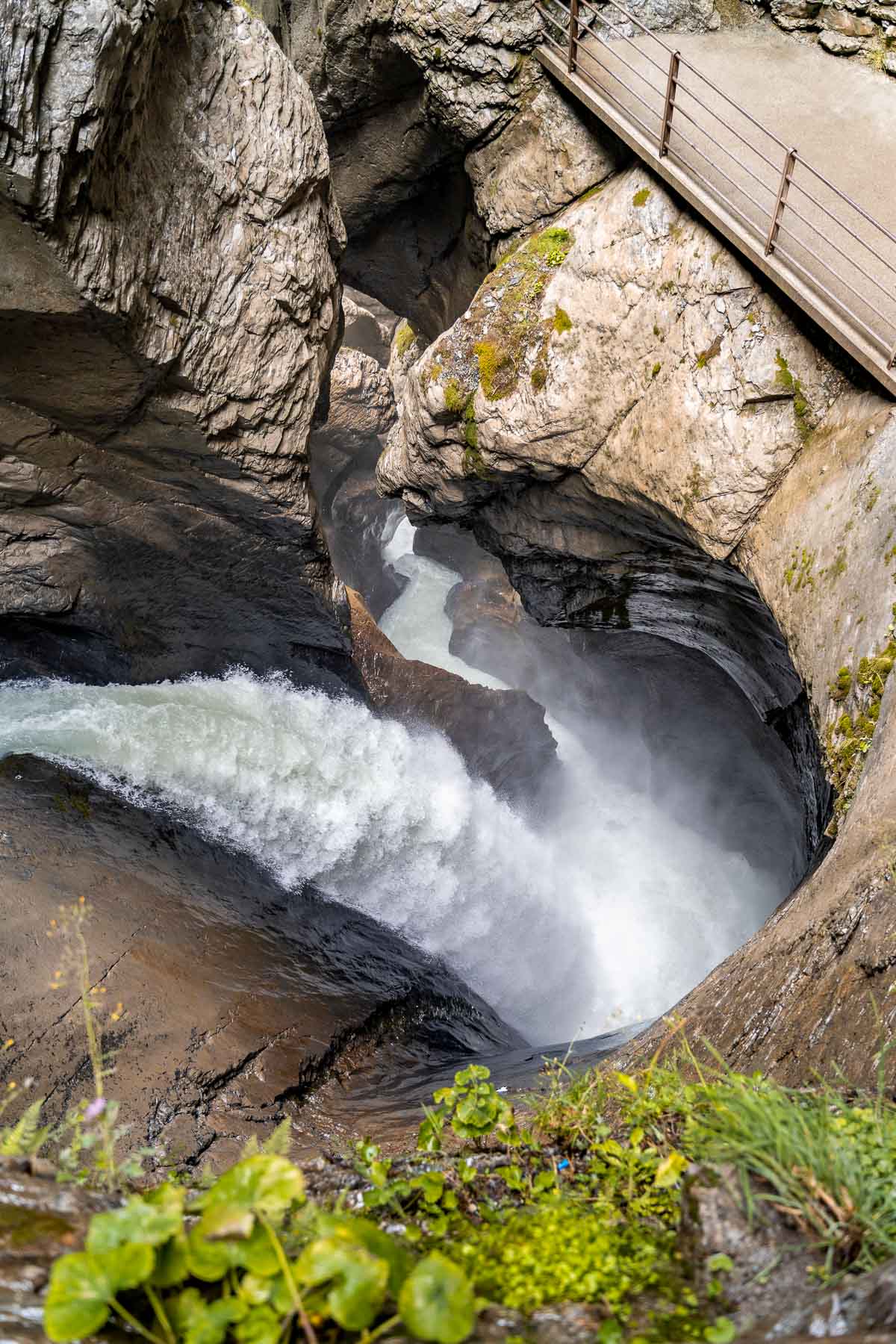
Harder Kulm
Driving time: 20 minutes (15 km/9 miles) from Trümmelbachfälle back to Interlaken
Once back in Interlaken, you can drop your car back at your hotel and ride the Harderbahn funicular up to the Harder Kulm viewpoint for staggering views across the surroundings.
The journey takes around 10 minutes and it costs 20 CHF (€20.60) in one way. It’s important to note that the funicular only operates between April and November and it can be closed due to bad weather.
From the top, there are a number of short hiking trails that range from 20 minutes to 1.5 hours so you might want to squeeze one into the end of the second day of your Switzerland road trip.
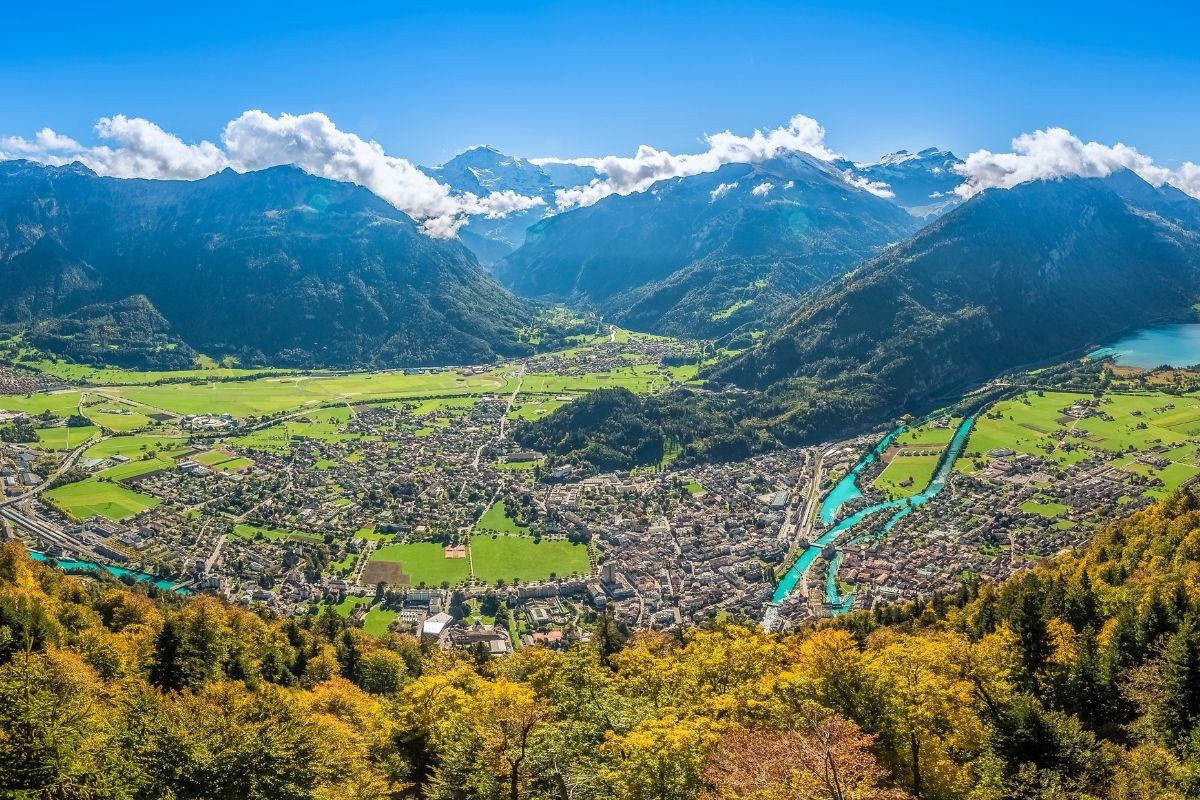
Day 4: Grindelwald and Blausee
The fourth day of your Switzerland road trip will also be a day trip from Interlaken so there’s no need to check out of your hotel yet. Driving time today will be a total of 120 km (75 miles), equal to around 2 hours behind the wheel depending on traffic.
Grindelwald
Driving time: 25 minutes (20 km/12.5 miles) from Interlaken to Grindelwald
First Cliff Walk by Tissot
The first stop of the day is the village of Grindelwald, the gateway for the Jungfrau Region. Once there, you can park in town and then ride the gondola up to Grindelwald-First.
A return ticket costs 68 CHF per person (€70) from Grindelwald but if you don’t want to drive today, you can also take a cable car directly from Interlaken (it costs around 90 CHF/€92.70).
The gondola takes 25 minutes to reach your destination, First station, calling at Bort and Schreckfeld along the way. Right after you depart, you’ll find yourself at the start of the First Cliff Walk by Tissot.
It’s an elevated walkway that winds its way around the cliff and juts out 2,168 meters (7,112 feet) above the landscape to afford a heart-stopping view across the mountains and forestry. The path reaches out 45 meters (148 feet) into the void so you will need a head for heights!
The terrace itself isn’t that large so you need only plan to spend 20-30 minutes exploring and taking photos. Although you’ll need to pay for the gondola, the walkway itself is free to visit.
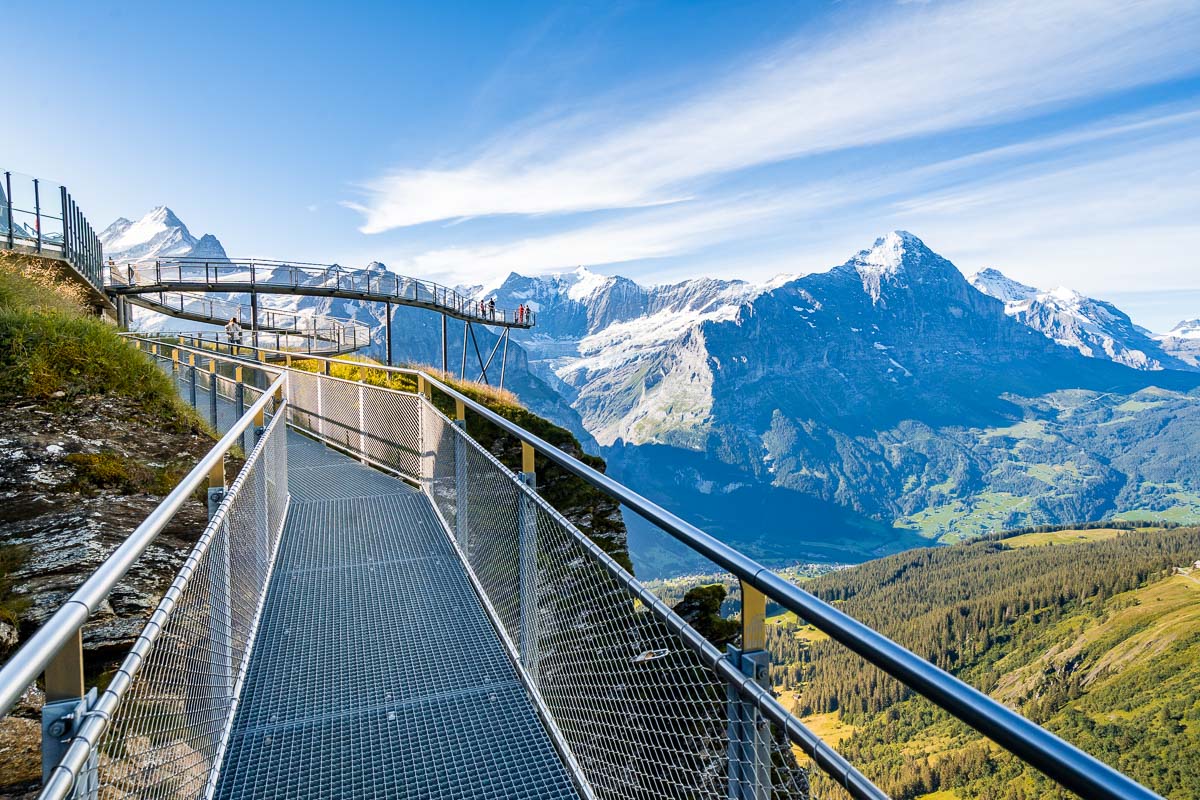
Hike to Bachalpsee
The next on the agenda for today is the hike to Lake Bachalpsee which conveniently starts at First. This alpine lake is nestled among the mountains at 2,265 meters (7,431 feet) above sea level.
Surrounded by snow-capped mountains, swathes of greenery, and blooming wildflowers during summer, it’s a sight that will linger with you for days.
The hike is 3 km (1.9 miles) each way and a round trip there and back to First will take around two hours. The track is clearly marked and in excellent condition, so you will need decent footwear and layers but nothing too intense. Although on a slight incline, the hike isn’t challenging at all.
If you want to continue walking, you can hike from Lake Bachalpsee up to Faulhorn, which stands at 2,681 meters (8,796 feet) above sea level. This takes about 1.5 hours each way and is far steeper so I recommend this to intrepid hikers.
Alternatively, you can head straight back to First and either catch the gondola back down to Grindelwald or follow the trail back down to town on foot.
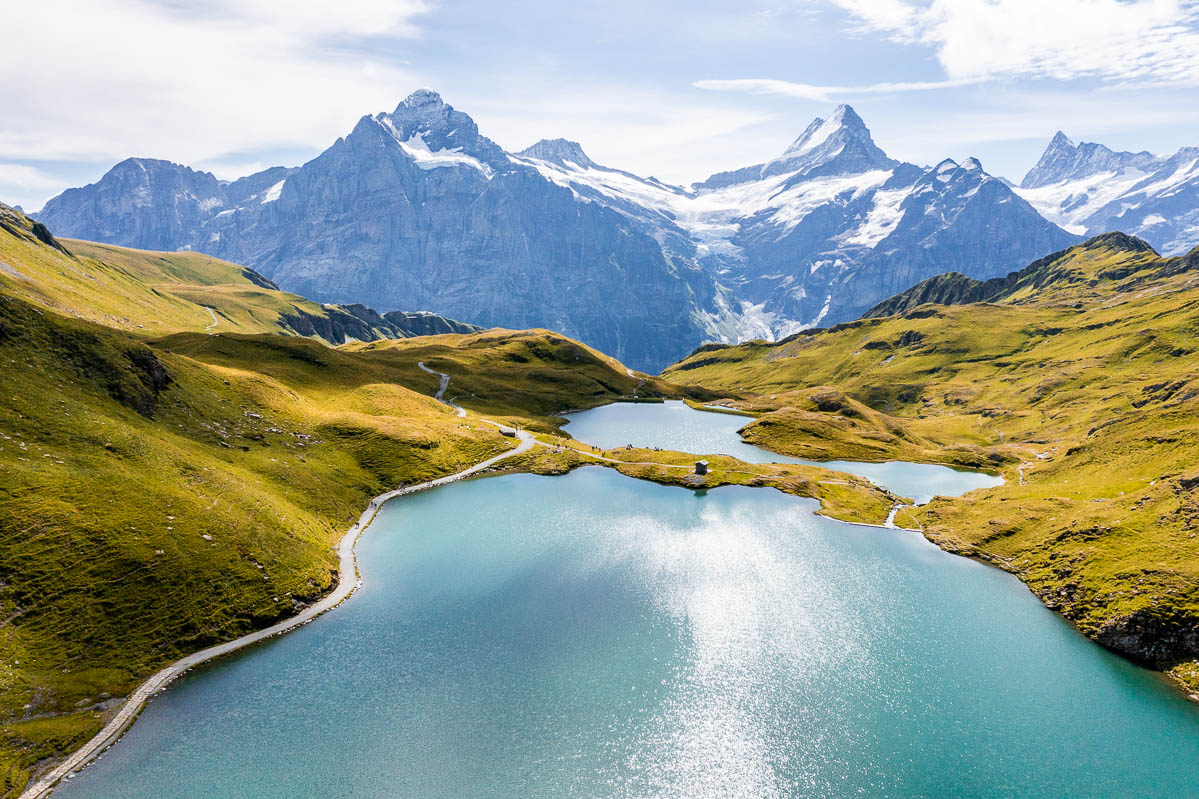
Driving time: 1 hour (56 km/35 miles) from Grindelwald to Blausee or 35 minutes (38 km/24 miles) from Interlaken to Blausee
If you start your Grindelwald adventure early enough (the first cable car starts at 8.30 am) and you don’t want to hike up to Faulhorn, you’ll still be able to visit Blausee on the afternoon of Day 4. Since you’ll have to drive back to Interlaken from Grindelwald first and then to Blausee, you can also move this stop to the morning of your next day if you’re feeling tired.
Blausee is the tiniest lake you will see during your Switzerland road trip but it’s absolutely worth the stop! It’s roughly a 35-minute drive from Interlaken and the entrance costs 11 CHF (€11.30) per person.
Fringed by woodland, you can walk around the lake in less than 15 minutes. Look out for the submerged statue on your wander!
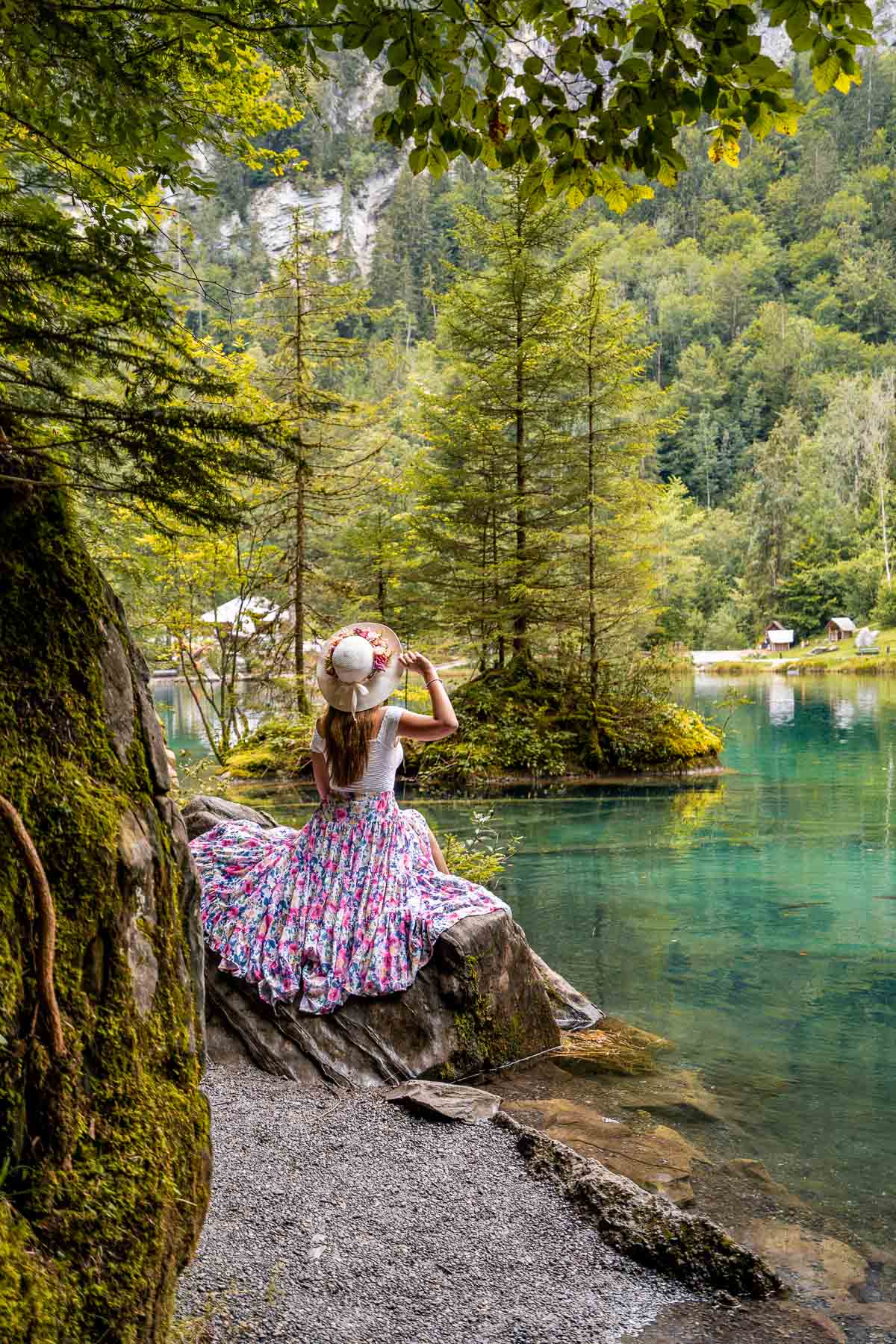
Spiez Castle
Driving time: 25 minutes (20 km/12.5 miles) from Blausee to Spiez Castle or 20 minutes (20 km/12.5 miles) from Interlaken to Spiez Castle
If you decide to visit Blausee after Grindelwald, you can make a quick stop at Spiez Castle on the way back to Interlaken. Of course, if you want to spend longer in Grindelwald, you can move Spiez Castle to the next day as well, such as you can do it with Blausee. Whatever feels best for you!
Surrounded by beautiful vineyards, Spiez Castle is definitely one of the most beautiful castles in Switzerland as it grants a breathtaking view over Lake Thun and the peaks of the Bernese Oberland.
If you love history, you’ll also appreciate the museum inside the castle that tells you more about the history of the castle and its previous owners. The castle is typically open from May to mid-October, a ticket costs 10 CHF (€10.30) per person.
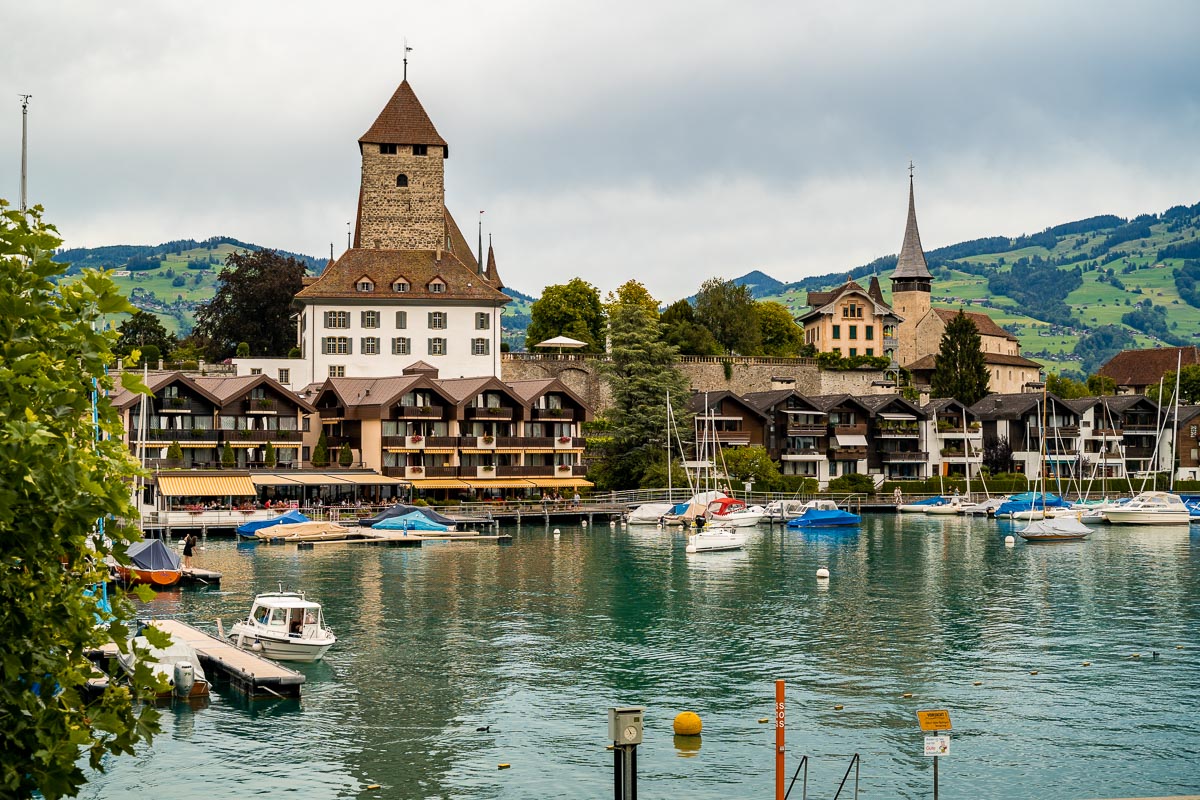
Day 5: Interlaken to Bern
The fifth day of your Switzerland road trip covers 130 km (80 miles) worth of lush Swiss scenery as you drive to Bern and equates to around 2.5-3 hours of driving time.
Giant Swing in Adelboden-Tschentenalp
Driving time: 50 minutes (48 km/30 miles) from Interlaken to Adelboden
For the start of the fifth day of your Switzerland itinerary, head up high to the Tschentenalp mountains where you can find a super cool swing not far from the cable car station.
To access the swing, you will need to park in Adelboden and then ride the gondola from Tschentenbahn Station (Dorf) up to Tschentenalp, north of the town. An adult ticket costs 32 CHF (€33.20) for a return trip while a one-way ticket costs 22 CHF (€22.80).
It’s free to ride the swing which gives you the chance to fly high above the alpine pastures and take in an exciting view of the scenery from the air, which is incredible whatever season your trip falls in.
However, if your road trip to Switzerland falls during the peak summer season then brace yourself for a line to ride the swing.
Unfortunately, we were not able to visit this cool swing during our Switzerland road trip but if you have the chance, don’t miss it! Check out their website to see some pictures of the swing and the surrounding area.
Engstligen Falls
Driving time: 9 minutes (5 km/3.1 miles) from Adelboden to Unter dem Birg
After enjoying the giant swing, your next stop is visiting the two waterfalls south of Adelboden that form Engstligen Falls.
Simply known as Engstligen 1 and Engstligen 2, this twin falls tumble from a height of 97 meters (318 feet) and 165 meters (541 feet) respectively. You can get up really close and feel the spray from these powerful falls.
To access the waterfalls viewing area you can ride the gondola up to the Engstlingen cable car station from Bergbahnen (Unter dem Birg) and then walk 20 minutes to view the landmark.
A return ticket for the cable car costs 35 CHF (€36.30) per person while the one-way option costs 25 CHF (€25.90). Alternatively, you can hike up from Adelboden, which takes around 90 minutes up and 1 hour back down.
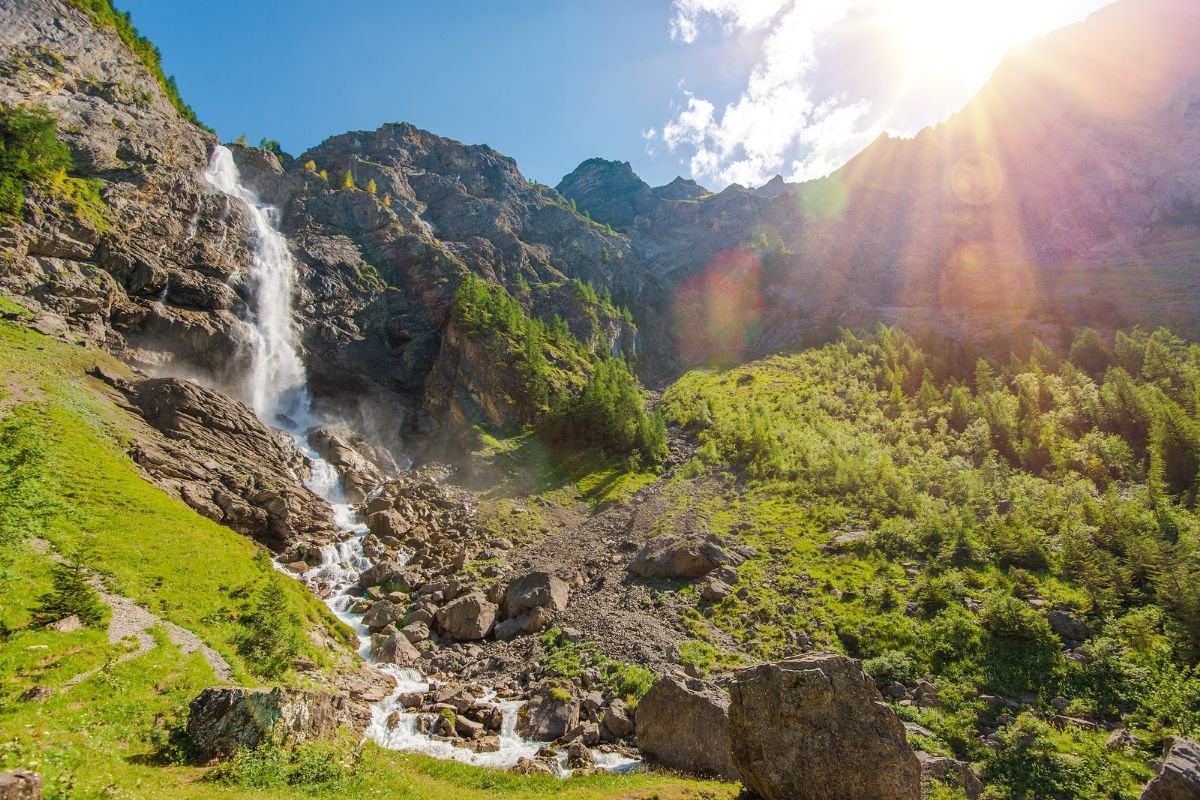
Thun Castle
Driving time: 55 minutes (45 km/28 miles) from Unter dem Birg to Thun Castle
Your last sight of the day before you reach Bern is this 12th-century castle which sits on a hill overlooking the town of Thun. With its turrets, medieval interiors, and 360° views of the surrounding alps, this castle is a mesmerizing place to wrap up your day.
You can purchase a ticket that permits entry to the Castle Museum or one that includes access to any special exhibitions taking place as well. It’s open daily throughout the year with the exception of November to January when it only opens on Sundays.
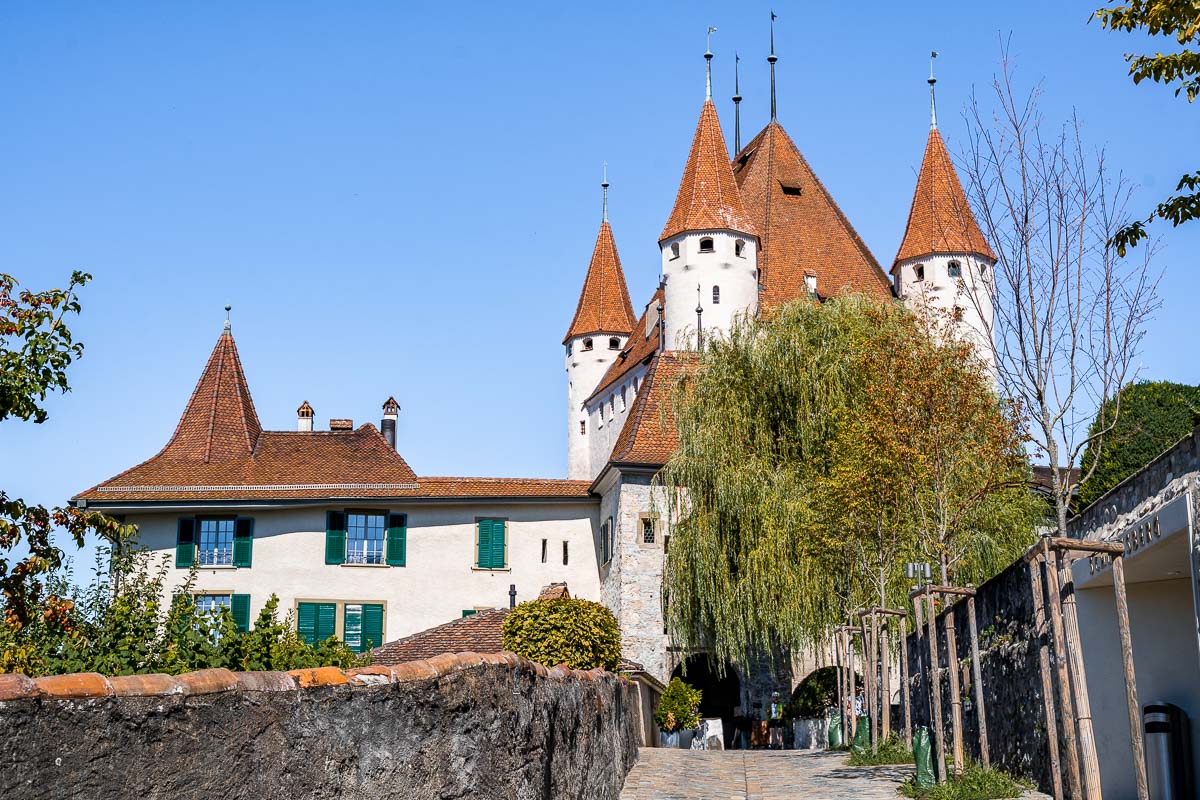
Arriving to Bern
Driving time: 30 minutes (30 km/19 miles) from Thun Castle to Bern
The only thing left to do for this day is to get back to your car and drive yourself to the Swiss capital, Bern. This will take you roughly half an hour and depending on how early or late you finish your day.
If you have some additional time, you can start exploring right away but don’t worry, you’ll have the full day tomorrow for sightseeing.
You’ll need to book 2 nights of accommodation in Bern, refer to the next day to find out my personal recommendations for the best places to stay in Bern.
Day 6: Bern
Despite being the capital city of Switzerland, Bern is actually pretty small. Therefore, spending one day in Bern is the perfect amount of time to explore the main sights and get a sense of the city.
Located within the canton of Bern, the city dates back to the 12th century and its Altstadt features a presentation of medieval architecture and literally hundreds of fountains. In fact, Bern is often nicknamed the City of Fountains!
The Altstadt sits in a crook on the River Aare, one of the longest rivers in the country. This tranquil city is not at all what you expect from a capital city and it’s a great place to grab some rest and relaxation as part of your 2 weeks in Switzerland.
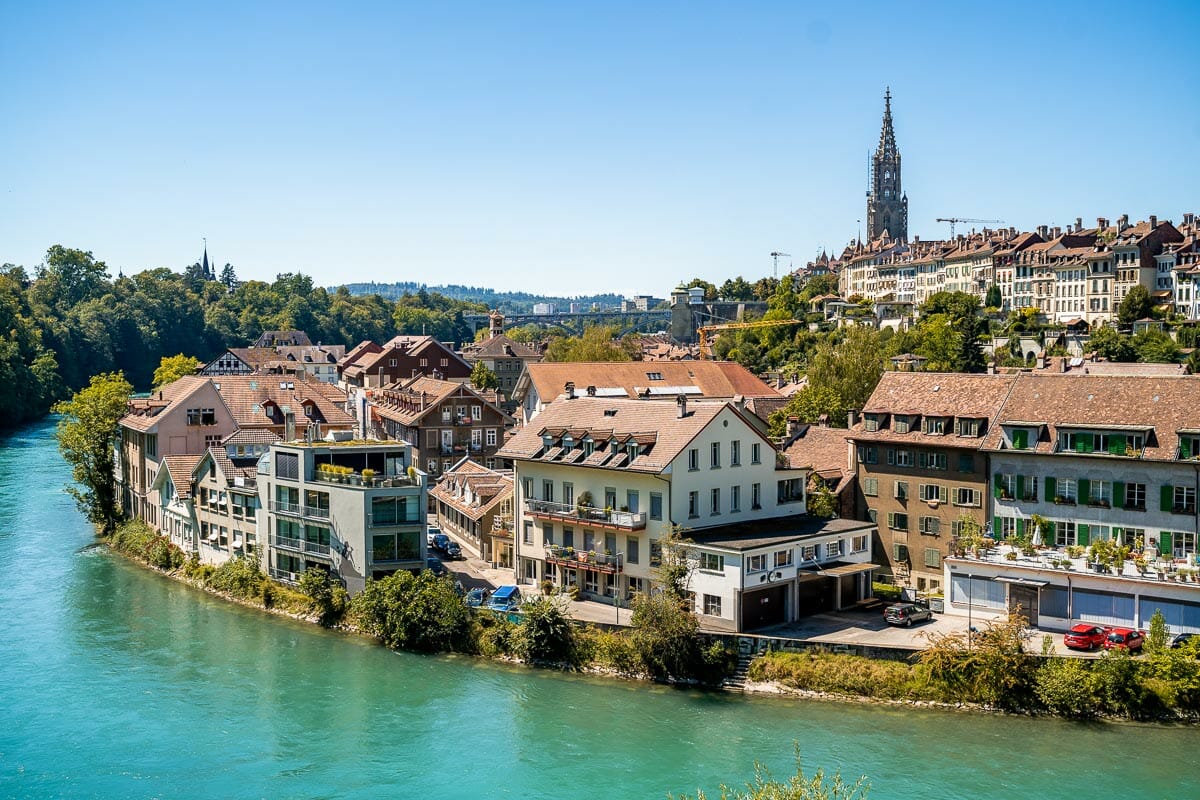
Where to stay in Bern
Bern is so small and walkable that it doesn’t really matter where you choose to stay. If you stay further out then you can connect to downtown Bern via bus or tram and then explore on foot.
It’s rare to find free parking offered at central hotels so you will need to factor in this cost on top of your accommodation. These are my suggestions of where to stay in Bern.
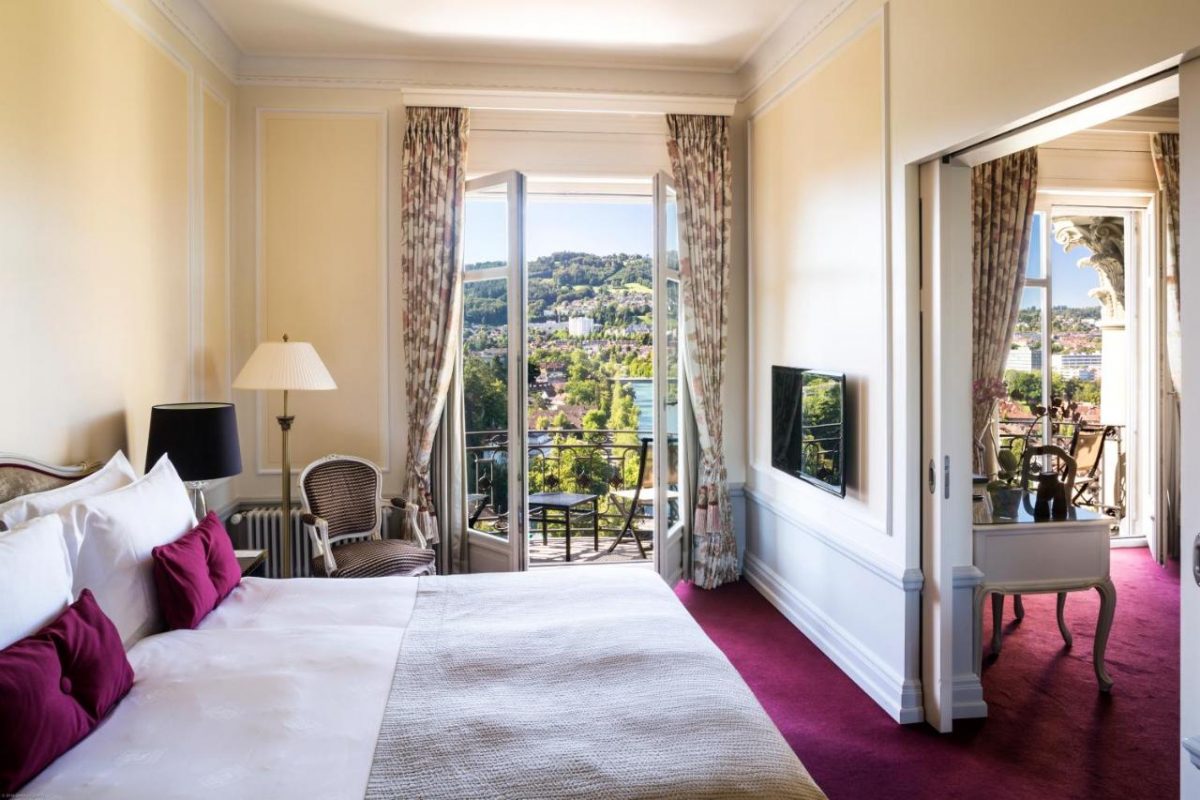
LUXURY – Hotel Bellevue Palace Bern
This opulent 5-star hotel occupies an elegant Art Nouveau building that overlooks the Bernese Alps and lively river area. Besides the lavish rooms and suites, the property contains two bars, two restaurants, a sauna, and a gym. As with the other hotels listed, parking is available with a surcharge.
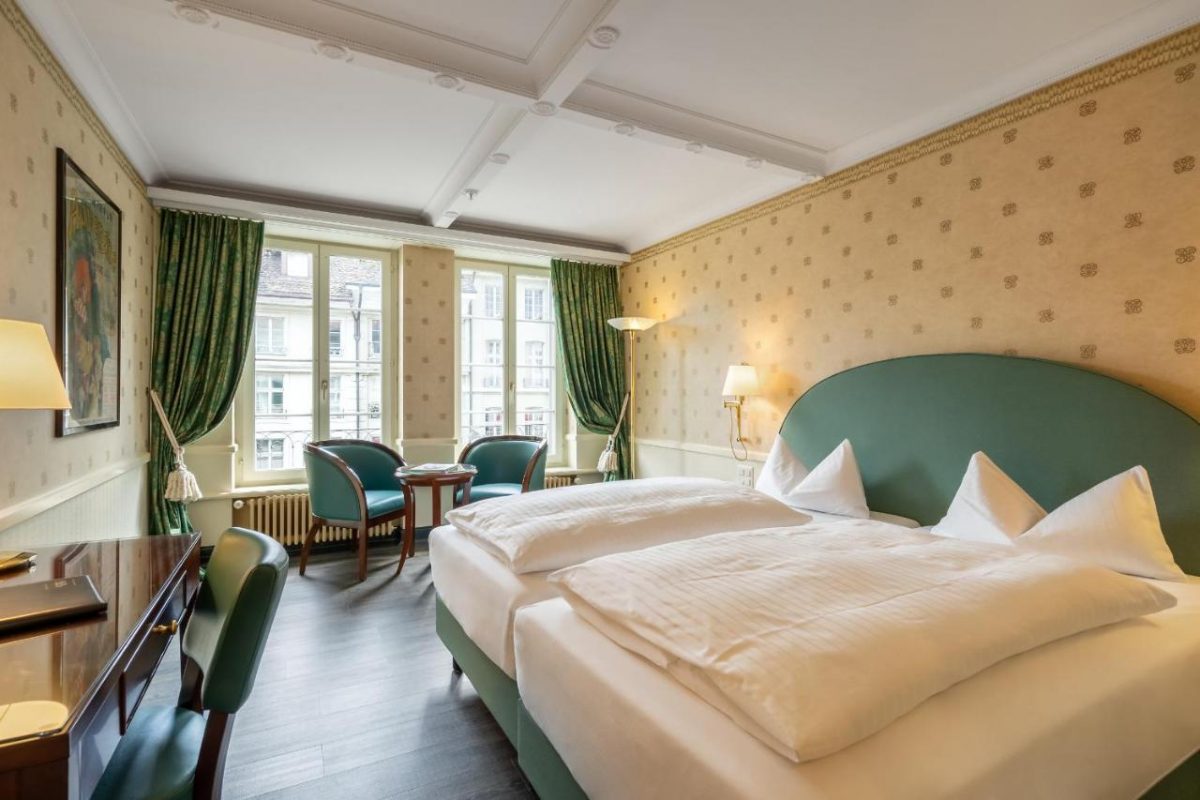
MID-RANGE – Boutique Hotel Belle Epoque
This elegant hotel is situated in the heart of Old Town and opens onto a pretty boulevard terrace where you can enjoy a meal or drink. Chic rooms and suites come with the option for a shower or bathtub and tasteful decor. Nearby parking is available for an additional fee.
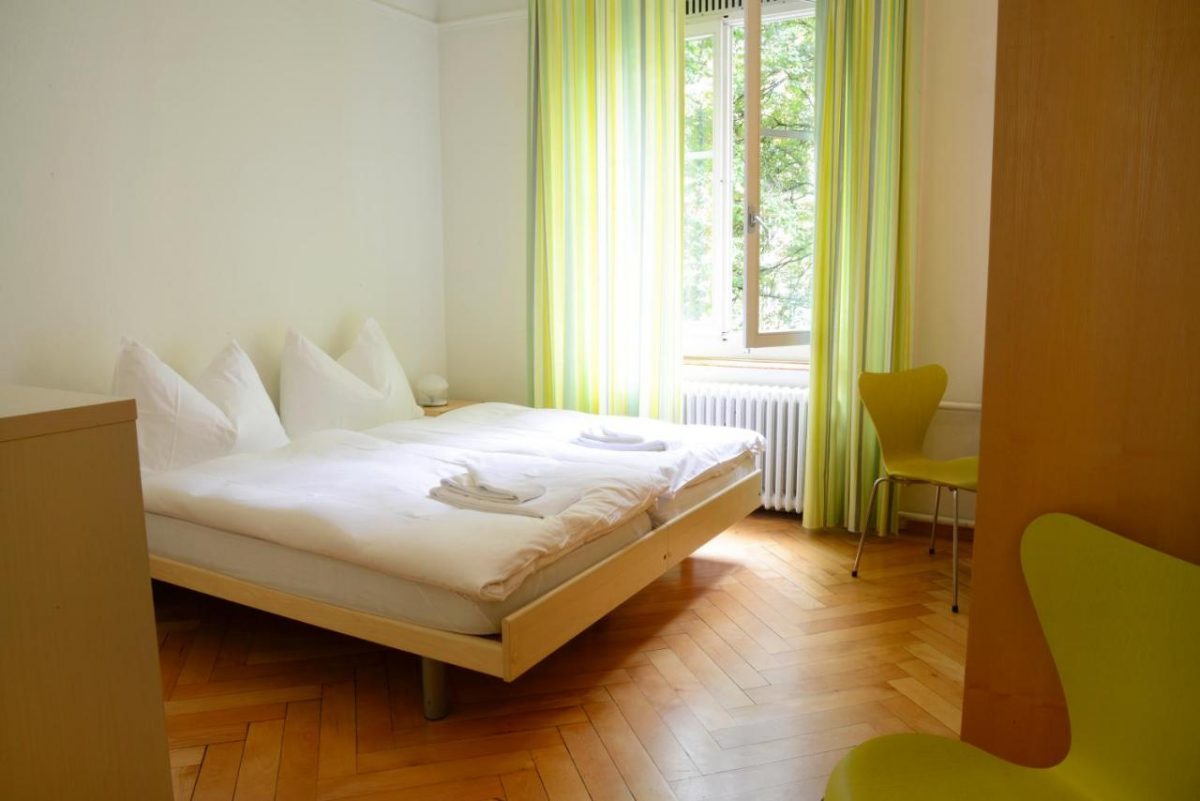
BUDGET – Hotel Marthahaus
This budget-friendly hotel is centrally located down a residential street. You can save money by reserving a room that has a shared bathroom and look forward to a complimentary breakfast. Parking is available at an additional cost.
Best things to do in Bern
Bern aldstadt .
Take a wander around this UNESCO World Heritage Site and ogle medieval architecture, elegant fountains, the tallest cathedral in Switzerland, and the impressive clock tower, Zytglogge. If you want to understand the history of the city then you can book a Bern city tour with a Lokafyer (local guide).
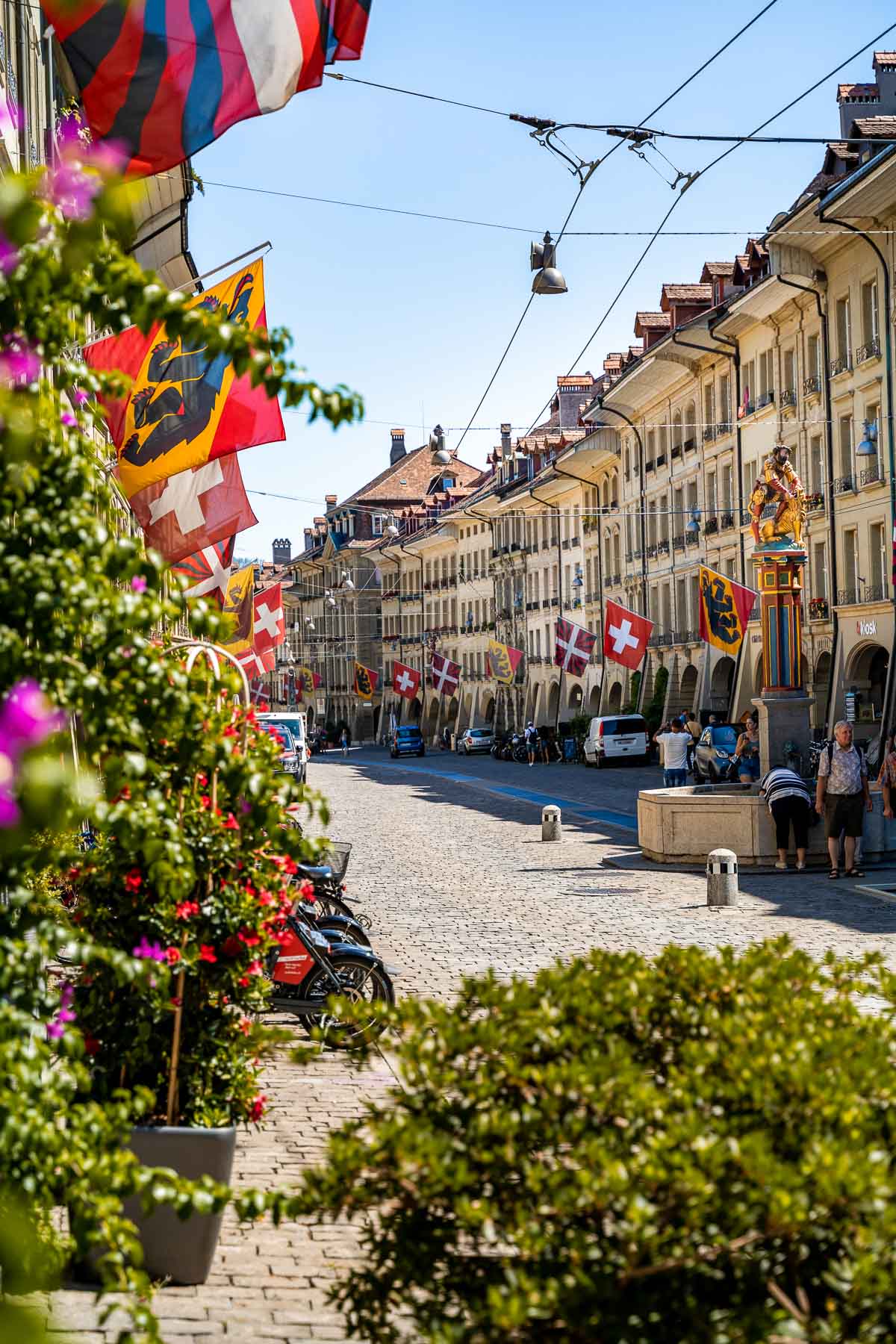
Rosengarten
Leafy Bern is abundant in green spaces but Rosengarten might be the prettiest. Located on the right bank of the River Aare, the elevated garden provides a view of the Altstadt and is brimming with roses, irises, rhododendrons, lilies, and cherry trees. Spring and summer is the best time to catch the flowers in bloom.
The Parliament Building, or Federal Palace, houses the Swiss Federal Assembly and the Federal Council. It features a classic Neo-Renaissance facade and if you elect to take a tour then you can also explore the interiors. The 26 jets of water in front of the palace represent each of Switzerland’s cantons.
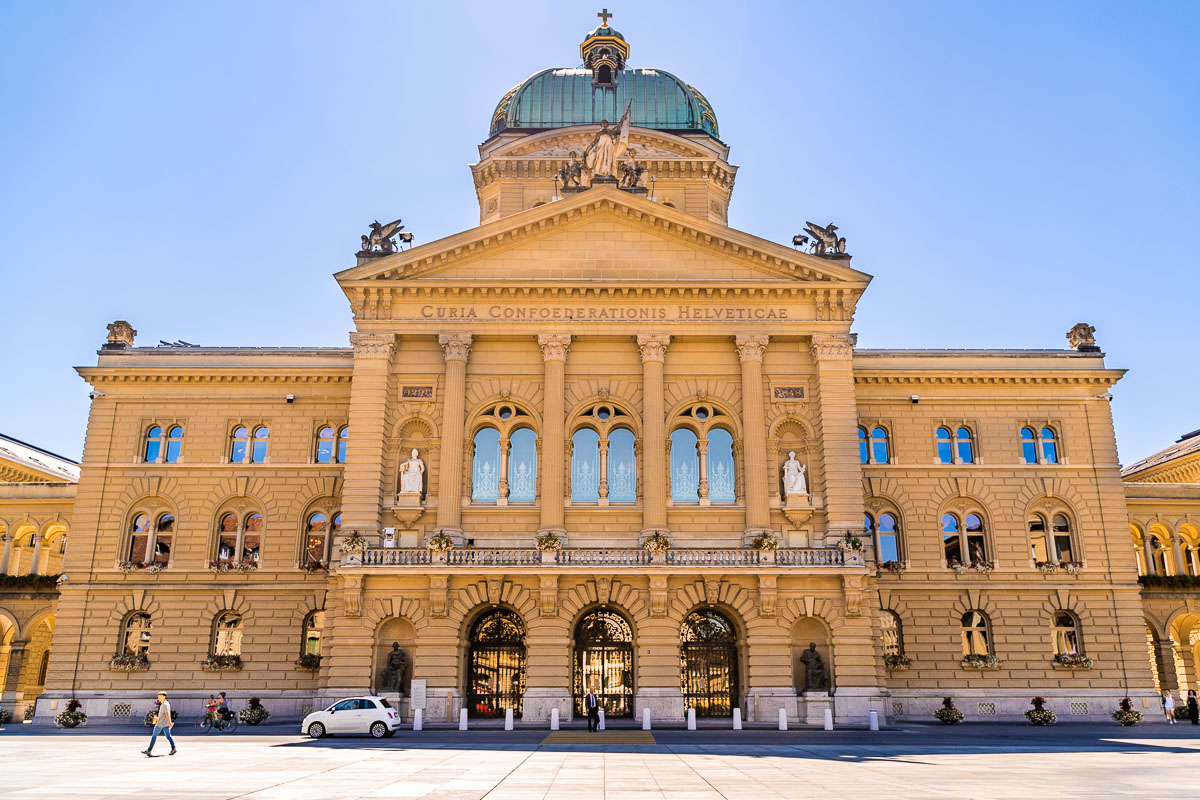
If your 2 weeks in Switzerland coincide with the warmer seasons then you can hop into the River Aare for a swim. Head to the swimming area south of Aldstadt and you will find sunbathing areas and bathing pools.
Gurten Funicular
Ride the Gurten Funicular (Gurtenbahn) to access the summit of this imposing mountain that looms to the south of the city. The peak is highly developed with places to eat and tons of viewpoints including the observation tower which grants a fantastic view over the city and surrounding valley.
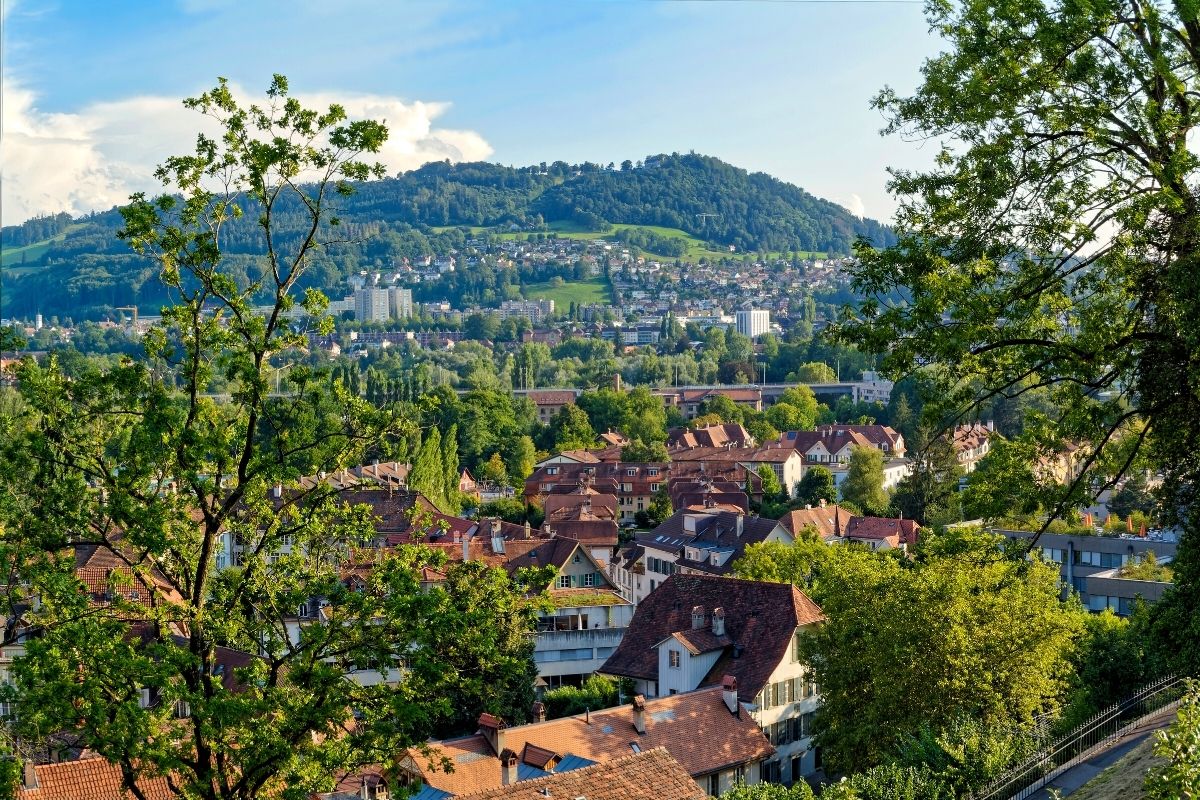
Where to eat in Bern
- Restaurant Cafe Postgasse : A small and ambient restaurant that specializes in mussels, located right in the heart of Altstadt.
- Kornhauskeller Restaurant : Sited within a vaulted cellar, this opulent restaurant serves a mix of Bernese, Swiss, and Mediterranean plates.
- Swing Kitchen : This sustainably conscious vegan restaurant excels in plant-based burgers served with their signature sweet potato fries.
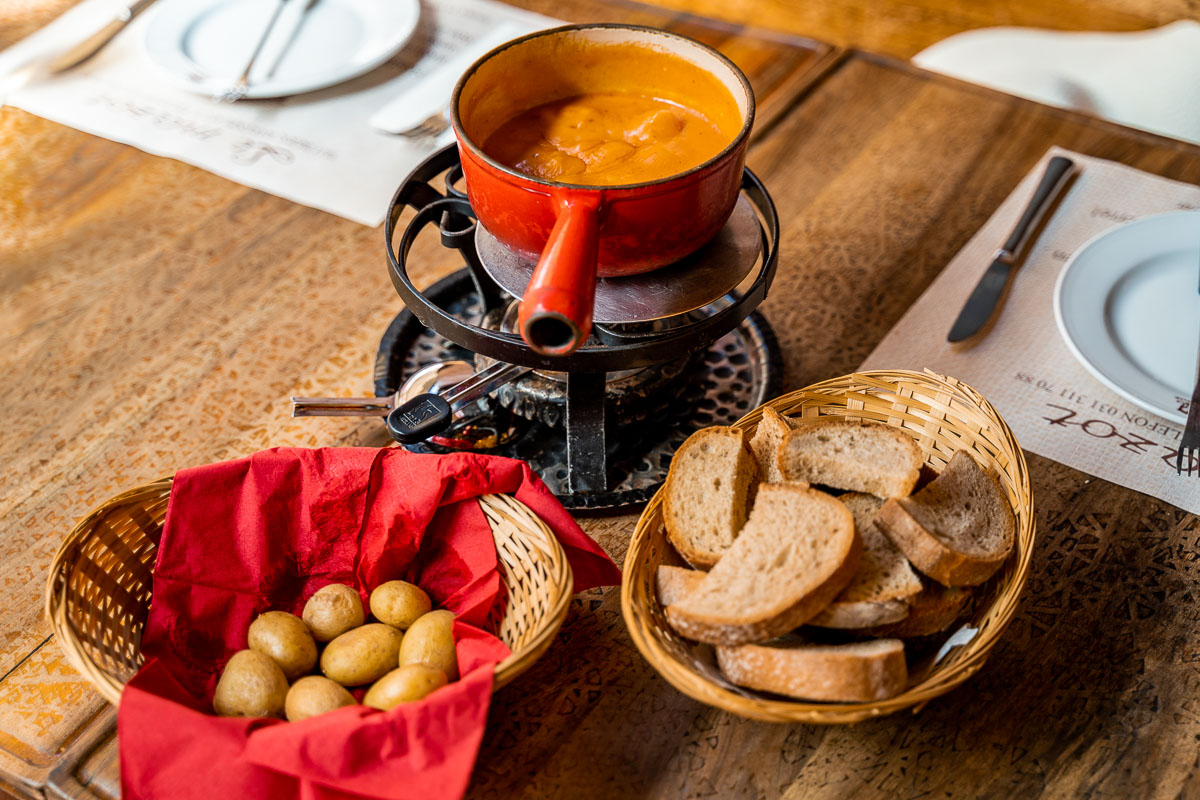
Day 7: Geneva
Driving time: 2 hours (170 km/106 miles) from Bern to Geneva
French-speaking Geneva is the second largest city in Switzerland after Zurich. Famous for its financial industry, the city is also the European seat of the United Nations and the headquarters of the Red Cross.
Geneva is located on the southern tip of Lac Léman, or Lake Geneva, and is surrounded by the Alps and Jura mountains. You can get tremendous views of Mont Blanc from the city.
Much of the lifestyle in Geneva revolves around the waterfront and the Vieille Ville (Old Town) which makes it easy to see the best of the city during one day in Geneva .
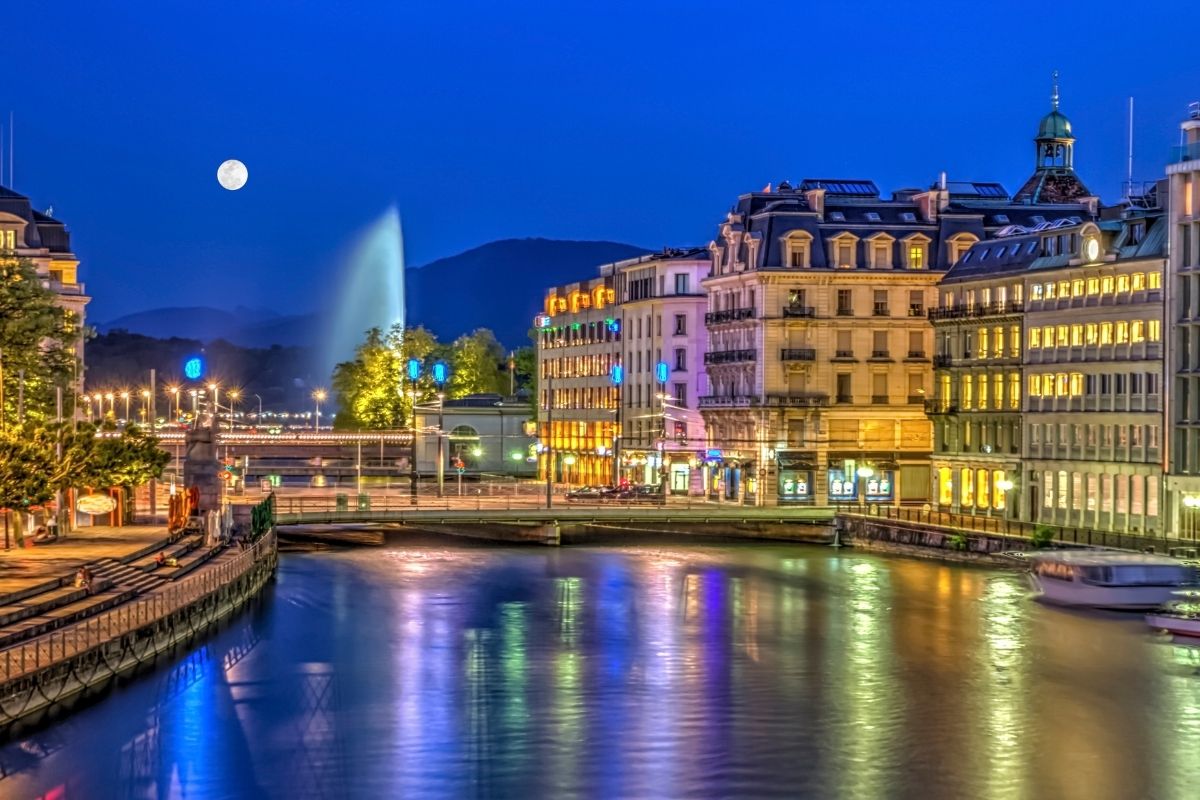
Where to stay in Geneva
As Geneva is a popular city for conventions, there are lots of no-frills hotels dotted around the airport and conference center area which have good deals. Public transport is efficient so as with Bern, you can leave your car at your hotel for the day and explore on foot.
The central city is full of chains and boutiques, these are my picks for where to stay in Geneva. You’ll have to book one night in this beautiful city because tomorrow you’ll leave for Zermatt!
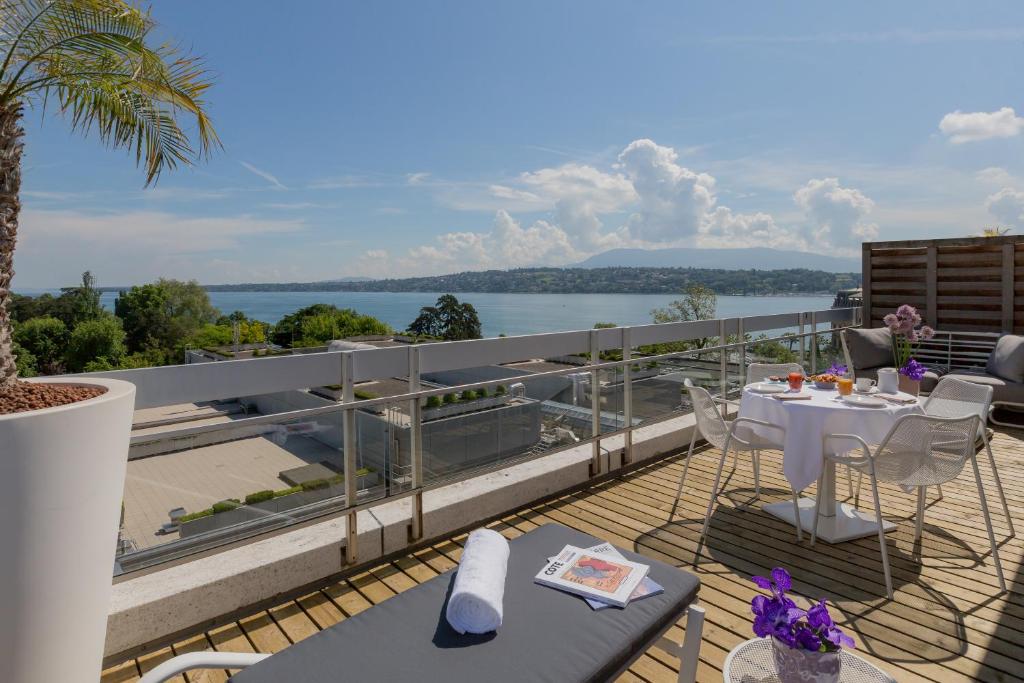
LUXURY – N’vY Manotel
Wonderfully positioned in the bohemian neighborhood of Paquis, this hotel is within walking distance of all the attractions on this one day in Geneva itinerary and equally convenient for transit. Suites feature lakeview terraces and there is an excellent spread of restaurants and bars on-site to browse.
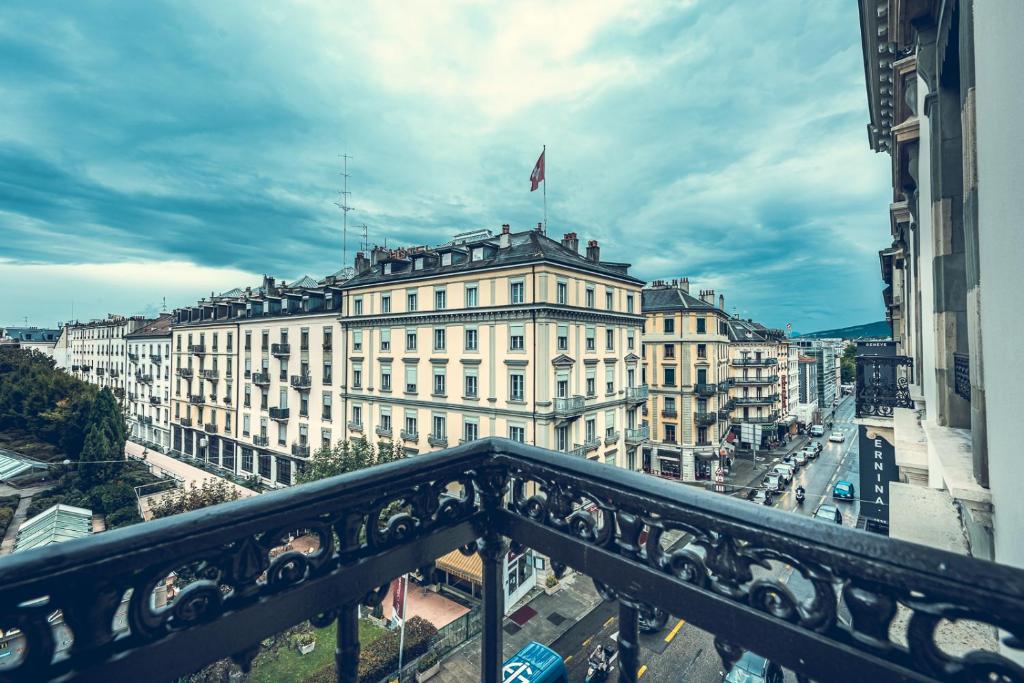
MID-RANGE – Hotel Bernina Geneva
Located opposite Geneva’s main railway station, this hotel is perfectly positioned for accessing the city via public transit and is within walking distance to all the major sights on this itinerary. Contemporary rooms are artistically styled and many feature lake views.
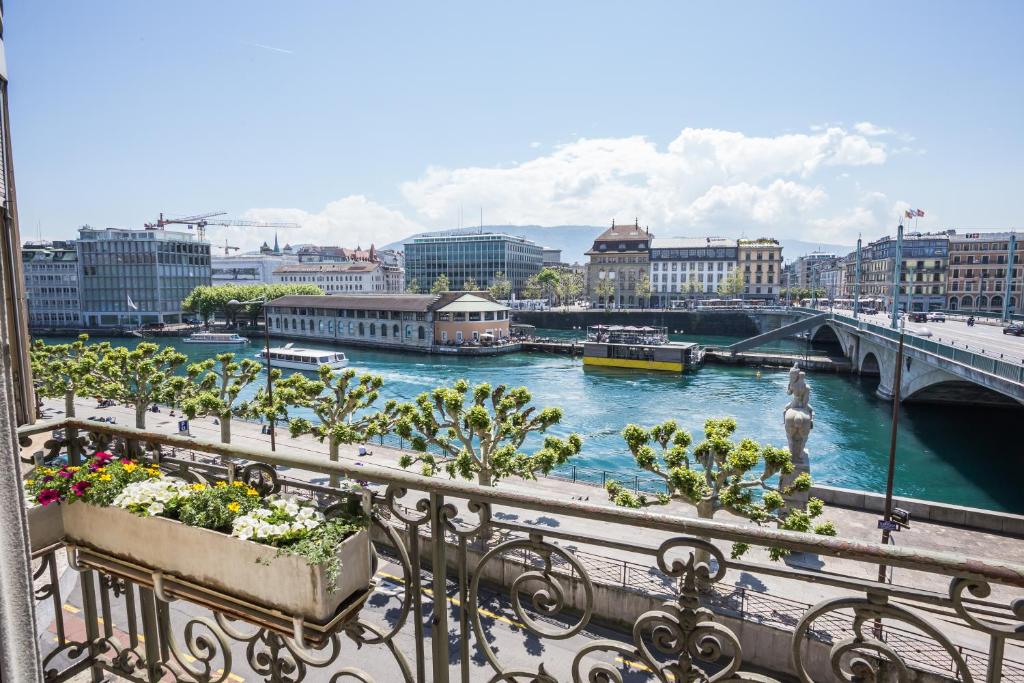
BUDGET – Hotel des Tourelles
Situated in the central St Gervais Quarter, this historic hotel is equipped with modern guest rooms furnished with free WiFi, en-suite bathrooms, and huge windows that flood the space with natural light. The best rooms offer lake views and come with balconies.
Best things to do in Geneva
Lac léman (lake geneva).
Hop aboard a cruise vessel from the Genève Mont-Blanc ferry terminal then sit back and enjoy a ride across the sensational lake. A boat tour on Lake Geneva gets you up close to Jet d’Eau, the 140 meters (459 feet) tall water fountain that is the very emblem of Geneva. During the summer season, you can opt to go stand up paddleboarding instead.
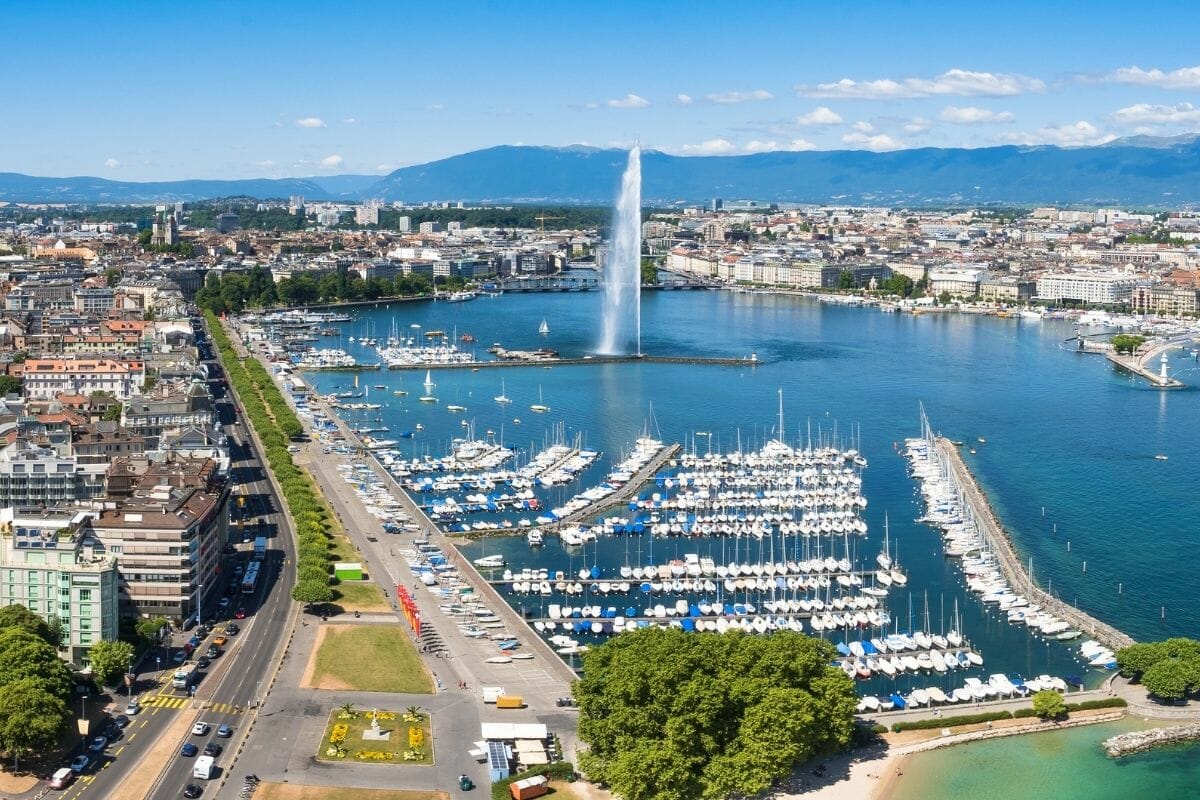
Vieille Ville (Old Town)
Geneva’s Old Town is a warren of historical buildings, churches, public squares, museums, boutiques, and restaurants. Vieille Ville winds its way up a fairly daunting hill but that means you get stunning lake views, especially once you make it to the longest benches in the world, the Banc de la Treille on the Treille Promenade.
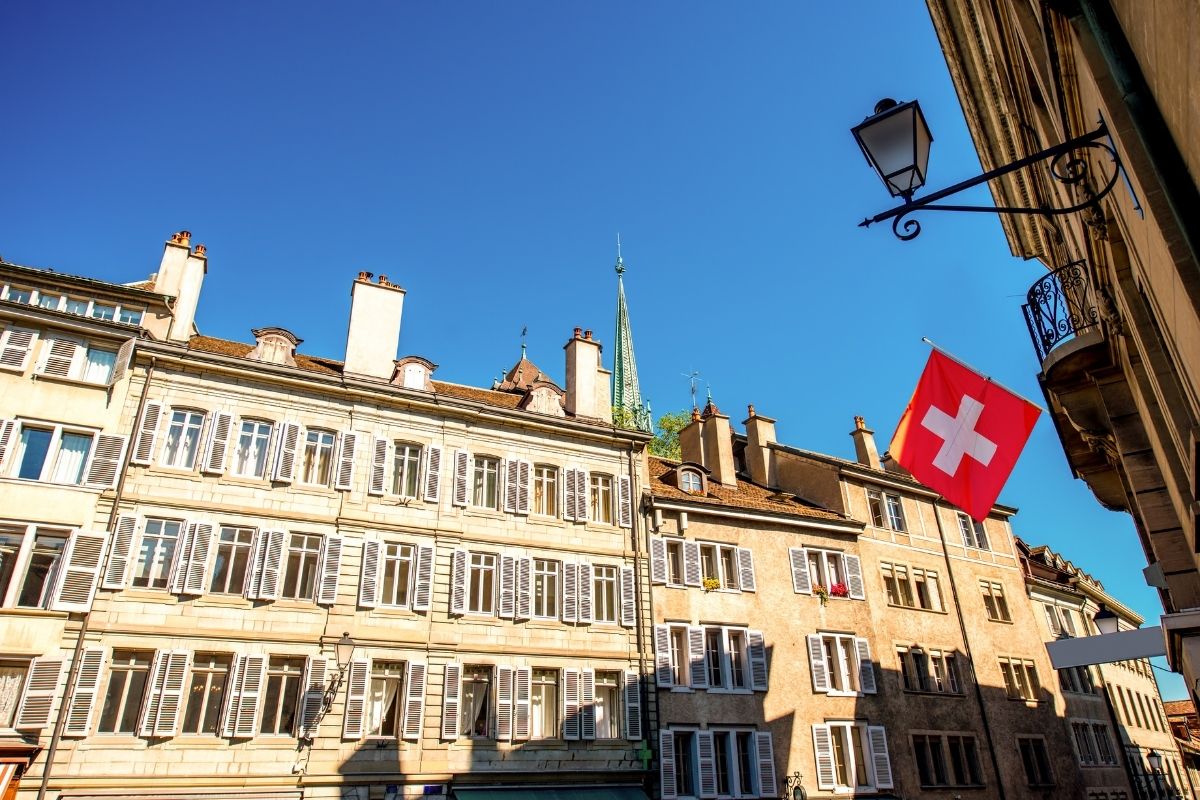
International Red Cross and Red Crescent Museum
Located a short walk from the Palais des Nations, this museum gleans insight into the humanitarian efforts of the Red Cross. It’s a moving and emotional experience but such a great opportunity to connect with the work that the committee undertakes.
Palais des Nations
Squeeze a tour of the United Nations office complex into your Switzerland road trip. This includes a visit to the Assembly Hall and Council Chamber and teaches you so much about the intricacies of the intergovernmental organization. Outside you can catch the Alley of Flags fluttering the breeze and explore the grounds.
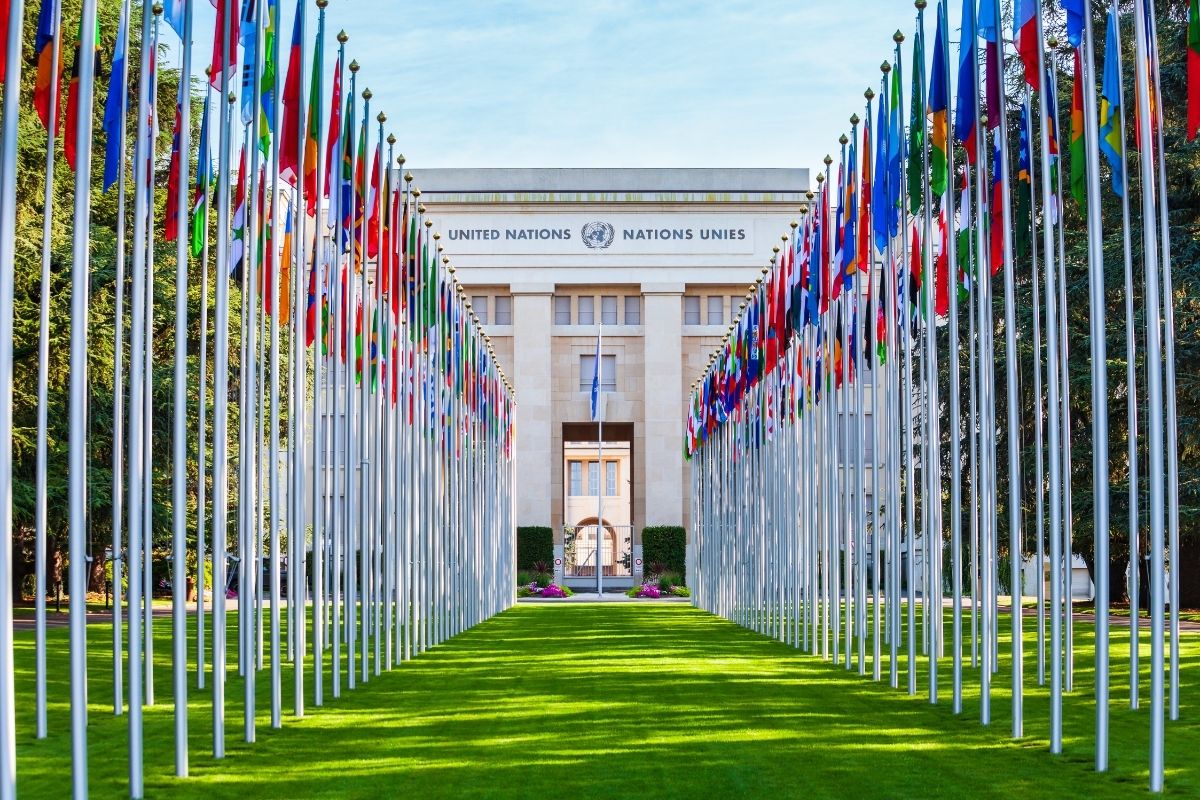
Bains des Pâquis
These public baths are located on a pier that stretches out over Lac Léman and are the perfect place to wrap up your day in Geneva with a dip. During winter you might prefer to head straight to the sauna or hammam. Massage treatments are also available.
Reformation Wall
Geneva was the ground of the Protestant Reformation and there are plenty of museums and historic sites in the city where you can learn about what happened. Located just on the outskirts of Aldstadt, the Reformation Wall is a great place to start your journey into Geneva’s past!
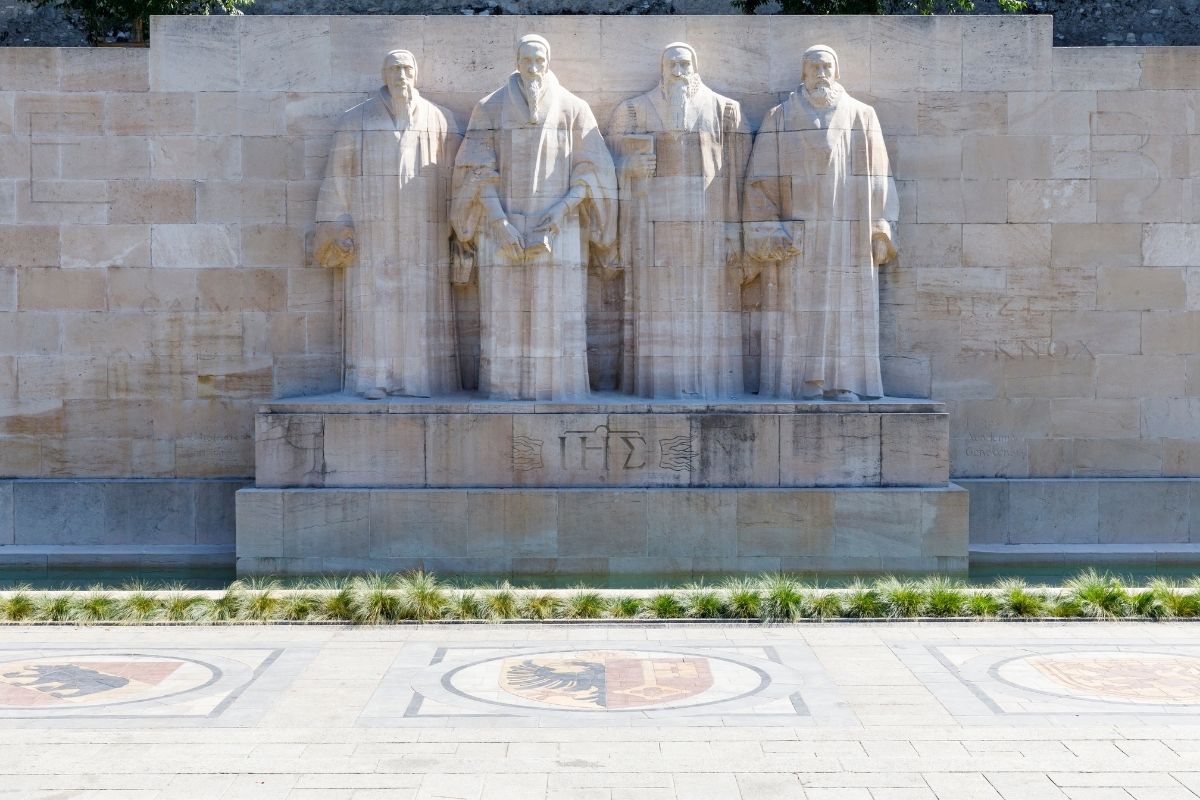
Buy Chocolate
Geneva is the birthplace of some of the best chocolate on the planet so take some time to peruse a couple of chocolatiers. You can pick up souvenirs and replenish your snacks for the rest of your 2 week Switzerland road trip itinerary.
Where to eat in Geneva
- Cafe du Soleil : Sample the best fondue in Geneva alongside other Swiss delicacies at this casual cafe which isn’t too far from the Pâquis-Nations.
- Corde Coffee : This colorful cafe is one of the best stops for a flavorsome brew and a delicious slice of freshly baked cake.
- Street Gourmet (temporarily closed) : Perfect for a healthy lunch, this restaurant rustles up salads, sandwiches, and soups to suit all palates.
- Living Room Bar & Kitchen : Swiss with a touch of Nordic, this is the restaurant of the Ritz-Carlton Hotel and it’s one of the best options for a gourmet treat while in Geneva.
Day 8: Geneva to Zermatt
The total distance from Geneva to Zermatt via the attractions listed below is 240 km (149.1 miles) and the drive time is around 3 hours 15 minutes.
Driving time: 50 minutes (64 km/40 miles) from Geneva to Lausanne
Situated on the north shore of Lac Léman, Lausanne is an attractive lakeside city known for its medieval architecture and its connections to the Olympics. It’s the setting of the International Olympic Committee headquarters, the Olympic Museum, and the Olympic Park.
If you’re a fan of the games then you can take a journey through Olympic heritage at the museum which contains kits, torches, medals, and other memorabilia from the past tournaments.
The Olympic Park is studded with sculptures honoring the athletes and games and there’s a 100-meter track if you want to find out if you’re a contender for the next Olympics!
Besides the Olympics attractions, art fans may also want to visit Platform 10 where you can survey over 10,000 works of art from 19th and 20th century Swiss artists.
You can get a wonderful view of the city and lake from the Jardin Botanique de Lausanne and the Lausanne Cathedral is well worth a visit.
The walk along the Ouchy promenade is the perfect place to stretch your legs and soak up panoramas of Lac Léman from this perspective.
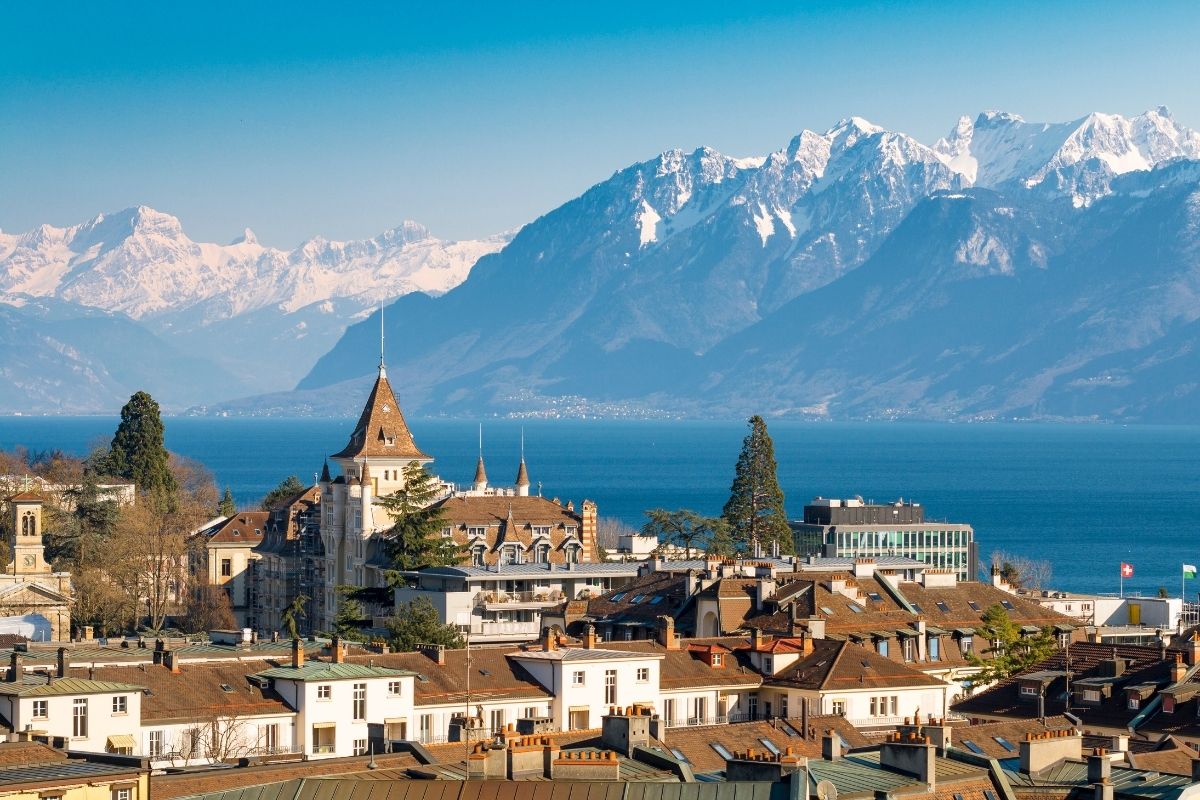
Chillon Castle
Driving time: 40 minutes (40 km/25 miles) from Lausanne to Chillon Castle
One of the most beautiful castles in Europe , this dreamy Swiss castle sits in a fairytale position on the eastern curve of Lac Léman. In the local ancient language, Chillon meant ‘rocky platform’ and this is an accurate depiction of the archaeological site.
With the site dating back to the Bronze Age, the history of the castle is divided into three eras: the Savoy Period (12-16th centuries), the Bernese Period (16-18th centuries), and the Vaudois Period (18th century until present day).
Chillon Castle is open daily, 10 am – 6 pm (last entry 5 pm). The opening time may be different depending on the month, therefore make sure you check their website before your visit for up-to-date information.
The tickets cost 13.50 CHF (€15). You can book a ticket online in advance or buy one at the castle itself. If you don’t want to go inside the castle it’s still worth stopping by to admire the views.
One of the best viewpoints of the castle is at Snack Café and another one is from the other side, around the Château de Chillon ferry port.
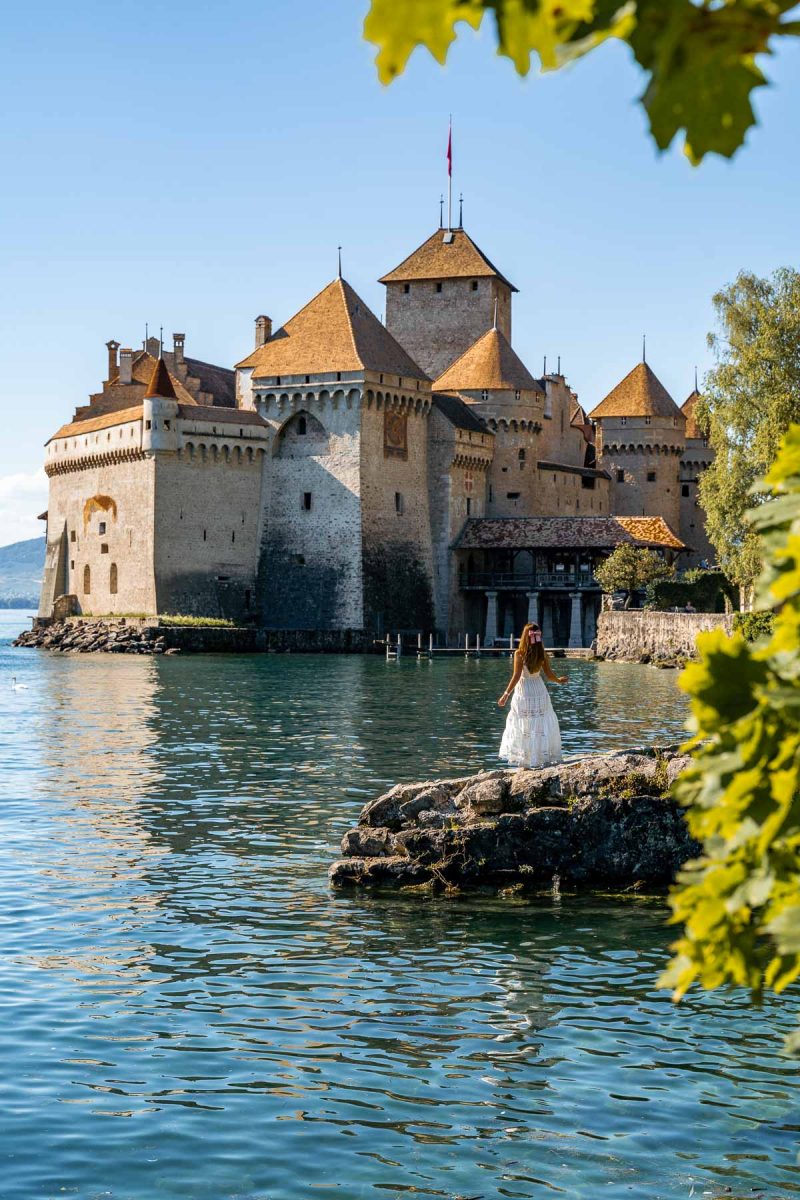
Arriving to Zermatt
Driving time: 1 hour and 45 minutes (135 km/84 miles) from Chillon Castle to Täsch
Being an entirely car free town, unfortunately it’s not possible to travel all the way to Zermatt with your car. But worry not, there is a solution! You can leave your car at a nearby town called Täsch from where you can take a train to Zermatt.
The train ride takes only 12 minutes and trains run in every 20 minutes from early morning till late night. A one-way ticket costs around 8 CHF (€8.20) and if you want to avoid paying a fortune for taxis, this is the only way to get to Zermatt.
Where to stay in Zermatt (2 nights)
Once in Zermatt, you can get around on foot and via the cable cars that service the town. Since it’s a small town, you can basically stay anywhere and you’ll still be in walking distance from all the main highlights of the town.
For Zermatt, you’ll need to book 2 nights of accommodation, below you can find my top picks for every budget.
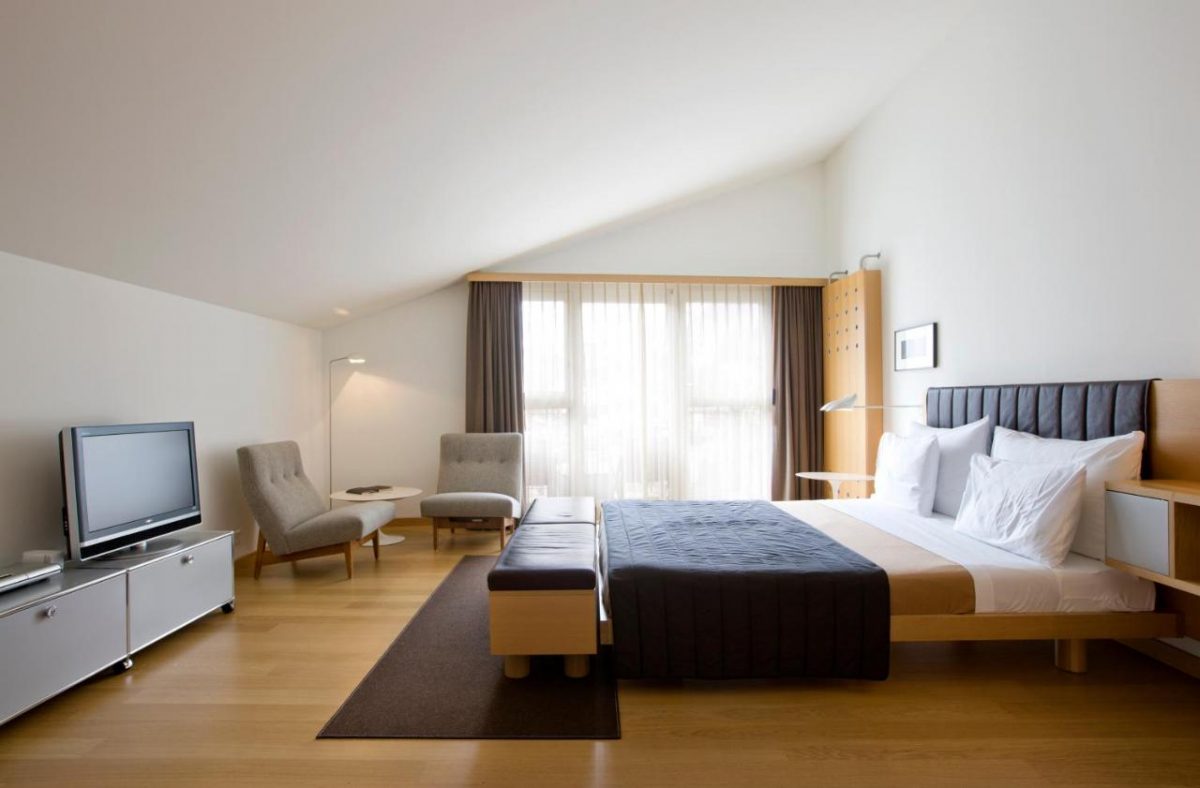
LUXURY – The Omnia
Situated on a rock, 45 m above the roofs of central Zermatt, guests access The Omnia via a tunnel leading to an elevator, which brings them right into the lobby. Guests can taste refined international cuisine made from selected seasonal ingredients in the restaurant or on the terrace.
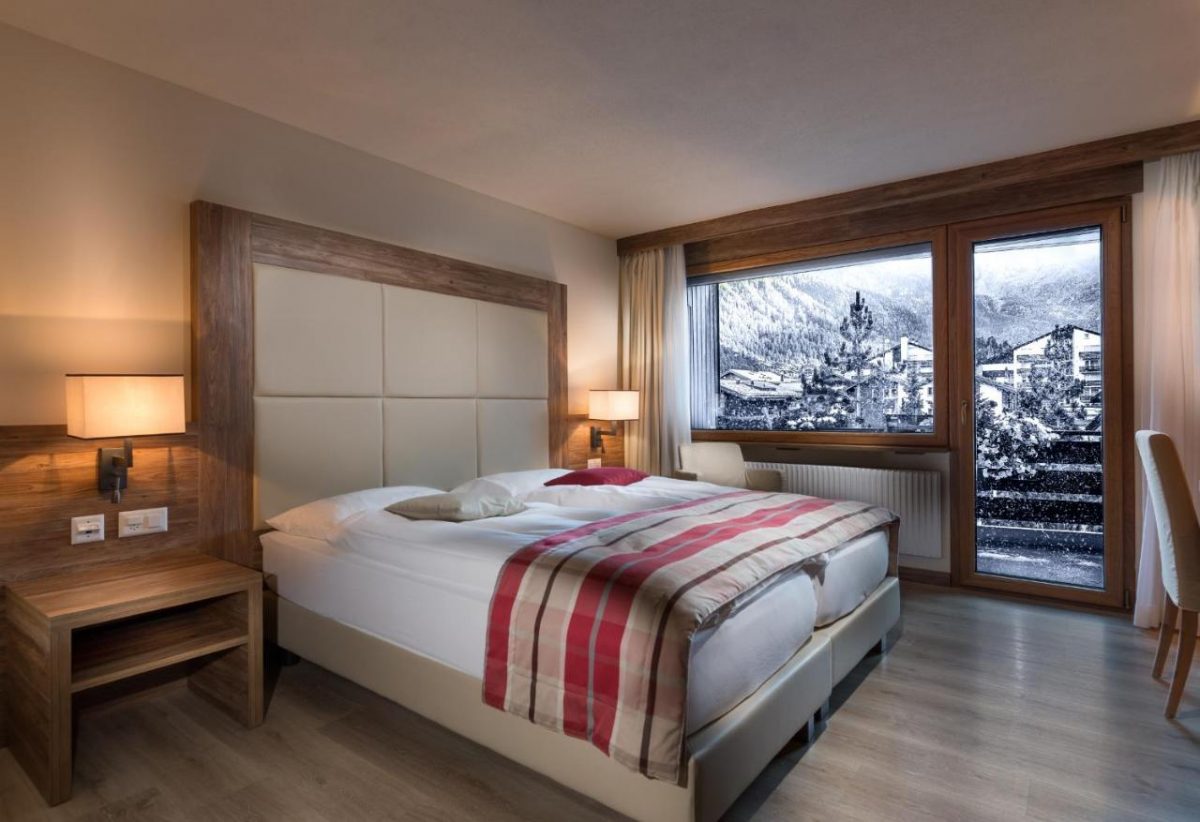
MID-RANGE – Hotel Ambassador Zermatt
The Hotel Ambassador Zermatt enjoys a central location, only 100 m from the Zermatt train station and the Gornergrat rack railway station. All rooms and apartments feature a balcony offering panoramic views of the surrounding mountains, including the Matterhorn.
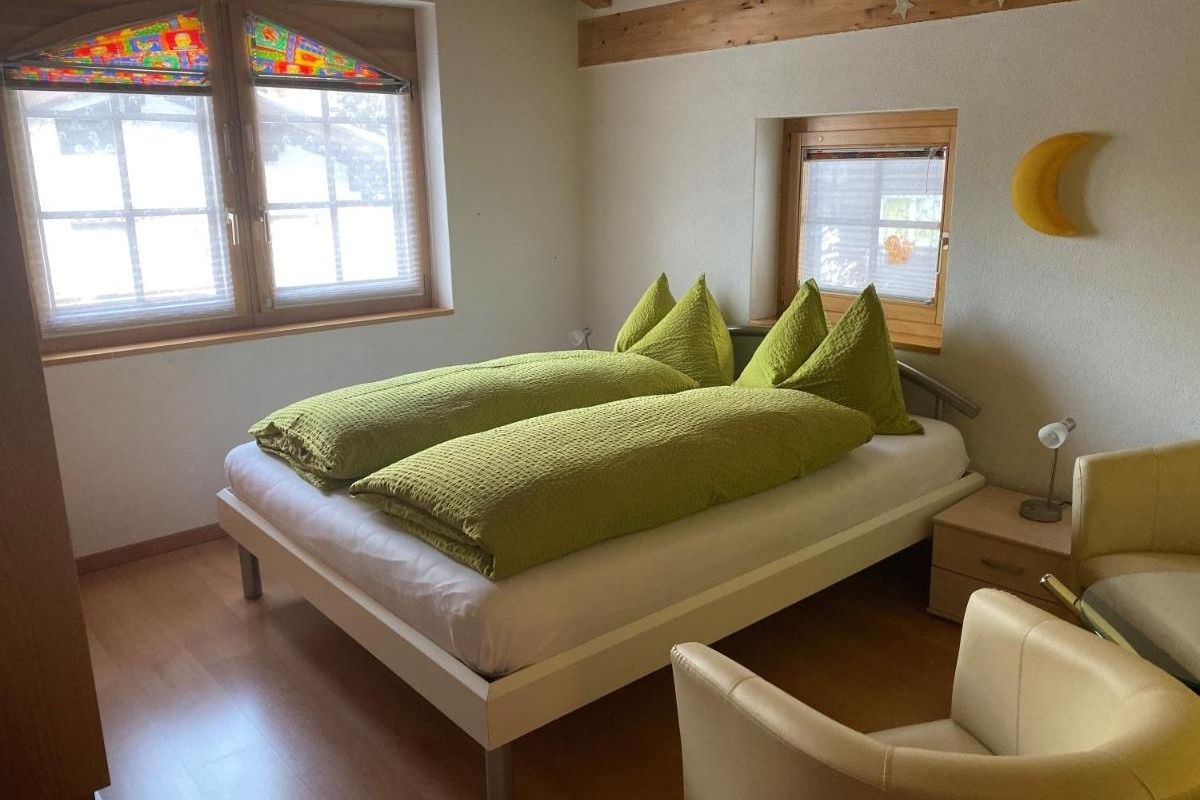
BUDGET – Hotel Adonis
Excellently located for walking into the center of town and scooting up the cableways, this hotel offers splendid mountain views. Most rooms come with a private balcony. At an additional fee, you can include breakfast in the rate.
Day 9: Zermatt
As I mentioned before, Zermatt is a car free town so good news is that you don’t need to use your car for today! You can just comfortably get around on foot and you can also take advantage of the cable cars to access the higher viewpoints/hikes.
Zermatt Five Lakes Hike
Rise early to tackle the majestic Five Lakes Hike (5-Seenweg). This is an easy walk that gives you the chance to ogle a series of beautiful alpine lakes and take in vistas of Matterhorn’s jagged peak rising in the distance of the Valais Alps.
The five lakes that you will visit are Stellisee, Grindjisee, Grünsee, Moosjisee, and Leisee.
This hike is 9.8 km (6.1 miles) and takes approximately 3.5 hours to complete, but you might want to factor in additional time for walking around the lakes and taking photos. It’s not too strenuous with lots of flat and downhill sections, with the occasional short but steep chunk.
The starting point is the Blauherd cable car station which is accessible via the funicular from Zermatt town and then the cable car from Sunnegga. A return ticket typically costs between 53-58.5 CHF (€55-60.70) depending on the season you visit.
The trail concludes at Sunnegga station and is clearly marked for the duration of the hike, you just need to follow the signs marked 5-Seenweg.
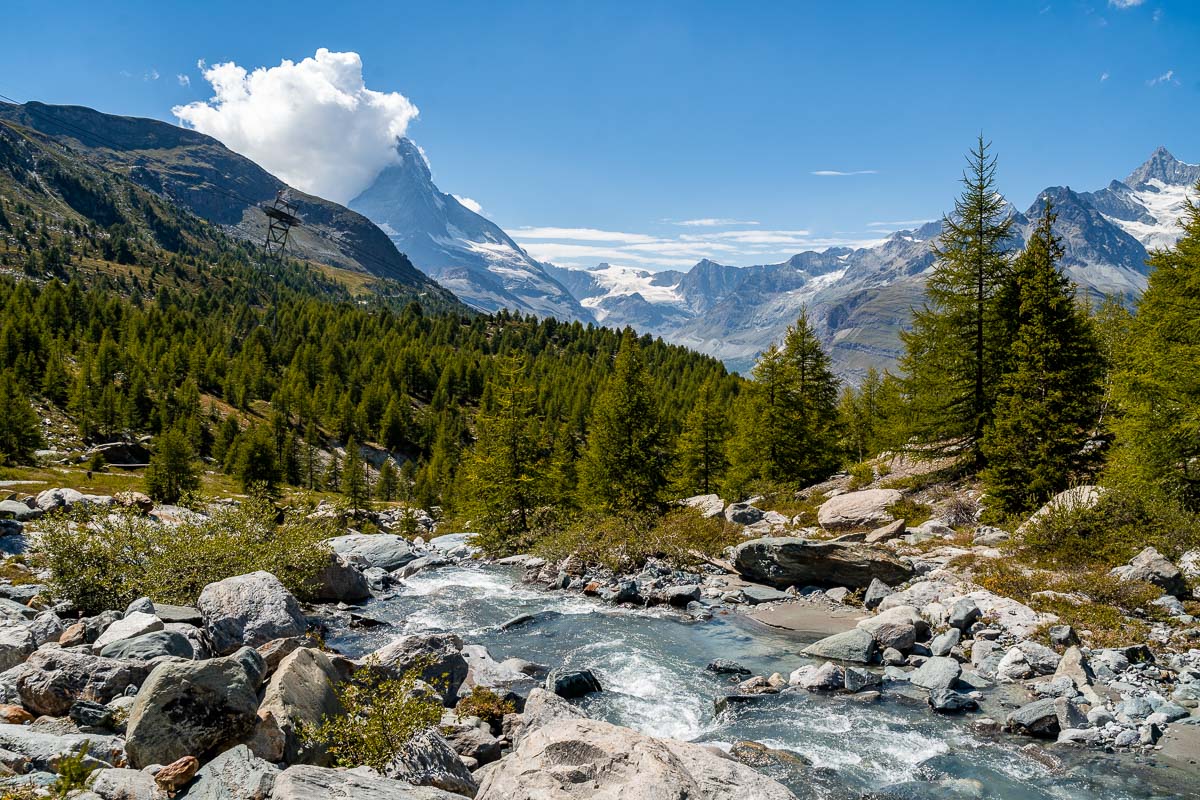
Afternoon in Zermatt
After the hike, you can ride the cable car back down to Zermatt and spend the afternoon exploring the town.
If you want to soak up more mountain views then you can ride the Gornergrat Bahn funicular up to the Gornergrat viewpoint. This is the highest open-air cog railway in Europe and its route includes a vertical climb of 1,469 meters (4,820 feet) as the train jostles through alpine ravines and larch forest.
The ride takes 30 minutes each way and it’s located at the main Zermatt train station. Although the view is indeed beautiful, brace yourself for the steep price: a return ticket costs 134.50 CHF (€139.60) per person.
Besides the funicular, you can enjoy a wander through the streets of Zermatt to see the traditional Walser houses. Stroll down Hinterdorfstrasse past the archaic wooden chalets.
If you want to learn more about the regional history and tales of the mountaineers who have mastered the ascent up the Matterhorn, you can visit the Matterhorn Museum, Zermatlantis.
The main lure of Zermatt is that the town offers wonderful views of the iconic pyramid-shaped peak. After the hike you might feel satiated with what you’ve seen, but, if not, you can walk up to the official viewpoint from the town.
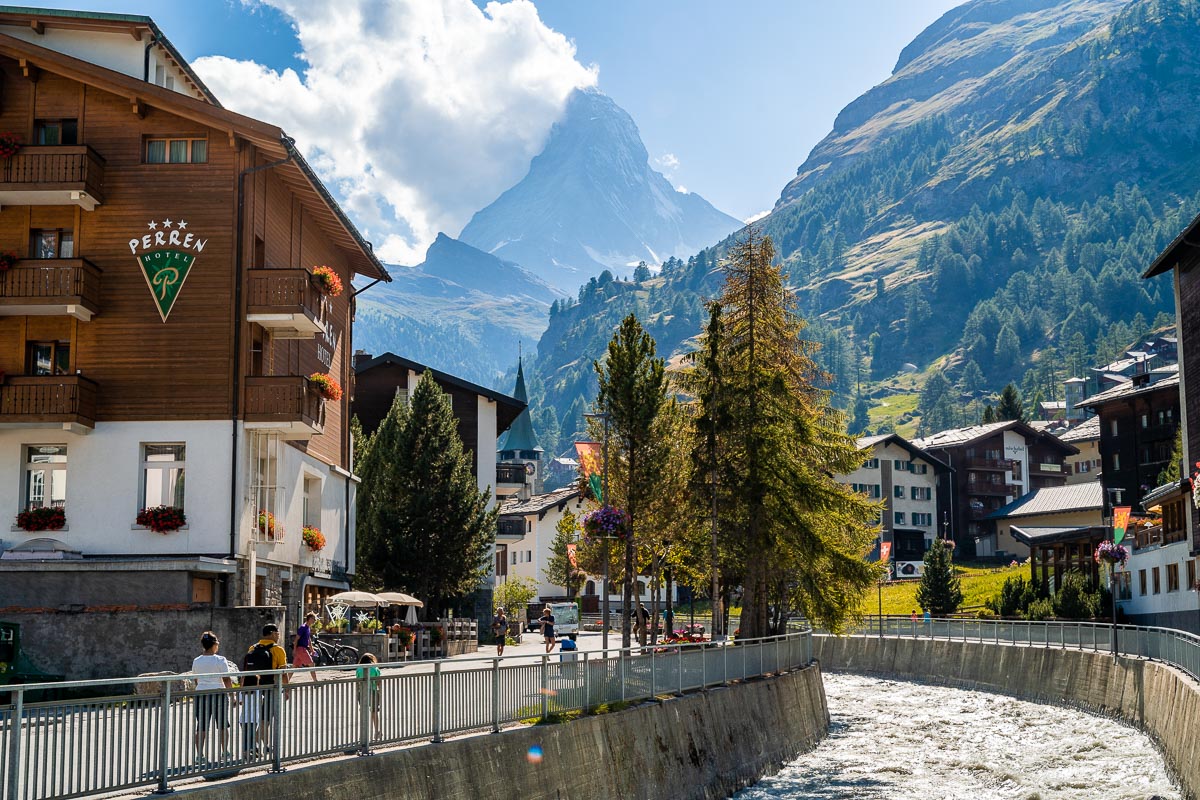
Day 10: Zermatt to Lugano via Grimselpass & Furkapass
This morning you will need to reunite yourself with your car and drive the 300 km (186 miles) to Lugano via the attractions below.
The total driving time today is around 5.5 hours, excluding time spent at the attractions, so you will need to depart from Zermatt and Täsch as early as possible.
Grimselpass
Driving time: 1 hour and 40 minutes (90 km/56 miles) from Täsch to Grimselpass
You will follow the Grimselpass, one of the most scenic roads that you’ll encounter during this 2 week Switzerland road trip itinerary. The elevated route sits at 2,164 meters (7,100 feet) above sea level and is one of the highest altitude paved roads in Europe.
Connecting the cantons of Bern and Valais, it is a showcase of wilderness that includes granite rocks, lakes, and power plants.
The full pass is 38 km (24 miles) and it is usually only accessible during late spring until October. You can park up by Totensee to break up the journey and appreciate the scenery before turning around and heading back towards Furkapass.
Drive through the whole Grimselpass means you’ll need to take a bit of a detour so feel free to pass on it if you’d rather save some time.
Furkapass & Hotel Belvedere
Driving time: 17 minutes (14 km/9 miles) from Grimselpass to Hotel Belvedere
Furkapass is another high-altitude mountain pass, this one registering at an elevation of 2,429 meters (7,969 feet). It connects the Valais hamlet of Gletsch with Realp, in the canton of Uri. As you drive along the road you might find the scenery familiar. That’s because it was used as a filming location in the James Bond movie, Goldfinger .
Park your car at Hotel Belvédère which sits on the western end of the pass and you can walk up to the Rhone glacier.
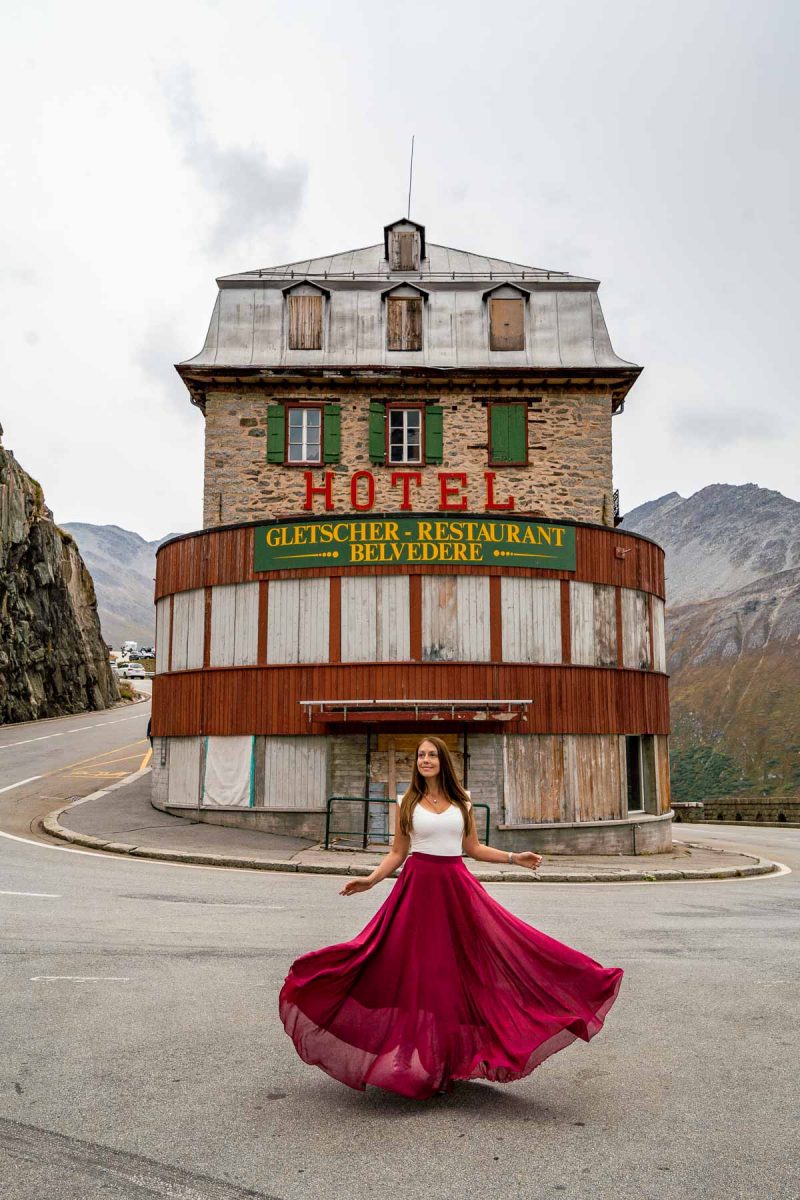
Swing the World Nara
Driving time: 2 hours (106 km/66 miles) from Hotel Belvedere to Swing the World Nara
If you loved the Giant Swing in Tschentenalp then you’ll be pleased to know that you can visit two more amazing swings today!
These pair of swings that have been positioned in the Nara ski region are part of a project from Swing the World who installed swings in 11 different locations through the Ticino area. (Hint: You’ll be able to visit another location the next day!)
It was a bit of a struggle to find these swings first because I couldn’t find any proper information about them online but don’t worry, now you have me! First of all, you need to drive up to Cancori on a very narrow mountain road.
The road is so narrow that it can barely fit one car and it’s a two-way road! So I would only recommend driving up if you’re an experienced driver and you don’t have a fear of heights.
Once you made it to Cancori, find the small church (Kleine Kapelle) where you can park your car. From here, you only need to walk 5 minutes to the first swing and 10 minutes to the second swing. You just have to look out for signs that says “Altalena” and you’ll definitely find them.
This is your moment to seize the day and get that perfect shot for Instagram so have your camera ready! A portrait of you soaring above the Swiss Alps is the perfect souvenir from your 2 weeks in Switzerland.
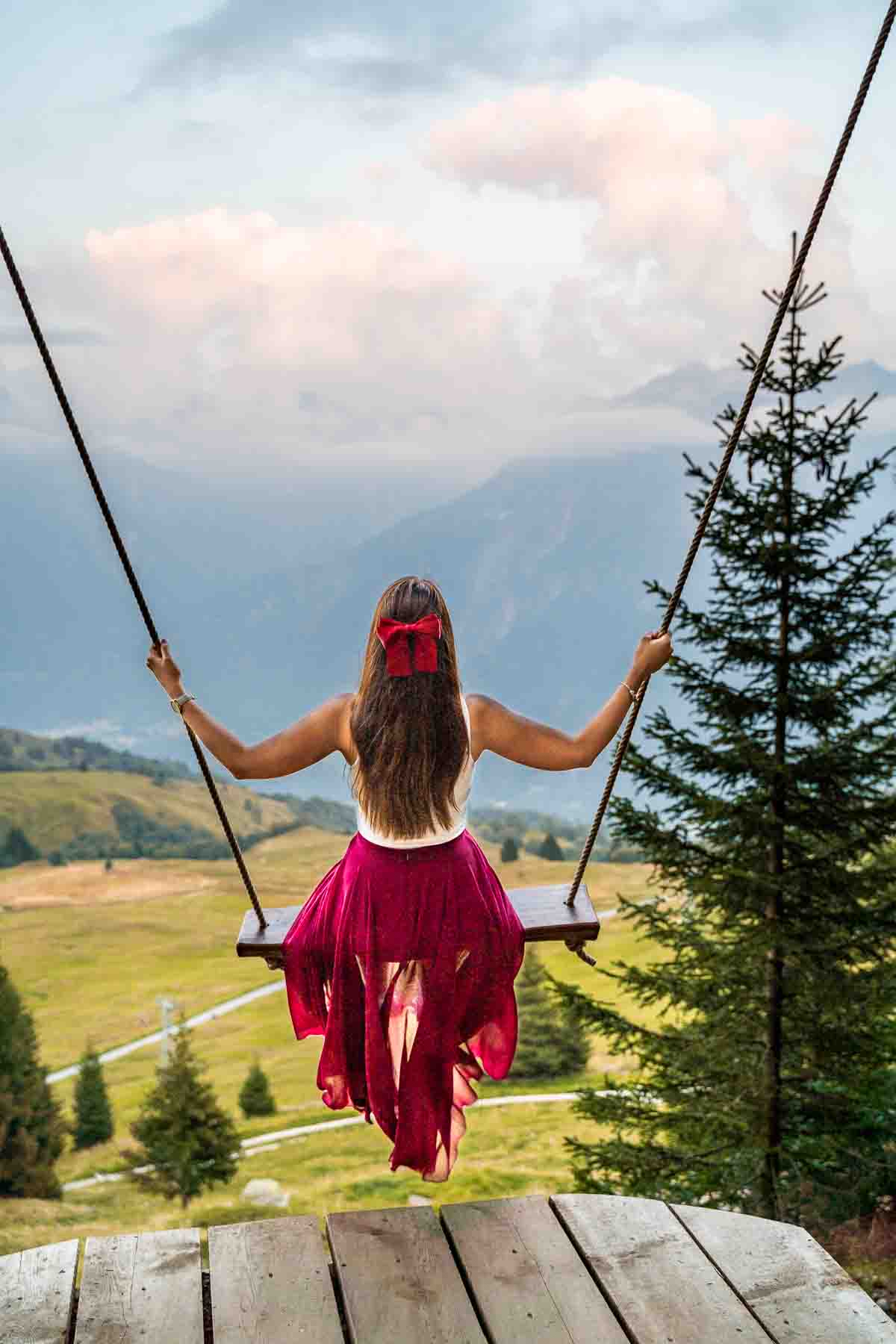
Arriving to Lugano
Driving time: 1 hour and 20 minutes (78 km/48 miles) from Swing the World Nara to Lugano
Once you had your moment on the swings, it’s time to head back to your car and drive to Lugano where you’ll be spending the next two nights.
It takes roughly around 1.5 hours to reach Lugano from Cancori and unfortunately you’ll have to take the same mountain road you drove up on. Try to leave the swings before it gets dark as it’s really challenging to drive down during the night!
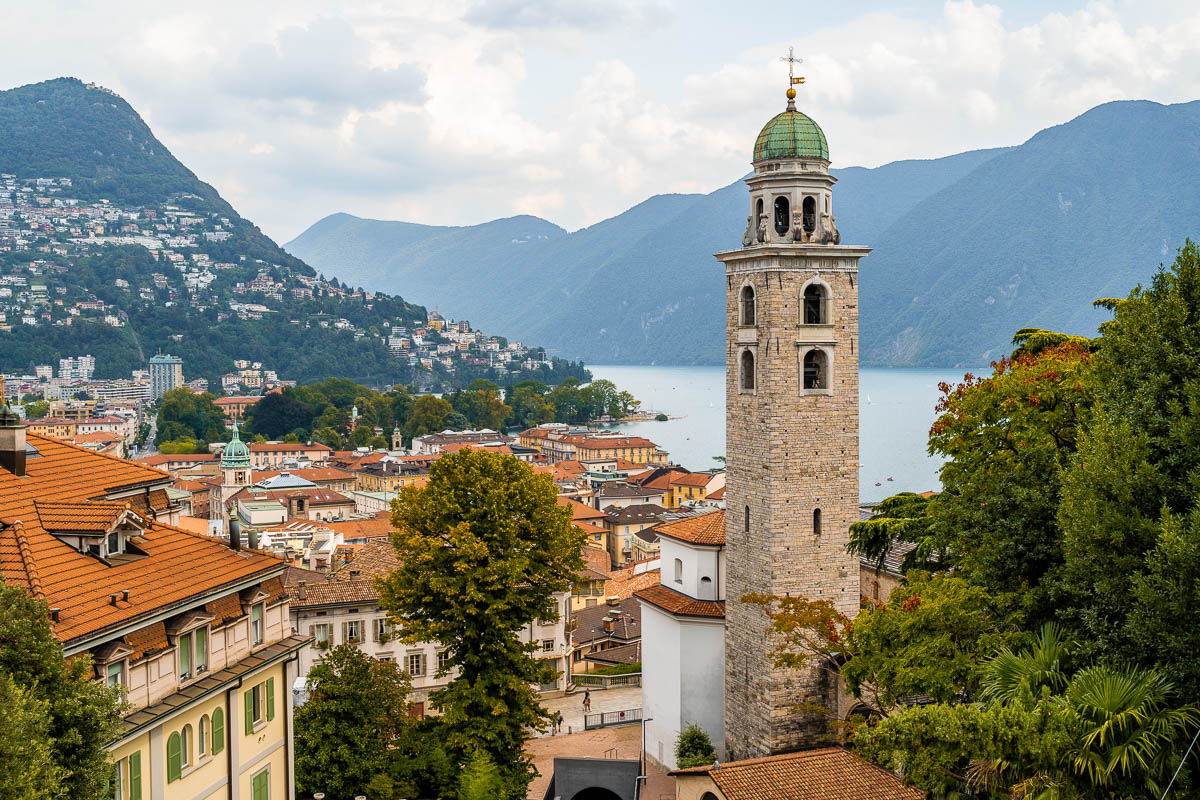
Where to stay in Lugano (2 nights)
Lugano is an interesting mix of Swiss and Mediterranean influences so if you want to explore the culture and food then you might prefer to stay in the town center. Alternatively, there are lots of appealing hotels dotted along the lakeside further out of town.
Below you can find my recommendations for the best places to stay in Lugano.
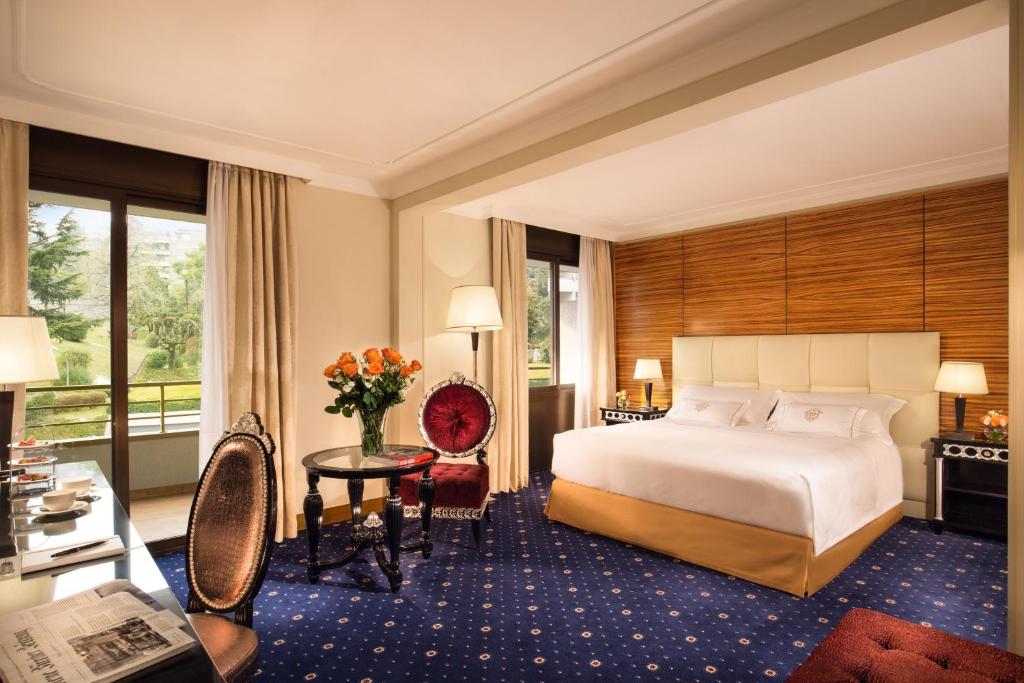
LUXURY – Hotel Splendide Royal
Established in 1887, the 5-star Splendide Royal with its turn-of-the-century character is Lugano’s most fashionable hotel, located on Lugano’s lakeside main street. With its elegant guest rooms, fine cuisine, and a staff of 100 employees who provide meticulous personal service, the Splendide Royal hotel inspires loyalty among its clients.
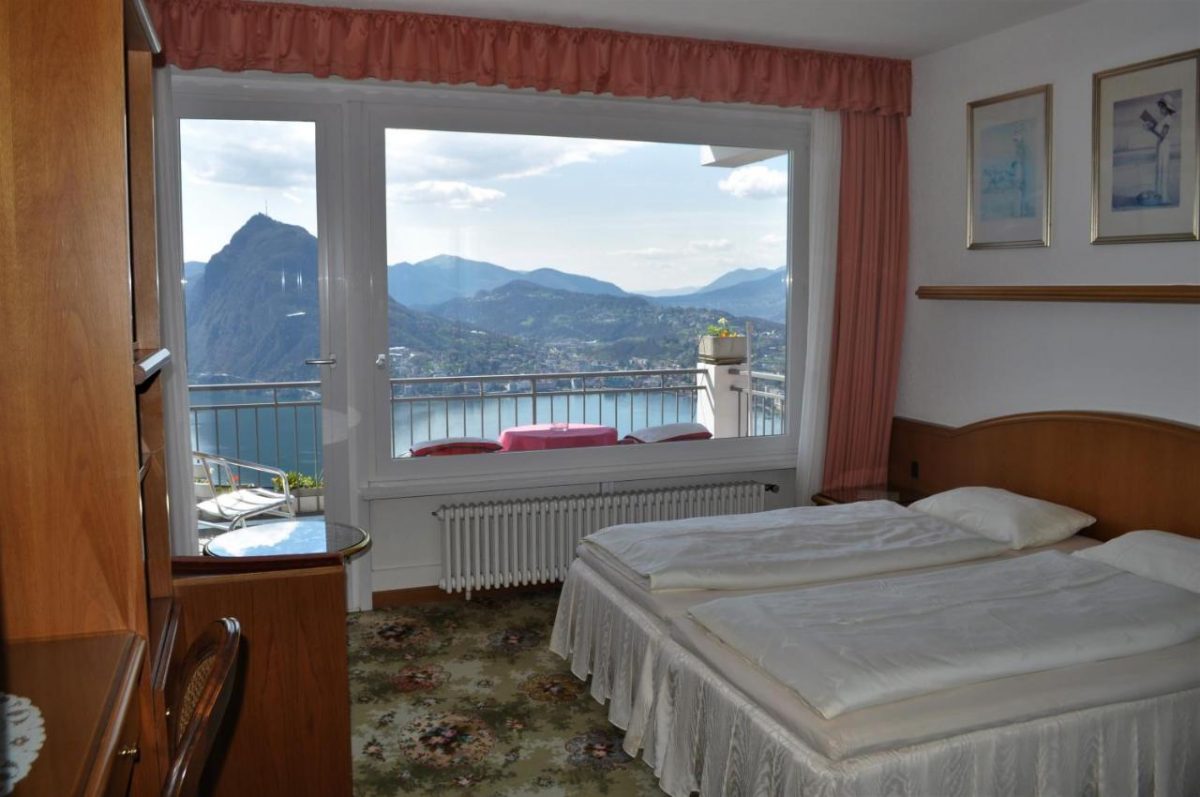
MID-RANGE – Hotel Colibrì
Located slightly further out of town, this property provides a stunning view of the lake that makes it worth the ride. The hotel features a swimming pool, free parking, and the rate includes breakfast. Top-tier rooms feature a balcony and lake view.
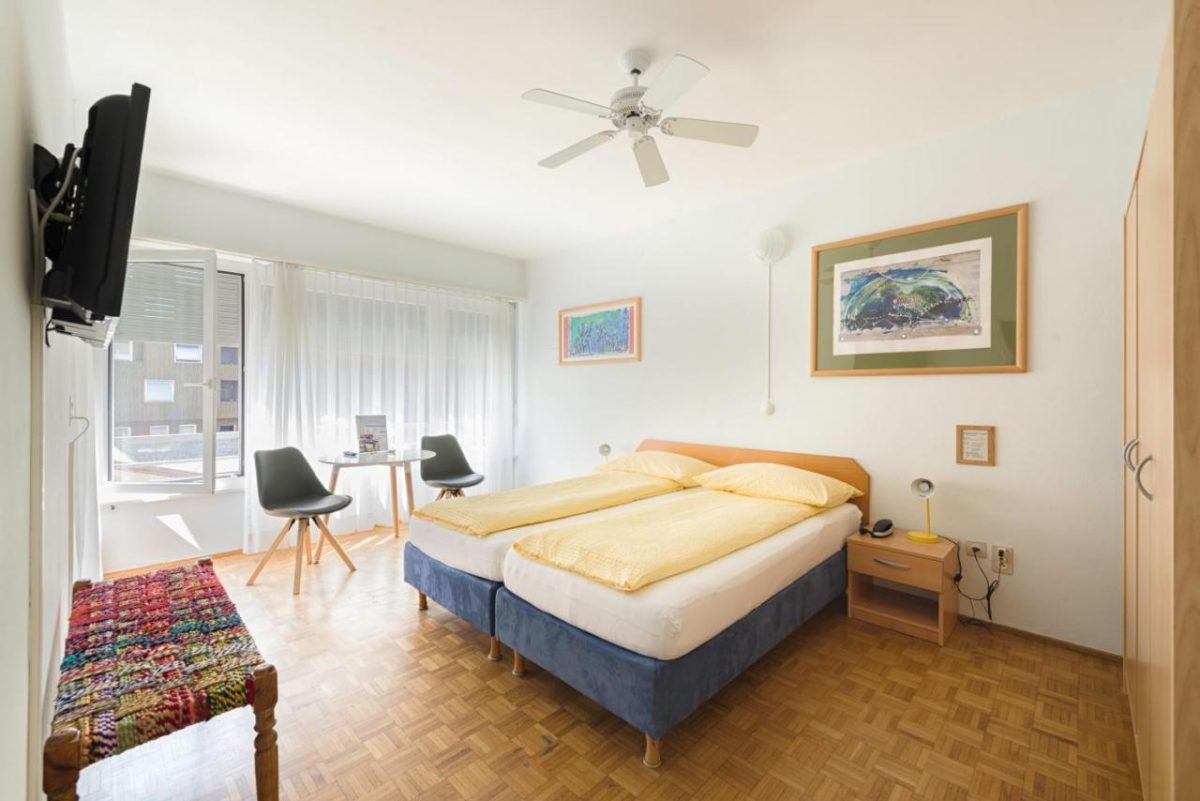
BUDGET – Hotel Atlantico
This wallet-friendly hotel offers spacious rooms, free parking, and free daily breakfast. The location is perfect for getting around the historic center and the staff is noted for their attention to detail.
Day 11: Scenic drive in and around Lugano
Today you will explore the region to the northwest of Lugano and drive for a total of around 180 km (111.8 miles). The total drive time will be around 3.5-4 hours, subject to how deep into the Valle Verzasca you venture.
Valle Verzasca
Driving time: 1 hour (52 km/32 miles) from Lugano to Ponte dei Salti (Valle Verzasca)
Valle Verzasca is a picturesque valley located in Lavertezzo, within the canton of Ticino in Italian-speaking Switzerland. There are loads of activities to choose from here so it’s up to you to decide how you want to absorb the surroundings.
You can hike, mountain bike, swim, or discover the culture of the rural hamlets and villages. One spot not to miss is the Ponte dei Salti, which means ‘jump bridge.’ This double-arched bridge crosses the emerald-colored Verzasca River from Lavertezzo village.
It is also possible to do a bungee jump from the Verzasca Dam if you can summon the courage! If you want to hike the Lavertezzo and the Revöira ethnographic path, then you will need to allow 3 hours to complete the 8.7 km (5.4 miles).
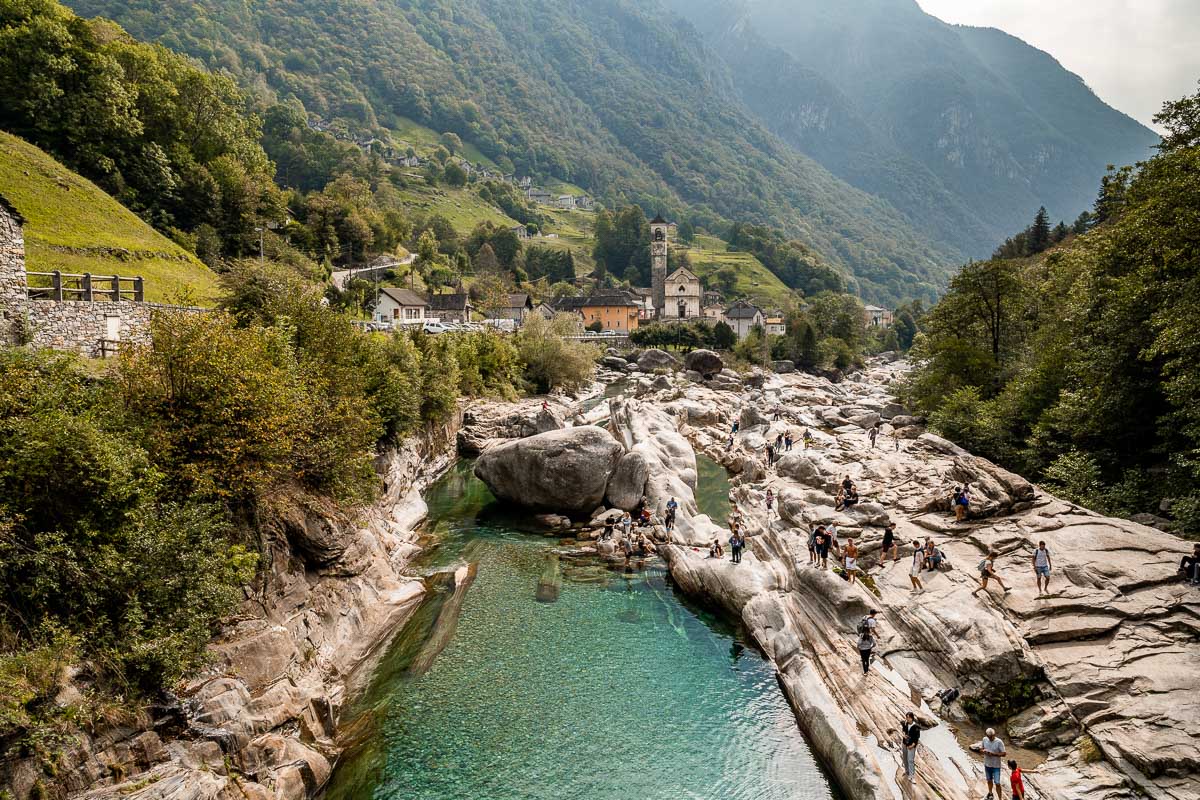
Driving time: 1 hour and 10 minutes (52 km/32 miles) from Ponte dei Salti (Valle Verzasca) to Foroglio
Driving further north into the Ticino canton, you will reach the fairytale Maggia Valley where the star attraction is the picturesque hamlet of Foroglio. The stone buildings are right out of a children’s picture book and are set against the thundering Cascata di Foroglio which crashes down from the cliffs behind the village.
These waterfalls are accessible via a 2 km (1.2 miles) hike from the village which is clearly signposted. Alternatively, you can take the 8 km (5 miles) route which takes you up into the valley at the top of the falls.
There is another Swing the World located in Foroglio, positioned in the woodland with a full frontal view of the waterfalls. Swing out over the river if you dare!
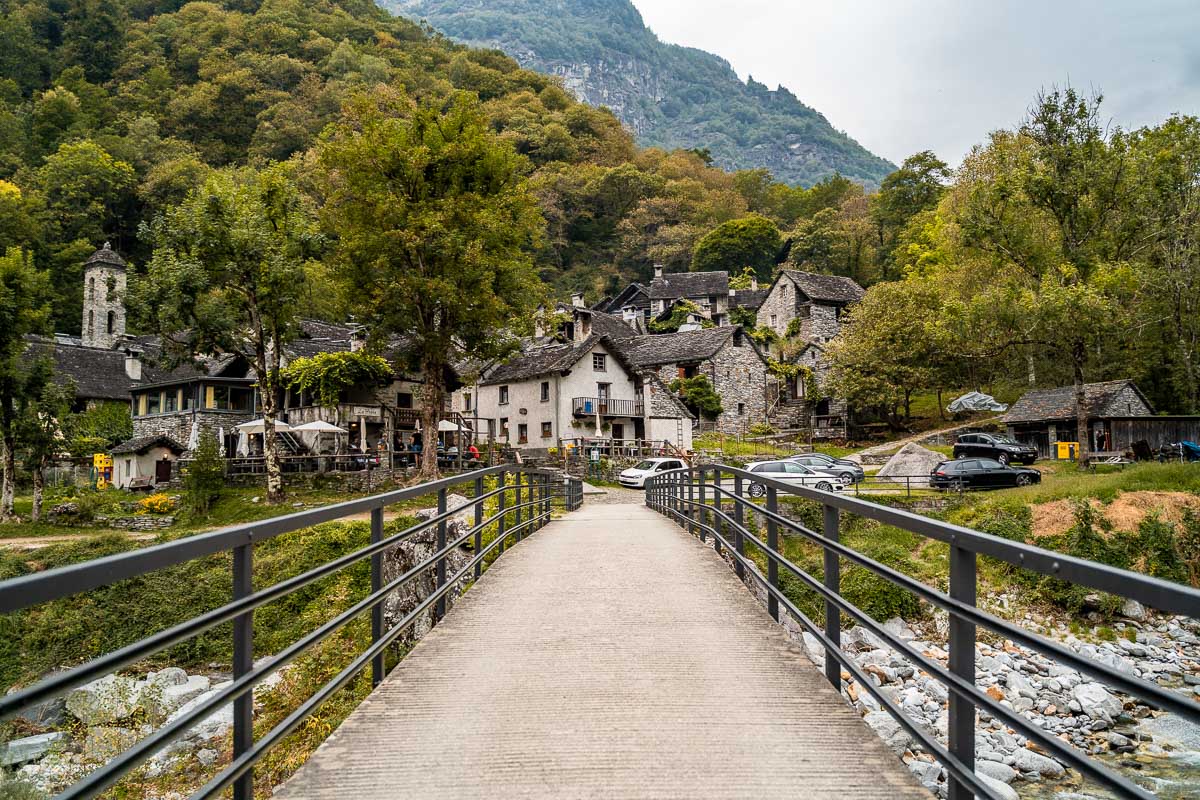
Afternoon in Lugano
Driving time: 1 hour and 25 minutes (78 km/48 miles) from Foroglio back to Lugano
Depending on how long you want to spend in Valle Verzasca and Foroglio, you can head back to Lugano whenever you are ready and spend the rest of the day roaming the city.
Architecture aficionados will love checking out the blend of Renaissance, Baroque, and Neoclassical buildings in the town, particularly the churches, cathedrals, and monasteries.
You could visit an art gallery such as the Museo d’arte della Svizzera Italiana. Whatever you do, don’t forget to take a scenic stroll along the shore of the Lago di Lugano or through the Parco Ciani. Or of course, you can hop on a boat cruise to see the city from an entirely different perspective.
Other things to do in Lugano include riding the funicular up to Monte San Salvatore from Paradiso where you will be rewarded with gorgeous views from the 900 meters (2,952 feet) summit. If you have the energy, you can walk down the mountain in 1-1.5 hours.
Afterwards, you could head to Swissminiatur for a more gentle activity. This open-air museum opened in 1959 and features Swiss landmarks in, you guessed it, miniature!
My other tip for this area is to head north along the lake to the quarter of Gandria. This suburb is a time capsule for previous eras, with immaculately preserved buildings that date back to the 16th and 17th centuries.
It’s also the final Swiss village before you meet the Italian border. You can either drive here from Lugano or take a boat cruise to experience it from the water.
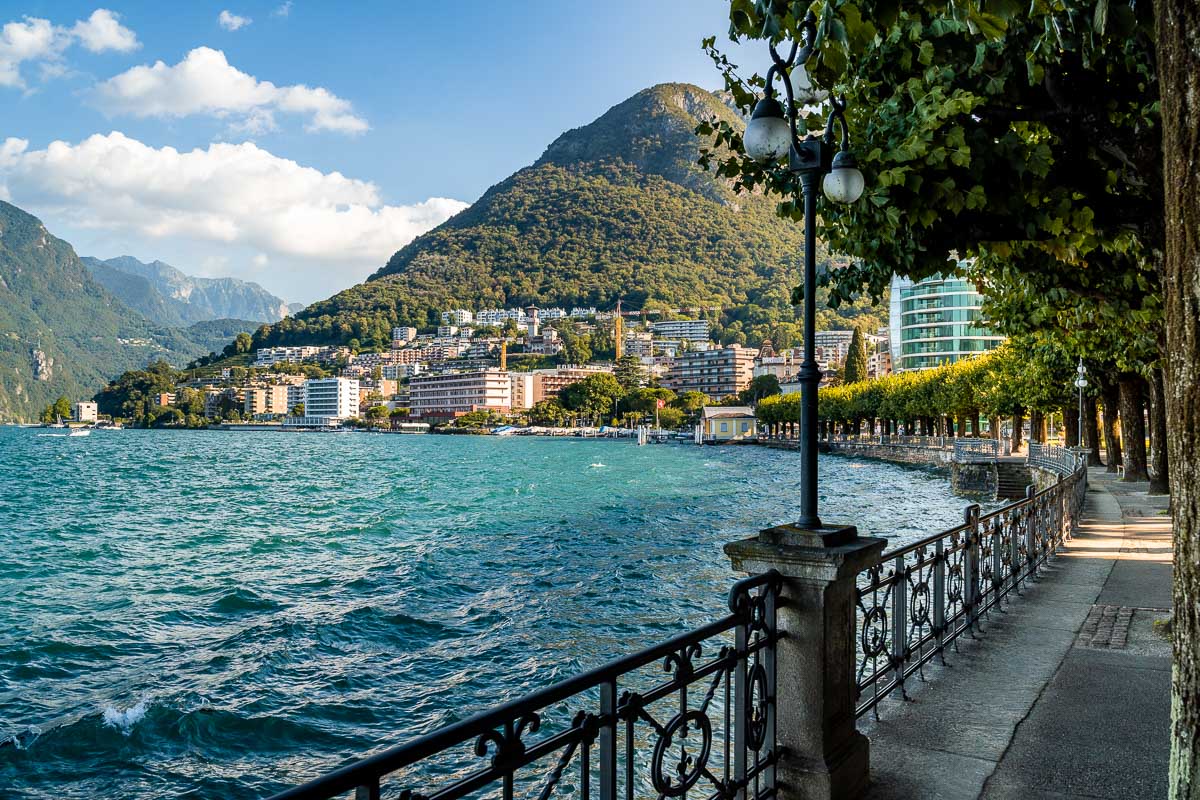
Day 12: Lugano to Liechtenstein
Liechtenstein.
Driving time: 2.5 hours (185 km/115 miles) from Lugano to Vaduz, Liechtenstein (via Liechtenstein)
Today you will actually cross the Swiss border into neighboring Liechtenstein. The distance from Lugano to the capital city, Vaduz, is 185 km (115 miles) and the journey will take you around 2.5 hours.
I recommend crossing the border at Balzers so you can drive through the whole country. It will give you a nice first impression even if you don’t have time to stop and explore every town.
Once you are in Liechtenstein, I suggest that you concentrate your sightseeing on the area surrounding Vaduz. You can drive up to Schloss Vaduz for panoramic views across the city. Sadly the castle is closed to visitors because it’s the actual residence of the Prince of Liechtenstein, moreover it is currently being renovated.
Further sights in Vaduz include riding the Citytrain which is a fun way to see and learn about the city and visiting museums such as the Liechtenstein National Museum or Postmuseum. Whatever you do, remember to get your passport stamped at the Tourist Office. It’s a great memento from your 2 weeks in Switzerland!
Further afield, you can visit the little alpine towns of Planken and Triesenberg which are only a short drive from Vaduz. For something more adventurous, you can drive up to Malbun which features the only ski resort in the country. During the summer months, the region is transformed into a playground for hiking and mountain biking.
For more help structuring your activities, you can refer to my guide on how to spend one day in Liechtenstein .
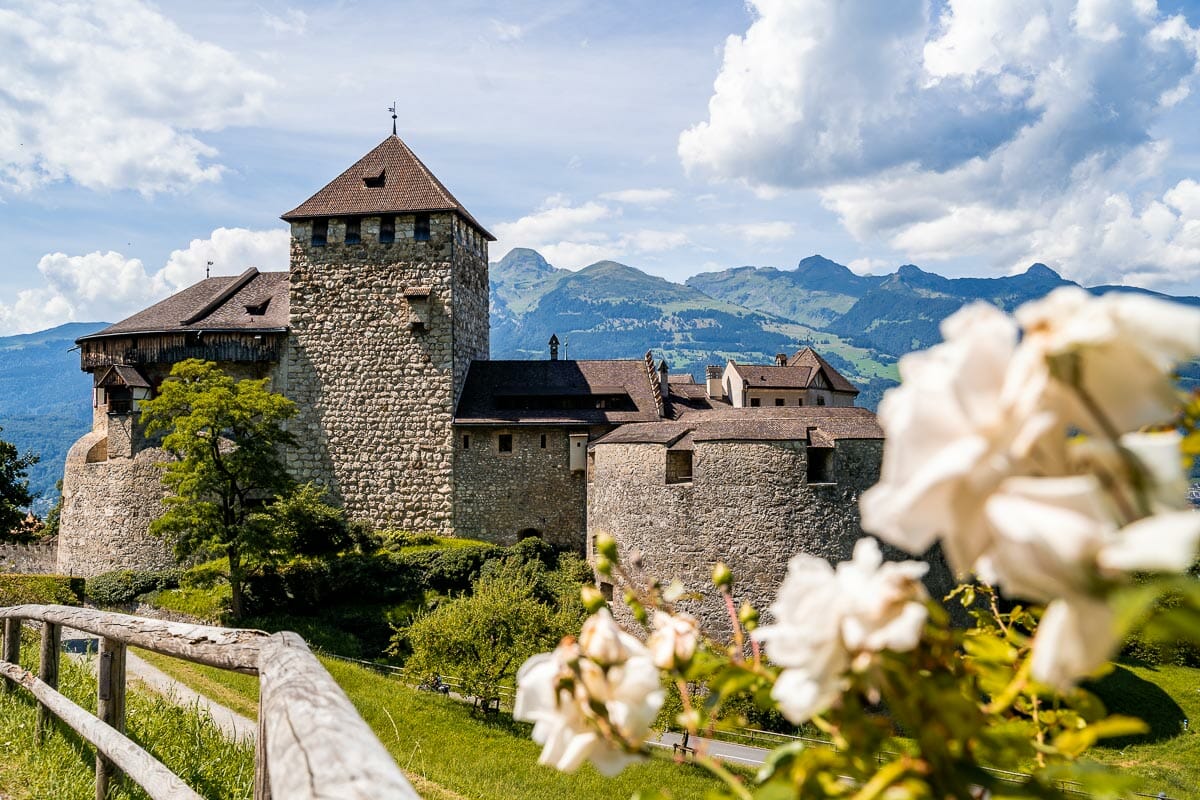
Where to stay in Liechtenstein or the Appenzell District (2 nights)
This 25 km (15.5 miles) long principality sandwiched between Switzerland, Austria, and Germany is small enough that you can really stay anywhere you like.
However, for the purpose of this road trip in Switzerland, my recommendation is that you choose accommodation in the northern part of the country. For example, in or around the village of Bendern as this will tie in best with your activities over the following days.
Alternatively, you can choose accommodation in the Appenzell district of Switzerland which will fit in well with the next leg of this Switzerland road trip but be prepared that it will be a tad bit more expensive.
If you’re looking to save some money during your 2 weeks in Switzerland, staying in Liechtenstein is a great alternative! You’ll need to book 2 nights in this tiny country, below you can see my recommendations.
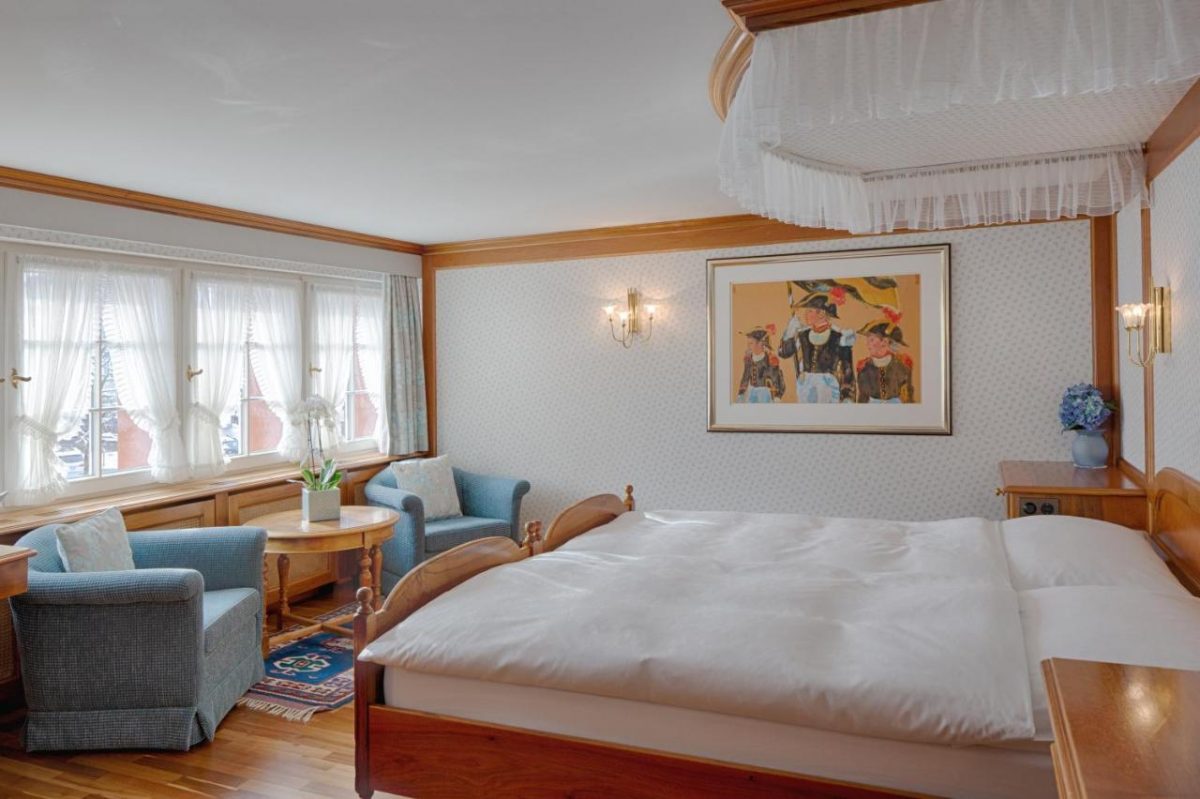
LUXURY – Romantik Hotel Säntis
Located directly at Appenzell’s historical town square, the “Landsgemeindeplatz”, the Romantik Hotel Säntis, with its grand façade, offers a magnificent view of the surrounding mountains. All rooms have a work desk, a safe and a TV. Each room has a private bathroom. The hotel also offers extensive spa and seminar facilities.
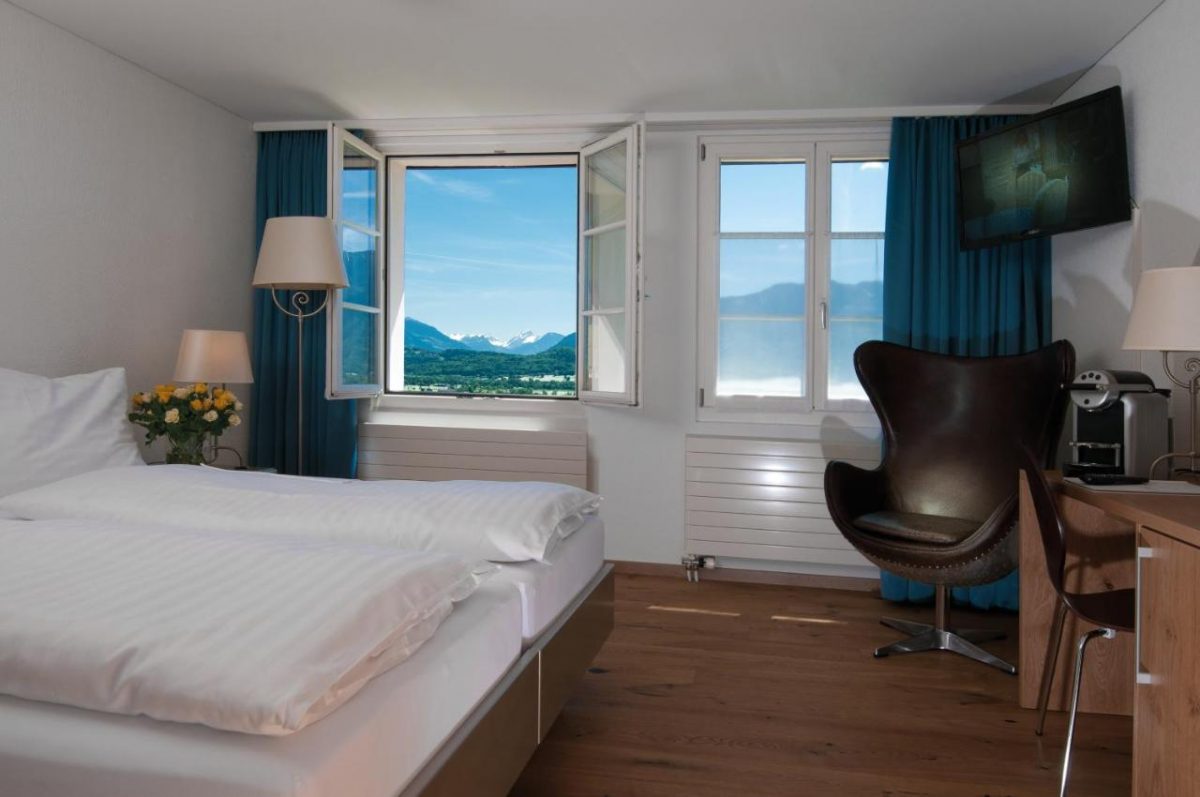
MID-RANGE – Hotel Restaurant Schlössli Sax
Located on the border of the Appenzell district and Sax in Switzerland, this recently renovated hotel offers immaculate rooms with private bathrooms and superb views of the incredible scenery. Breakfast is included in the rate and there is free parking on site.
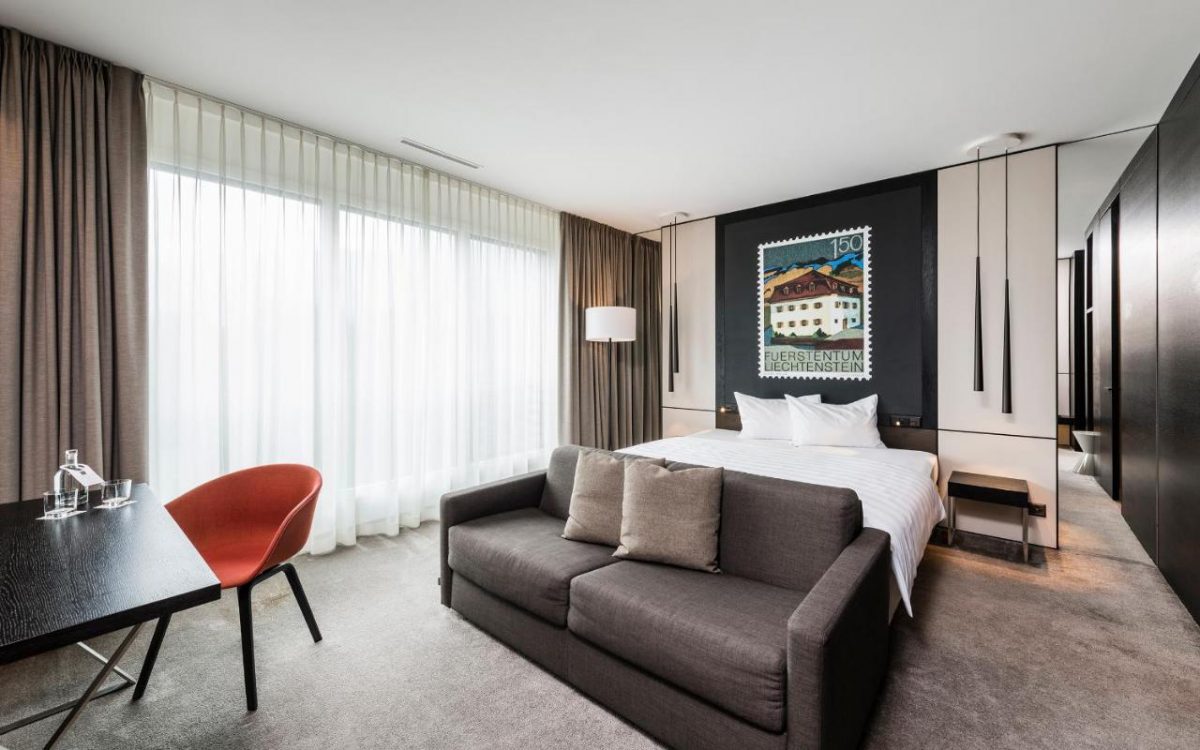
BUDGET – b_smart hotel Bendern
This smart hotel features a gym, sauna, sun terrace, and bar. Contemporary rooms are well equipped with all the necessities you will need and breakfast is included in the rate. Parking is available at the hotel for free.
Day 13: Hiking at Ebenalp
Driving time: 35 minutes (35 km/22 miles) from Bendern, Liechtenstein to Wasserrauen
Today you will explore the mountain of Ebenalp, the northernmost summit of the Appenzell Alps and an absolute haven for outdoor enthusiasts. Your total distance covered and driving time will depend on where you book your accommodation for these two days.
From the Bendern area to Ebenalp, you will need to drive for 35 minutes (35 km/22 miles). If you stay in the Appenzell district then your drive time will be significantly shorter.
You’ll find tons of different hiking trails in Ebenalp so be prepared for a full day of hiking! You can even opt to hike all the way up instead of using the cable car if you want to save money but I would still recommend to choose the cable car to save time.
The route we did in Ebenalp was the following: first we took the cable car up to Ebenalp, we hiked a little bit down to visit Aescher-Windkirchli, then we hiked all the way up to Schäfler Ridge. On the way back we hiked down to Seealpsee then concluded our hike back at Wasserrauen.
It was a pretty demanding hike and it took us the whole day but I can totally recommend doing the same! If you’re not big on hiking, you can skip Schäfler Ridge and only visit the rest of the places.
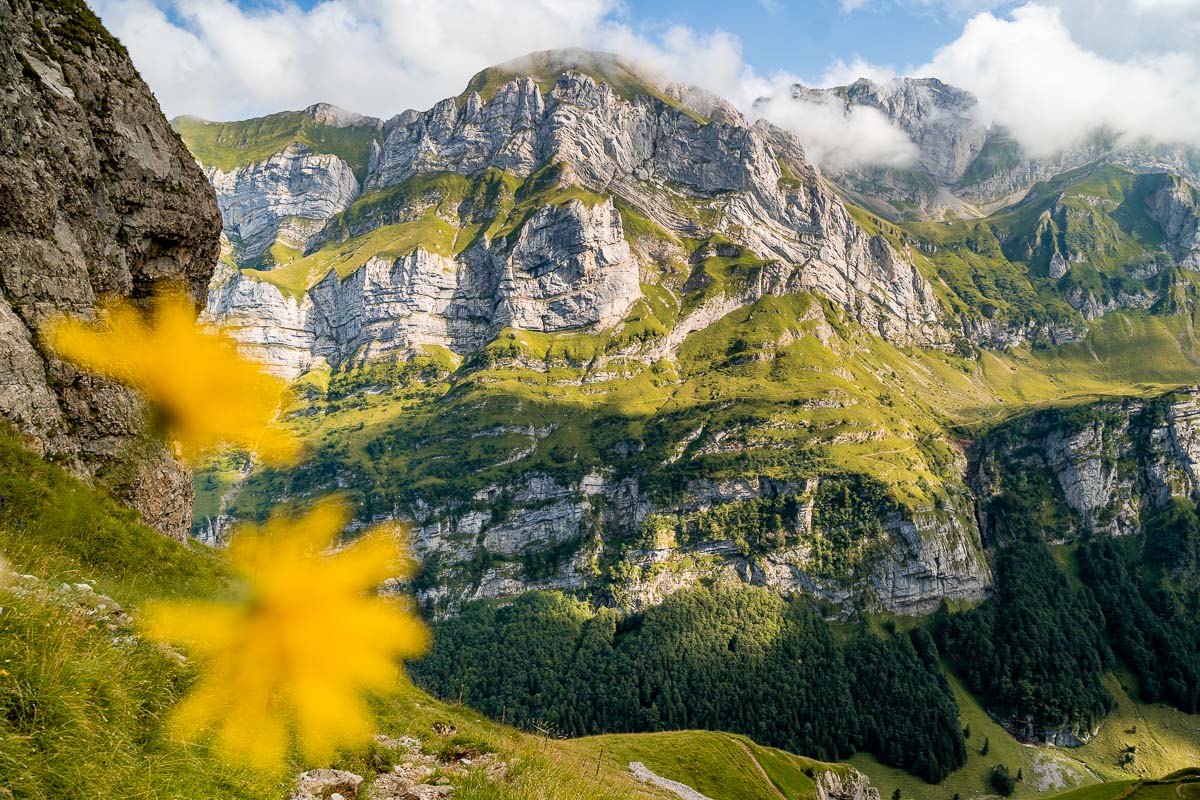
Aescher-Wildkirchli
Once you’re in Ebenalp, you can park your car in Wasserrauen and locate the cable car which will whisk you away into the mountains for your first sight. A return ticket costs 34 CHF (€35) per person but if you want to follow the same route we did, it’s enough to buy a one-way ticket for 22 CHF (€22.70).
If you would rather, then you can actually hike up to Äscher-Wildkirchli by following the track up through the woodlands from Wasserauen. The total length from here to the ridge is around 7.5 km (4.7 miles) and there is a fair amount of elevation (around 1,200 meters / 3,936 feet) so you should plan around 3-4 hours to complete the route if you skip the cable car.
Aescher-Wildkirchli is a complex of caves cut into the cliffs that feature a chapel and a museum of excavated finds for you to explore.
There’s also one of the most scenic restaurants in the world waiting for you up here! It takes around 20 minutes to reach the restaurant from the Ebenalp cable car station and since the road mostly goes down, it’s a very easy hike.
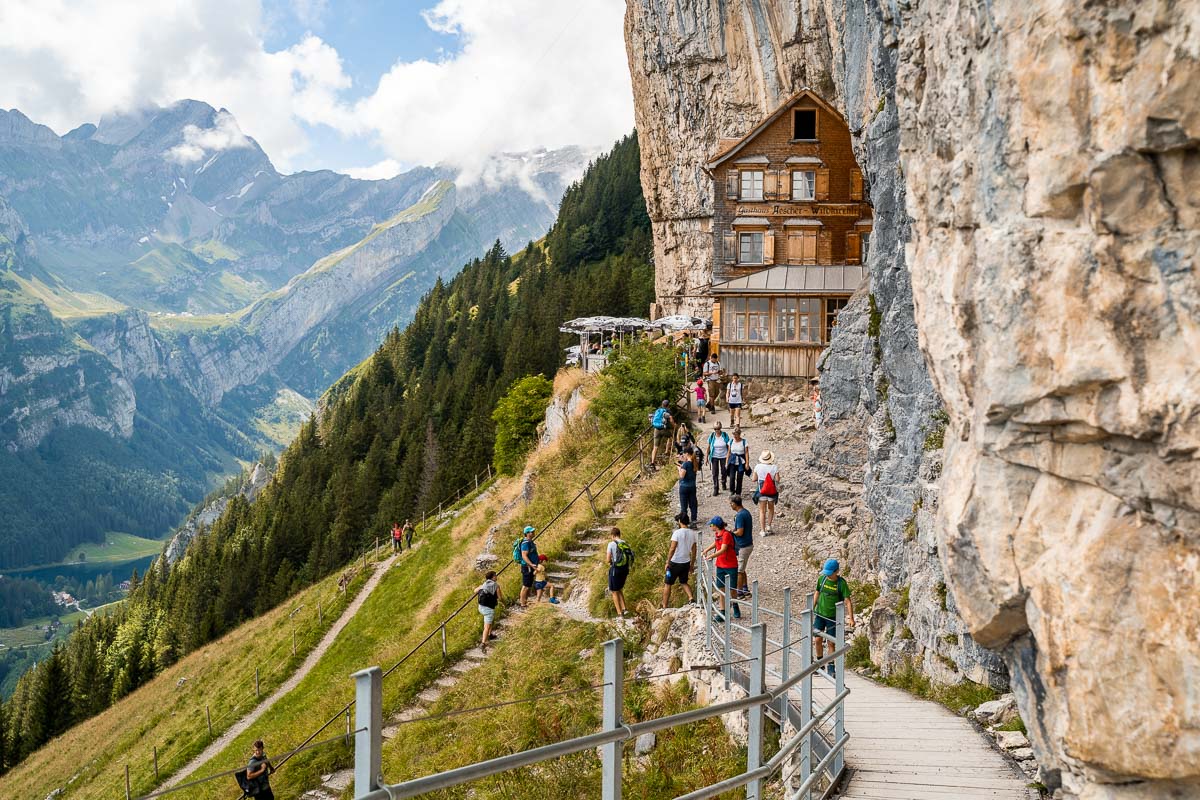
Schäffler Ridge Hike
From Aescher-Wildkirchli you can start your hiking section of the day and head up the mountains to the Schäffler Ridge, a remarkable natural phenomenon that grants you a view across Austria and Germany on a clear day.
It takes around 1.5 hours to reach the mountain hut on the top and since you have to tackle 450 meters of elevation gain I’d say it’s a moderate difficulty hike.
There is a cute little guesthouse on top where you can relax a little bit or have something to eat/drink. It’s also possible to stay at the hut for the night but you have to book it in advance. If you want to find the best viewpoint on the top, just continue for a few minutes up behind the mountain hut!
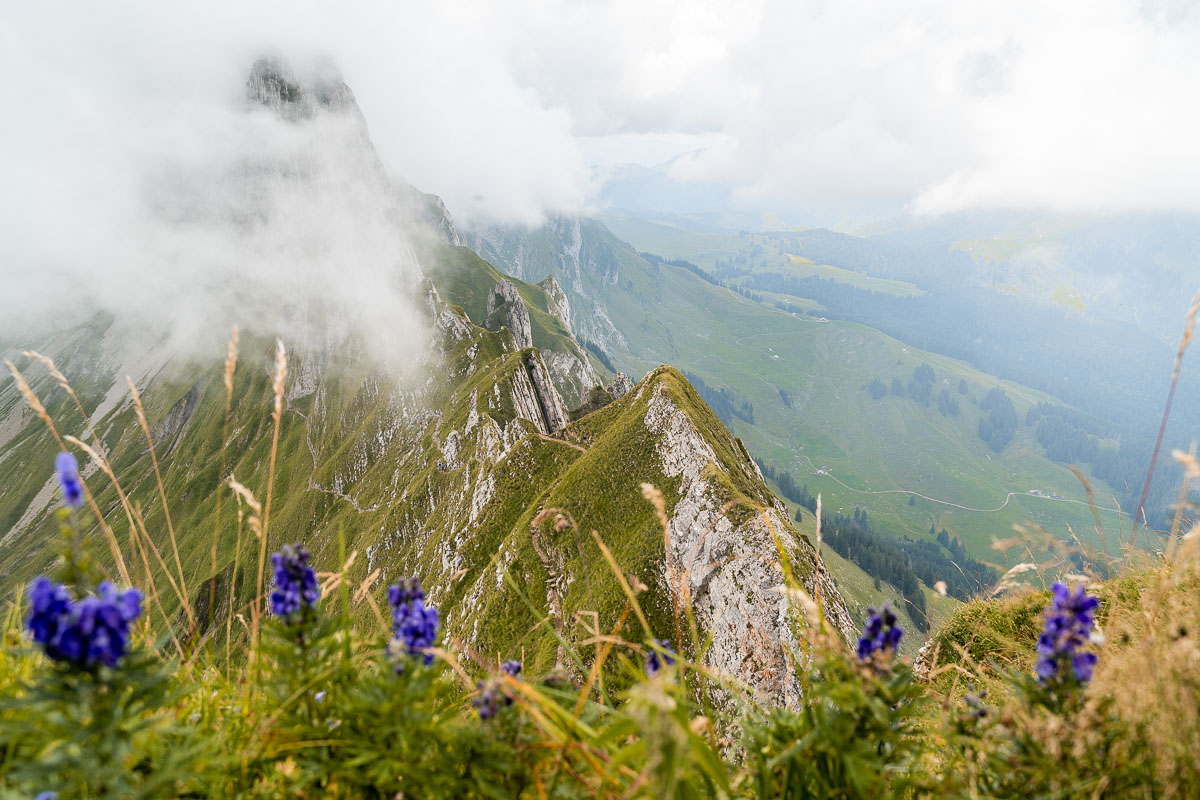
Continue your adventure by hiking down to the gorgeous lake, Seealpsee, from the Schaeffler Ridge.
The descent is pretty steep and if you’re wary of heights this track might not be for you. There is however a rope rail for added security as you make your way down and the scenery ahead is out of this world.
That being said, this hike is still pretty challenging so it’s not really for beginners! I’m not an experienced hiker and I was still able to complete it but oh boy, it was hard! This section took us more than 2.5 hours.
Once you reach the lake you can walk around the whole perimeter in around 30 minutes. This is a popular swimming lake, especially in summer.
However, before you take the plunge, you should expect the water to be freezing year-round! From here you can walk back down to Wasserauen which takes around 45-60 minutes.
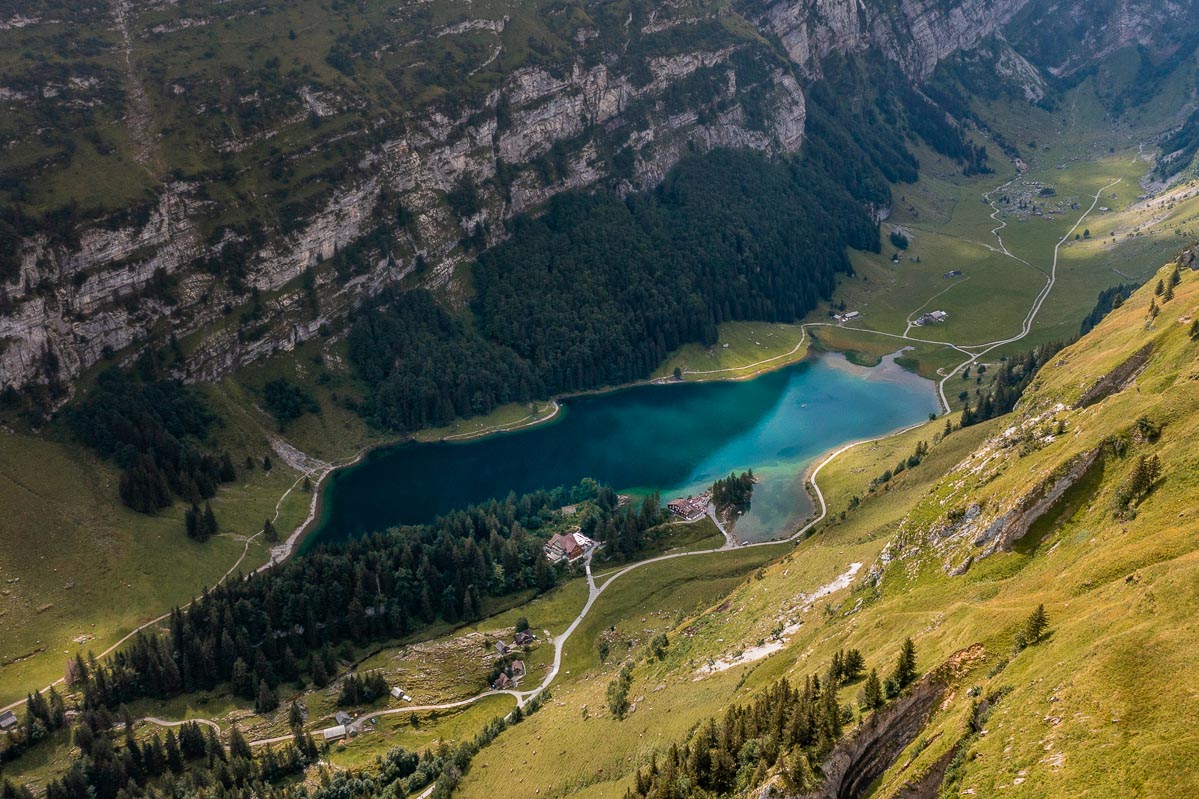
Day 14: Liechtenstein to Zurich
Today you will drive to your starting point and final destination on this road trip in Switzerland, Zurich. The total drive time today will again depend on where your accommodation is.
From Bendern to Zürich via the locations listed below, you are looking at 155 km (96.3 miles) and a drive time of around 3 hours.
Saxer Lücke Viewpoint Hike
Driving time: 10 minutes (7.5 km/4.5 miles) from Bendern, Liechtenstein to Frümsen Cable Car Station
The final hike on your list is a nice and easy one but it gives you an unparalleled view of the Appenzell district and neighboring Liechtenstein as you traverse this ridgeline at an elevation of 1800 meters (5,905 feet).
The hike to the viewpoint is a 6 km (3.7 miles) round trip over a rocky path which is of easy to moderate difficulty. At some points, the track is quite loose with steep drop-offs so you’ll need sturdy footwear. For the most challenging parts of the track, you will find ropeways to hold onto.
The trailhead is accessible from the top of the Frümsen-Staubern cable car (a return ticket costs 36 CHF/€37) and it takes around 2.5 hours to complete the entire loop.
If you want to extend the hike then you can also walk down to Falensee once you reach the Saxer Lücke viewpoint which adds a further 2 km (1.2 miles) to your hike.
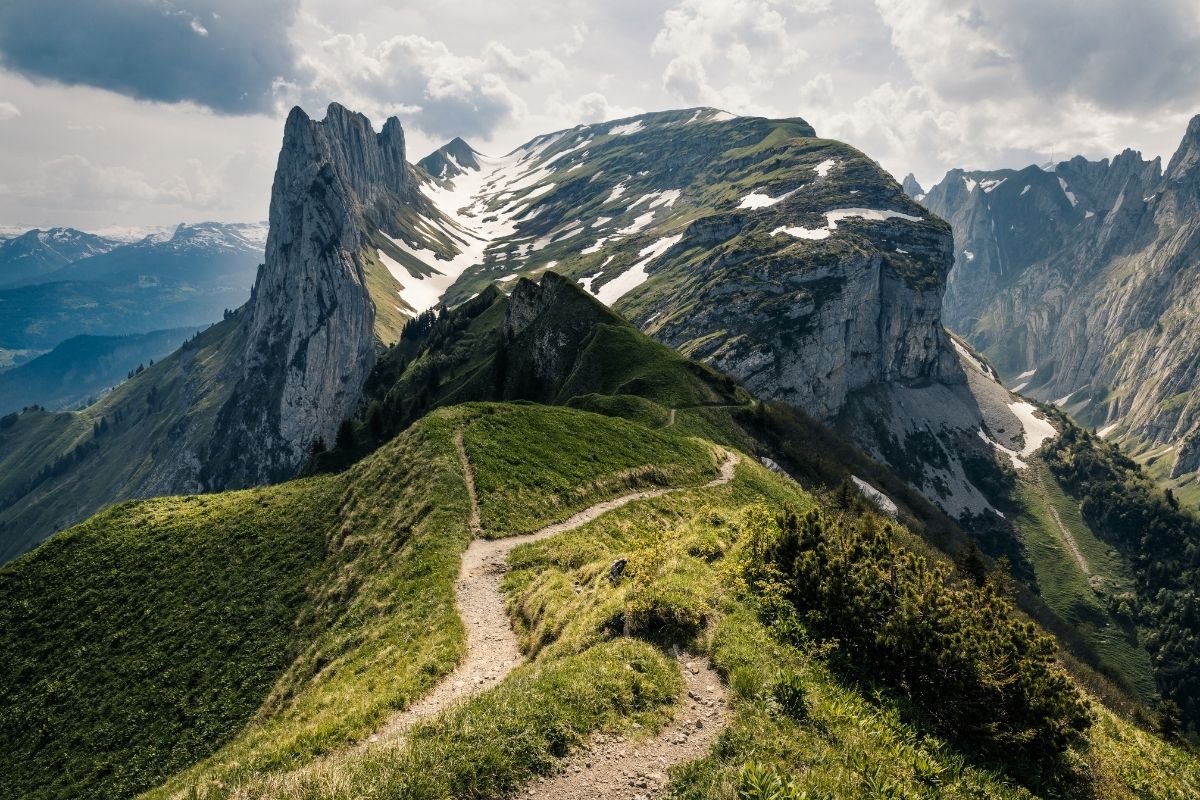
Stadtbibliothek St. Gallen
Driving time: 40 minutes (58 km/36 miles) from Frümsen Cable Car Station to St. Gallen
The last attraction to check out before you reach Zurich is the beautiful library located in the Abbey of Saint Gall in the city of St. Gallen. This baroque abbey was originally founded in the 8th century and the library is one of the oldest from the medieval era.
You’ll see ancient books, as well as historic artifacts and relics from the monastery complex and the painted ceilings, are an attraction in themselves.
A ticket costs 18 CHF (€18.50) which includes a visit to the Abbey Library, the Vaulted Cellar, and the Exhibition Space. Unfortunately, you can’t take any pictures inside the library and it’s rather small so it only takes around 15-20 minutes to visit it.
That being said, it’s really unique so it’s absolutely worth stopping by! If you have a little bit more time, it’s also worth strolling around the town itself, the streets are incredibly picturesque.
Ps: Don’t worry, I didn’t break any rules and I didn’t take any pictures in the library. I bought a postcard at the shop and simply took a photo of that so I can show you how the library looks like!
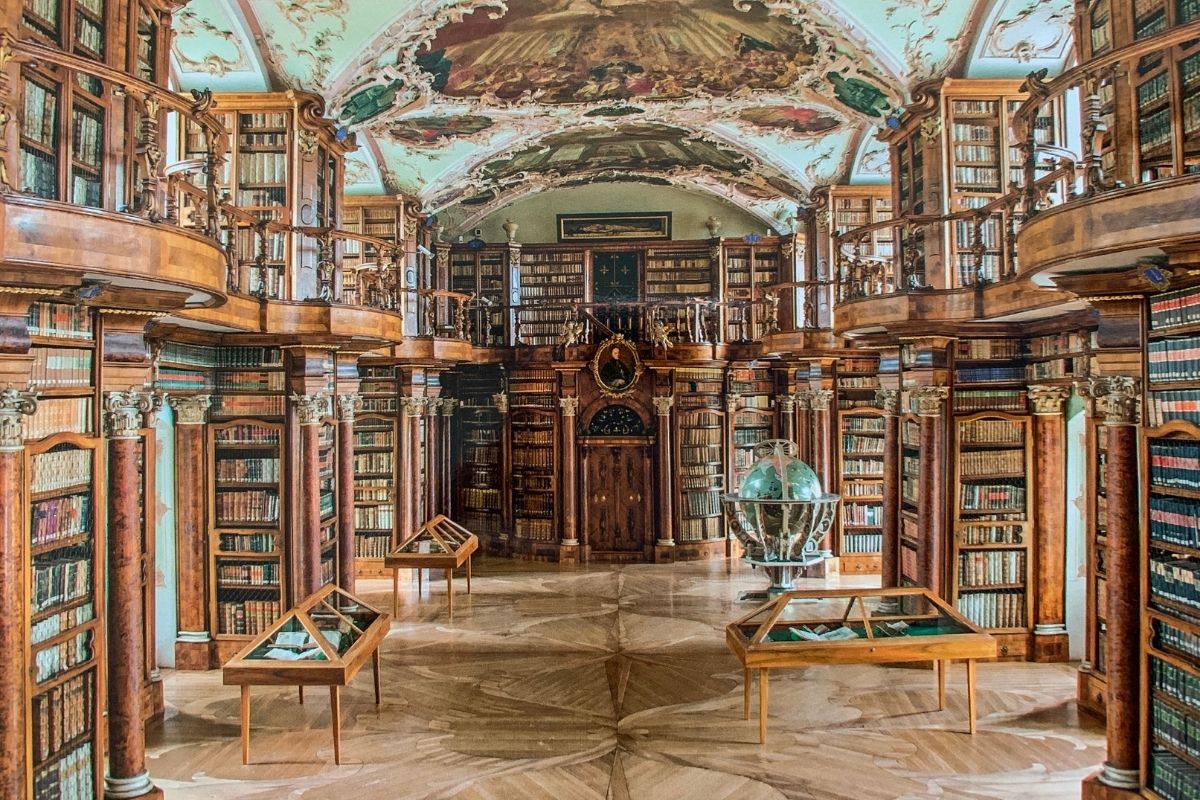
Arriving to Zurich
Driving time: 1 hour (85 km/53 miles) from St. Gallen to Zurich
Your Switzerland road trip is slowly coming to an end so it’s time to head back to Zurich, where you started. It takes around 1 hour to reach Zurich from St. Gallen so if you started early enough, you can still factor in some extra sightseeing time in Zurich.
This is a great opportunity if there are some more places left on your list that you didn’t have time to visit on the first day of your Switzerland itinerary. But if you’d rather just sit back and relax, no one would blame you – you just had an adventurous 2 weeks in Switzerland after all!
Planning a trip to Switzerland?
Then you might want to take a look at all our other travel guides about Switzerland. I promise, they are just as awesome as this article was!
- 28 Incredible Zermatt Hotels with Matterhorn View
- One Day in Zurich Itinerary: How to See the Best of Zurich in a Day
- The Ultimate One Day in Bern Itinerary
- The Perfect Itinerary for Spending One Day in Geneva
- 11 Most Beautiful Castles in Switzerland You Can’t Miss
- Hotel Review: Boutique Hotel Glacier, Switzerland
- Hotel Review: Grand Hotel Des Bains Kempinski St. Moritz
Pin It for Later!
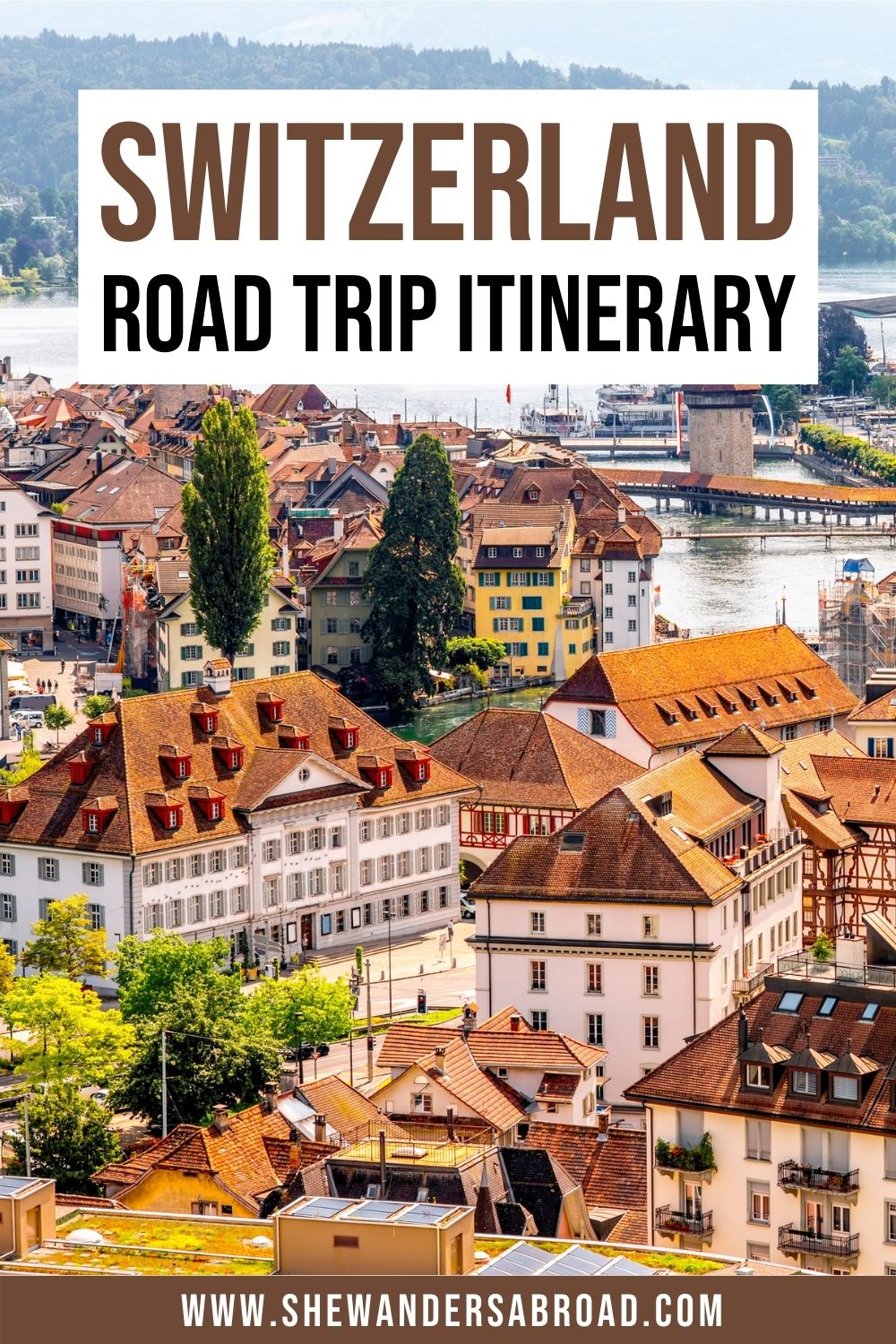
10 thoughts on “The Ultimate Switzerland Road Trip Itinerary for 2 Weeks”
Thank you for this itinerary! I find Switzerland planning to be so overwhelming and this is incredibly helpful + the map is how my brain thinks so including this with the route saved me so much time and stress. I have a question about the images under Lauterbrunnen- were these taken in Lauterbrunnen? I want to spend more time in this place and want to ensure it’s correct. Thank you!
Thanks so much for your lovely comment! I know how you feel, planning this road trip was really overwhelming and took me so much time to put together before we left. And I feel you about the map too – I always plan my trips with a map so I’m glad that you found it useful as well! 🙂
Yes, the three images under Lauterbrunnen were all taken in the town. It truly looks like a fairytale but it’s a really small town so you won’t need more than a couple of hours to walk around it and take some photos.
HI! I’ve read so many Switzerland itineraries and I found yours very helpful. Do you think this itinerary is doable with my 67yo mom? She is still very healthy and does walking every day. Thank you!
Yes absolutely! Maybe you will have to skip the longer hikes or just do smaller sections of it but other than that, I think it’s totally doable.
Hi, Your itinerary for two weeks is very good. If you have the opportunity to stay longer, there are lot of more really wonderful spots to visit (Appenzell, Gruyères, Jura, and lots more). Even though, the city of Basel is an absolute must for every trip, wouldn’t you agree ?
Kind regards, Peter
Hey, thanks so much for your commend and suggestions! Yes, you are absolutely right, these are all very worthy additions to a Switzerland road trip. Unfortunately we couldn’t make it during our last trip to Switzerland, hopefully next time.
Hi. Biiiiig fan of yous. Okay so I have a question to ask. If you also add which time you personally visited or I can Say when or in which months your Photos have been taken, it would be nice.
Hey, thank you so much for your lovely comment! Most of these photos were taken in the months of August and September.
Such an awesome job you’ve done here. Thank you! We are planning our trip from April 23-May 7. Your guide is going to be very helpful.
Thank you so much for your lovely comment! Hope you will have a great time in Switzerland.
Leave a Comment Cancel reply
7 of the most spectacular road trips in Switzerland

Dec 8, 2023 • 7 min read
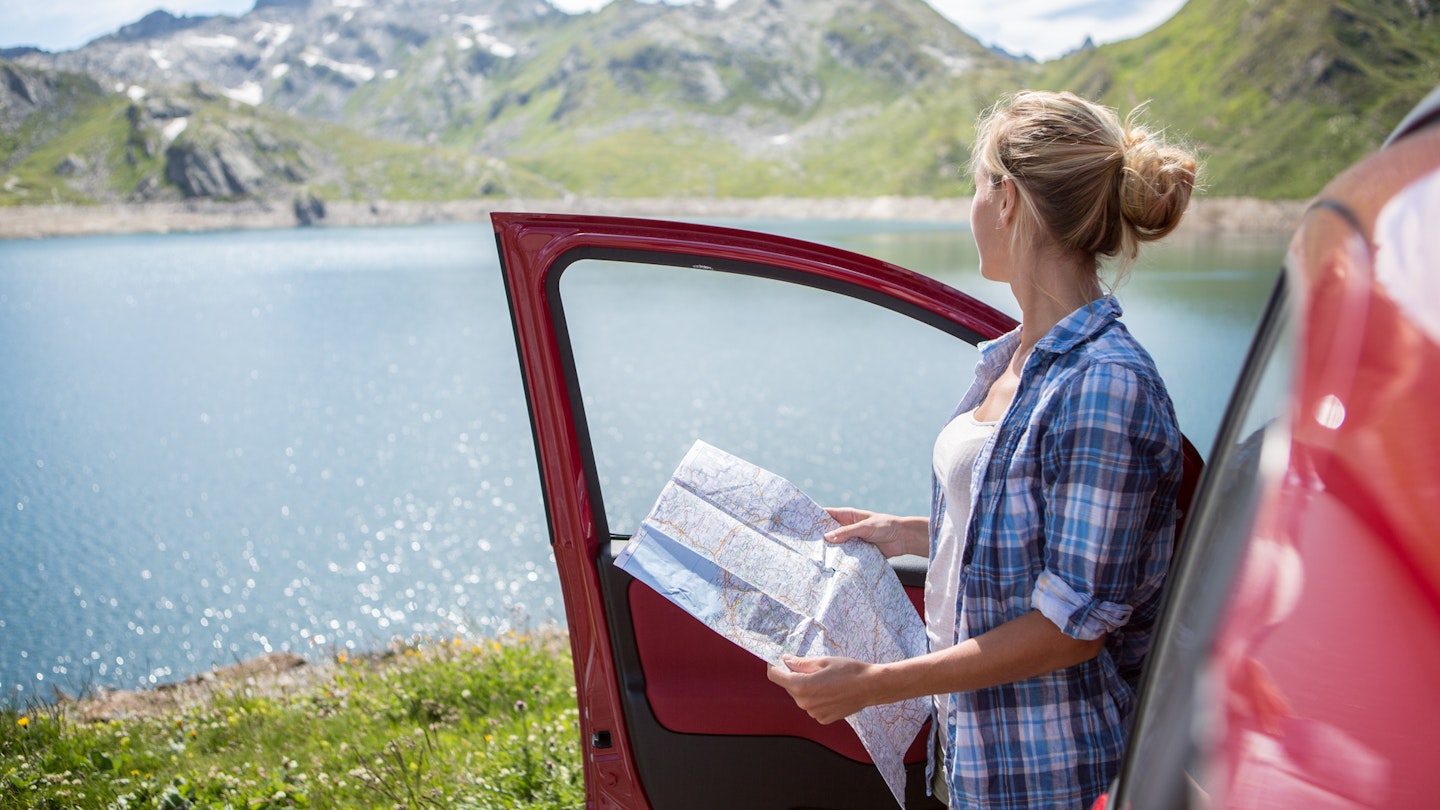
There are picturesque landscapes at every turn in Switzerland © swissmediavision / Getty Images Plus
Switzerland might look tiny on paper, but with most of its land gobbled up by the Alps, this little European nation packs in a lot of elevated space.
Wherever you go, you’re in for one hell of a drive: roads unfurl along the shores of great lakes and glaciers, mountain passes corkscrew up to fairy-tale medieval castles, and on the high roads, every glorious bend makes you want to screech to a halt and yodel in delight.
Neatly wrapping it all up is the big one – the 1,643km (1,021-mile) Grand Tour of Switzerland – an epic, efficiently signposted lap of the country that links 12 UNESCO World Heritage sites and shows off the Alpine nation from its most flattering angles.
Short on time? Don’t worry – here are seven other incredible road trips in Switzerland to give you a head start.

1. Furka Pass
Best road trip for glaciers and mountain peaks Obergoms–Andermatt; 35km (22 miles)
The wows never leave your lips, and the Alps never leave your rear-view mirror on this astonishingly steep, snaking, stop-the-car-and-grab-the-camera drive from the remote valley of the Goms in Valais to mountain-encrusted Andermatt in Uri.
If you begin to feel rather Bond-like behind the wheel, it’s no coincidence: this road starred in the car chase scene in the 1964 movie Goldfinger and brings out the 007 in everyone.
Swerving precariously around switchbacks, it tops out at the 2,429m (7,969ft) Furka Pass, where you can peer across the lunar rockscape of a wind-battered plateau and park to see the deeply crevassed Rhône Glacier and its ice grotto before the long, sweeping descent to Andermatt.
Planning tip: Drive the Furka Pass west to east for full-on, hairpin-riddled drama and views of austere peaks and glaciers that will draw constant gasps. Open roughly from June to October, the best time to go is the summer, as the road closes when the snow arrives. Check conditions before heading out.
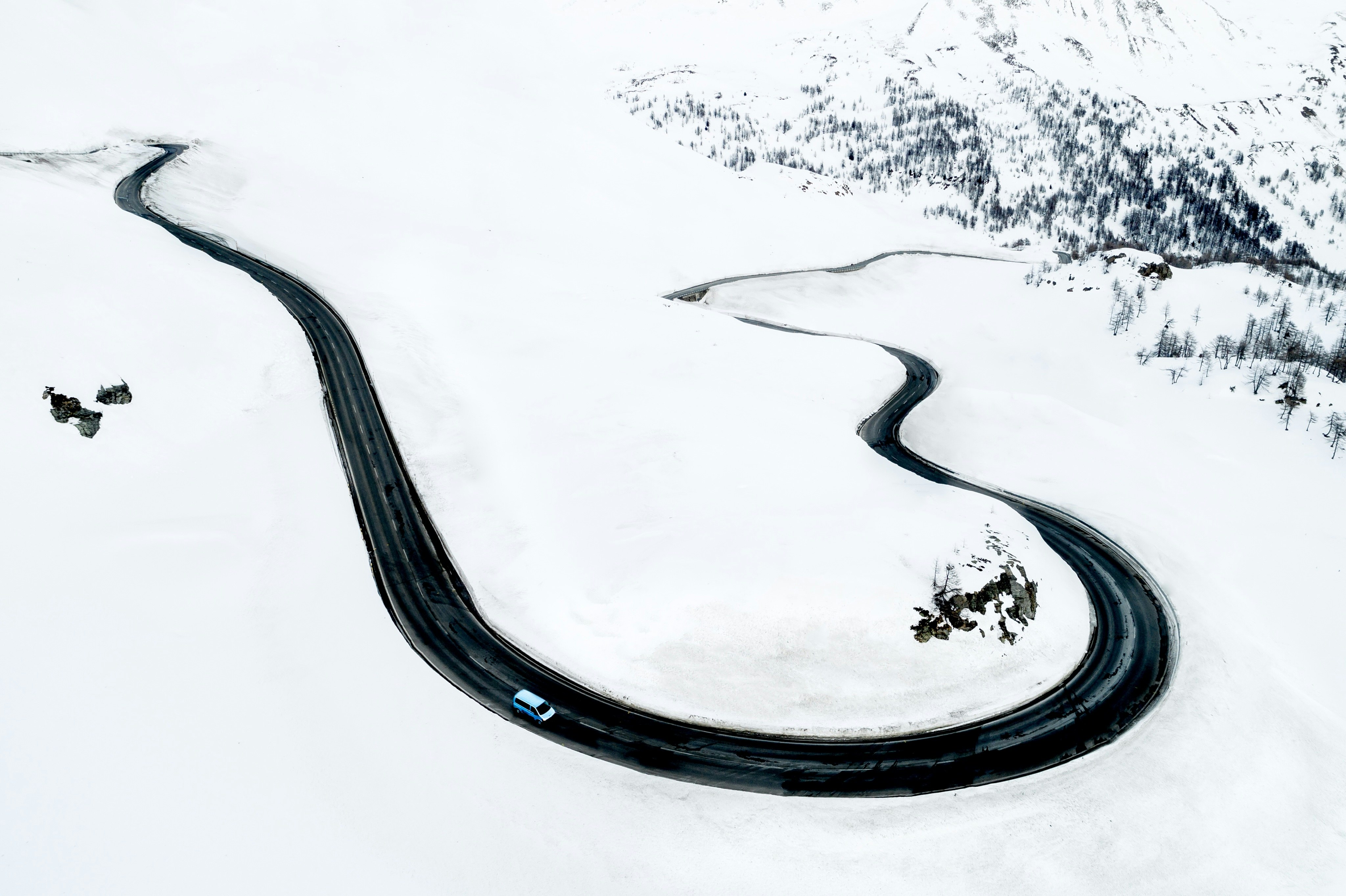
2. The Appenzell rural route
Best road trip for rural Switzerland Appenzell–St Moritz; 200km (124 miles)
Switzerland’s rural, folksy heart beats loudest in the Appenzell region, snuggling up to Liechtenstein in the country’s northeast. It’s a terrifically unsung region for a road trip, with rolling dairy country giving way to lavishly frescoed towns. A week? Doable. Two weeks? Now you’re talking…
The route passes Säntis mountain (at the summit of which you can see six countries), the seven wavy limestone peaks of the Churfirsten range and the pretty medieval hamlet of Werdenberg before crossing little-but-lovely Liechtenstein, with an essential stop-off at its castle-topped capital, Vaduz .
The mountains soar ever higher as you cruise south to vine-rimmed Maienfeld – the setting of the beloved Swiss children’s book Heidi – and the gorge-spanning Salginatobel Bridge, a feat of engineering described as a work of art.
Lovely Engadine villages like Guarda and Zernez entice you into the nature-gone-wild Swiss National Park before your drive south to St Moritz , where sky-high mountains promise further adventures.
3. Southern Switzerland's peaks
Best road trip for mountain scenery Lugano–Zermatt; 264km (164 miles)
The Alps are your constant companion on this ravishing drive through the high mountains of southern Switzerland, which takes in both the Gotthard and Furka passes. You'll want to allow at least a week to do it justice.
Begin at the route’s end in lakeside Lugano , which shoulders up to Italy and delivers a shot of dolce vita in its cafe-rimmed piazzas and palm-fringed parks. From here, the road cruises north to Locarno – another beauty with its botanical gardens and palazzo-filled Renaissance Old Town – and UNESCO World Heritage Bellinzona with its trio of hilltop medieval fortresses.
The language switches from Italian to German as you power north into the Alps proper and Airolo at the foot of the Gotthard Pass. This drive is simply too good to rush, so factor in time for a break in Andermatt, where big wilderness, high-elevation hikes and sensational Alpine scenery await.
Just west of here, the heart-quickening, hairpin-bend-riddled Furka Pass leads you up and over into the glacier-encrusted mountains of Valais. The final stretch of the trip encompasses Bettmeralp, the epic Aletsch Glacier and Brig, with its whimsical Stockalper Palace, building to a crescendo in Zermatt , where the mighty Matterhorn holds you in its thrall.
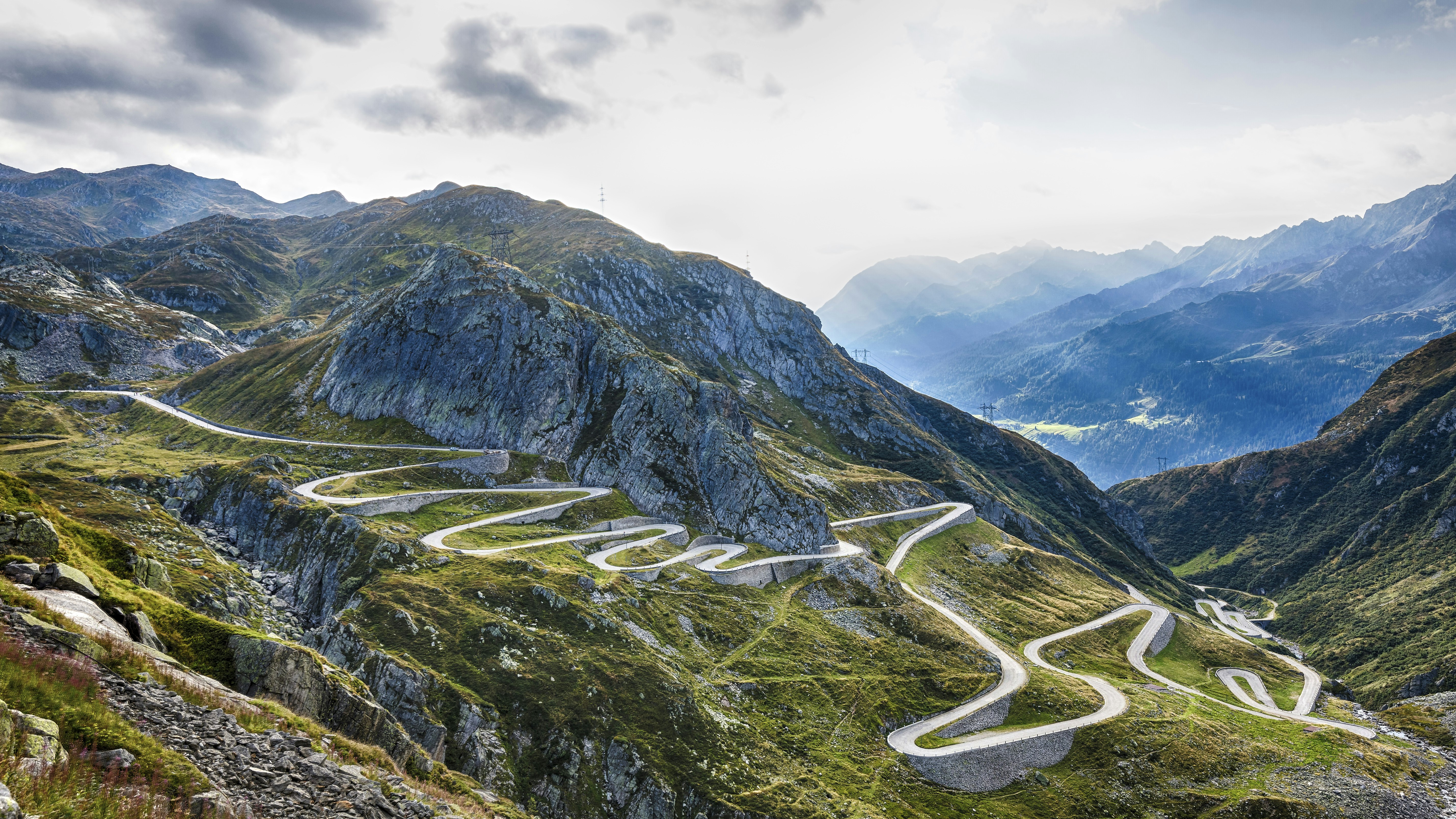
4. Gotthard Pass
Best road trip for gorges and canyons Andermatt–Airolo; 26.5km (16.5 miles)
Sure, you could take the tunnel (one of the world’s longest) through the St-Gotthard Massif, but where’s the fun in that?
If it’s Alpine highs you’re after, the old road over the 2,108m (6,196ft) Gotthard Pass enthralls. Buckle up, roll down the window and prepare for a feast of wild, lonely, bleakly beautiful mountain scenery on this serpentine road linking the Italian-speaking Swiss region of Ticino to the German-speaking region of Uri. If the curvy road seems a challenge today, just think of the poor souls that once made the arduous journey on foot and with pack animals.
In a former customs house at the top of the pass, the seasonal Museo Nazionale San Gottardo gives insight into the history and culture of the pass, but it’s the heart-quickening views you’ll remember most.
Even the Romans shied away from the Gotthard, and it wasn’t until the Devil’s Bridge was built in the 1300s that the pass became properly accessible. The bridge straddles the Schöllenen Gorge, where walls of sheer granite plunge to the raging Reuss River far below. On the south side of the Gotthard Pass, the cobblestone Tremola is a tour de force of 37 switchbacks that send you pinballing down to Airolo.
Planning tip: The road is weather-dependent – it's usually open from May to November.
5. Julier Pass
Best road trip for getting off the beaten track Chur–St Moritz; 157km (98 miles)
Scenery like this should come with a drumroll. Unfurling through the otherworldly gray, jagged, moraine-streaked Alps of Graubünden , the 2,284m (7,494ft) Julier Pass is the icing on the cake of a lovely, long, winding drive that connects the Alpine city of Chur to St Moritz in the Engadine Valley.
Little-trafficked and thrillingly wild, the pass has been used since Roman times, and remains of a Roman temple are still visible. The road dives deep into the heart of the Albula Alps, ticking off pristine mountain landscapes like Parc Ela , Switzerland’s biggest nature park, where you might be tempted to temporarily swap the open road for a hiking trail or two.
Unspooling like a ribbon, the Julier Pass frequently tops polls of Switzerland’s most beautiful drives, and for good reason: its remote, far-away-from-everywhere feel adds to its appeal tenfold.
Planning tip: While the drive is technically open year-round, take care with snow and ice. You’ll need winter tires and snow chains in the cold months.
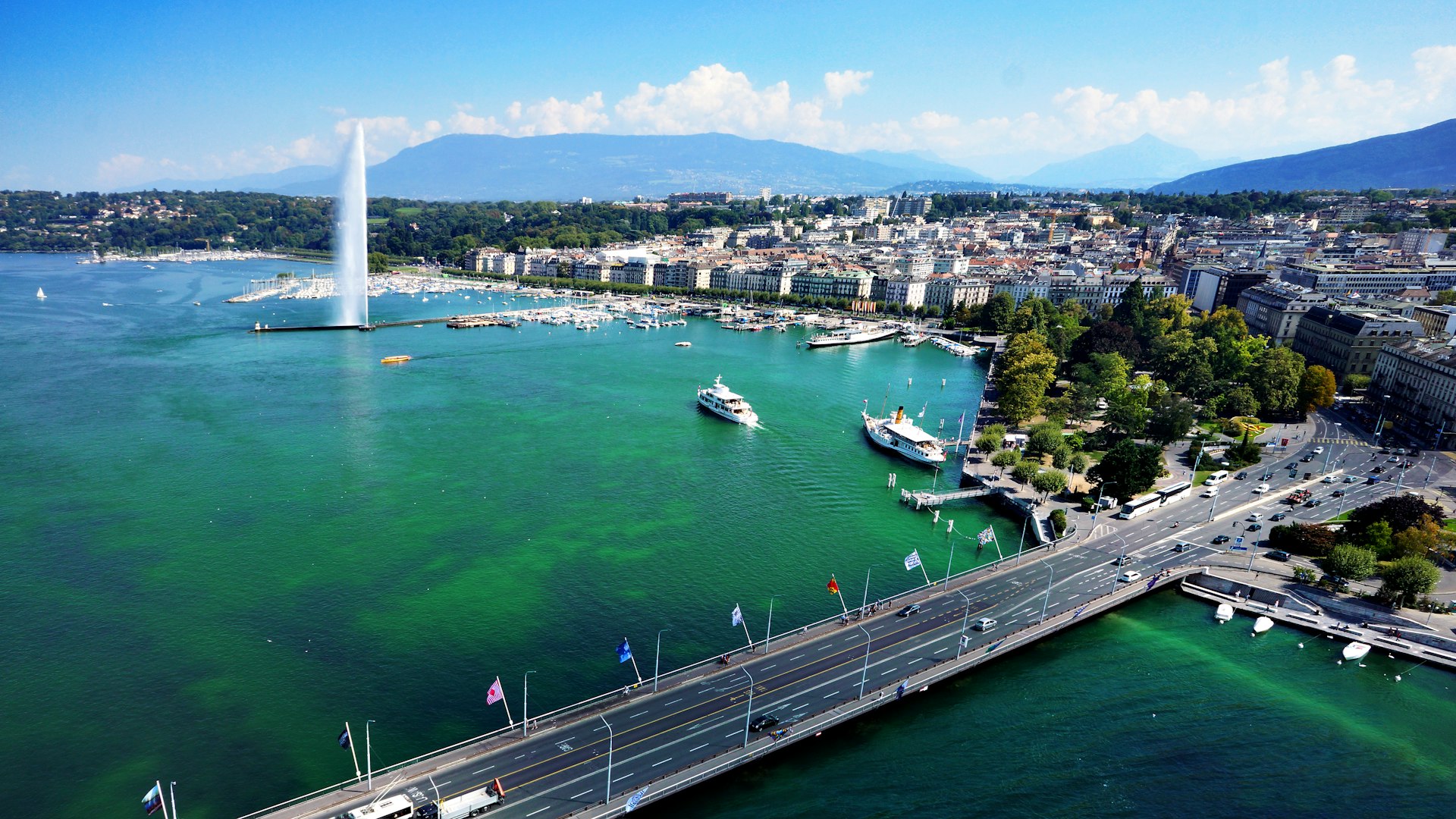
6. Wheel through Western Switzerland
Best road trip for lakes and forests Geneva–Neuchâtel; 190km (118 miles)
The Alps get a lot of love, but sidling up to France in Switzerland’s not-so-wild west, the deliciously off-the-radar Jura region has its own quiet, unexpected beauty with lakes and vineyards rolling to châteaux and pine forest-cloaked hills.
Begin with a powerful hit of culture in worldly Geneva , reclining gracefully on the shores of its croissant-shaped lake. From here, the route tiptoes off the beaten track north into the Jura Vaudois Nature Park for hikes with lake views and tastings of Gruyère cheese at rural Alpine huts.
Devote at least a couple of days to the second half of the drive as you cruise north to serene Lac de Joux, with its watchmaking heritage, and Vallorbe, where Switzerland’s most astounding limestone caves reveal a wonderland of subterranean rivers, waterfalls and rock formations.
Near Lac de Neuchâtel, you’ll find the lushly rolling Val-de-Travers, birthplace of the “green fairy” (absinthe) and the great crescent-moon canyon of Creux du Van . The drive ends with a metaphorical bang at Neuchâtel , topped off by a turreted fantasy of a medieval castle.
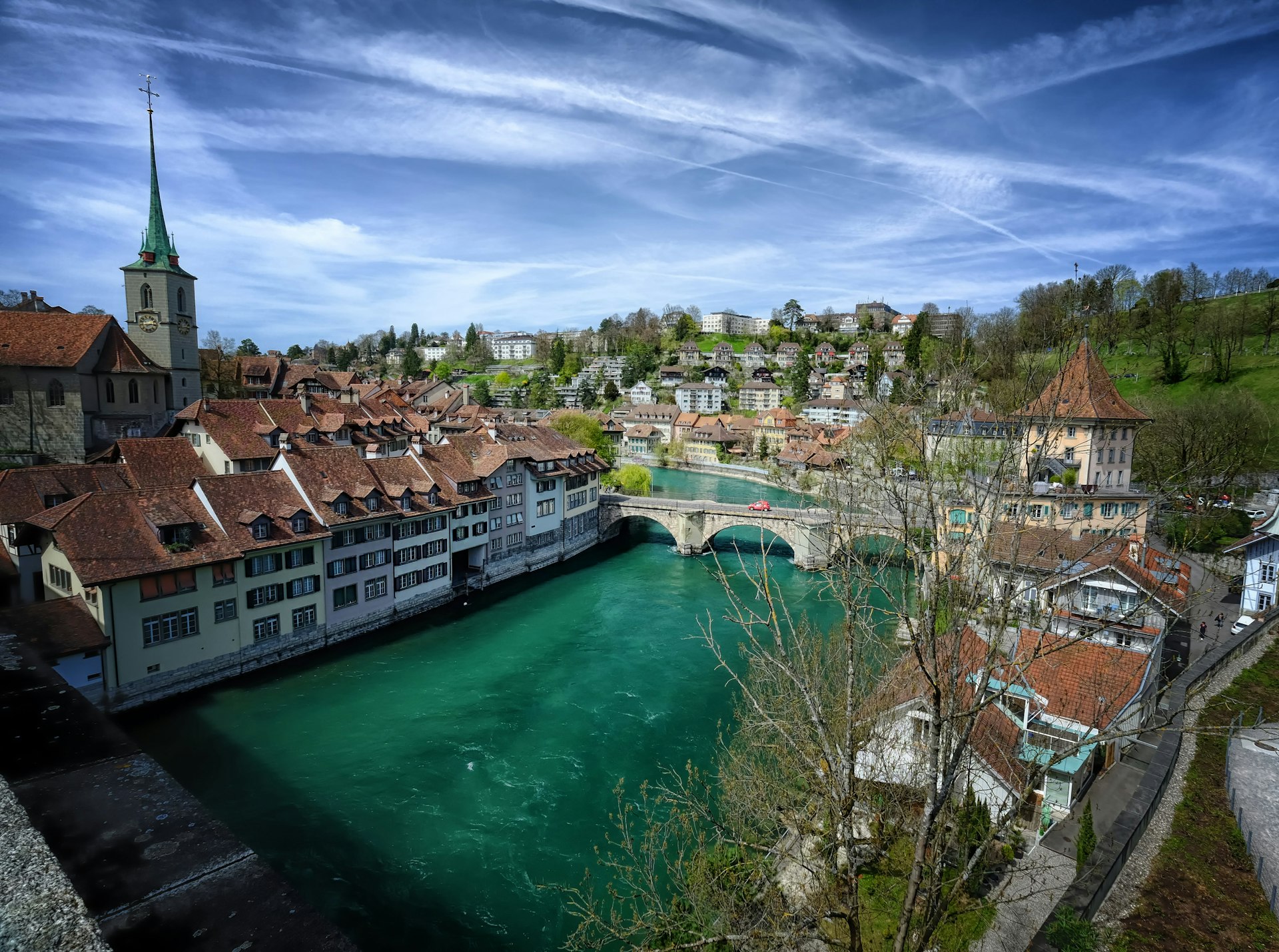
7. Switzerland's top cities
Best road trip for nature amidst urban Switzerland Zürich–Bern; 315km (196 miles)
Bookended by Switzerland’s de facto capital Bern and the country's largest city Zürich (commonly mistaken for the capital), this sensationally varied road trip leaps joyously from the urban to the outdoors, winging you from culture-crammed cities to great abbeys, medieval castles, lakes and mountains of myth.
Bidding Zürich ’s big-hitting museums and cool waterfront bars a reluctant adieu, the drive swings south along the shores of Lake Zürich with tantalizing views of the Alps on cloudless days. Stop off at ludicrously pretty towns, such as vine-ribbed, castle-topped Rapperswil, before heading south to Einsiedeln and its whopping Benedictine abbey.
Lucerne hits the cultural sweet spot with its perfect-looking Old Town and galleries. Detour to fjord-like, exquisitely turquoise Lake Uri for a taste of the country’s geographical and spiritual heartland. Squeeze in dairy tours and meadow strolls in mellow Emmental as you ease your way southwest to Bern , the city of Einstein, elegant arcades and wild swims in the Aare River.
Planning tip: Aim for at least a week behind the wheel – preferably more.
This article was first published December 2020 and updated December 2023
Explore related stories
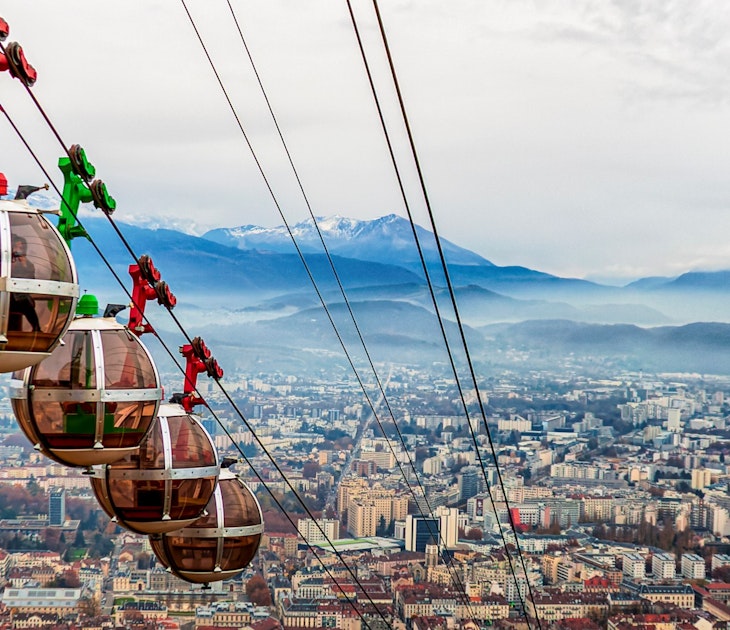
Sep 8, 2023 • 5 min read
Go beyond France's third-largest city with these amazing day trips from Lyon.
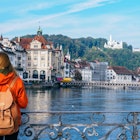
Apr 27, 2023 • 5 min read
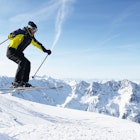
Nov 28, 2022 • 5 min read
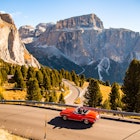
Sep 13, 2022 • 13 min read
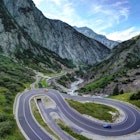
Apr 22, 2022 • 8 min read
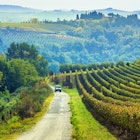
Apr 13, 2022 • 7 min read
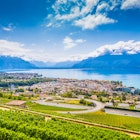
Mar 11, 2022 • 7 min read
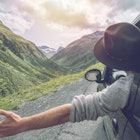
Sep 3, 2021 • 5 min read
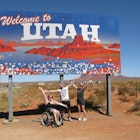
Jul 27, 2019 • 7 min read
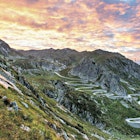
Aug 23, 2017 • 5 min read
- Skip to right header navigation
- Skip to main content
- Skip to primary sidebar
Follow Me Away
Couples Travel & Travel Photography Blog
- Middle East
- North America
- South America
- Photography
- Travel Tips
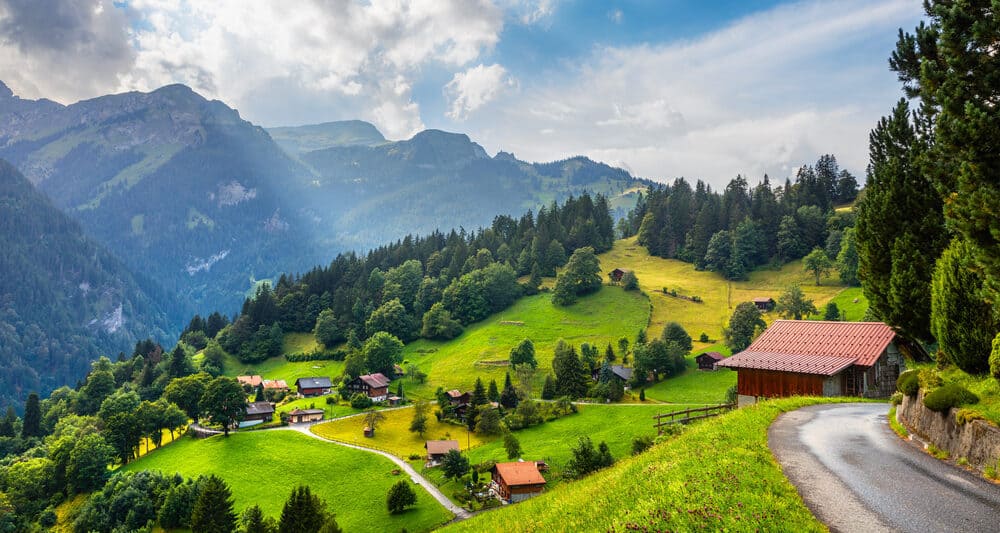
The Ultimate Switzerland Road Trip Itinerary
September 29, 2019 // by Follow Me Away // 3 Comments
Your Switzerland road trip will welcome you to the land of sweeping valleys, majestic mountains, and world-renowned chocolates. No wonder you have decided to come explore! Although the country of Switzerland is about half the size of Scotland in terms of landmass, it is just as rich in history and tradition. Also, it makes it so much easier to see all of the amazing stops we have planned out for you! Less time on the road means more time learning, experiencing, and exploring. Of course, if you are going on a road trip in Switzerland because you love driving through stunningly gorgeous landscapes, do not worry. There are plenty of fantastically windy roads in our Switzerland road trip itinerary.
Another major perk to doing a road trip in Switzerland is that the smaller country size makes your trip extremely customizable. Whether you have three days or three weeks, you will be able to see a good portion of the stops we have highlighted for you. You just might not be able to spend all day at them. Regardless of how much time you have, there are plenty of spectacular things to see and do. We have also included a good number of stops so that you can get a feel for what kind of experiences the country offers and decide where you want to spend your time. Naturally, we think they are all worthwhile. But if you can only visit a few, you will still get a Switzerland road trip you will think back to fondly for years to come.
This is one of the BEST ROAD TRIPS IN EUROPE so you are in for a real treat and a memorable experience!
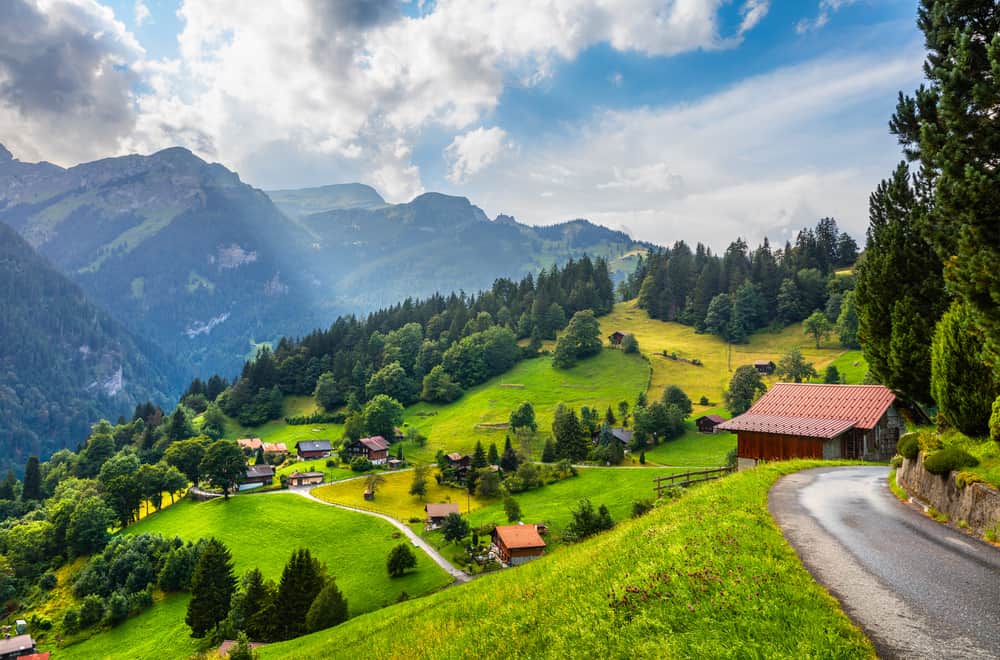
Best Time to Visit Switzerland
Switzerland is one of the most expensive countries to visit, but it helps if you can come during the offseason. That being said, offseason is offseason for a reason. Winter in Switzerland is cold . Temperatures near or below freezing are what persuade crowds to wait to come during the warm summer months of July and August. However, you can come just before and after and have reasonable temperatures with a lot fewer people. We recommend coming between April and June, or September and October if you are able to tolerate spring and autumn temperatures. Fewer people and better prices are a great combination for the best Switzerland road trip possible.
Traveling in Switzerland
There are a few things you should know about traveling in Switzerland. As we mentioned above, this country is expensive, and transportation is no exception to that rule. However, there are some good tips and tricks you can use to make it a little less impactful to your wallet. You can use a Swiss Travel Pass for better deals on the railways and some of the experiences Switzerland offers. Or you can use a Swiss Half Fare Card for a 50% discount on the trains and cable cars. You do not need both of these. If you do not plan on using trains or cable cars at all, you do not need either. However, you will need a Freeway Vignette if you plan on driving. Read on for more information about all of these options, and to figure out will work out best for your Switzerland road trip.
Don’t forget to check out our Detailed Road Trip Packing List so you don’t forget any essentials for your trip!
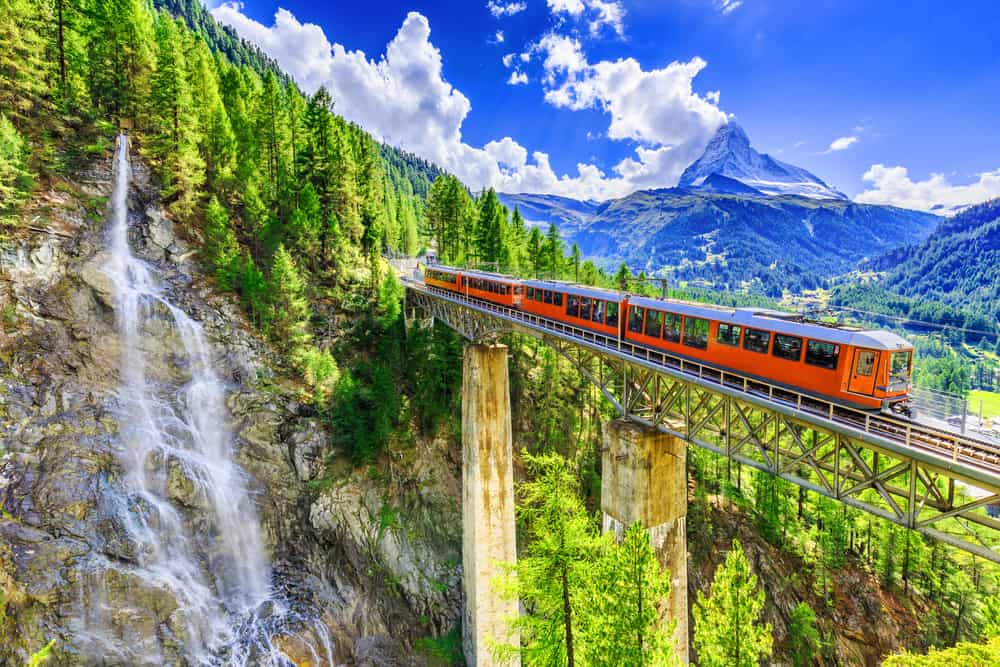
Swiss Travel Pass
The Swiss Travel Pass is for those of you who are planning a good chunk of time for your Switzerland road trip. It offers unlimited traveling in Switzerland, including all the trains, buses, and boats your heart could desire. The Swiss Travel Pass also offers discounted or free admission to many Swiss excursions including museums and mountains. It is a great way to travel the country without having to worry about being able to drive everywhere. If you want to road trip in Switzerland because you want to see all the amazing sights, not because you are dreaming of hours spent driving through the countryside, the Swiss Travel Pass is a great option for you.
Swiss Half Fare Card
The Swiss Half Fare Card is exactly what it sounds like. Use this and it will provide you with half-off pretty much every kind of transportation in Switzerland. If you would like to drive part of the time, but would also like to ride some trains, buses, or boats, then we recommend this option to save you some money. You will still have to purchase individual tickets every time you ride a train, bus, or boat, but with the Swiss Half Fare Card, you will spend half the cash. If you do not want to drive at all, you are going to want to check out the Swiss Travel Pass above.
Swiss Motorway Vignette
Anyone, locals and tourists included, needs a Swiss Motorway Vignette to drive on motorways in Switzerland. If you choose to go this route, we highly recommend also using the Swiss Half Fare Card referenced above to save you money on trains, buses, and boats. It is unlikely that you are going to come to Switzerland and avoid all the spectacular mountain tops, boat trips, and cable cars. We do not blame you for wanting to drive part of the way on the fabulous Swiss motorways–Switzerland has some beautiful roadways. Just do not forget to get yourself a Swiss Motorway Vignette before you go driving off into the sunset.
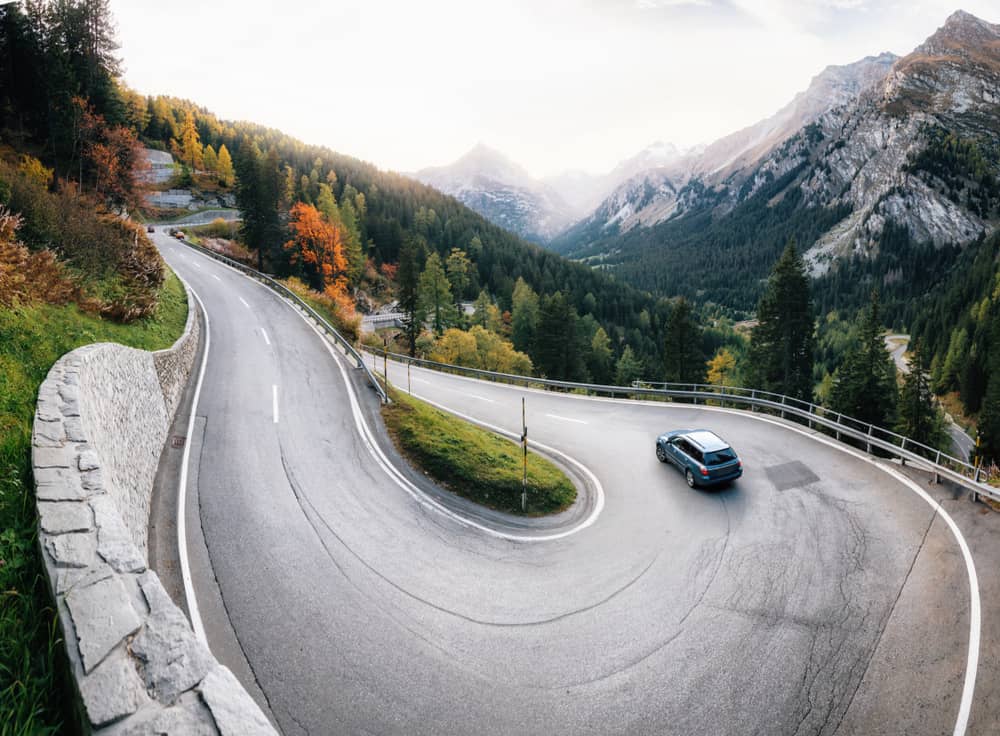
Begin by Flying into the Zurich Airport
When you visit Switzerland, we recommend flying into Zurich Airport. It is the country’s largest airport in the country’s largest city. Zurich is our recommended starting place for our Switzerland road trip. This great city is near the top of Switzerland, allowing you to meander down the country to Geneva, our last stop. From there, you can either fly home out of the Geneva airport or take a relatively simple three and a half hour drive back to Zurich. We are telling you–one of the beautiful things about Switzerland is its size. You could end your road trip basically anywhere in the country and still drive only a few hours to end up at a major airport.
Switzerland Road Trip Stop 1: Zurich
Naturally, Zurich is our first stop on our Switzerland road trip itinerary. Fly there, and then spend some time there–hours or days, up to you. Zurich is an old, history-rich city just waiting for you to explore it. Especially for you art and history buffs out there, this city is a must-see. Want to check out a museum? You will have your pick from 50 of them. Enjoy the art gallery scene? Zurich has over 100 of them. We are telling you, you could spend an entire week indoor in this city. But it is Switzerland, and it also offers so many things to do outdoors! Check out our favorite Zurich experiences below.
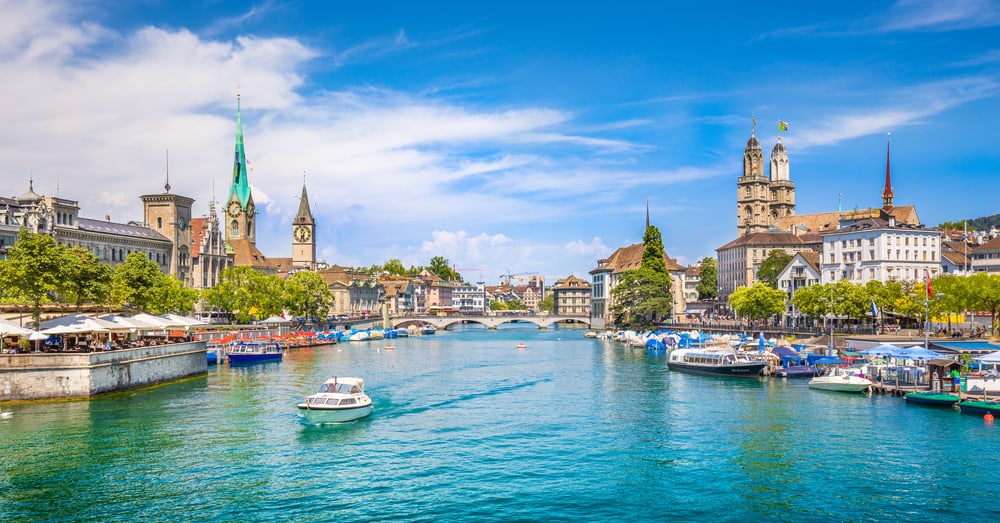
Noteworthy Things to do in Zurich
Walk the lake zurich promenade.
Lake Zurich is a narrow, curving lake right next to the city which gives way to the Limmat River. Both of these bodies of water feature prominently in the walkways, architecture, and experiences available in Zurich. Where the city meets Lake Zurich, there is a lovely walking and recreation area called the Lake Zurich Promenade. Experience rejuvenating pathways and soul-stirring sunrises and sunsets. Bring your dinner to eat it alongside the lake, soak your feet in the water, and witness the creative authenticity of the street artists. The Lake Zurich Promenade is a wonderful place of opportunity and enjoyment.
Catch a Train to Uetliberg
If you purchased a Swiss Half Fare Card or a Swiss Travel Pass, use it to visit Uetliberg! Even if you do not have one of the Swiss travel discount cards, Uetliberg is worth a bit of a splurge to visit. From the peak of this mountain, you will be able to see all of Zurich. You will find yourself breathless, not from the walk, but from the majesty of this view. There is just something about the way that the city meets the water, which meets the alps off in the distance. The walk to the peak is very short and worth the effort. And if you find yourself a little peckish, check out the restaurant at the top. You can take the cable car back down or hike, whichever you prefer.
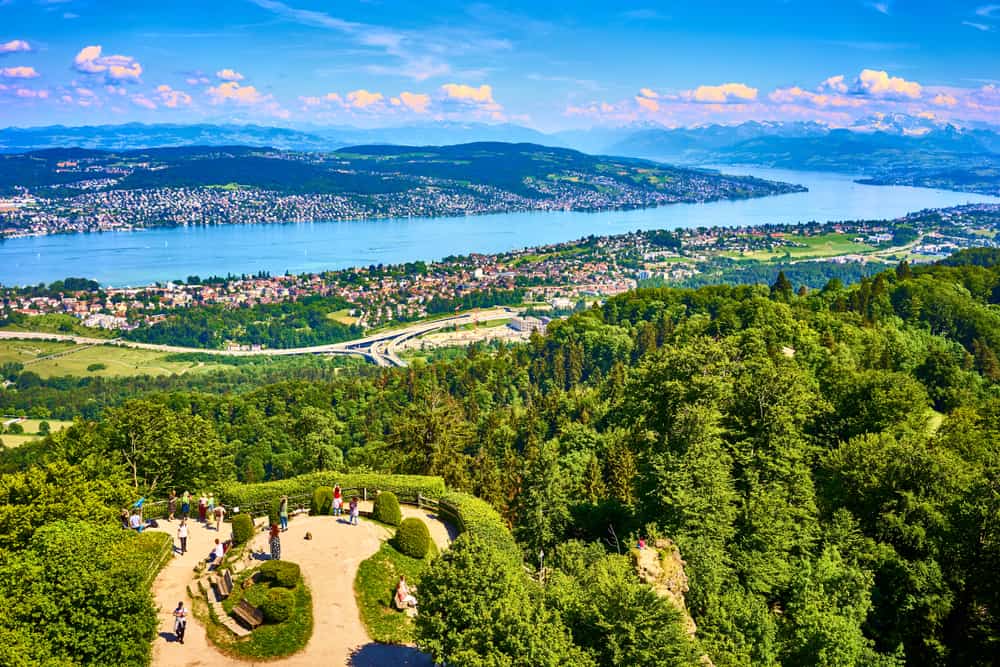
Take a Boat Ride
Once you fall in love with Lake Zurich and Limmat River, take the opportunity to get to know these beautiful bodies of water further by taking a boat ride. The Limmat River has multiple cruises that let you experience the city’s magnificent bridges from the water. You will be able to see the many different historic and famous parts of the city in a way you just cannot get from walking through it. Experience the lake via yacht or boat, and you will not regret it. The river and lake are part of what makes Zurich such a stop worthy location in Switzerland.
Visit the Museum of Art
If you do not have days to spend checking out all the museums and art galleries in Zurich, good news. You can get a taste of both in one place by visiting the Museum of Art. It boasts a wide variety of art pieces from multiple renowned Swiss artists, some of which go all the way back to the 13th century. They also feature modern art from this century. Furthermore, they also have works from famous artists world-wide, including van Gogh, Picasso, and Rembrandt. As far as museums go, this one is not overly expensive and really packs in a lot of quality. While you are there, do not hesitate to check out the lovely cafe and gift shop. Both have excellent offerings to really complete the experience.
Hike Rhine Falls
The Rhine Falls are not actually in Zurich but are a short train ride away to Schaffhausen. We think they are worth taking a bit of a detour, or even making a day-trip out of them. Part of what makes them so spectacular is the sheer strength behind them. The Rhine Falls is actually the most powerful waterfall in not only Switzerland, but Europe too. You can walk to them, or you can take a boat trip to check them out. You may want to bring in your own food and water if you are trying to preserve some of your hard-earned money because food and beverage prices here are steep. It is busiest in the middle of the day, so if you like avoiding crowds come earlier or later.
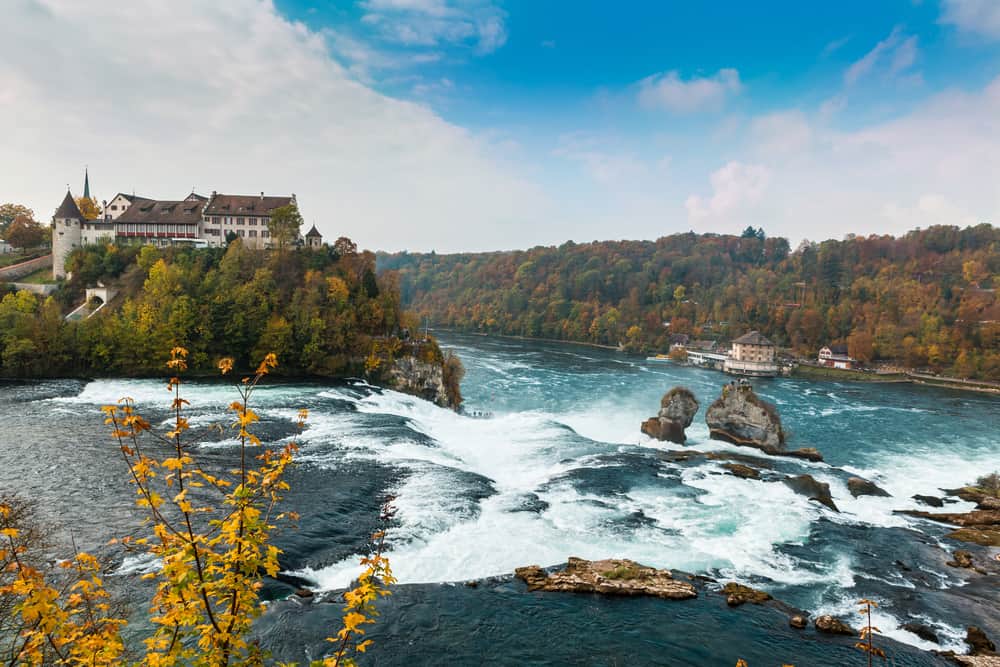
Spend Some Time at Historic Churches
Zurich has a distinct religious history, which is represented by the many, many remarkable churches throughout the city. Grossmunster is a Romanesque church that began as a monastic church. With two classic church towers, this one is a nostalgic reminder of the beautiful architecture of times past. Charlemagne’s grandson Louis founded the Fraumunster church, and it is a sight to behold. Here you can see stonework dating back to the 9th century in the crypt. If you want to see a truly historic church dating all the way back to the 8th century, with a tower that was used to spot fires in the city, check out the St Peter church.
Where to Stay in Zurich
Affordable: Chez Paula Check Rates: booking.com
Mid-Range: Hotel Seehof Check Rates: booking.com | hotels.com
Upscale: Storchen Zurich Check Rates: booking.com | hotels.com
Switzerland Road Trip Stop 2: Lucerne
Lucerne is often referred to as one of the prettiest cities in the world, and for good reason. Historians speculate on when this city was actually established, but it could have been as early as the 9th century. As such, it has some stellar architecture. Also, it is in Switzerland, so it is classically beautiful with breathtaking waterways and mountain peaks. If you can only go to a few places during your Switzerland road trip, we highly recommend Lucerne. This city has everything that makes Switzerland a country that people keep coming back to even though it is so expensive. Lucerne is packed with everything you need to make your road trip in Switzerland a success.
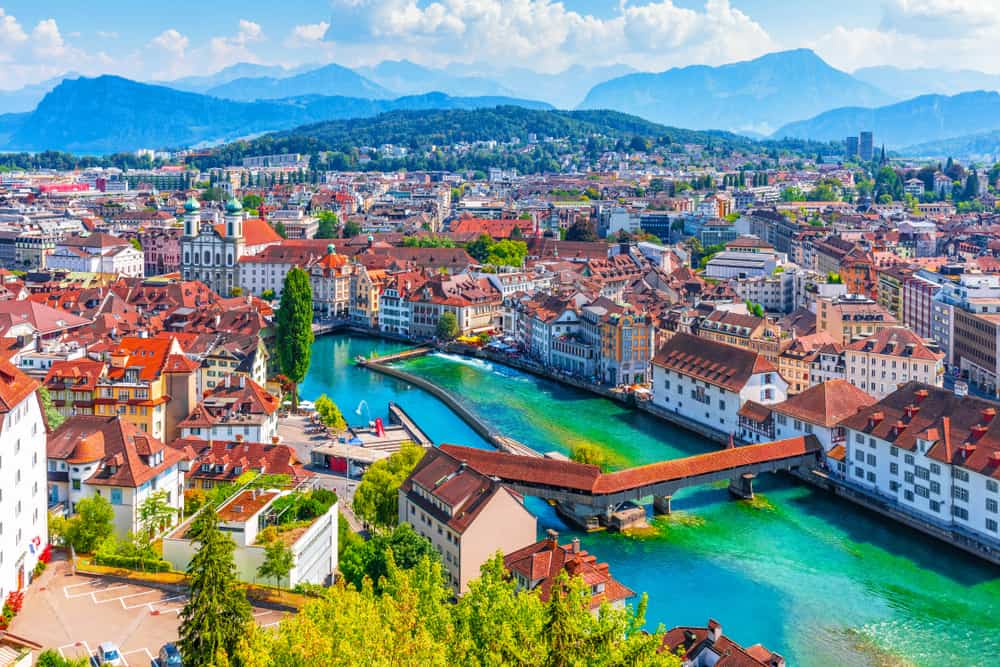
Noteworthy Things to do in Lucerne
Do the golden round trip.
Lucerne, in true Switzerland fashion, is built on the banks of Lake Lucerne. You can, of course, take all sorts of boat trips on the lake. If you want a bit of an adventure though, we recommend the Golden Round Trip . You start in a boat on the lake, then take a cogwheel railway to the summit of Mt Pilatus. Here there are several restaurants to choose from so that you can really enjoy the brilliant view without any hunger pangs. Descend via the cableway and gondolas, and then take a bus back to Lucerne. This is another excellent opportunity to use your Swiss Half Fare Card, which will cut the cost of this awesome trip in half.
Check Out the Dying Lion Monument
Switzerland is a very old country steeped in history and the Dying Lion Monument is a testament to this. During the French Revolution in 1792, around seven hundred Swiss Guards were massacred during and after the storming of the Tuileries Palace. The Dying Lion Monument honors them and commemorates their service. Carved out of the rock, this monument depicts a collapsed lion laying upon broken symbols of the French monarchy. A small pond in front of the relief brings another layer of reflection to this peaceful place. It is very famous, and to really feel the spirit of it we recommend going in the morning or evening, and avoiding the daytime crowds. Even if you go in the afternoon, the atmosphere tends to pervade through all of the people.
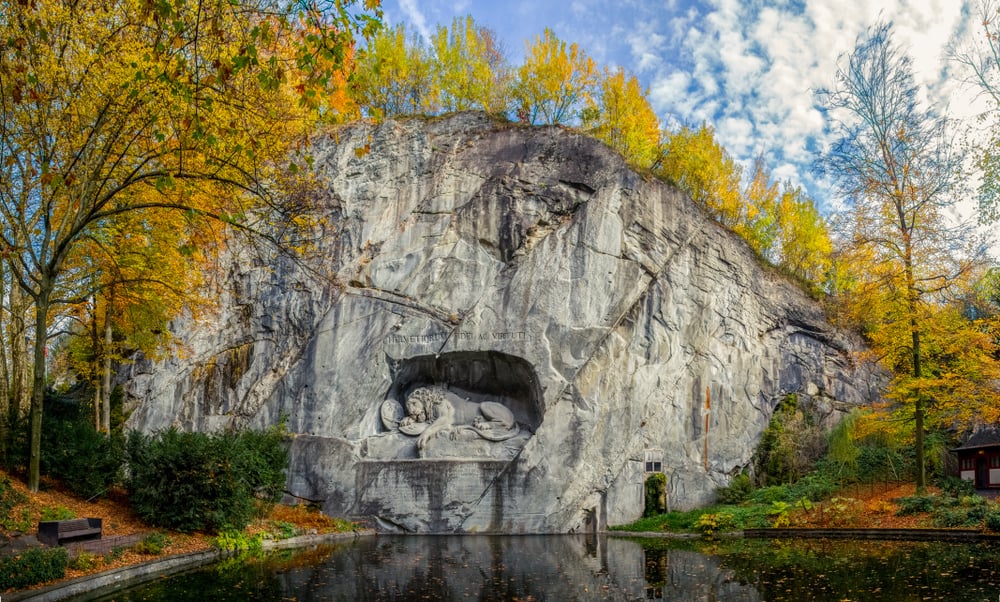
Visit the Chapel Bridge and Water Tower
Speaking of history, the Chapel Bridge is first referenced in written record in 1367, making it almost 700 years old. Unfortunately, a sudden midnight fire in 1993 destroyed most of the bridge. Perhaps even more of a loss than the historic bridge itself was the 85 historic paintings under the roof of the bridge, leaving only 35 remaining. A scarce 25 of those were restored, and the others were replaced when the bridge was restored. Fortunately, the bridge was restored and you can visit it once more during your road trip in Switzerland.
Next to the Chapel Bridge is the old Water Tower, which has its own fascinating history. One of the few structures that survived the fire in 1993, it has served as everything from a prison to a treasury vault. You are not able to go inside this building as it is currently in use as a club room, but it is worth a look from the outside.
Take a Cable Car to the Titlis Glacier
A short drive from Lucerne to Engelberg will give you the experience of a lifetime. The Titlis Glacier, found atop Titlis Mountain, is accessible via a rotating cable car from Engelberg. This experience is one for the books. The rotating cable car gives you panoramic landscapes from every angle and is worth the trip for that alone. Additionally, you will be able to explore a glacier cave, do a cliff walk, use an amazing suspension bridge, and visit cute shops and restaurants. Bring warm clothes and layers at whatever time of year you come, because this place is cold.
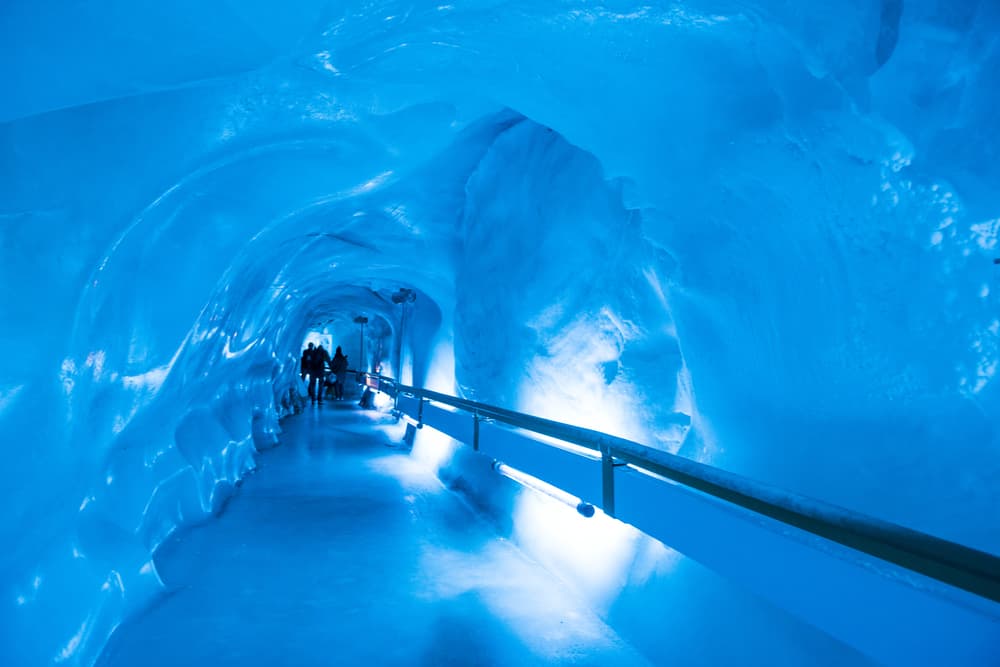
Hike Mt Pilatus and Mt Rigi
If you are not sold on the Golden Round Trip, we still recommend checking out the summit of Mt Pilatus. You can take the world’s steepest cogwheel train to the summit, or you can also hike to it within a good couple of hours. There is even a hotel at the top so that you can experience the beauty of the mountain at sunrise and sunset. Whenever you come, however long you stay, we think you will agree with us that the views here are simply unbeatable.
If hiking in Switzerland is a dream come true, you will also want to look into the trails of Mt Rigi. This mountain offers a multitude of trails at varying levels of difficulty so that you can choose how much of a challenge you want. From guided hikes to themed trails, Mt Rigi will not disappoint. Not to mention the views! If this sounds like your cup of tea, check out the Classic Rigi hiking trail, and the Rigi Panorama Path.
Where to Stay in Lucerne
Affordable: Hotel Balm Check Rates: booking.com | hotels.com
Mid-Range: Hotel des Balances Check Rates: booking.com | hotels.com
Upscale: Penthouse by Art Deco Hotel Montana Check Rates: booking.com | hotels.com
Switzerland Road Trip Stop 3: Lugano
One of our favorite things about Switzerland is that it is a true cultural melting pot. Across the country, you will find French, German, and Italian speaking regions. Lugano is in an Italian speaking region and has a wonderful Italian air about the city. The Italian aspect lends itself to the architecture and layout of the city. Looking at pictures, you could easily confuse it with Italy itself. We had to include it with our Switzerland road trip because it gives you a chance to squeeze another country in with your time in Switzerland! As with Zurich and Lucerne, Lugano is right next to a lake and has its own view of the alps in the distance.
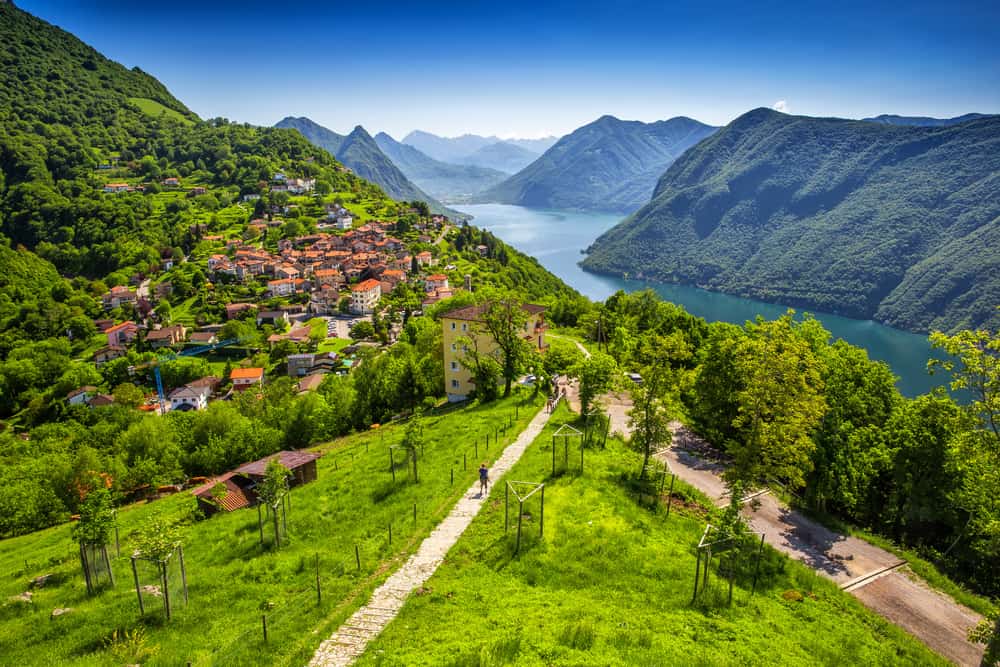
Noteworthy Things to do in Lugano
Explore lake lugano.
Lake Lugano is a narrow, winding lake that greets the edges of the steep mountains along with the city. It is actually a glacial lake that was carved by a glacier making its way through here thousands of years ago. You can make use of a boat or ferry to explore the many varied stops around the lake, many of which have delightful restaurants and shops. There are many boat trips available in the area so that you can visit some of the places only accessible by water. People access this lake from both the Italian side of the lake and the Swiss side of the lake, and it offers a great opportunity to spend a little time in both countries.
Climb Monte San Salvatore
What kind of stop would this be if we did not include a little hike? Monte San Salvatore is a little mountain at just over 900 meters tall. Never fear though, it is an excellent opportunity to see the breathtaking city of Lugano from above. You can hike for an hour to reach the top, or you can take a cable car. So if hiking is not your thing, but truly epic scenery totally is, Monte San Salvatore is an excellent option. Lake Lugano is amazing from any angle, but from the summit of Monte San Salvatore it is truly awe-inspiring. There is something about the way the lake hugs the sides of the peaks that stretch straight from the lake’s depths that will call to your soul from this viewpoint.
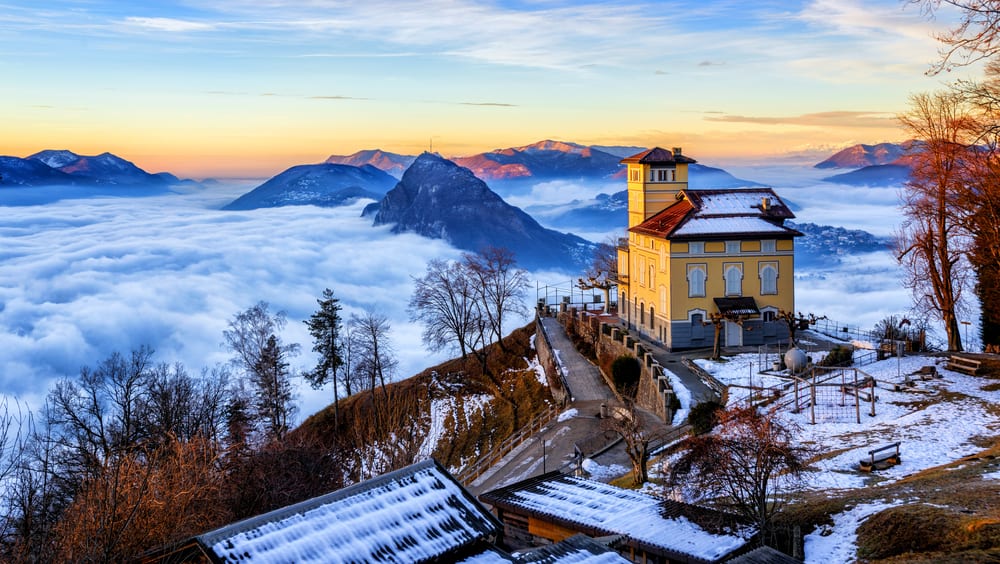
Visit Parco Civico
For another soul-stirring experience, visit Parco Civico. We do not know if you are catching on yet, but the best experiences in Lugano are all about the lake. Parco Civico gives you a chance to experience Lake Lugano right from its banks. Adding to the experience, you can also view the stunning mountain peaks from here. Stroll the pretty walkways, sit in reverent contemplation on one of the park benches, or get in touch with the wilderness inside you in the woodland areas. This is another area where you will want to catch at least one sunrise or sunset. The changing horizon reflected on the water is an unforgettable experience.
Adventure in Gandria
You might not think it now, looking at the quaint waterside village of Gandria, but this little part of Lugano used to be home to some pretty illicit activities. Only a hundred years ago, it was home to a major smuggling operation. Today it is a pleasant, picturesque scene of the kind of hillside village dreams are made of. Houses line the slopes of the hill as it descends toward the lake, and boats line the waterways. It is also home to the Church of St Viglio, another popular stop during your time in Lugano. If you would like to learn more about this beautiful area and its colorful past, visit the Swiss Customs Museum directly across the lake.
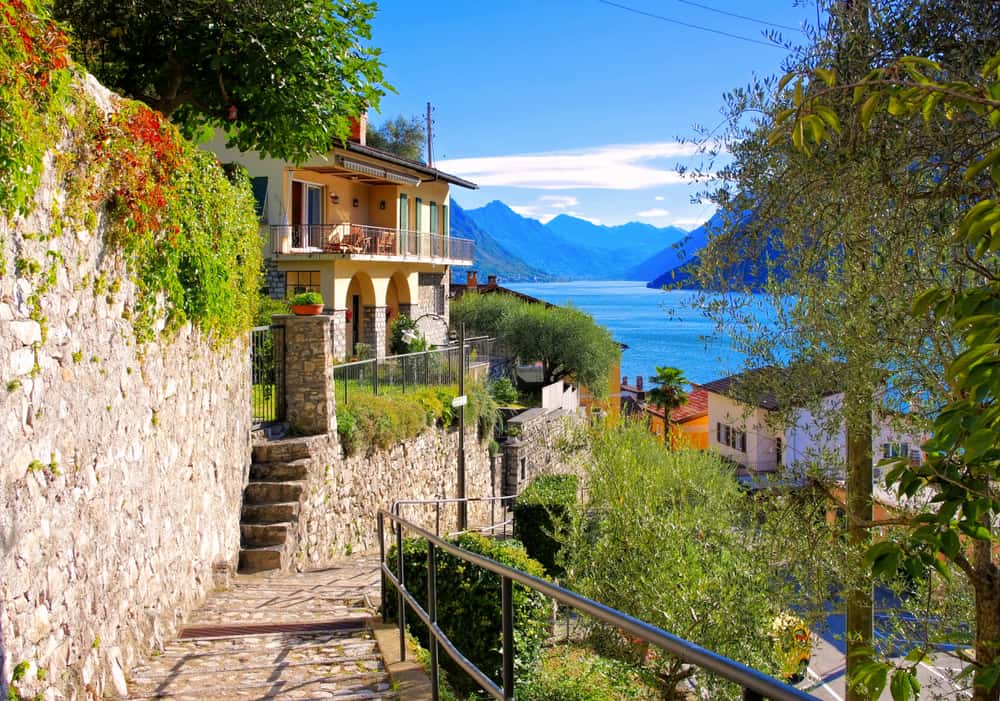
Darken Some Church Doors
Lugano comes complete with its own set of historic churches. A couple of our favorites are the Chiesa di Santa Maria degli Angeli, and the Cattedrale di San Lorenzo. The Chiesa di Santa Maria degli Angeli has a Renaissance fresco from 1529 that has been fantastically preserved, along with several other religious paintings from the same time period. The Cattedrale di San Lorenzo was also constructed during the 16th century, albeit over a Roman building from far earlier times. It is built with white limestone and marble that make it stand out and shine. This beautiful cathedral also offers views of the lake and mountains, making it a classic place to visit while in Lugano.
Where to Stay in Lugano
Affordable: Lugano Dante Center Swiss Quality Hotel Check Rates: booking.com | hotels.com
Mid-Range: Hotel Splendide Royal Check Rates: booking.com | hotels.com
Upscale: The View Lugano Check Rates: booking.com | hotels.com
Switzerland Road Trip Stop 4: Zermatt
Zermatt is a resort city in Switzerland, best known for its views of and access to the Matterhorn. As home to one of the most famous mountain peaks in the world, let alone Switzerland, of course we had to make it a stop on our Switzerland road trip! This popular city’s activities revolve around the mountain and makes for a great experience for anyone looking to do a little mountaineering. Even if your only interaction with the mountain is to sip coffee (or tea or hot chocolate!) from your balcony, Zermatt is a fun place to spend some time. From the classic cabins to the snowy hillsides, you will not regret however much time you choose to dedicate to this place.
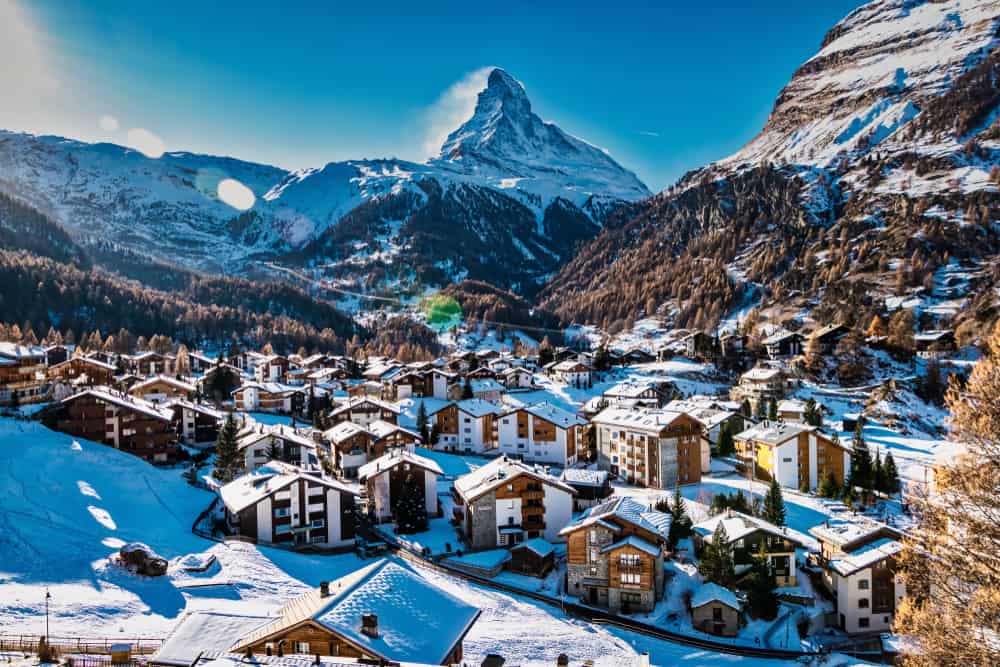
Noteworthy Things to do in Zermatt
More people visit Zermatt for the skiing than the Matterhorn, which makes sense since the Matterhorn is a little deadly. Skiing is why Zermatt has become such a popular resort town. While skiing is most accessible November through April, there are often areas where you can ski in the warmer months of the year as well. Zermatt is at a very high altitude, with multiple glaciers, and things stay pretty cold here year-round. When you have had your fill of skiing, check out some of the popular restaurants located all over this mountainous area.
Experience the Matterhorn
For those of you who may be unaware, the Matterhorn is a famous mountain with a seriously challenging ascent. We mean it when we say seriously challenging . Do not attempt to climb this mountain if you are not an expert. That does not mean you cannot still experience it though! There are viewpoints all over the place where you can view the famous peak from afar, where you will not die from trying to climb it. Yes, people have died trying to hike this mountain. You can even visit the Mountaineers’ Cemetery where many of the people who have perished climbing the Matterhorn are buried. We recommend checking out the Klein Matterhorn via aerial tramway, where you will be able to experience the mountain safely.
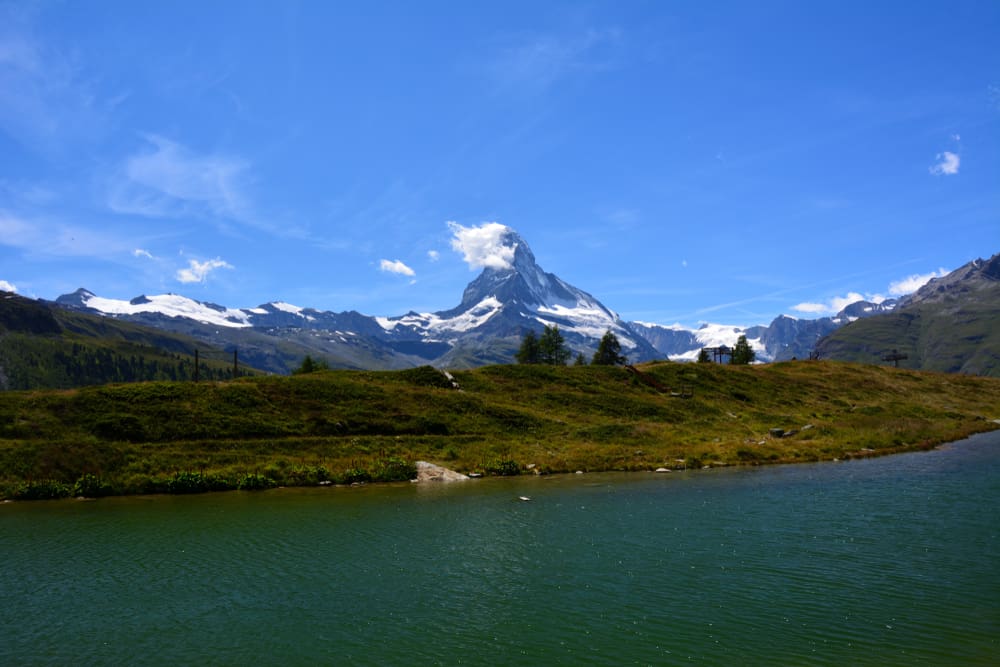
Visit Gornergrat Station
Zermatt boasts the highest open-air rack railway in Europe, and you can use it to visit Gornergrat Station. The railway was built more than a thousand years ago and remains a truly great feat of brilliant engineering. When you reach the station you will be able to view the Matterhorn, as well as the Dufourspitze, another famous Swiss mountain. Switzerland has no end of amazing views accessible throughout the country, but we really question if you can find one greater than those of Gornergrat Station. The whole experience, from the railway to the station, is one that you will never forget.
Ride a Cable Car
Being the skiing resort town that it is, Zermatt has some serious cable cars that are in use year-round. Whether you use them in the winter for skiing, or in the summer for hiking, the cable cars here offer unique views of the mountains and valleys in this area. Honestly, we would ride the cable cars just for the ride and views alone. There is just something about riding in a cable car high above the world while taking in some of the most spectacular views in Switzerland. We highly recommend checking them out if you visit Zermatt.
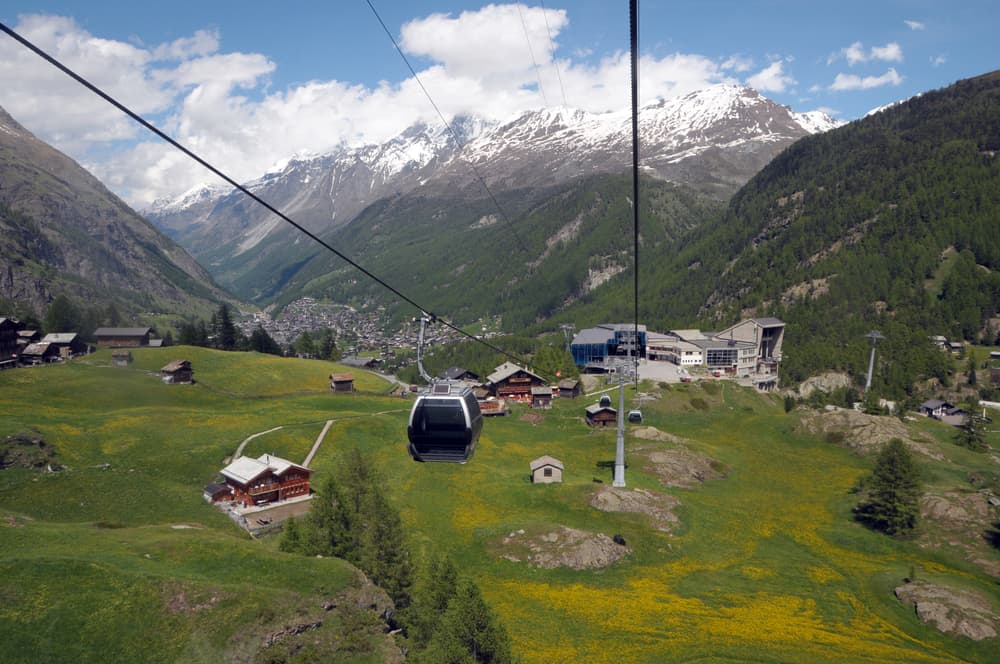
Check Out Sunnegga
Sunnegga is another great place for experiencing the awesomeness of the Matterhorn safely. Accessed via the Zermatt-Sunnegga funicular, it offers a stunning panoramic view of the Matterhorn. Another beautiful attraction is Leisee Lake. It is popular with solo travelers and families alike for its pristine beach. You can swim, barbecue, and soak in the ambiance of this gorgeous place. Even in the winter, it offers pristine views and snowshoe trails. Sunnegga is one of our favorite ways to experience the Matterhorn.
Where to Stay in Zermatt
Affordable: Best Western Hotel Butterfly Check Rates: booking.com | hotels.com
Mid-Range: Grand Hotel Zermatterhof Check Rates: booking.com | hotels.com
Upscale: Le Mirabeau Hotel & Spa Check Rates: booking.com
Switzerland Road Trip Stop 5: Interlaken
All the best things about Switzerland are in full force in Interlaken, making it one of our top stops for your Switzerland road trip. This little town is located between two lakes and has easy access to mountains, forests, and all kinds of hiking and skiing. Interlaken has the ability to meet and exceed all of your Switzerland expectations. It is an outdoor enthusiast’s paradise. If Zurich is the city where you could spend a week inside, Interlaken is the place where you could spend a week outside. Honestly, you could probably spend several weeks outside and still never run out of exciting adventures to engage in.
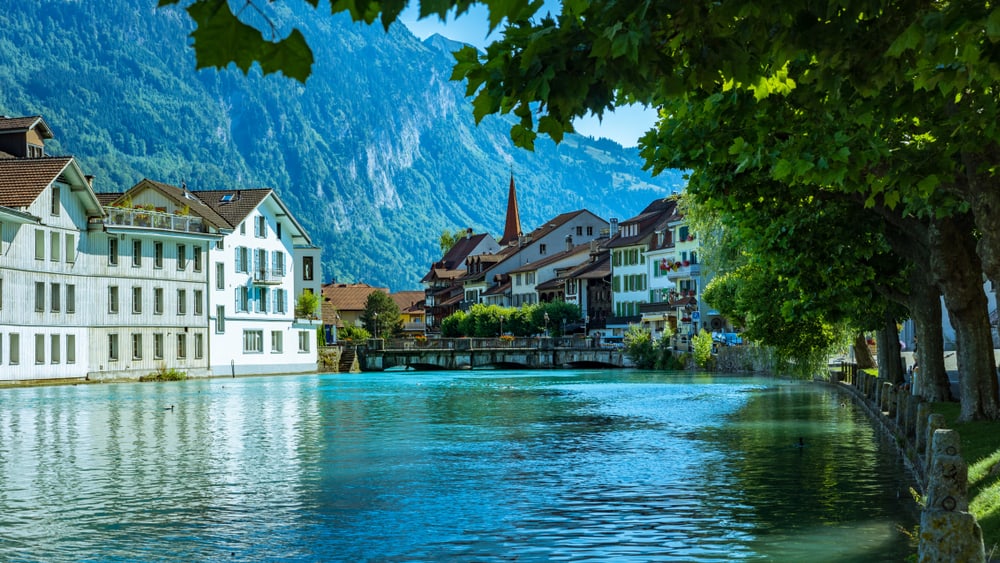
Noteworthy Things to do in Interlaken
Do all the things.
What exactly are all of the things? Paragliding, speedboating, river rafting, mountain biking, hiking, skiing, and skydiving , to name a few. Interlaken is commonly referred to as an adventure capital, and the people who call it this know what they are talking about. You can find guides and tours for pretty much anything you can imagine, or you can go solo. Interlaken is not nearly as big as some of the cities in this Switzerland road trip, but it is absolutely surrounded by the wild outside in all the best ways. Whatever your level of physical fitness, Interlaken offers a way for you to get outdoors and enjoy it.
Check out Jungfraujoch
The Jungfraujoch railway is part of a dream that began in 1860 to make a railway on Jungfrau Mountain. Construction did not actually begin until 1896, and the railway was not inaugurated until 1912. This railway continued to be developed through the 20th century up through 1996. All of this history to tell you that some of the absolute best things are a long time coming. Jungfraujoch takes you to the highest railway station in Europe. You are greeted at the top station by a wintery world of ice and wonder, home to the Aletsch Glacier. Take it a step further by going even higher up from the station to the Sphinx Observatory.
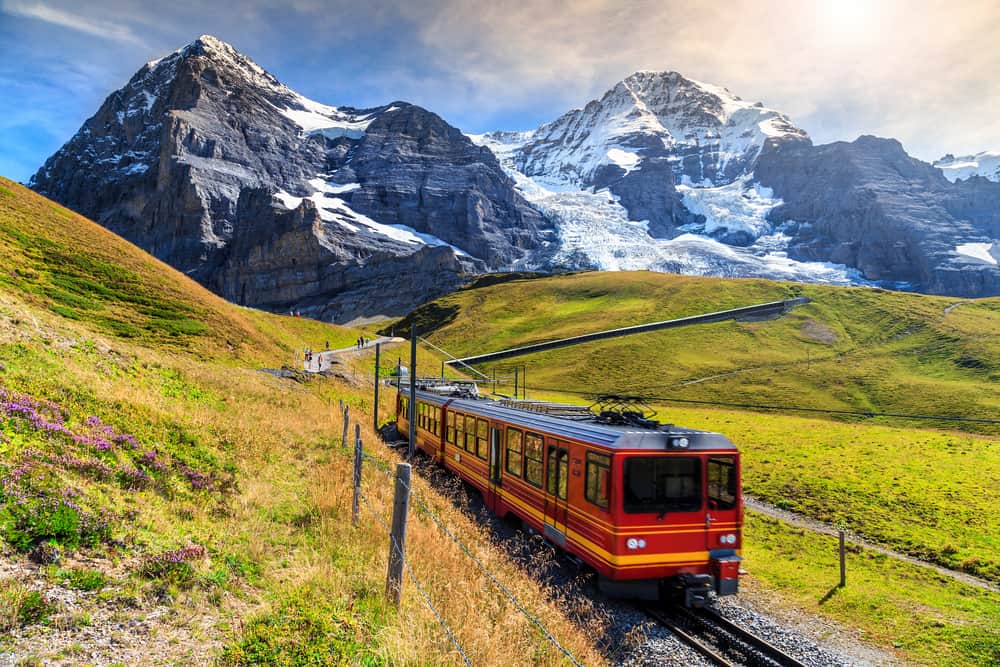
Experience the Schynige Platte Railway
It hardly seems fair that one little Swiss town can be home to two of the most epic railways in the world, but nevertheless it is true. Giving the Jungfraujoch a run for its money, the Schynige Platt Railway is also one of the highest railways in Switzerland! This railway took a lot less time to come to fruition, opening in 1893. It has been running for 126 years! You will love the Schynige Platte Railway for many reasons. Chief among them are the mountain views that will steal your heart and the Alpine garden at the top that will charm your imagination. This is one of those experiences that you will think back to a long time after.
Explore Unterseen
Okay, so technically Unterseen is its own town, and not totally part of Interlaken. But it is so close that it is almost the same town, and we are counting it! You should visit Unterseen during your road trip in Switzerland because we said so. Just kidding! You should visit Unterseen because it is awesome! It is a medieval town packed with historic buildings and character. Even more tantalizing is the Weissenau Nature Reserve, which lies right next to Unterseen. This beautiful wetland is home to the ruins of Weissenau Castle, a castle from the 1200s. As if this is not reason enough to visit Unterseen, this whimsical place has yet to be discovered by mainstream tourism and is much less busy than the main town of Interlaken. It is the perfect place to get some alone time in the wilderness.

Visit St Beatus Caves
We are telling you, Interlaken has everything. Off to the side of one of the neighboring lakes, Lake Thun, exists St Beatus Caves. According to local legend, a dragon used to live in these caves until the Irish monk Beatus came along in the 500s BC, kicked the dragon out, and made the place his own. 1500 years later, all that is left is a cave system that will blow your mind. It comes complete with its own waterfall, hiking path, restaurant, and museum. You can get here by car or bus. We recommend coming earlier or later in the day, as this is a popular tourist destination and the narrow walkways can get a little packed.
Where to Stay in Interlaken
Affordable: Hotel Tell Check Rates: booking.com
Mid-Range: Villa Heimgarten Check Rates: booking.com
Upscale: Victoria Jungfrau Grand Hotel & Spa Check Rates: booking.com | hotels.com
Switzerland Road Trip Stop 6: Lauterbrunnen
If Interlaken is Switzerland’s adventure capital, Lauterbrunnen is Switzerland’s fairytale capital. We are basing this opinion strictly on looks, but check out the picture below. Lauterbrunnen is beautiful in the most whimsical, dreamy, and lovely way. From the way the valley naturally draws your gaze toward the old church steeple, to the casual waterfall just doing its thing on the side, this place is stunning . Fun fact: Lauterbrunnen actually has 72 waterfalls. There is no typo there. 72. Waterfalls. Seriously, this place practically oozes magic. If ever there was a sprite and fairy capital, it would be here. Add this stop to your Switzerland road trip for a chance to truly step outside the norm.
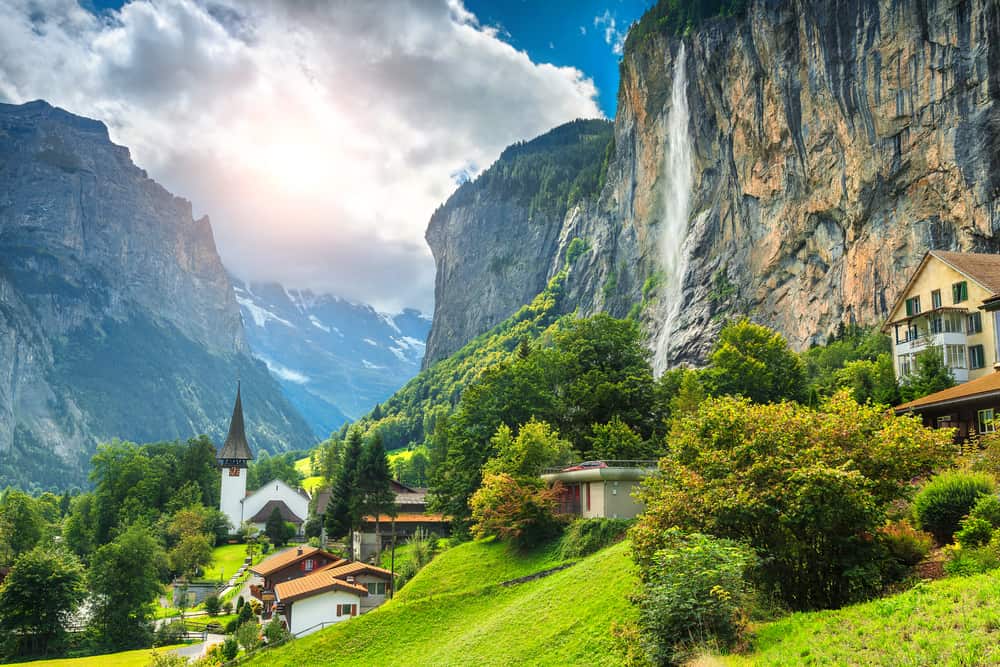
Noteworthy Things to do in Lauterbrunnen
Check out some waterfalls.
You saw this one coming, right? When in Lauterbrunnen, you check out the waterfalls. We mean, honestly, you cannot really help it when they are literally everywhere, so just plan on it. And while you are at it, we especially recommend taking some time to see Trummelbach Falls. This natural wonder is made of ten waterfalls cascading down into the valley. It is more of a walk than a hike to go see them, making it almost criminal not to. When nature makes it this easy to see something amazing, you just do it. Another noteworthy waterfall in Lauterbrunnen is Stabbauch Falls, the prominent waterfall you see when you first see the town.
Spend Some Time at the Jungfraujoch Observation Area
You can get to Jungfraujoch through Lauterbrunnen too, not just through Interlaken! This just might be one of the most expensive things you do while in Switzerland (save some serious money on this one with a Swiss Travel Pass or Half Fare Card!), but we are telling you, this view is unbeatable. Switzerland has a lot of unbeatable views, we know. We have already told you about several. But folks… The Jungfraujoch Observation Area is extraordinary. Not only that, but there are other attractions in this popular spot. A couple of our favorites are the Ice Palace and the Lindt Swiss Chocolate Heaven.
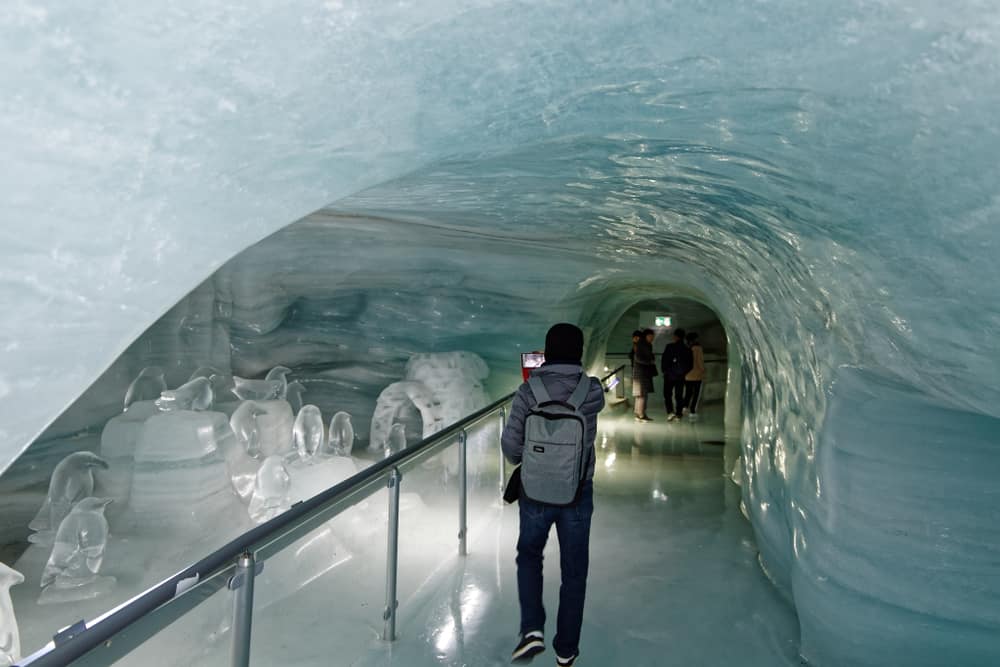
Take a Train up to Murren
If you like a little seclusion with your waterfalls, you will want to take the train to Murren. It is a very small village just shy of 400 residents, built on the plateau above Lauterbrunnen. You cannot drive here, but once you get here by train you will not miss having a vehicle. This little village is the gateway to several hikes, paths, and walking trails. There are also more trains and cable cars that go on from here to even more viewpoints and scenic trails. Go to Lauterbrunnen to view this beautiful valley from below, and to Murren to see it from above.
Visit the Observation Deck
Okay, so technically the observation deck in question is also in Murren, but it is fantastic enough to warrant its own section. This viewpoint on the edge of the plateau gives an excellent view of the valley below and the pretty village of Lauterbrunnen. As with many other popular places on this list, we recommend getting your views in earlier in the day so that you can miss some of the crowds. The word is out that the observation deck in Murren is simply spectacular, but it is still worth taking the time to go see. You just might want to go see it earlier rather than later.
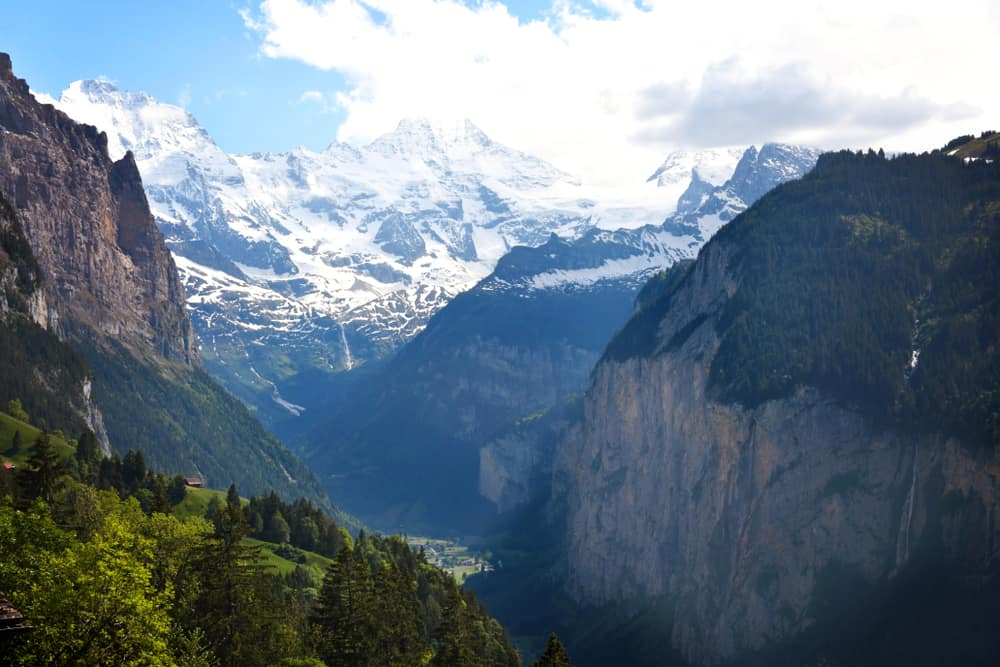
Hike to Gimmelwald
Like Murren, Gimmelwald is another traffic-free village accessible by train. It has half as many people as Murren and is just as idyllic. Something entirely unique to Gimmelwald is the Honesty Shop. Imagine a store full of souvenirs, treats, and local artwork. Now take out the cash registers, the cashiers, and the part where anyone is there to hold you accountable. The stuff is not free–everything has a price on it. But you pay by putting money in the honesty box. That is it. Is it crazy, or is it genius? We think it is innovative, and a nice way to put some trust back in the world.
Where to Stay in Lauterbrunnen
Affordable: Hotel Steinbock Check Rates: booking.com
Mid-Range: Hotel Silberhorn Check Rates: booking.com | hotels.com
Upscale: Hotel Staubbach Check Rates: booking.com
Switzerland Road Trip Stop 7: Bern
Welcome to the capital of Switzerland! You cannot make a Switzerland road trip itinerary without making Bern one of the stops along the way. We are not saying you have to stop here (you do the road trip you want to do!), but it is definitely worth considering. This amazing city dates back to the 12th century, and as such, is packed with Swiss history. It is littered with thought-provoking architecture, fountains from the 1500s, and gardens to draw you outside. Bern is a great place to do something a little different, but still entirely Swiss during your road trip in Switzerland.
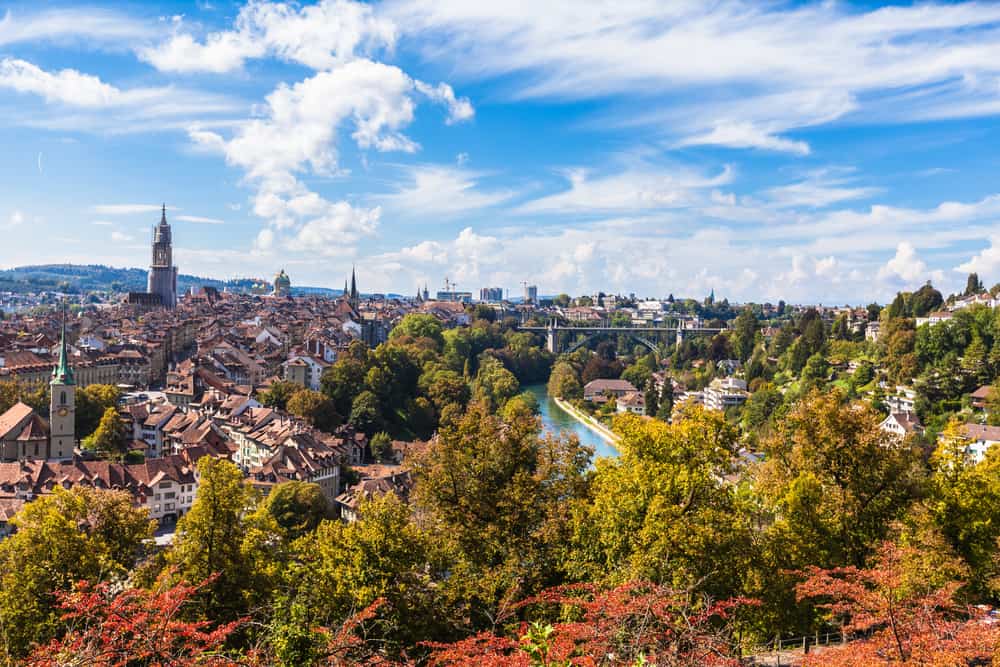
Noteworthy Things to do in Bern
Check out the clock tower.
Zytglogge is the famous clock tower of Bern. It is famous because of its moving puppets that make an appearance every hour. It is located in Bern’s Old Town, which is listed as its own attraction further down. Zytglogge is a tribute to a different time when Switzerland was renowned for its clockmaking. This clock tower displays everything wonderful and whimsical about the clockmaking of centuries past. In fact, it is 800 years old, and still functioning just as well now as it did then thanks to the extensive care it has been given over the years. Check it out by yourself or take a tour to learn all there is to learn. Either way, definitely consider spending some time here.
Relax in Rosengarten
One of the things we love about Switzerland is how integrated with nature nearly everything is. Rosengarten is no different. This serene park began as a cemetery and has only been a public place for the last century. Take advantage of the opportunity to picnic here, or visit the restaurant inside the park. Spend some time in quiet reflection and peaceful contemplation. Rosengarten promises a sigh of relief and a breath of fresh air for those who choose to spend some of their precious moments in Switzerland here. Abide by the pond, explore the over 400 species of flowers, and just breathe in the quiet ambiance of the place.
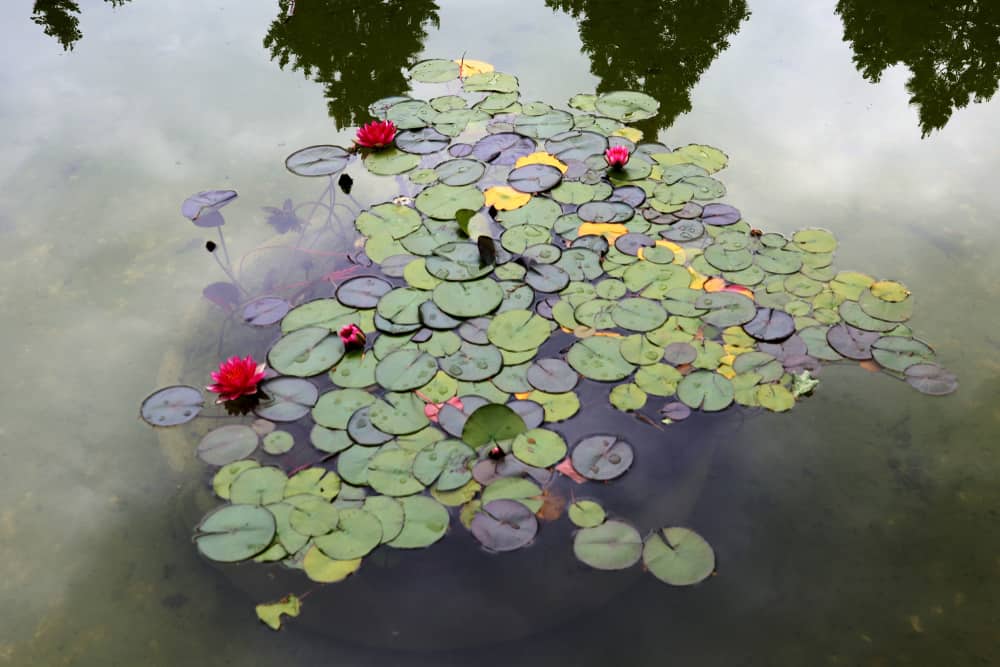
Visit the Cathedral
Bern’s famous cathedral is known by many names. The Berner Munster, the Bern Cathedral, the Cathedral of St. Vincent. It was built over the course of 470 years between 1421 and 1893. You will be greeted by sculptures, paintings, architecture, and the history that has been steeped into this very old building. Because of the long, drawn-out time span during which it was built, Bern’s cathedral also has a wide variety of art from the centuries. Just as impressive is the Baroque Organ from the early 18th century. The cathedral’s terrace, with all its trees and views, is almost as impressive as the cathedral itself.
Spend Some Time in the Old Town
Bern’s historic center comes complete with its very own covered shopping area. Whether there is rain or sun, this is a fun area to spend some time even if you do not want to spend some money. Window shopping is perfectly acceptable! Even if shopping is not your thing, Bern’s old town is still worth checking out. It is built on a cliff, right next to the Aare River. Cobbled streets will lead you through the historic streets to restaurants, bookstores, and picturesque sitting areas.
Where to Stay in Bern
Affordable: Hotel Savoy Check Rates: booking.com | hotels.com
Mid-Range: Hotel Jardin Check Rates: booking.com | hotels.com
Upscale: Hotel Schweizerhof Bern Check Rates: b oo king.com | hotels.com
Switzerland Road Trip Stop 8: Montreux
For most of the year, Montreux is a sleepy little town near Geneva, but for two weeks it becomes a culture center when the Jazz Festival comes to town. Whether your road trip in Switzerland happens during the festival or not, Montreux is a great addition to your Switzerland itinerary. One of the lesser-known, but greatly appreciated benefits of Montreux is the microclimate. Because of its unique location and proximity to Lake Geneva, this town has a shorter winter and warmer temperatures all year round. Montreux is colloquially referred to as the Swiss Riviera because of its great weather and festival vibes.
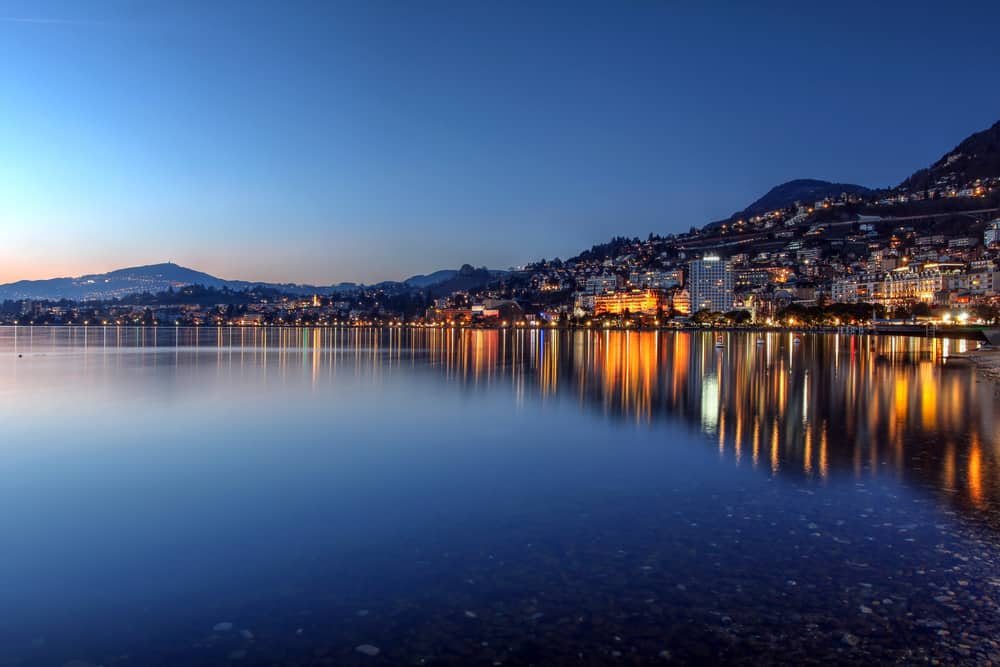
Noteworthy Things to do in Montreux
Take the chocolate train.
Honestly, we cannot think of anything more Swiss than the Chocolate Train. If it just had a medieval, classic Swiss-made clock somewhere, it would be perfect! Even so, the Chocolate Train is pretty spectacular. Now, you can do this tour on your own and certainly do not have to take the train for this one if you want to save some money. However you do it though, if you like chocolate and cheese this experience is for you! Begin in Montreux, go to Gruyeres to visit the cheese factory, and then make your way from there to the Nestle Factory.
Experience the Jazz Festival
Montreux’s Jazz Festival is an experience like few others. Expect to have to elbow your way in to experience it, because there will be crowds! It used to be held in a Casino, but that burned down in 1971. That did not stop anyone though, and the Jazz Festival is very much alive and well today. During the 70s it was strictly a Jazz Festival but has evolved over the last few decades to be much more comprehensive. Although the exact dates change every year, you can expect it to happen sometime in the first couple of weeks of July.
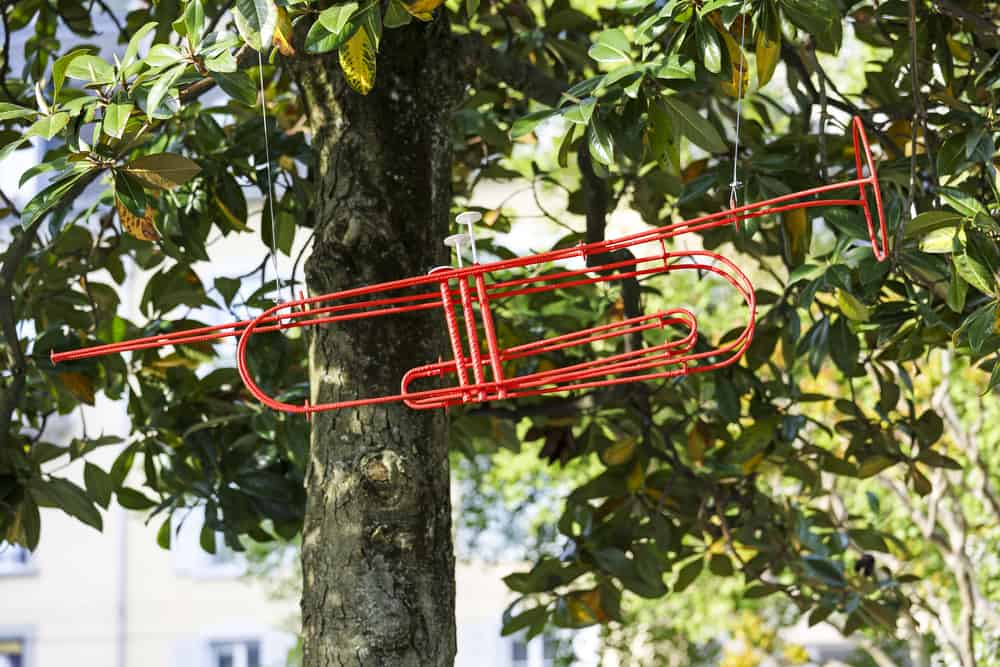
Explore the Lantern Trail
Winter in Montreux may not have the Jazz Festival, but it does have the lantern trail of Les Pleiades. A quick train ride will take you from Montreux to the Les Pleiades train station. There you will find a trail that has been painstakingly lit by lanterns. They provide an otherworldly glow to guide you through the landscape. Snowshoes are requisite and serve to further build the clandestine experience. A Switzerland road trip offers so many opportunities to experience nature in unique and unorthodox ways, and we highly recommend this one.
Check Out Rochers de Naye
By now you have surely caught on to the pattern of coming to a place just to take a train to another place, right? That is why we told you about the Swiss Travel Pass and the Half Fare Card in the beginning. You do not have to take trains anywhere while you are in Switzerland, but you will miss out on a lot of amazing experiences. Rochers de Naye continues the pattern of visiting one place to get to another. When you are ready to take a bit of a break from Montreux, but not leave completely, take the train to Rochers de Naye. It is one of the Swiss Alps mountains, and it gives you stunning views of Lake Geneva below.
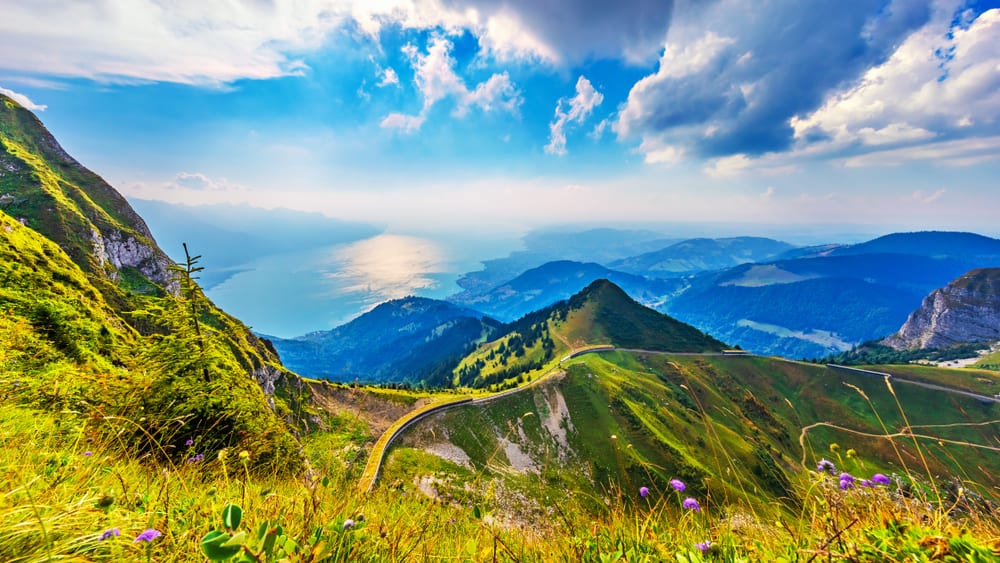
Visit Glacier 3000
Speaking of excellent day-trips from Montreux, might we suggest Glacier 3000? As far as pure, unadulterated awesomeness goes, Glacier 3000 takes the cake. We have mentioned a couple of glaciers so far in this itinerary, but Glacier 3000 is an entirely new experience. This adventure begins much like most others in Switzerland: you take a cable car. But then–then, you can ride the Alpine Coaster, ride a bus on the glacier, traverse the world’s first suspension bridge, and eat at a restaurant on top of the world. And honestly, for Switzerland, this one is not even that terribly expensive. It is a win all the way around.
Where to Stay Near Montreux
Affordable: Alpe Fleurie Hotel & Restaurant Check Rates: booking.com | hotels.com
Mid-Range: Le Mirador Resort & Spa Check Rates: booking.com | hotels.com
Upscale: Grand Hotel du Lac Check Rates: booking.com | hotels.com
Switzerland Road Trip Stop 9: Nendaz
Nendaz is popular during the winter months for its excellent skiing. If you are doing a summer Switzerland road trip though, Nendaz still promises to impress. This place has its own summer festivals, easy access to outdoor adventures, and views just as mindblowing as any other Swiss city. And, because it is better known for its winter skiing, the summer offers more of a relaxed experience than some of the other Switzerland cities and towns we have listed.
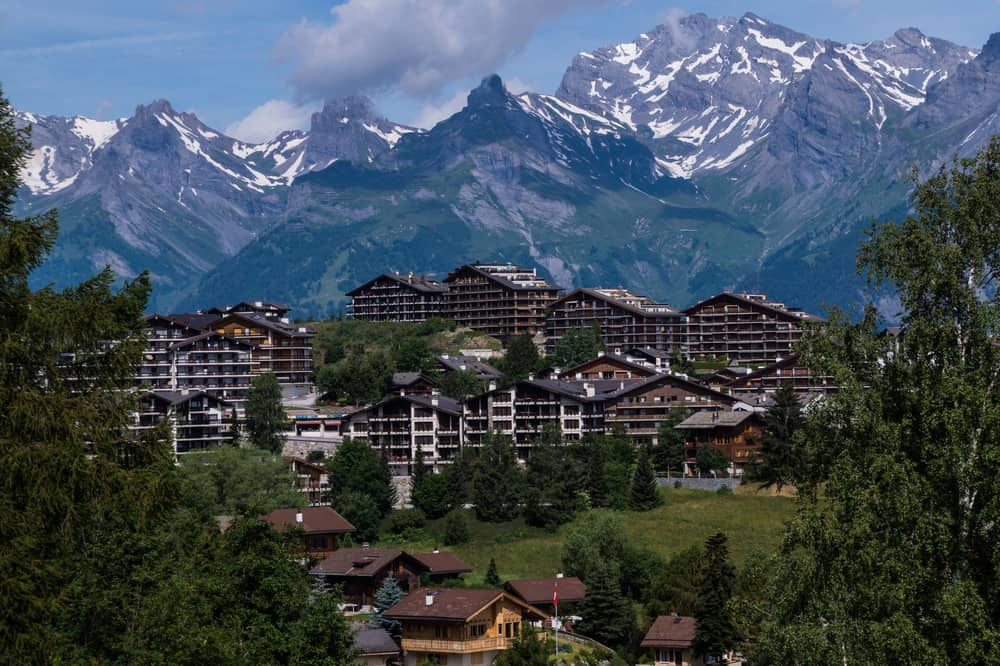
Noteworthy Things to do in Nendaz
Take a cable car to tracouet.
Every Swiss town, no matter how big or small, has its own mountain. And every mountain, no matter how big or small, has its own cable car or railway. Tracouet is Nendaz’s mountain. One of the lovely things about Switzerland is the country both recognizes the splendor of its mountains and also makes it easy to experience them, hence the abundance of cable cars and trains. Take part in a classic Switzerland landscape via the traditional cable car, and enjoy Tracouet.
Check Out the Summer Alphorn Festival
Have you seen or heard a traditional Swiss Alphorn? If not, definitely consider visiting Nendaz during the annual Swiss Alphorn Festival. Quite different than the Jazz Festival in Montreux, Nendaz’s Summer Alphorn Festival is a work of pure Swiss tradition and history. The alphorn is a very long horn, spanning several feet, traditionally made of wood. Originally it was used as a means of communication, but over time has come to be used for music instead. The Summer Alphorn Festival celebrates this instrument and its important place in Swiss history and tradition.
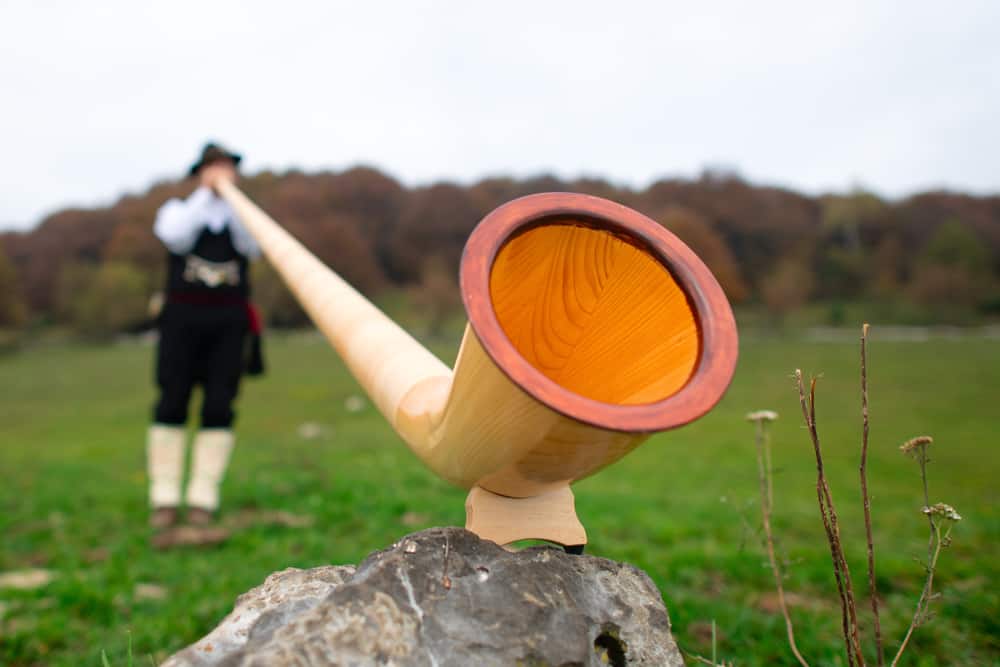
Swim in the Public Pool
If you did a double-take at that title, you are not alone. Public pools and illustrious foreign road trips do not often go hand in hand. However, in Nendaz, Switzerland, they most certainly do. Now, it is only open during mid-June through August, so this is a limited-time opportunity. However, if you can swing it, you have got to check this mountain pool out. Swim with clear views of the valley and mountains–this is truly an experience unlike many others.
Go Mountain Biking and Hiking
You can actually do this one after you take the cable car up Tracouet! At the top of Nendaz’s mountain lies a spectacular trail network that you can walk, hike, or bike to your heart’s content. People from all over the world come here to experience the trails for themselves, and for good reason. They are beautiful in the winter when people come to ski, and just as extraordinary in the summer when the snow has left behind lush green meadows. Spend as much or as little energy here as you want. Nendaz offers ways to experience nature whatever your level of physical fitness.
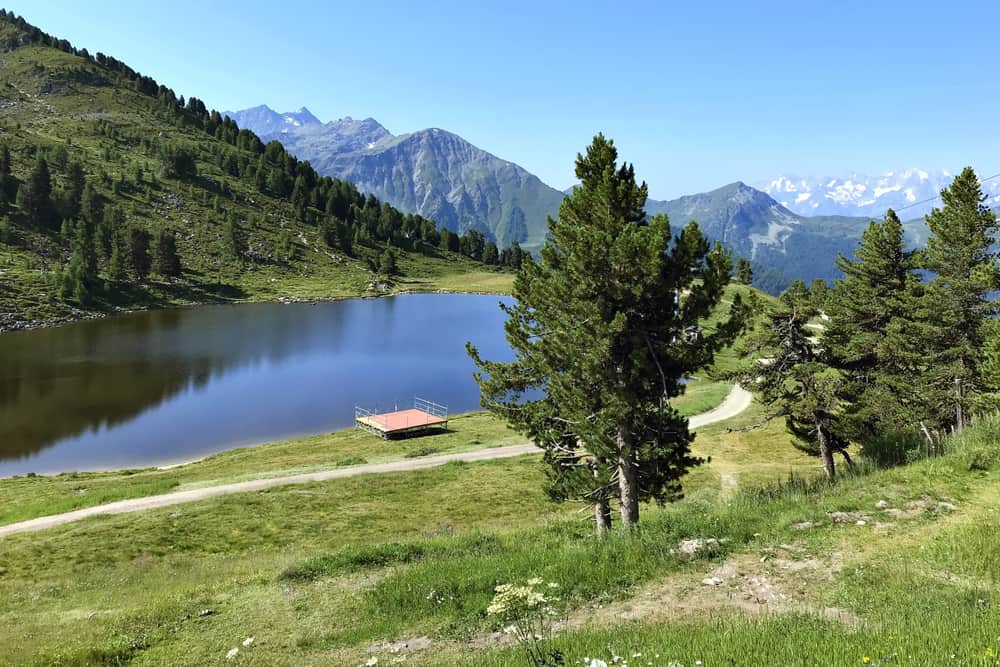
Visit the Spa
Nendaz is a resort town, and it takes that identity seriously. You will definitely be able to tell when you visit the Spa des Bisses in the 4 Vallees Hotel. Not only is this hotel one of our recommended places to stay listed below, but it is a great place to get some serious relaxation in. Even if you do not stay in the hotel, we still recommend checking out the spa. It offers all kinds of luxurious relaxation experiences and promises not to disappoint.
Where to Stay in and Near Nendaz
Affordable: Martigny Boutique-Hotel Check Rates: booking.com | hotels.com
Mid-Range: Nendaz 4 Vallees & Spa Check Rates: booking.com | hotels.com
Upscale: W Verbier Check Rates: booking.com | hotels.com
Switzerland Road Trip Stop 10: Geneva
Geneva is a city of beauty, refinement, and culture. It is a wonderful place to end your Switzerland road trip. While you are here, take a moment to sit on the longest wooden bench in the world, located in the Old Town. Come during August for the sunrise festival, or in spring to witness the budding of the city’s famous chestnut tree that announces the change in season. Whenever you come, whatever you choose to spend your time on, Geneva will leave you with happy memories and a lasting fondness for Switzerland.
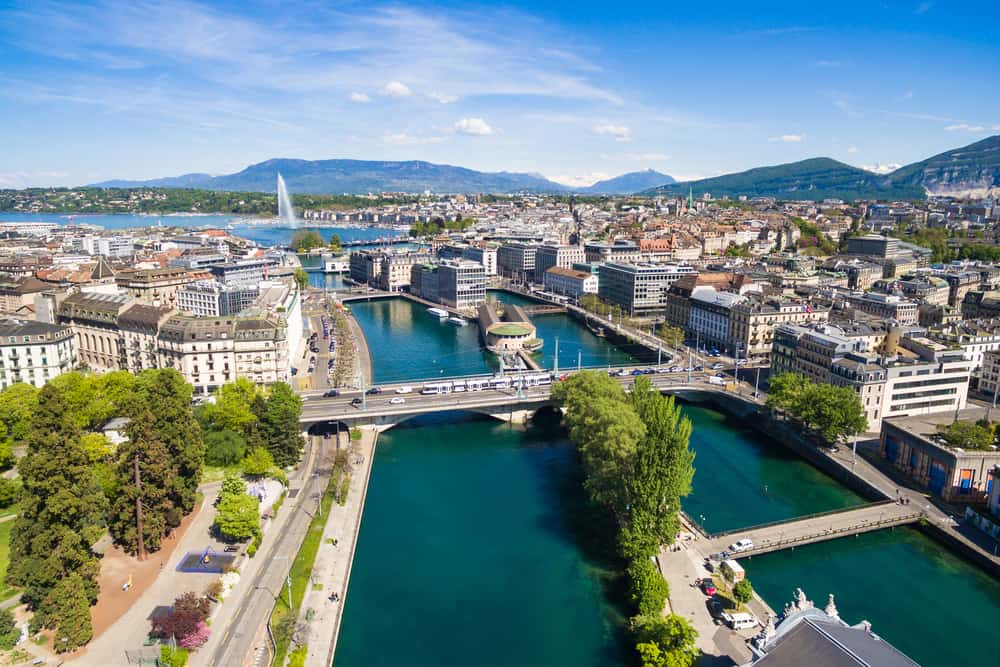
Noteworthy Things to do in Geneva
Visit the cathedral of st. pierre.
St Pierre Cathedral is a historic cathedral that looks more like the Parthenon than a church. This is not surprising, given its beginning as a Roman Catholic Cathedral. You might be surprised to know that the Roman facade was not originally part of this church though, but rather added in the 1700s. This church has gone through several transitions over the centuries, having also become a Reformed Protestant Church during the Reformation, and with many additions built along the way. Inside you will find the classic stunning architecture and decoration that continues to make cathedrals popular tourist destinations after hundred of years.
Go to the Headquarter of the United Nations
As we mentioned before, Switzerland is a major melting pot of several different countries. There are separate regions that speak different languages and draw from a variety of cultures. It must have felt like a natural decision back in the 1930s to make Geneva the headquarters of the League of Nations. Now it is the European headquarters, with another in New York. You can visit the Palais des Nations during your stay in Geneva, which has been home to the European headquarters since 1966. Take a guided tour, or visit on your own. Many parts of this historic building are open to the public and available for your perusal.
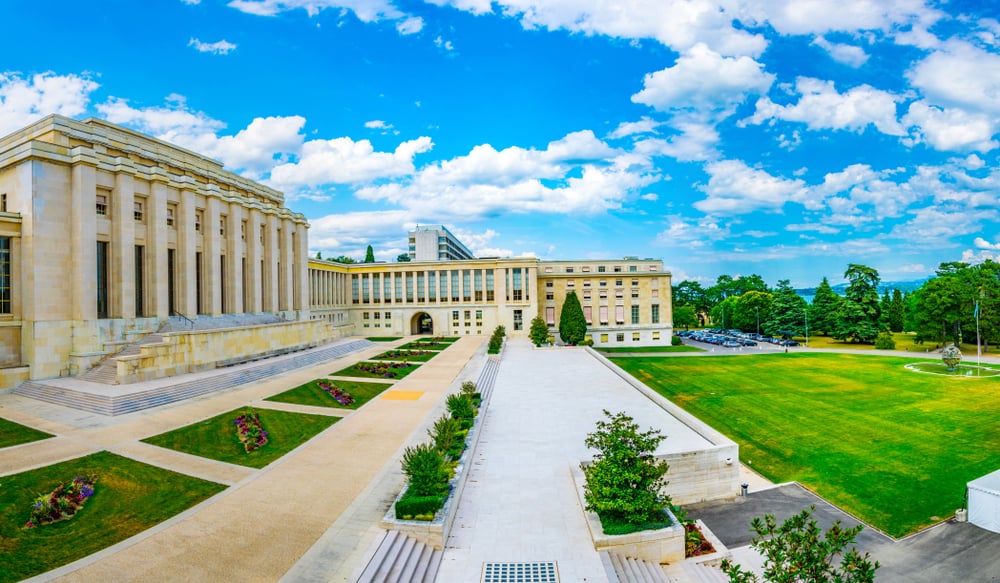
Take a Boat Ride on Lake Geneva
Lake Geneva is the largest lake in Switzerland and in Central Europe. It is also called Lac Leman. Cities and villages line its banks because people just cannot get enough of this paradisical place. For those of us who can only visit, not live here, rest assured that there are plenty of ways to get your fill of the lake. Whether you prefer the more structured boat tours or would rather take a ferry tour so you can choose your own destinations, Lake Geneva is yours to explore.
Experience the Chocolate Flavours Tour
If you are going to do any chocolate experience during your road trip in Switzerland, we highly recommend the Chocolate Flavors Tour . Honestly, we drool a little just thinking about it. It is a walking tour that takes you to five different chocolate factories and patisseries over the course of three hours. It even includes a boat ride! Learn about chocolate and how it is made, eat a lot of chocolate, be one with the chocolate… We know chocolate is not everyone’s thing, but if it is you have got to do the Chocolate Flavors Tour.
Witness Jet D’Eau
The Jet D’Eau is an impressive water fountain in Lake Geneva that shoots straight up into the sky. It was originally designed as a way to relieve water pressure from a hydraulic pumping station but was so spectacular that it soon became its own attraction. Although it was built on the Rhine river, when it became so popular it was moved to Lake Geneva so that it was more easily accessible. The Jet D’Eau will not take too much of your time and is a fun feat of engineering and luck that is easy to witness.
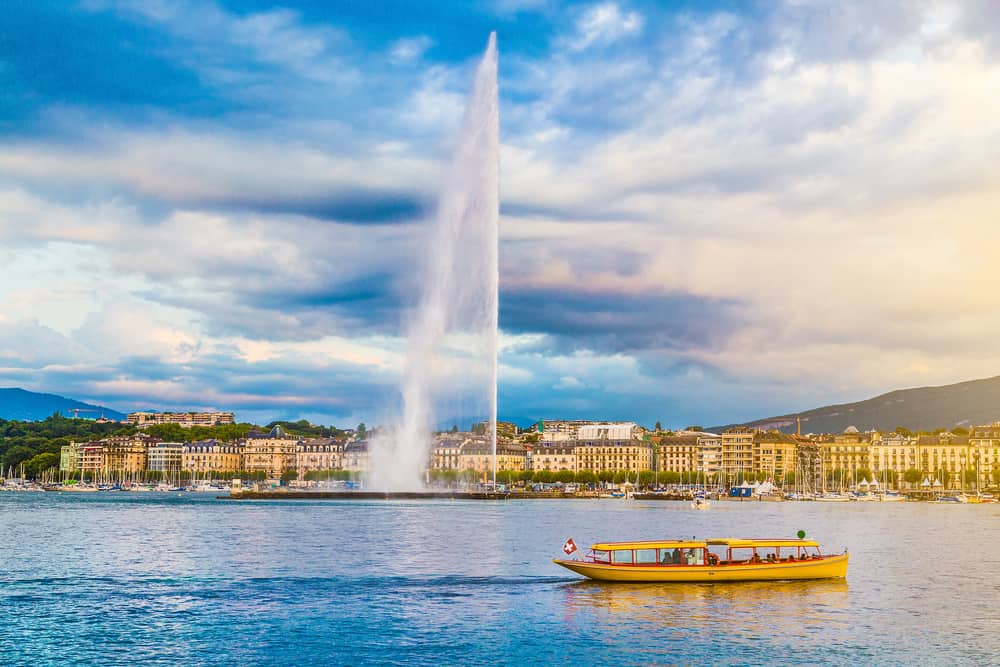
Where to Stay in Geneva
Affordable: Base Nyon Check Rates: booking.com | hotels.com
Mid-Range: Hotel d’Angleterre Check Rates: booking.com | hotels.com
Upscale: Hotel Beau Rivage Geneva Check Rates: booking.com | hotels.com
End by Flying out of Geneva or Zurich
Geneva Airport, otherwise known as Cointrin Airport, is a stellar international airport that is definitely equipped to see you safely home. If you want the convenience of being able to fly directly home after your Switzerland road trip, we recommend Geneva. However, flying out of Zurich offers the ability to do a round trip flight in and out of Zurich. And, Zurich is only a little under three hours away from Geneva. So if you do not mind traveling back, that is definitely an option. Safe travels!
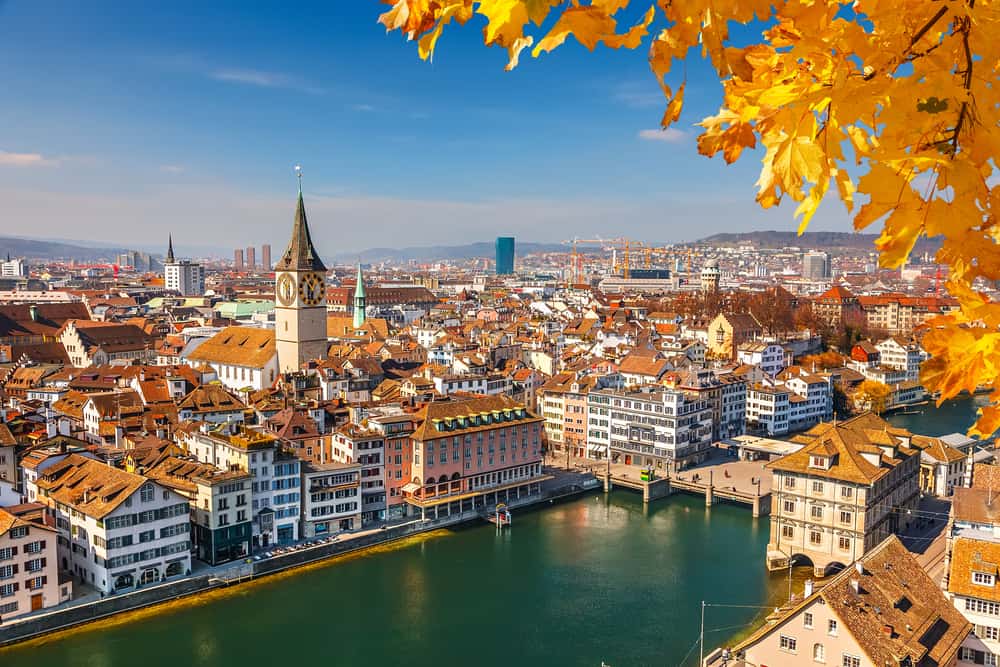
We hope that our Ultimate Switzerland Road Trip Itinerary has been helpful in planning your adventures in Switzerland! There are so many great places to see and experience. You are going to have a great time! Let us know if you visit any of the stops we have listed, and which one was your favorite. We look forward to hearing about your road trip!
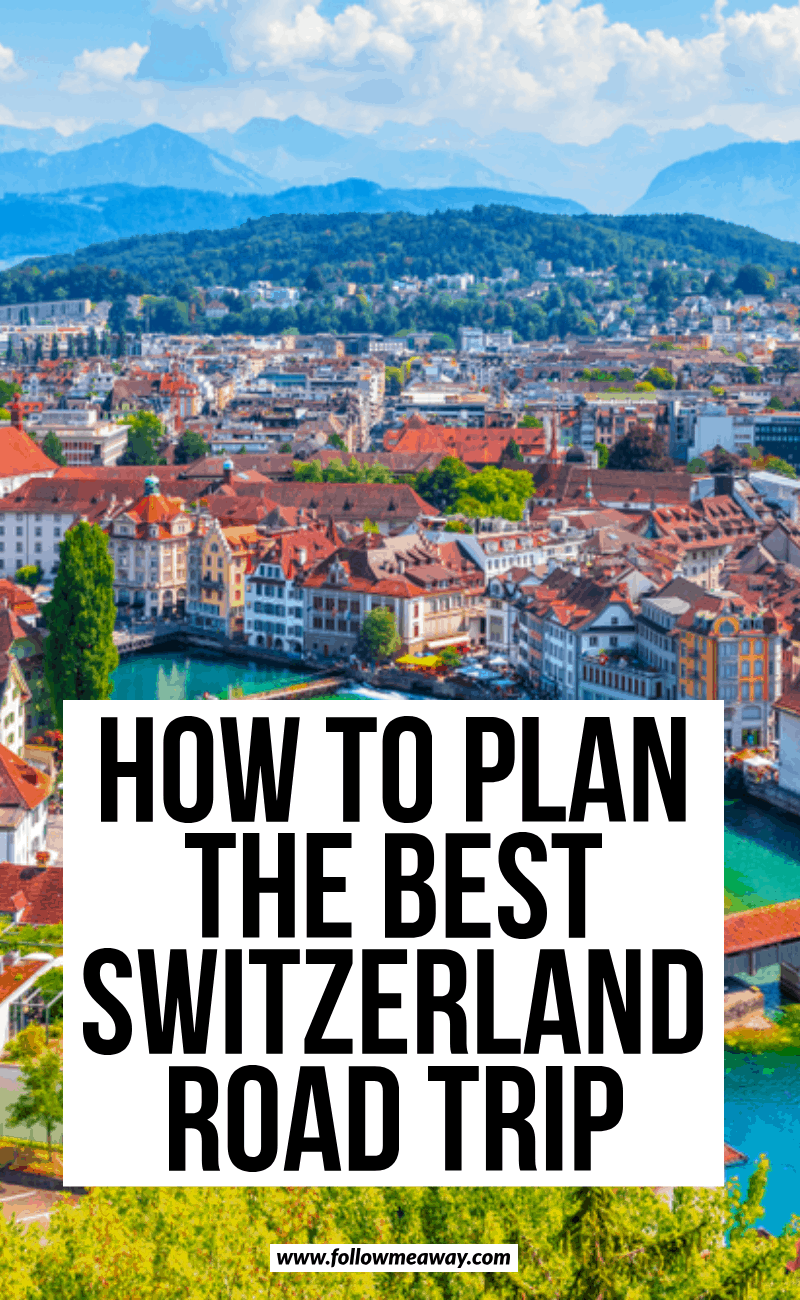
Reader Interactions
March 1, 2020 at 1:15 am
I’ve been looking up Switzerland Itineraries all month and this was the BEST and most helpful one out there. THANK YOU so much!
March 1, 2020 at 4:40 pm
Awwww YAY!!! Lovely to hear that!! Thank you!!
June 16, 2023 at 5:26 am
Hello, love this itinerary. How many days do you need for this specific itinerary?
Leave a Reply Cancel reply
Your email address will not be published. Required fields are marked *
Save my name, email, and website in this browser for the next time I comment.
This site uses Akismet to reduce spam. Learn how your comment data is processed .

Driving in Switzerland: Everything You Need To Know For A Stress-Free Road Trip
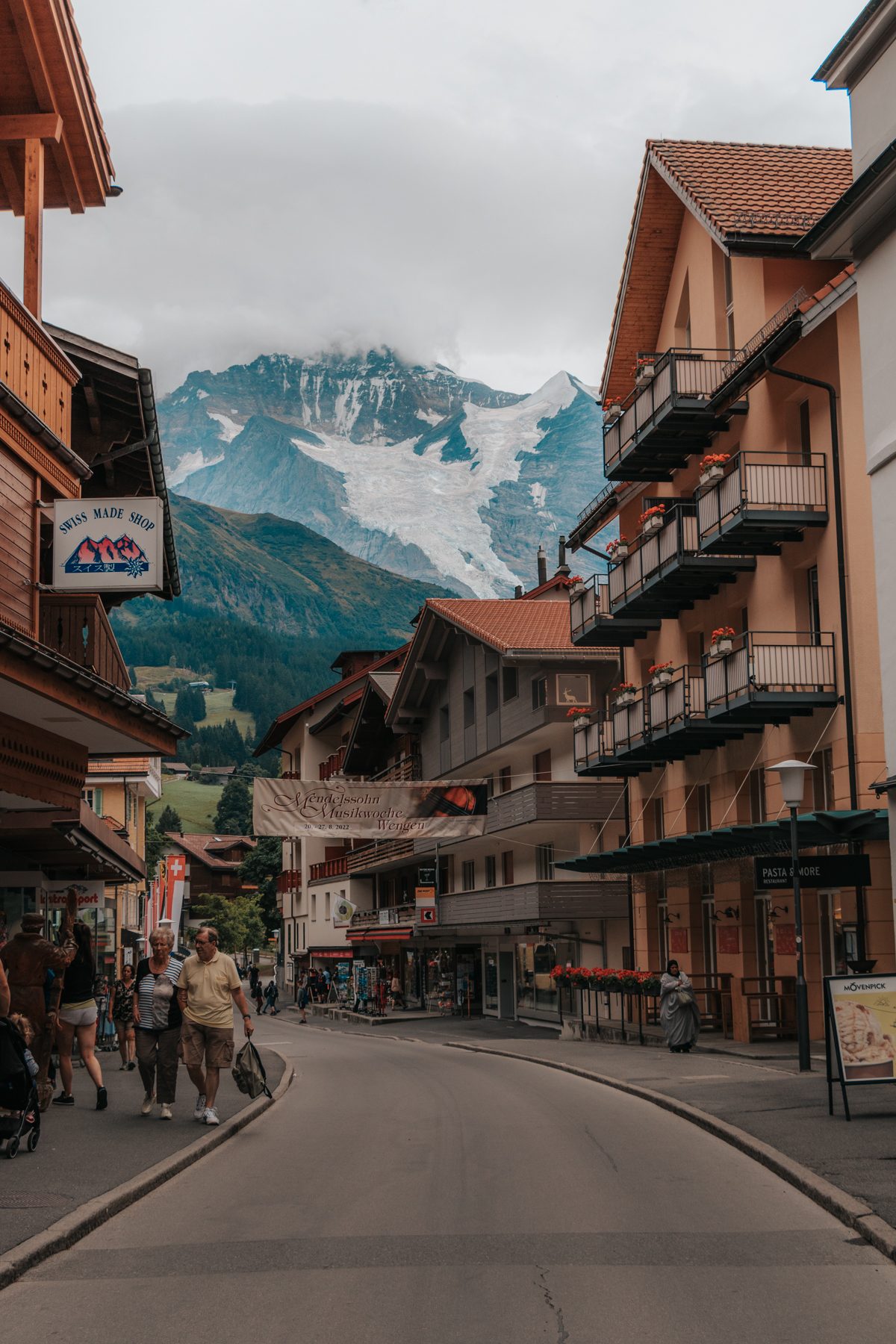
Last Updated on January 7, 2024 by Michela
Road trips are one of the best ways to explore new places, and Switzerland is just one of those countries that must be discovered by car. While the public transport system is very well-connected, the flexibility of having a car allows you to customize your itinerary as you go and easily reach all the best sites, whether it be the peak of mountain passes or the winding roads of remote valleys. Driving in a new country can be intimidating, but this guide has everything you need to know about driving in Switzerland so you can feel confident to explore!
Some of these links are affiliate links. This means if you make a purchase through that link, I receive a small commission at no extra cost to you. Read my full disclosure !
Important Things to Know Before Driving in Switzerland
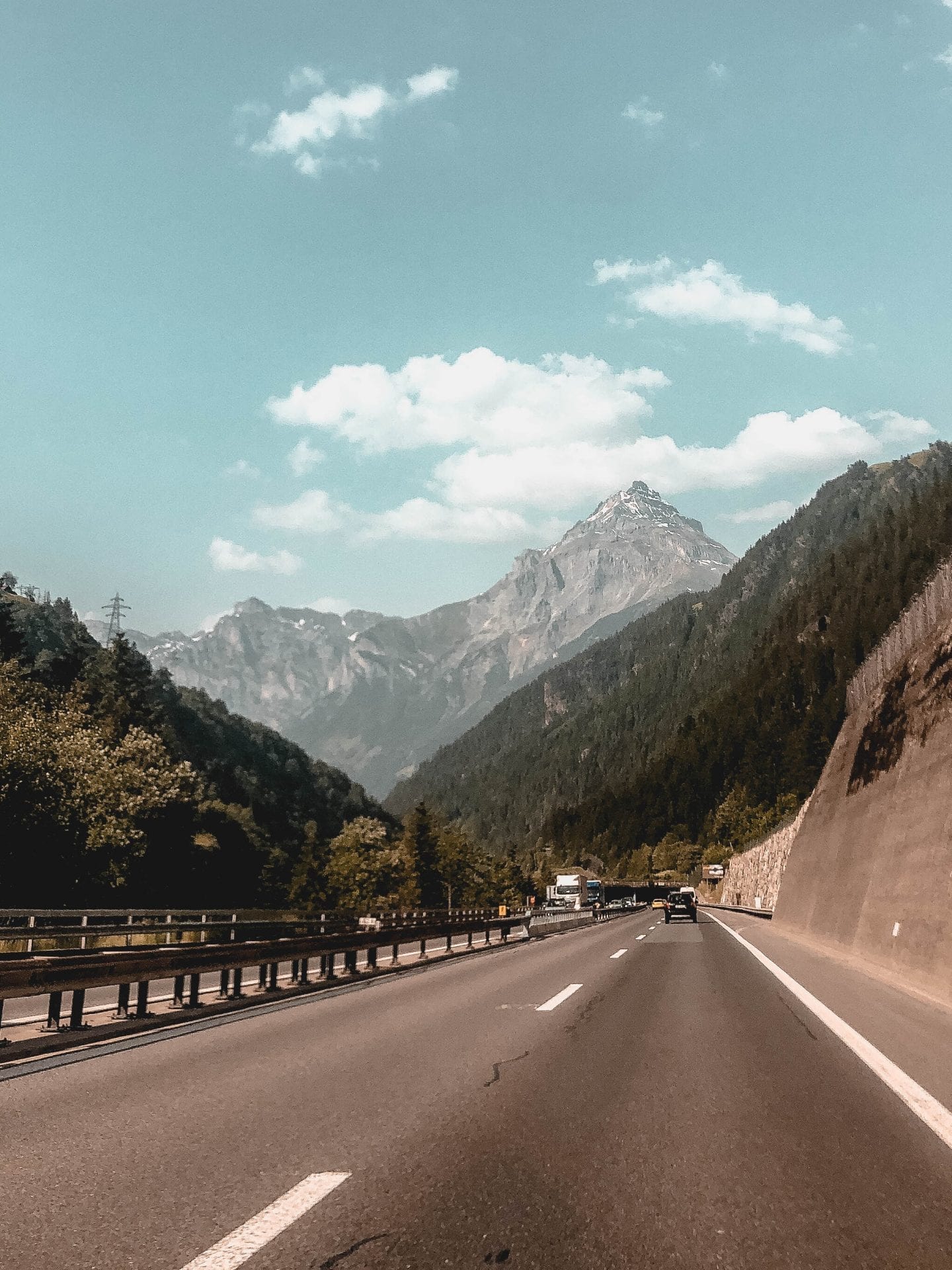
Some of this information may seem obvious, but it’s good to go over the basics. Here are answers to questions you may have about driving in Switzerland.
What side of the road do you drive on in Switzerland?
You drive on the righthand side of the road.
Can tourists drive in Switzerland? What kind of license do you need?
As long as you are 18 years old, you can drive with your valid national driver’s license, along with an International driver’s license , which you will need to drive in most European countries. Discover more from the official article .
Is Switzerland part of the Schengen Area? What is the border control like?
Yes, Switzerland is part of the Schengen agreement. This means, specifically in regards to driving in Switzerland, there are no border patrols between it and its neighboring countries of Italy, France, Germany, Austria, and Liechtenstein. You will still see officers at the border, but they do not perform routine immigration checks.
What are some basic driving rules/traffic regulations in Switzerland?
You can only overpass cars from the left, not the right. Pedestrians and public transportation have the right of way. When entering roundabouts, the vehicles coming from the left have the right of way. Seat belts are mandatory in the front and back seats!
What is the blood alcohol limit in Switzerland?
The blood alcohol content limit is 0.5%.
Do you need a vignette to drive in Switzerland?
Yes, you have to purchase a vignette , required when driving on all Swiss motorways. This sticker goes on the inside corner of your windshield, costs 40 Swiss Francs (CHF) and is valid until the 31st of January the following year.
Can you turn right on red in Switzerland?
Turning right on red is not allowed in Switzerland. Surpassing vehicles on the righthand side is also not allowed.
Renting a Car in Switzerland
Before jumping into more driving rules, it may be helpful to know a few things about renting a car in Switzerland if you are originally flying into Switzerland for your trip.
I always rent with AutoEurope , as I find the best rates on their website which compares car rental companies!
Like most countries and car rental companies, if you are under 25 or 26 years old, there will be an extra fee per day.
Most rental cars will be manual, so make sure to specify if you want an automatic car. They will likely cost a bit more to rent than manual. No matter what car you want, try to book as early as possible for the best deals!
Also keep in mind the size of the vehicle you want to rent. Larger vehicles may be more comfortable to drive on long trips, but they could be difficult to park and take through narrow countryside roads.
Renting a car can be a good way to see Switzerland on a budget . Create an effective road trip budget and save money with this 8 step process.
And download your road trip budget planner from The Travel Library when you subscribe to my newsletter!
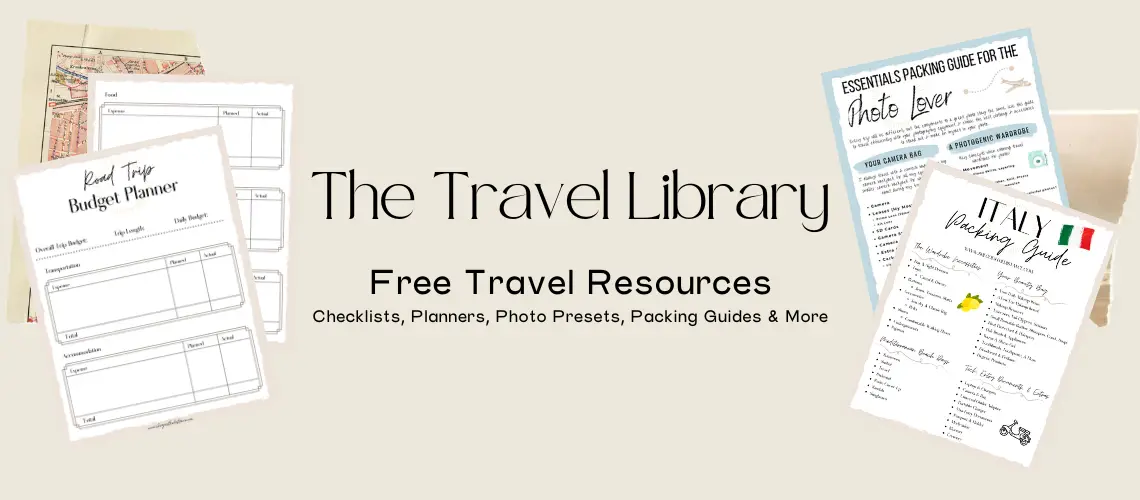
Email address
Vignette in Switzerland
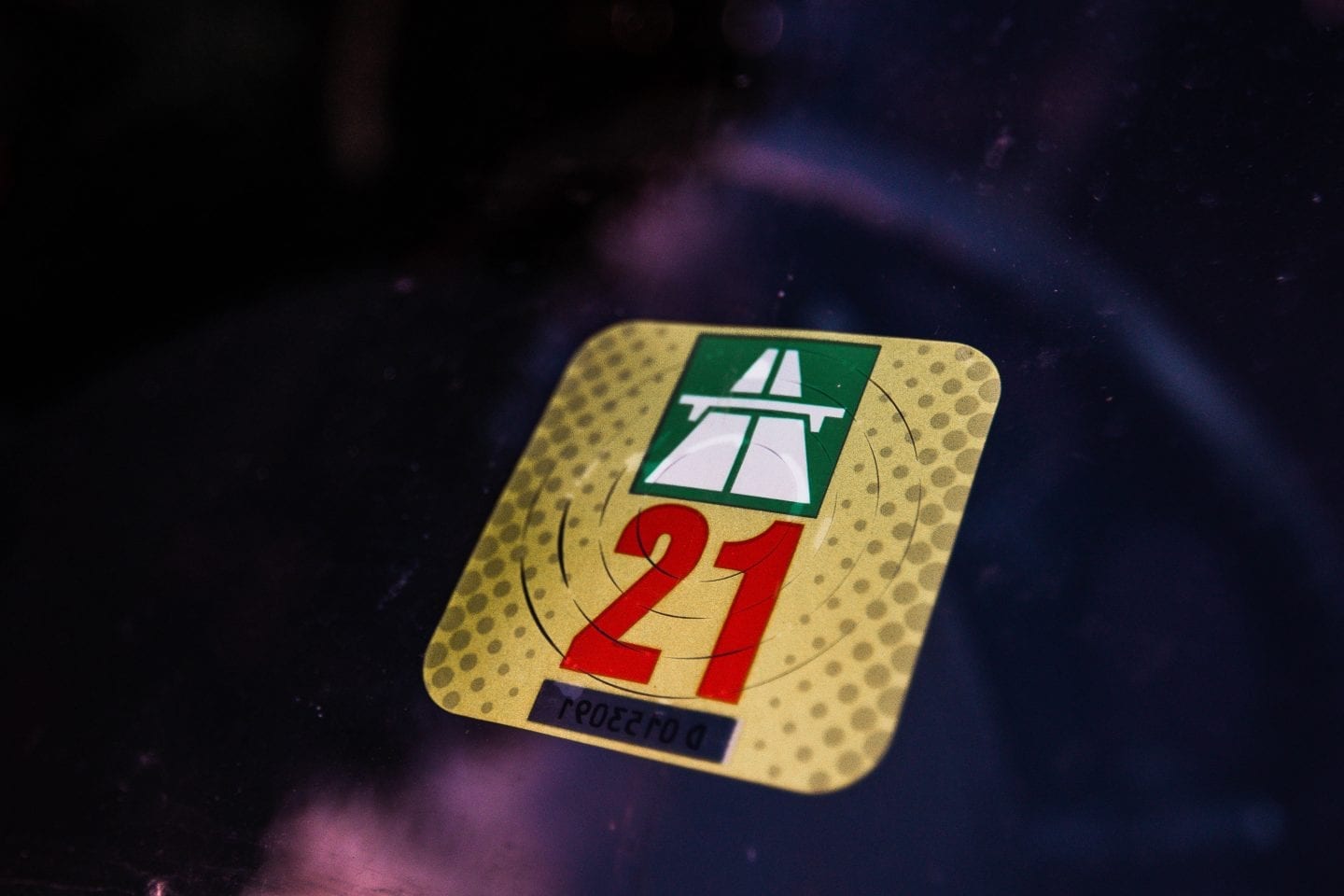
It’s extremely likely your road trip through Switzerland will call for some drive time on the highway. The Alps are not an easy place to navigate, so getting anywhere without the highway will take a significantly longer time as you travel up and over the peaks.
The good thing about Swiss highways: there are no tolls. Yay!
But, you do have to purchase what is called a Vignette , required when driving on all Swiss motorways. This sticker goes on the inside corner of your windshield and permits you to use Swiss highways. It costs 40 Swiss Francs (CHF) and is valid until the 31st of January the following year.
So, technically if you travel through Switzerland for a long time or multiple times, it’s a cost-effective way to drive. However, it’s a necessary evil for those visiting just once who still have to shell out the same 40 CHF, even if they don’t know how much they will be using the highway.
You can purchase the Vignette at any gas station in Switzerland or, for example, the gas stations at the Italian border if you’re coming from that way. It’s also available at customs offices on the borders, post offices, and online .
Road Conditions in Switzerland
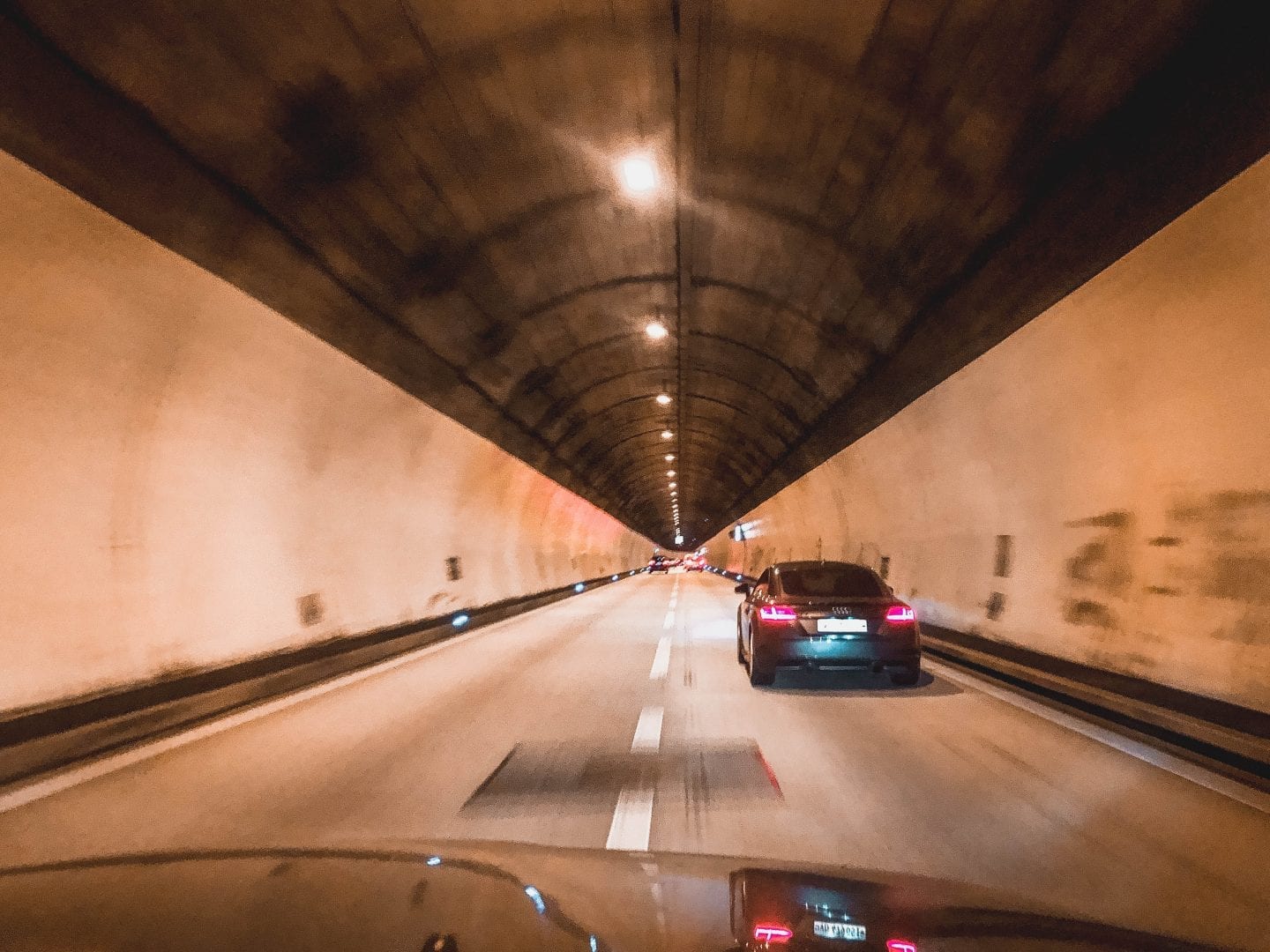
There are a few things to note about the actual roads in Switzerland to help you better prepare for your drives.
Firstly, the streets can be very narrow – even on the highway! The highways are mostly only two lanes, maybe three in places like the bustling surrounding areas of Zurich.
Several times on the highway, the lanes would also split due to construction works. This could get a bit confusing, due to the fact you couldn’t tell if you were being directed to a completely different way, for example, an exit. It’s not the toughest thing to navigate, but it’s something to look out for.
Common throughout the Alps are tunnels – and not just any kind of car tunnels. For example, the Gotthard Pass Tunnel is 17 km long… that’s 10 and a half miles!
Be completely sure you have enough gas to get through long tunnels like that one.
When driving through mountain roads (like the famous Furka Pass or Bernese Oberland ) it’s important to just go slower than usual and avoid passing other cars. You may see locals doing this, but in my opinion, it’s not worth the risk!
Mountain roads will typically be narrow, curvy, and steep, so it also helps to have a vehicle (and a driver) equipped to handle the harsh declines and tight turns.
When it snows, winter tires are not legally necessary, but you do have to put snow chains on your vehicle in zones marked “Mandatory Snow Chains.”
While driving in cities, especially the large city of Zurich, go slow and pay attention to the lines on turns. The ground is full of tram tracks and bus lanes, so you can easily misconstrue where you should be driving.
Cities also have tons of traffic lights, so be attentive and ready to stop and go as you make your way to your preferred parking area. The traffic lights don’t switch straight from red to green – instead, when it’s your turn to go they will go from red to yellow to green.
And to wrap up things you should know about Swiss roads, I hope you love roundabouts – because there are a ton of them! When entering a roundabout, the oncoming traffic already in the roundabout has the right of way. Use your signal when you’re about to exit the roundabout, not when entering.
Speed Limits & Signage
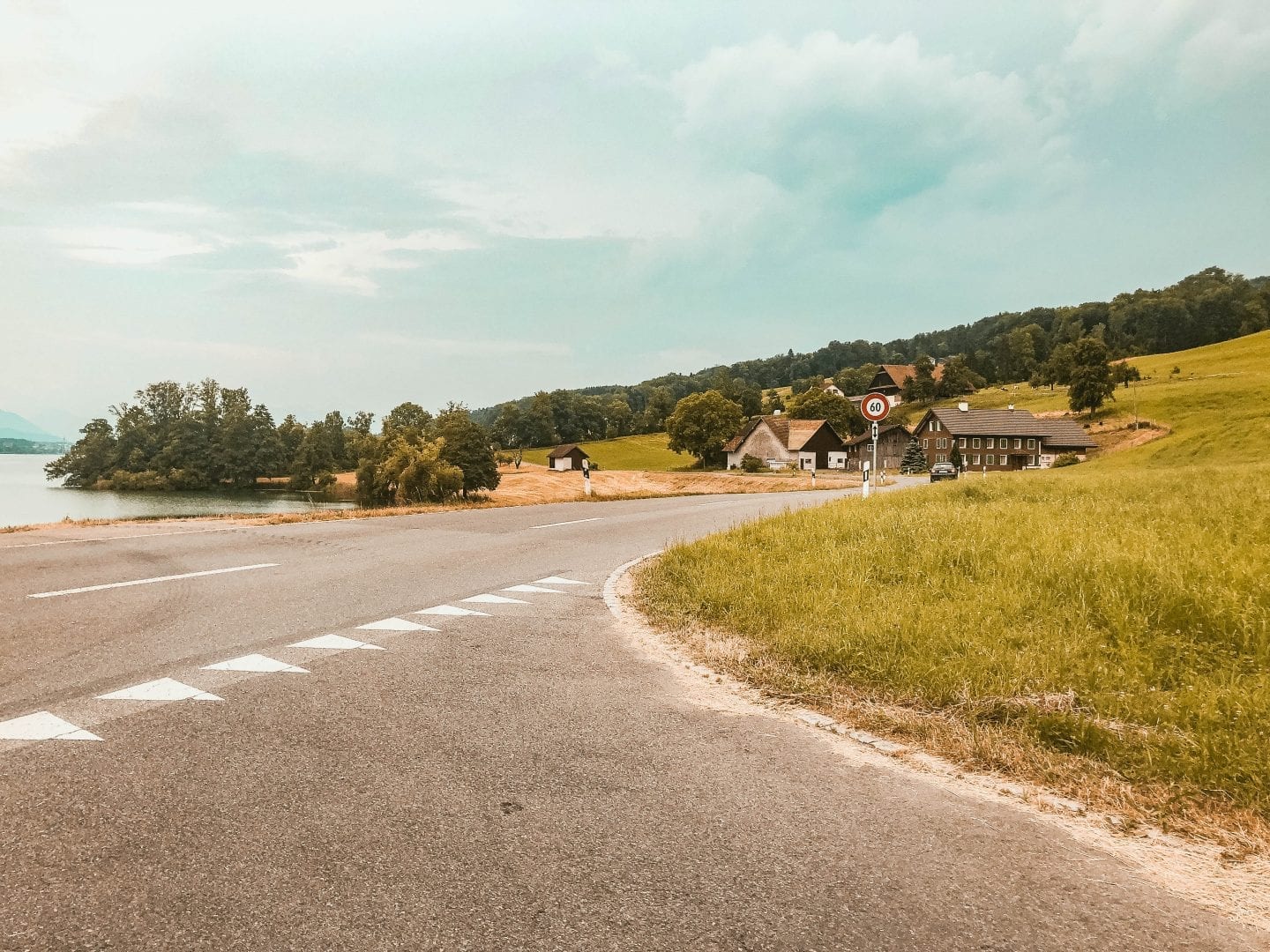
Switzerland is very strict about sticking to the speed limit. However, I personally found there wasn’t a lot of signage between areas, especially in the countryside, to let you know what the speed limit was.
Traffic fines are expensive in Switzerland so, especially in residential areas and towns, drive slower than you think you should!
Switzerland uses the metric system. This means speed limits are in kilometers per hour and distances on road signs are also in kilometers.
In cities, you may find busy intersections confusing in indicating which lanes you were supposed to be in. With bus lanes, tram tracks, and bicycle lanes to avoid, pay extra attention to where you’re heading on your turns.
If you want a complete look at Swiss road signs before you embark, Wikipedia has the ultimate breakdown.
Gas Stations & Prices in Switzerland
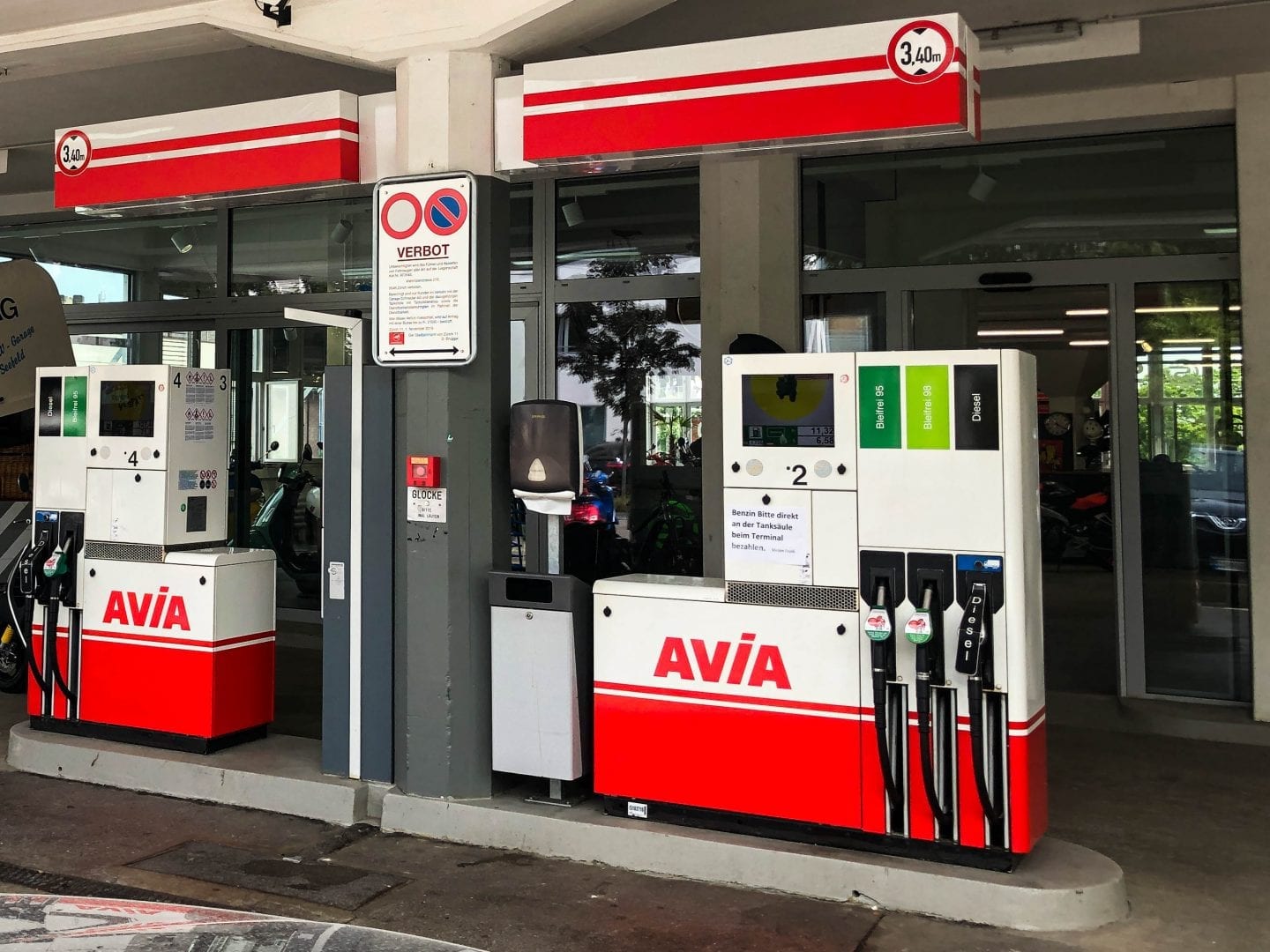
In Europe, the price for gas is calculated per liter. If you’re traveling from the US, a liter is about a quarter of a gallon. So, when you see the prices for gas, don’t get too excited – 1.50 per liter is technically 6 dollars per gallon.
Pro Tip : Utilize Via Michelin , a route planner tool, to calculate how much fuel you’ll use and estimate the total cost for you based on your route and the make and model of your car.
Gas stations on the highway in Switzerland are accommodating. Large parking lots and lots of food options make them great for pitstops. I was often unable to connect to WiFi at gas stations, so have a plan in place for communicating and navigating without it. Plus, you had to pay to use the restroom – so if you don’t have a coin on you, you’re going to have to hold it!
Gas stations in the cities and countryside areas may not always offer food or bathroom amenities. There may just be pumps!
Pro Tip : Our vehicle used partially natural gas or LPG. If your vehicle takes this natural gas, know that LPG stations are few and far between in Switzerland. Plus you need to ensure you have a German standard adapter for it to work.
Parking Practices in Switzerland
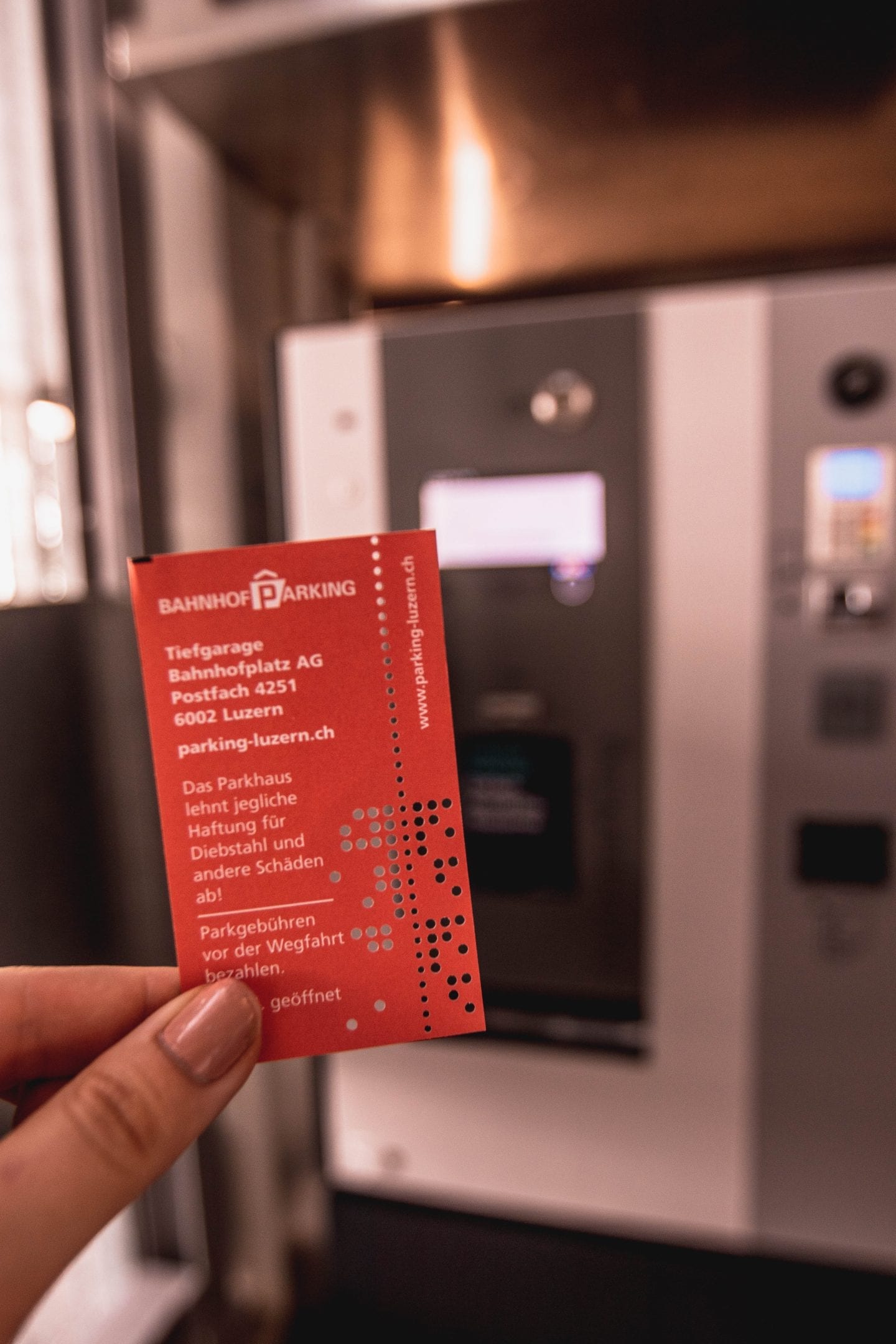
Where Can You Park as a Visitor
Switzerland has a system of colored parking spaces that denote who can park where.
Blue parking spaces are free to park in for up to 90 minutes. However, you must have an EU parking disc (most rental cars will come with one.) With this, you’ll set the time you arrived and place it in the dashboard.
Yellow parking spaces are only for residents.
White parking spaces are metered spaces you can pay to park in.
The easiest places to park in cities, but not always the cheapest, are parking garages. The facilities are clean, although sometimes the parking spaces can be narrow. Typically, you’ll take a ticket at the entrance, keep that ticket with you, and then insert it into a standalone pay machine in the garage before you arrive back at your car. Then, insert the paid ticket as you are leaving.
Parking Prices
In cities, parking can be very expensive. Most parking garages in Zurich, for example, start at 5 CHF per hour.
In smaller cities like Lucerne, parking is a bit cheaper, around 3 CHF per hour.
The SGTD Take & Extra Tips for Driving in Switzerland
I hope this practical guide was packed with helpful information so you can be a little less stressed and a lot more excited for your upcoming trip!
To wrap it up, here’s some extra tips and thoughts to keep in mind to best prepare you for your driving:
- Download offline maps before you start on your route. The free WiFi options never worked with my phone, so don’t rely on them completely for navigation. You could also purchase a SIM card so that you have data while roaming Switzerland through their provider Swisscom, or pay extra on your phone plan to use data internationally.
- Have coins on you to be able to use the restroom at rest stops. Yes, you have to pay to use them!
- Pack snacks from the grocery store because rest stops and gas stations are very expensive places to buy food.
- Take photos of your rental car before you leave the facility so you have your own evidence of what damage/scratches were there before you used the vehicle.
- Do lots of research on parking and car-free zones . A lot of mountains towns actually don’t allow cars at all, so you’ll want to have a plan in place for where to park and how you will get around in these areas.
Last but not least, enjoy the ride! Be spontaneous and make stops at pretty places you see while on the road. The flexibility to adventure however you’d like is the best part about traveling by car!
Have any more questions about driving in Switzerland? Leave a comment and I’ll share more of my personal experiences!
Save these helpful tips to Pinterest!

Don’t forget to enjoy the scenery while driving in Switzerland !
Michela is a travel writer and photographer living in northern Italy. She is passionate about helping people make the most of their travels by sharing advice gained from her personal experiences, off-the-beaten-path destinations and time-saving quick itineraries. Browse her top articles or have her help you plan your itinerary to your dream destination!
Find me on: Web | Instagram
You may also enjoy:
The best guide to visiting abbey of san galgano, tuscany’s oldest …, lake como or lake garda: which one is right for your dream ….
I am handicapped, will my US handicapped placard be able to be used in Switzerland.
Yes, your US placard is valid in Switzerland and EU. You can find more information here at this link: http://www.disabledmotorists.eu/en/world_map/europe/switzerland.htm
I hope that is helpful! Have a wonderful time on your trip!
Very helpful we are taking our motorhome to Grindalwald then onto Zermatt. We have to get onto a train…not sure at the moment where from…would be grateful for any advice…thank you.
Hi Peter, I’m glad you found it helpful! Sounds like an amazing trip!
Zermatt is car-free and the last town you can drive to is Täsch and from there you can take the shuttle train. Here’s the link with more details !
The town of Grindelwald itself is not car-free so you should be able to drive your motorhome through/locate parking & camping. However, many of the surrounding towns like Wengen and Mürren are car-free and you can take a train, shuttle, or walk between those areas! Here is a bit more detailed outline of getting to each of the towns in this area. Just scroll down to where it says how to get to the resorts!
I hope that info and those resources are helpful. If you have any other questions or need more advice, don’t hesitate to let me know! Have an awesome time in Switzerland!
Thanks, Michela, for such an informative article about driving in Switzerland! Do rental cars come with a vignette? Or can the vignette be purchased from the rental car company while renting a car at Zurich airport?
Hi Kaustubh!
Rental cars in Switzerland come with the vignette included. I would still double-check with your rental car company to confirm!
Since it’s included you shouldn’t need this, but just in case, the only other place you can buy the vignette (besides at the border countries with Switzerland) is online at this link .
Hope this helps and have a great trip! 🙂
Thanks, Michela!
Leave a Reply Cancel reply
Your email address will not be published. Required fields are marked *
Save my name, email, and website in this browser for the next time I comment.
Website URL
Sign me up for the newsletter & access to resources from The Travel Library!
JOIN MY FACEBOOK GROUP
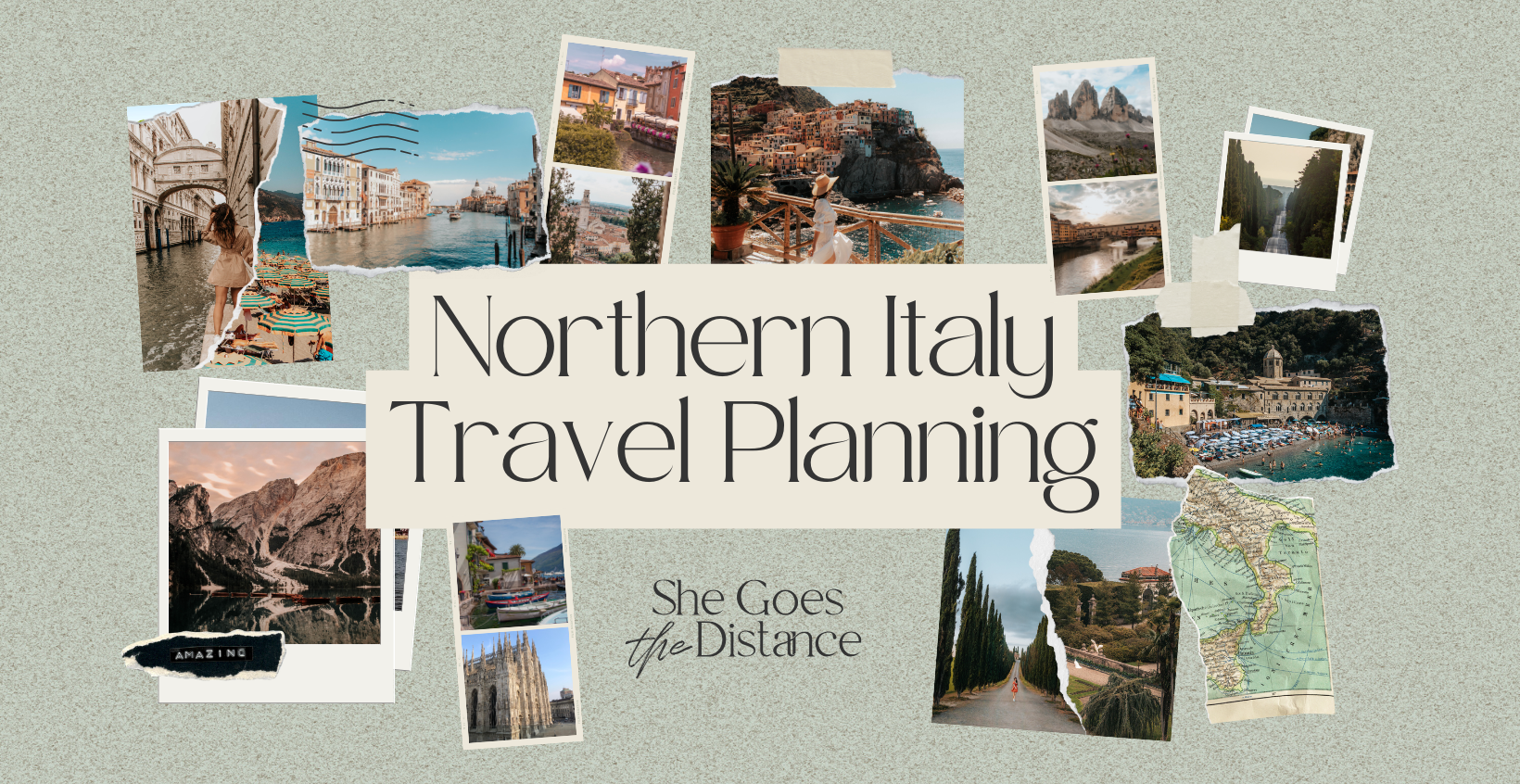
Check this out
- The Travel Library
- Privacy Policy
BUY ME A COFFEE
I love creating free resources for your travels and personally responding to your questions over chat and email.

Planning a trip to Italy?
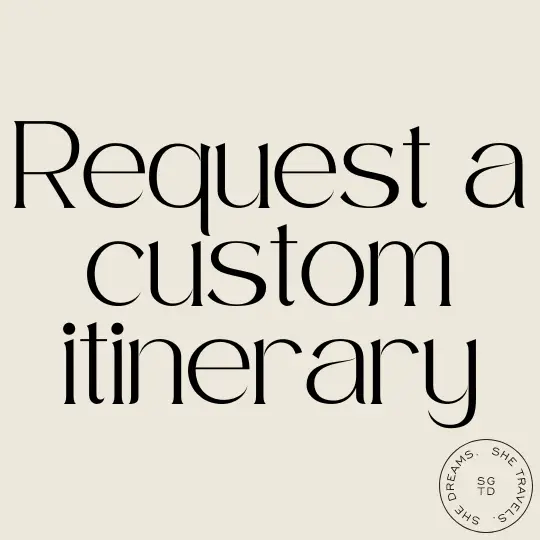
Looking for Something?
Arzo Travels
Solo Female Travel – Switzerland, Europe and Beyond
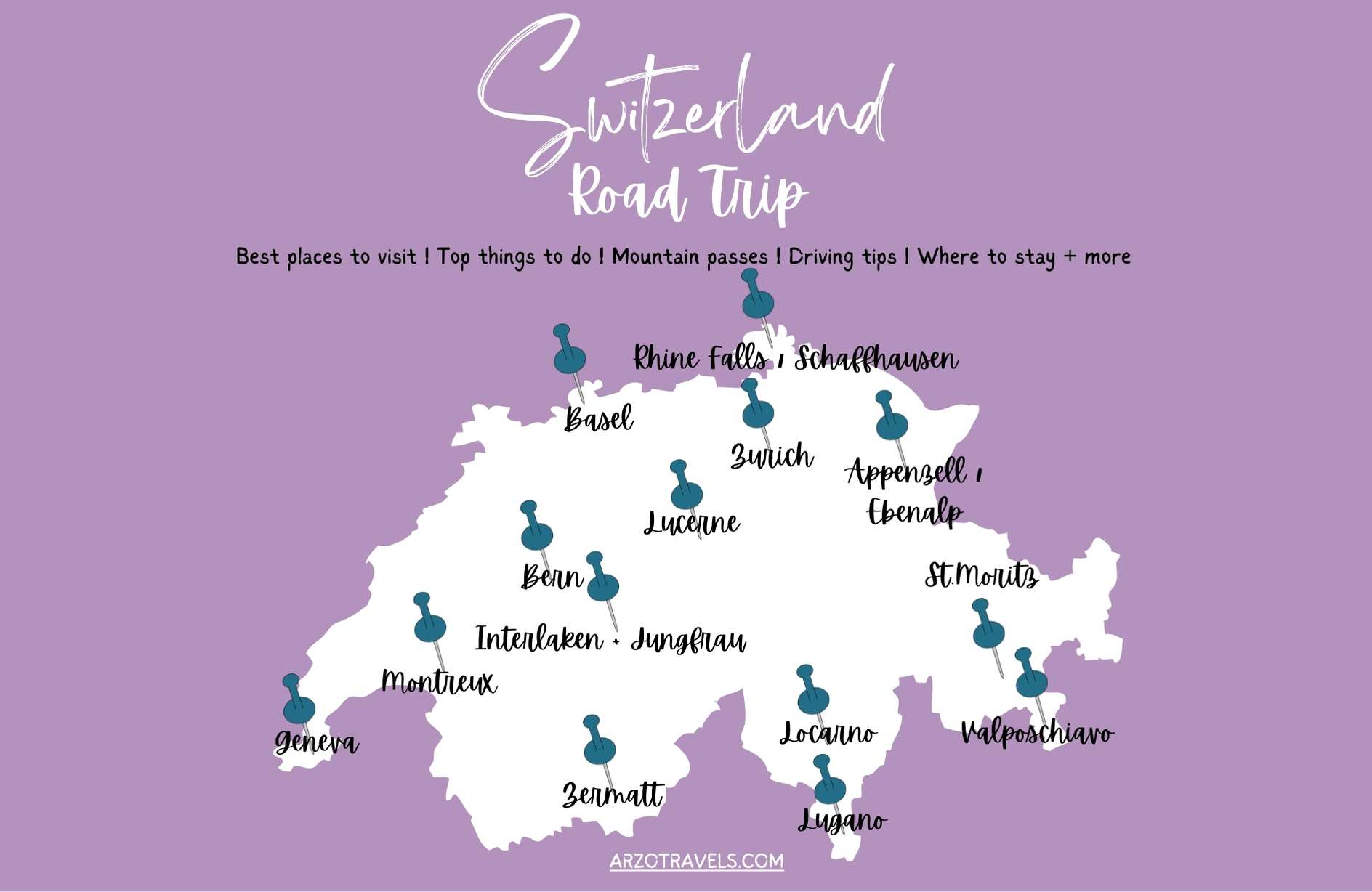
HOW TO PLAN THE BEST SWITZERLAND ROAD TRIP
HOW TO ROAD TRIP IN SWITZERLAND + TRAVEL TIPS
Table of Contents
Tempted to take a Switzerland road trip? Then you’ve come to the right place! As an avid admirer of all things Swiss , I’m here to help . There’s no better way than hitting the open roads and exploring Switzerland by car – marveling at its gorgeous lakes and majestic mountain peaks as you go.
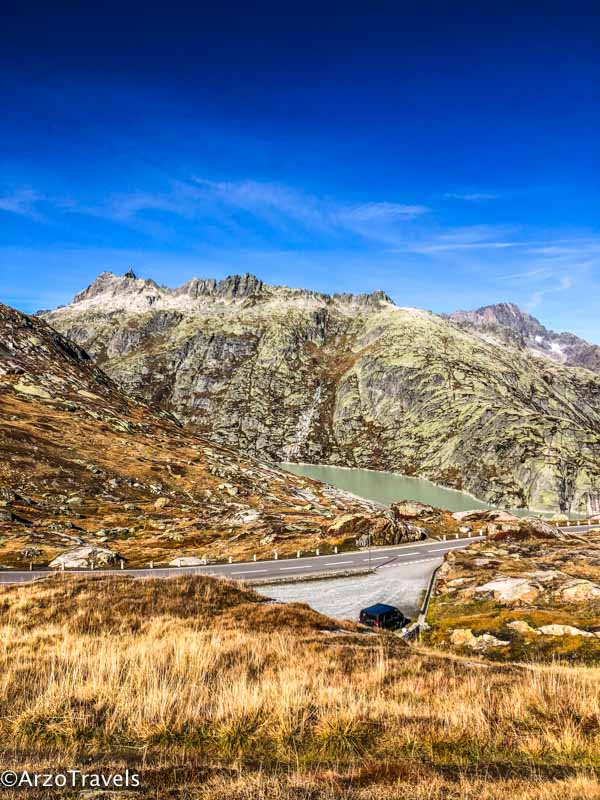
HOW LONG DO I NEED FOR A SWITZERLAND ROAD TRIP?
To visit all the places mentioned in this Switzerland road trip itinerary, you need a minimum of 3 weeks . Don’t worry – even if you visit Switzerland for 5, 7, or 10 days, this post will help get the most out of your trip!
Disclaimer: This post contains affiliate links. This means I might earn a small commission when you buy a product (at no extra cost to you) after clicking on my link. More about it here .
TIPS FOR ROAD TRIPPING SWITZERLAND
Check out the top travel tips to make sure you hit all the best stops, keep from getting lost in foreign lands, and have some fun along the way.

Driving T ips For Your Switzerland Road Trip Itinerary
➡️ You must be 18 years or older to drive in Switzerland. Your driver’s license must be in either English, German, Italian, or French. TIP: Check whether you might need an international driver´s license.
➡️ Watch the speed limit because tickets are costly here. The speed limit for motorways/freeways is 120 kph (kilometers per hour), and highways are 100 kph. In the city it is 50 kph, in the cities in residential areas it is 30 kph, and in rural areas, it is 80 kph. But most of all, keep an eye out for speed signs.
➡️ You have to drive on the right side of the street in Switzerland. Always yield right of way to public transportation and emergency vehicles.
➡️ Be aware of pedestrians and cyclists as well. They are everywhere!
➡️ If you are traveling with children, any that are younger than 18 months should be in a child safety seat ; everyone else needs to use a seatbelt.
➡️ You are required to drive with your lights on , even in the daytime.
➡️ Don’t drink and drive . In Switzerland, the maximum blood alcohol content while driving is 0.05%, which is lower than in many other European countries.
➡️ Gas stations are everywhere – they are all self-service, meaning that you will refill your own gas/diesel. Sometimes there is no person and you have to pay before you refill your gas at a machine, and sometimes you refill your gas and then go inside the gas station and pay at the cashier´s desk (normally in cash or by card).
➡️ Parking can be tricky . Check out my detailed “ driving in Switzerland ” post that helps you find where exactly you can park and what the colored parking spots mean.
➡️ A parking disc is helpful. Depending on the color of the zone in which you are parking, you can park for a certain amount of time at no charge. You can get parking discs at police stations, banks, or tourist offices.
➡️ Most of the time, there are parking machines and you can pay via different apps or credit cards. My tip: Download the app – EasyPark if you have internet in Switzerland. This app is super handy because you can book your parking ticket via the app. There is a small fee but you can extend and end the parking time even if you are not ar your car from a distance. If you do not have internet, then you might be able to pay by credit card or Twint but it is not always the case. Thus, have some coins with you to pay in these cases.
➡️ There is little traffic overall – just in cities like Zurich , Lucerne, or Geneva, you should expect more traffic.
➡️ Some places are car-free – like Zermatt, Mürren, and a very few more areas. In these cases, you need to park your car at the nearest car park and then get there by train/funicular/gondola, etc.
➡️ If you drive to Switzerland in your own car, buy a Swiss Vignette . The toll sticker costs about 40 Swiss Francs and lasts from December to December (so, it is actually good for 14 months). If you rent a car, it will most likely already have a sticker. You can buy them at gas stations, online, or at the border.
➡️ The vignette allows you to use the motorway. You could ditch buying it – and try to avoid it by just using second streets. It will make your life harder though because driving motorways might save you some time. Also, no one wants to deal with Swiss Police if you end up – by mistake – on the motorway.
➡️ If you drive in the mountains, keep in mind that roads can be narrow and windy. Especially in the Italian and French-speaking part, this could be an issue because the drivers, in addition, also tend to speed.
➡️ Roundabouts ! If you are not familiar with roundabouts, make sure to learn about the rules, because there is an abundance of them.
➡️ Wifi in Switzerland will help you to navigate. Even in the mountains, the internet is really good, but every once in a while, it can happen that you will have no reception, so I highly recommend downloading an offline map (Google Maps or the app MapsMe, which I prefer) to make sure to have the best road trip.
Tips For Driving in the Swiss Mountains
Driving in the Swiss mountains can be challenging if you are not used to it. Here are some tips, specifically for driving in the Alps.
- Familiarize yourself with the terrain of the area in which you will be driving, so that you are aware of any tight turns or steep inclines (a GPS helps as you can see sharp turns ahead of time)
- Always check local forecasts as mountain weather can change quickly, and be prepared for inclement conditions.
- Be alert when driving on mountain roads, because of their narrow width and sharp curves.
- Use low gears when driving up steep inclines. This will help to increase your control over the car and reduce brake wear.
- Keep a safe distance between you and other vehicles, as it can be difficult to pass on mountain roads.
- Take breaks when necessary, as driving in the mountains can be physically and mentally taxing.
- Carry a basic emergency kit with you, in case of breakdowns or other unexpected events.
- Make sure that your tires are properly inflated and have sufficient tread before heading out on the road.
- Be aware of any wildlife that may be present in the area and take extra caution when driving near them.
- Also, cyclists, hikers, and other pedestrians are on the road.
- If your vehicle starts to slide downhill, do not press heavily on the brakes; instead, gently engage them until you regain control.
- Have a plan for where you will go should an emergency arise while driving in the mountains. Know your options in case of an accident or breakdown.
Mountain Passes in Switzerland
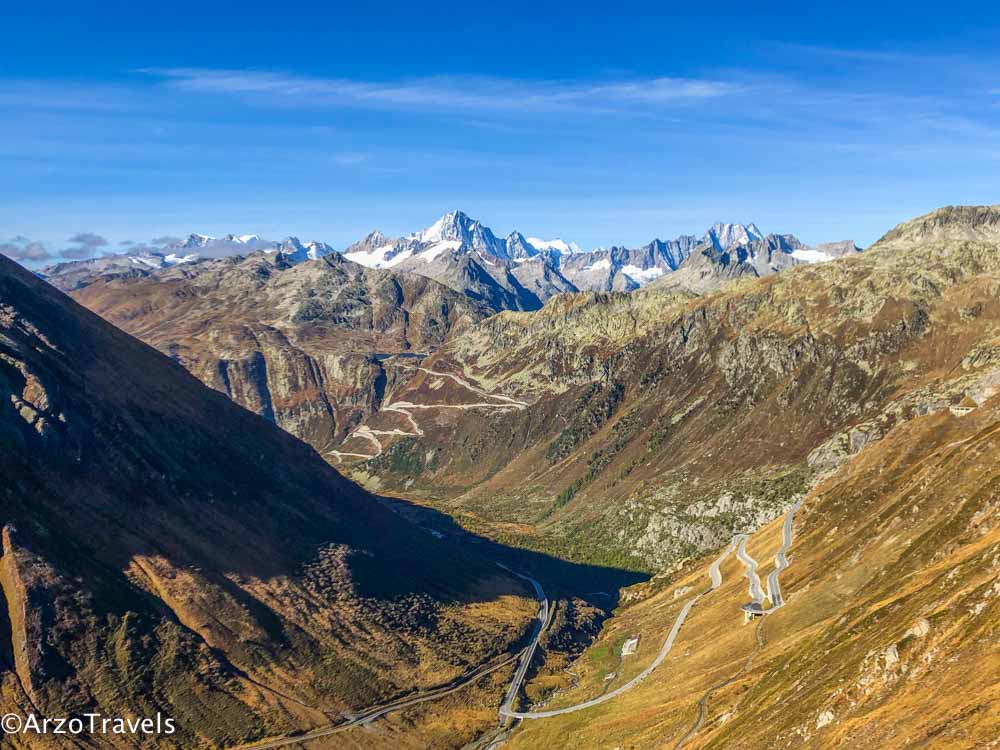
With snow on the ground, some passes will only be open for a certain window or completely closed for months – so make sure to stay ahead with weather forecasts! The awe-inspiring Sustenpass usually opens around June but that can vary depending on rain and other conditions.
I am not ashamed to admit that I had moments when I wanted to cry – just because I was overwhelmed by the beauty of driving in Switzerland and the Swiss Alps.
One day, I will dedicate one post just about the stunning passes, but for now, here are some of my favorite passes (and then we will talk about the main stops for your trip).
- Flüela Pass (2.383 meters above sea level)
- Julier Pass (2.284 meters above sea level)
- Susten Pass (2,224 meters above sea level)
- Brünig Pass (1,008 meters above sea level)
- San Bernardino Pass (2.065 meters above sea level)
- Gotthard Pass (2.106 meters above sea level)
- Albula Pass (2.315 meters above sea level)
- Furka Pass (2.429 meters above sea level)
- Klausen Pass (1.948 meters above sea level)
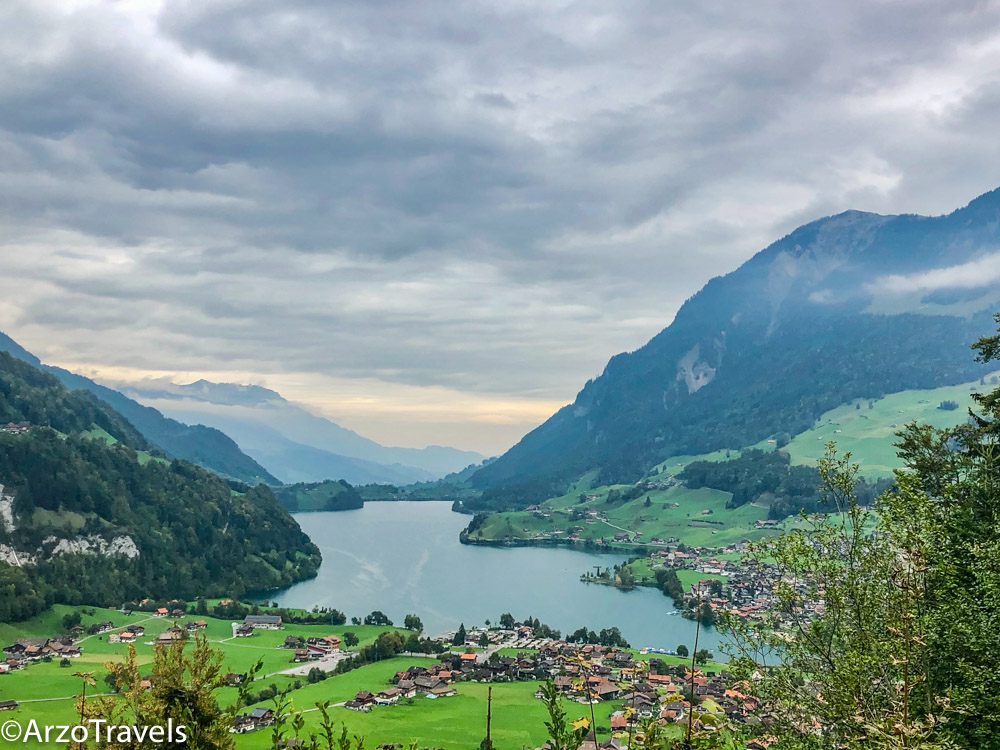
Best Time to Road Trip Switzerland
Summer and early fall in Switzerland is the perfect time to get out on a road trip through Switzerland. From late June until October, you can take your car over nearly every mountain pass and enjoy some gorgeous weather (the occasional rainy day notwithstanding).
So, a summer road trip in Switzerland is like a dream come true. But even in spring, and fall, most Swiss roads are inviting – though some mountain passes are closed, it is pretty easy to get around and explore the country!
Where to Stay When Road-Tripping Switzerland
Check out my detailed guide on where to stay in Switzerland. I will also mention some great places to stay for each destination – and for each budget in this post below.
How to Rent a Car in Switzerland
Discover Cars is the perfect rental company for making sure that when it comes to wheels for exploring this magnificent country, prices won’t break the bank.
Budget For a Switzerland Road Trip
How much a Switzerland road trip will cost depends of course mostly on how long you will road trip, if you have to rent a car, what type of car you have, and how much you will drive.
I am not talking about accommodation, food, and activities but here are some costs/prices.
RENTING A CAR COSTS : If you have to rent a car in Switzerland, you should budget between 50-150 CHF a day (for smaller and medium-sized cars). Plus, I highly suggest having full insurance and not only the basic one that comes with a rental car.
PETROL/DIESEL: Petrol/gas and diesel prices vary in Switzerland – you can expect to pay about 1,90 CHF on average for 1 liter of Diesel, and 1,75 CHF for 1 liter of gas/petrol. With these high gas/diesel prices, it might make sense to rent a smaller car if possible.
TOLL/VIGNETTE: You might have to pay a vignette/toll sticker for Switzerland that is valid for a calendar year (and costs 40 CHF – $44) – if you have a rental car, it might already be included.
PARKING: Parking is not cheap in Switzerland. But, well, what is cheap here? You might find free parking at some tourist spots (especially and mostly for cable car stations outside the town/city center) or along the shores of the lakes etc. but you can expect to pay around 1-2 CHF an hour for outdoor parking. In the evening, often after 7 pm, parking is free in many areas.
BEST STOPS FOR YOUR ROAD TRIP IN SWITZERLAND
Tip: Fly into Zurich Airport because it is the main city in Switzerland and has a major airport. You can start your trip here.
This road trip itinerary is not the exact route of the Grand Tour of Switzerland but includes many stops.
Stop 1: Zurich
Nestled near the sparkling waters of Lake Zurich, discover Switzerland’s biggest city – Zurich!
Okay, Zurich just has 400,000 inhabitants , so we have to be careful when we use the term metropolis – but it is the Swiss version of a metropolis.
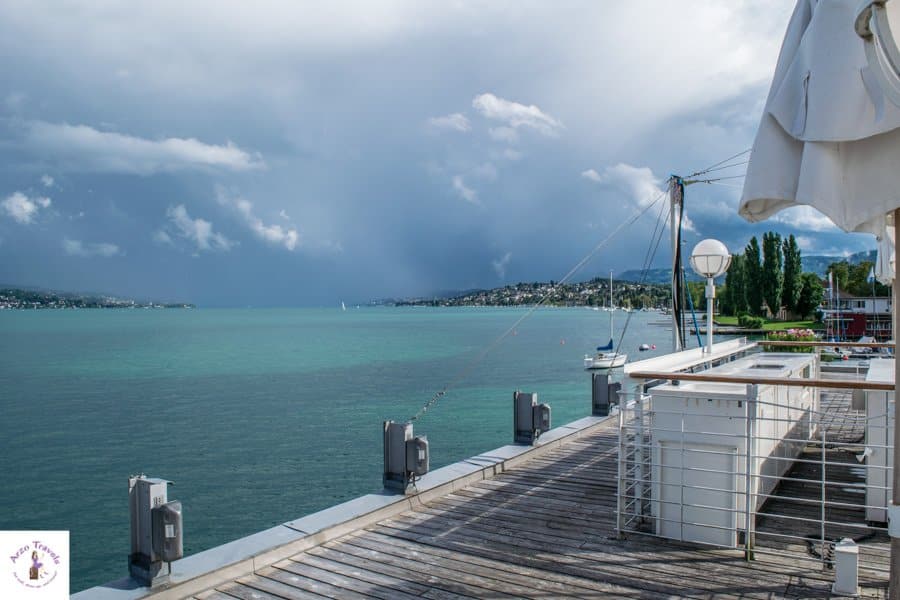
Take a stroll around the city or enjoy some of its top attractions: Lake Zurich, Bahnhofstrasse, Lindenhof Hill, or Uetliberg Mountain . If you’re doing a 7-day tour through Switzerland – why not spend half a day here soaking up all that culture?
Check out my detailed post about this charming Swiss destination .
TIP: Make your adventure to Zurich even easier by taking the train from the airport right into it city center! This will help you with the headache of finding parking spots and being stuck in a traffic jam. The day you leave Zurich and continue your journey, you can rent your car!
🛏️ WHERE TO STAY IN ZURICH
Luxury: Baur au Lac – Zurich has some great luxury hotels that are amazing for getting spoiled and enjoying life. Baur au Lac is one of the best-rated luxury hotels close to the city center.
➡️ Book your stay at Baur au Lac here .
Mid-Range: The Glärnischhof by TRINITY – For more budget-friendly accommodation, check out this 4-star hotel is one of the best-rated mid-range hotels close to the city center, right next to the famous Bahnhofstrasse,
➡️ Book your stay at The Glärnischhof by TRINITY here .
Budget: Oldtown Hostel Otter – There are not many budget hotels in Zurich. This is a good-rated hostel in Zurich. I stayed here once and for a hostel, it actually was quite good – especially because of its great location.
➡️ Book your stay at Oldtown Hostel Otter here .
Stop 2: Stein am Rhein & Schaffhausen & Rhine Falls

And don’t forget about all those beautifully preserved half-timbered houses with their brightly painted facades as they line up along old town streets – what a sight to see!
Check out my Stein am Rhein guide for more travel info.
- TIP: If you have more time, you can also combine the trip with visiting the Rhine Falls and Schaffhausen in one day.
- It is easy to drive to Stein am Rhine. Park your car outside the town center and walk a few minutes to the city center.
Schaffhausen is a small village in Switzerland located very close to the Rhine Falls, along the upper Rhine River near the German border.
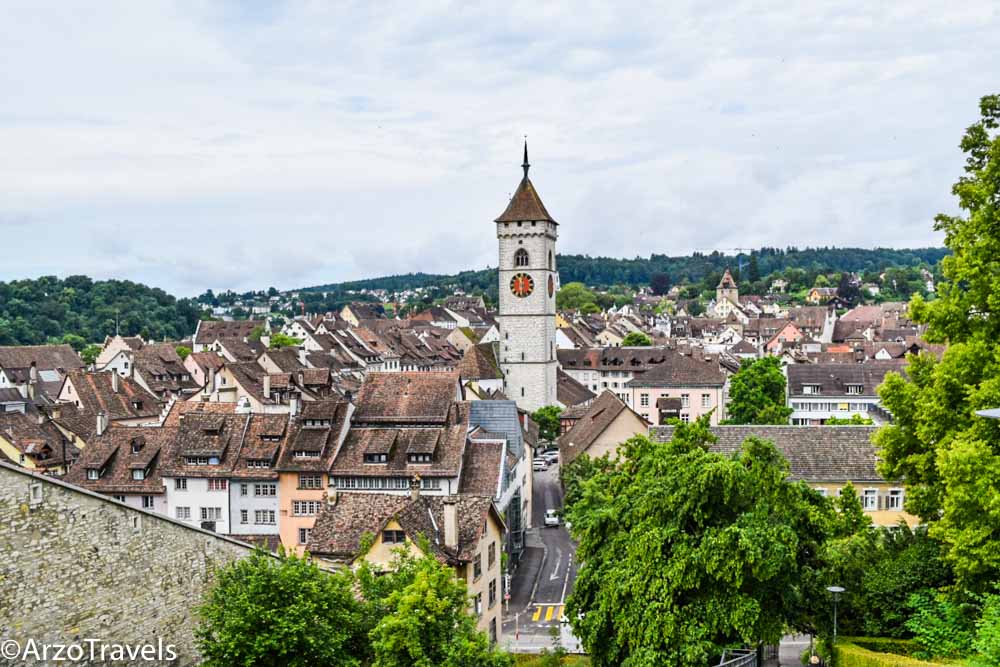
Not to mention, you’ll find plenty of historic sites like the 16th-century Munot Fortress and St. Johann Church – plus an incredible Romanesque cathedral at Kloster Allerheiligen monastery.
But don’t miss out on the enchanting vineyards that give this place its unique character and charm!
- Tip : Schaffhausen and Stein am Rhine are both lovely towns, but if you’re determined to get the most out of your day – might be worth skipping one! After all, those majestic Rhine Falls can’t wait for you! Just don’t forget that camera 📸.
See Europe ‘s most majestic spectacle – the Rhine Falls ! Located near Germany , these powerful falls are a sight to behold during May and June when their waters reach peak levels.
Guaranteed to leave you in awe with its beauty regardless of the travel months though, this is something no one should miss out on.
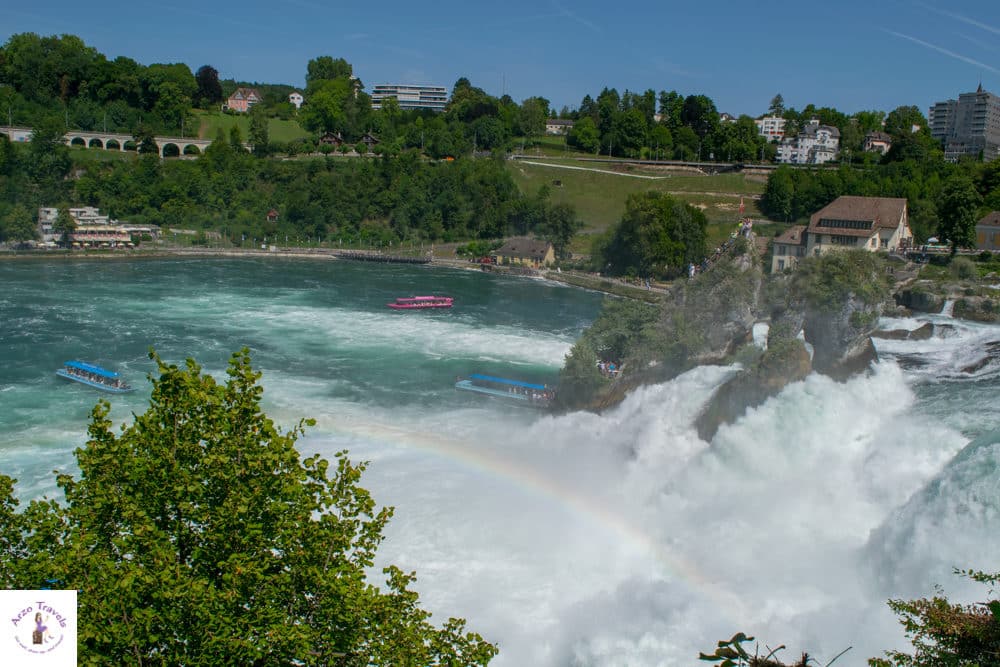
With towering cliffs, measuring an average of 23 meters high and spanning a whopping 150 meters wide, this natural wonder is sure to amaze. Hop on a boat while you’re there – they provide unbelievable views as well as insight into its special history.
Check out my more detailed guide on the Rhine Falls.
- TIP : From Zurich, you can do a day trip and easily get to the Rhine Falls by car.
Stop 3: Basel
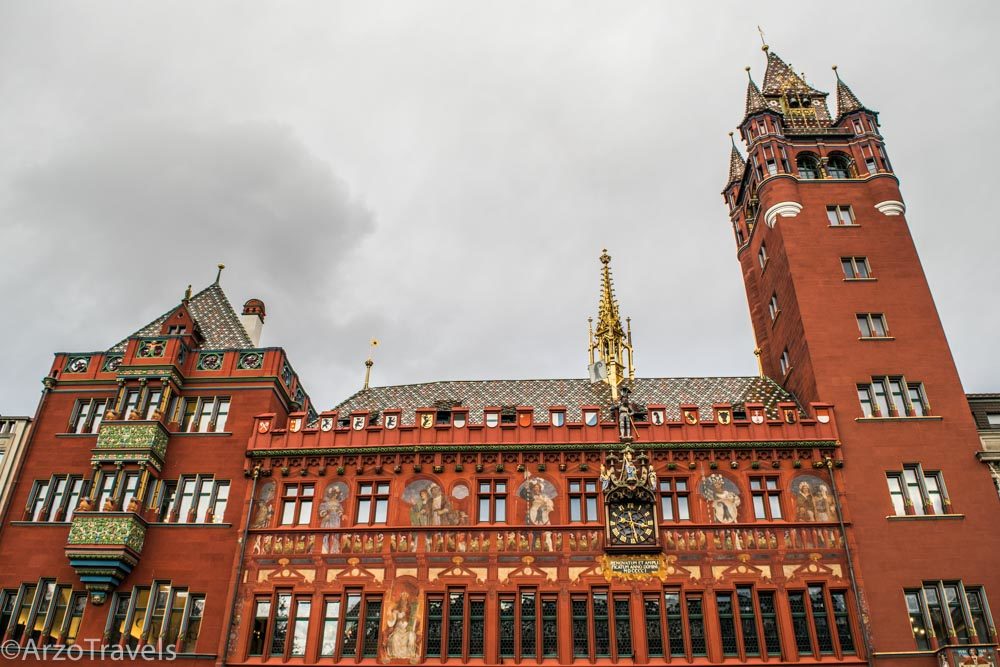
Basel is a living throwback to medieval times! You’ll love the 16th-century Town Hall in its huge red sandstone center and the 12th-century Gothic cathedral.
But if you’re more into art than history, Basel got that too: Basel’s overflowing with galleries just waiting for your visit.
TIP: After all the praise of Basel, I have to add a thing: If you only have a one-week Switzerland road trip, skip the art galleries of Basel and opt for something more traditionally Swiss instead – like taking in some breathtaking mountain views or discovering charming villages!
Check out my Basel itinerary for more travel tips.
🛏️ WHERE TO STAY IN BASEL
Luxury – Grand Hotel Les Trois Rois – For the most luxurious stay, check out rates and prices at Grand Hotel Les Trois Rois, which is centrally located and one of the city’s best hotels.
➡️ Find out about the rates here.
Mid-Range – Hyperion Hotel – I stayed at the Hyperion Hotel , which is very well-known for its great views. It is located in Kleinbasel, and the tram station is just in front of the hotel. The hotel was great: good breakfast, a good location, and a modern style.
➡️ Find out more about the hotel here.
Budget in Basel – We all know that there are no real bargains when it comes to accommodations in Switzerland. Hostels, where you could also book private rooms are my recommendations in this case.
➡️ Check out budget hotels and hostels here.
Stop 4: Bern
Bern – the city where the river flows and beauty abounds! Located on a bend of the majestic Aare River, I consider Bern Europe’s most beautiful capital.
It’s also conveniently located for travelers looking to explore all that this amazing country has to offer.

If you visit Bern during your road trip, check out my 1-day itinerary.
🛏️ WHERE TO STAY IN BERN
If you can, book your hotel in the old town. From there, you can get to all (or most) attractions in Bern within minutes.
Luxury – Bellevue Palace – Bellevue Palace is a 5-star hotel and centrally located – the perfect choice for those who like to indulge in luxury.
➡️ Check out rates here.
Mid-Range – Goldener Schlüssel – I stayed at the 3-star hotel Goldener Schlüssel, located in the city center/old town. Though my hotel room was pretty small, with no direct (and free) parking options and the breakfast was simple, the location was perfect and made up for it.
Budget – Bern Youth Hostel – Bern Youth Hostel is located in the city center and it offers affordable dorm beds but also private rooms with private bathrooms.
➡️ Check out rates here .
Stop 5: Lucerne
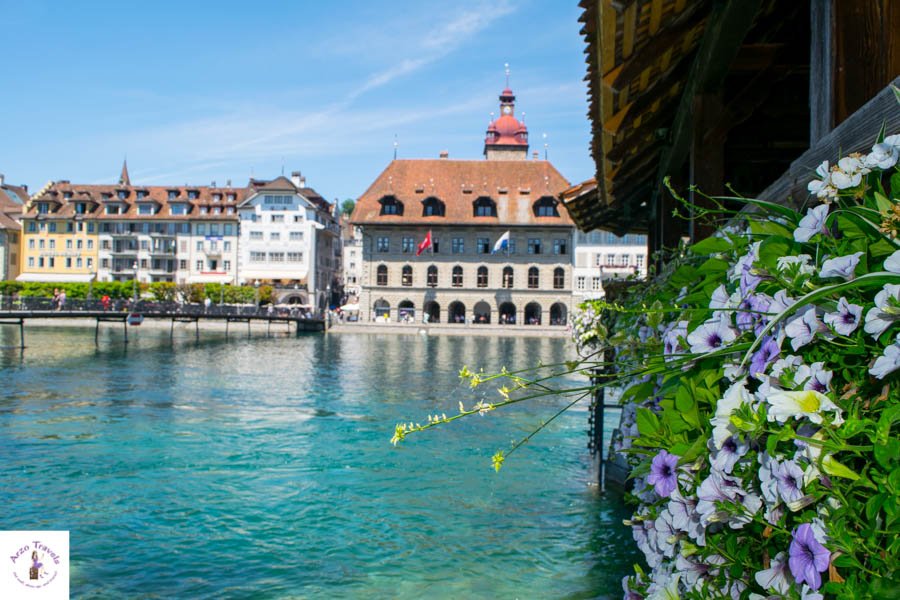
This quaint Swiss city is full of surprises – from the 14th-century rampart Musegg Wall to picturesque attractions like Chapel Bridge, Spreuer Bridg e, and Lion Monument .
And let us not forget about its panoramic views – get ready to witness some truly breathtaking snow-capped mountains when you visit Lake Lucerne. If relaxation is on your mind then head out towards Weggis ; this secret spot promises peace & tranquility as well as fantastic opportunities for swimming in the lake or simply enjoying stunning vistas!
The Axenroad is an absolute must-see when visiting Lucerne! Cruise along the scenic route, taking in spectacular lake views and lush greenery. Make sure to take a detour all the way to Vitznau!
Lucerne should be on your Switzerland road trip itinerary whether you plan a 5, 7, or 14-day trip. With less than 7 days, 1 day in Lucerne is probably a good amount to visit.
Check out my detailed Lucerne guide.
🛏️ WHERE TO STAY IN LUCERNE
I have stayed at several hotels in Lucerne, and here are some tips.
Luxury: Schweizerhof Lucerne – If you want to book a luxury hotel in Lucerne, I recommend this beautiful 5* hotel.
➡️ Book your stay at Schweizerhof Lucerne here.
Mid-Range: Hotel des Alpes – On my last Lucerne trip, I stayed at Hotel des Alpes. The room view was amazing (and included views of the Chapel Bridge and Mount Pilatus).
Budget: The Bed + Breakfast – If you want to stay in a budget hotel, have a look at this B&B. Some rooms have a shared bathroom, and some have a private one.
➡️ Check out prices here.
Click here to read my full post on the best hotels in Lucerne.
Here are more tips on the best places to stay in Lucerne.
Stop 6: Interlaken

Get ready to drive the perfect Swiss road trip and take in stunning views of emerald-colored Lake Thun .
And don’t forget about magnificent Lake Brienz where there are plenty of picturesque villages along its shores waiting to be discovered – what could be more perfect? Whether you love hiking or skiing in the winter (or any other outdoor sport!), this spot has something special just for you.
From the magical wonders of St.Beatus Caves to the majestic city of Thun , and beautiful Spiez – the regions of Interlaken/Jungfrau have it all!

- TIP : For the best window view, make sure your wheels are taking a scenic detour – when driving along the northern shores of Lake Thun (pass Beatenberg or Sigriswil you have the best views over Lake Thun.
If exploring every nook & cranny of this area sounds like your thing (which trust me – it should!), you should stay several months. But, realistically, say 4 days presents itself as an absolute must. Here are some tips on how to plan your Interlaken itinerary.
- Check out my guide with the 50 best things to do in Interlaken.
🛏️ WHERE TO STAY IN INTERLAKEN:
Luxury: Victoria Jungfrau Grand Hotel & Spa – The most luxurious hotel in Interlaken is the Victoria Jungfrau Grand Hotel & Spa. I have not stayed there myself, so I can only repeat what I heard: This hotel is amazing and located right in the heart of Interlaken. If you are looking for a fancy place in Interlaken, this is probably the best pick.
➡️ Book your stay at Victoria Jungfrau Grand Hotel & Spa here.
Mid-Range: Hotel du Nord – For your stay in Interlaken, I recommend this hotel – Hotel du Nord – which is centrally located and is quite nice. It is one of my favorite accommodations for your 5-day Swiss itinerary.
➡️ Book your stay at Hotel du Nord here .
Budget: Backpackers Villa Sonnenhof – If you are on a budget, I recommend staying in Backpackers Villa Sonnenhof next to the Höhenmatte. It is not the cheapest hostel but definitely worth the money and one of my all-time favorite hostels.
➡️ Book your stay at Backpackers Villa Sonnenhof here .
Stop 7: Montreux
Montreux – nestled along the northern shores of beautiful Lake Geneva. From its jaw-dropping alpine views to captivating attractions, this Swiss village has everything a traveler could ever dream of!
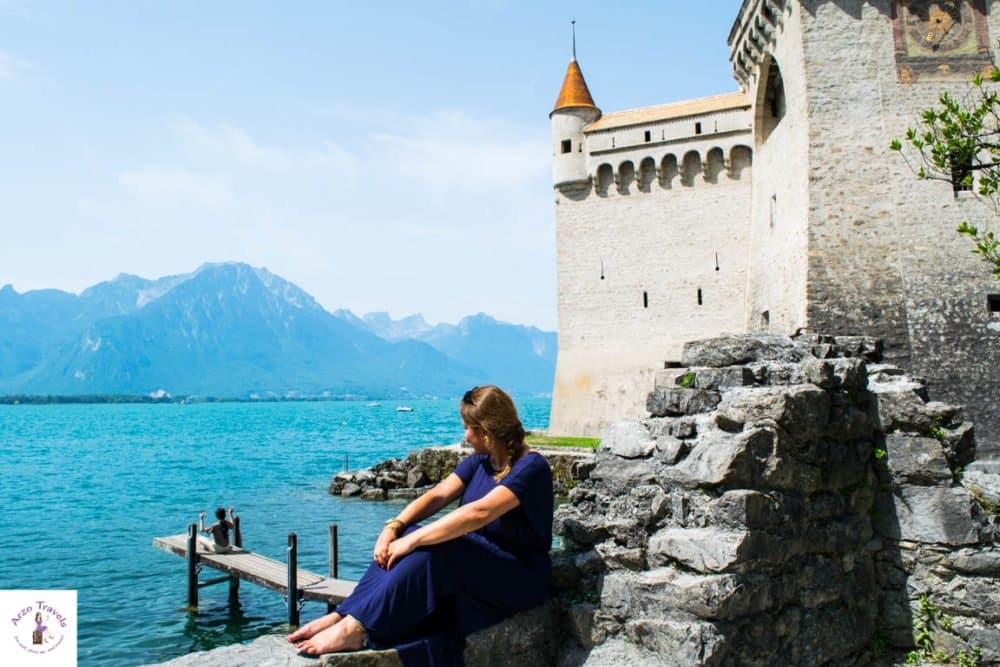
Stunning vineyards , majestic castles – the renowned Chateau de Chillon – plus flowery promenades , trees everywhere…And don’t forget to say ‘hello’ to the Freddie Mercury statue while you’re at it.
Don’t miss out on Lake Geneva views that you can see from this beautiful Swiss town. Make sure you give yourself at least 1 day in Montreux.
🛏️ WHERE TO STAY IN MONTREUX
Luxury – Fairmont Le Montreux Palace – For one of the most luxurious experiences in Montreux, check out Fairmont Le Montreux Palace. This 5-star hotel has a great location and is best known amongst those who like to indulge.
➡️ Book your stay at Fairmont Le Montreux Palace here.
Mid-Range – Eurotel Montreux – As mentioned above, I stayed at the lovely 4-star hotel Eurotel Montreux – I was more than happy with my choice.
➡️ Book your stay at Eurotel Montreux here
Budget in Montreux – Okay, there are not really budget-friendly hotels in Montreux. Accommodation around Lake Geneva is just pretty expensive.
➡️ Book your budget-friendly hotel in Montreux here.
Stop 8: Geneva
Nestled at the southern end of beautiful Lake Geneva , this charming city oozes history and style. It’s a great place to experience breathtakingly scenic views, and important diplomatic activities – and get yourself an iconic timepiece at one of its famous watch shops!

Home to both the United Nations and the International Committee of the Red Cross (ICRC), Geneva reigns internationally for its enviable culture and financial prowess… but not necessarily worth visiting if you’re doing a short Swiss road trip.
Though I personally love Geneva, it is not a must-see if you stay in Switzerland for, let´s say, 3 weeks.
🛏️ WHERE TO STAY IN GENEVA
Luxury: Les Armures Hotel Nestled in the heart of Geneva’s old town, the Les Armures Hotel occupies a unique 17th-century building that exudes historic charm and character. This boutique hotel offers guests a one-of-a-kind experience, blending luxurious accommodations with fine dining in an unpretentious setting.
➡️ BOOK YOUR STAY AT LES ARMURES HOTEL HERE
Mid-Range – N’vY Manotel There are some stunning hotels close to all the main attractions that won’t break the bank. My personal favorite is N’vY Manotel – a colorful hotel located close to the shores of Lake Geneva and the old town.
➡️ BOOK YOUR STAY AT N´V`Y MANOTEL HERE
Stop 9: Zermatt

Get your fill of hiking and skiing year-round at Klein Matterhorn (Glacier Paradise) and Gornergrat. In the summer months, Zermatt is an amazing place for some epic hikes.
Plus, enjoy all that downtown Bahnhofstrasse has to offer with its collection of restaurants, hotels, boutiques – even outdoor skating rinks during winter months and places devoted to apres-ski in winter in Zermatt.
Leave the car behind in Taesch as no cars are allowed on this remote getaway spot. Just hop on board a train instead. Plan 1 or 2 days here depending on how much time you have in Switzerland – don’t miss out if possible… Zermatt is beautiful and makes a good stop on any Switzerland road trip itinerary.
🛏️ WHERE TO STAY IN ZERMATT
Zermatt takes luxury to the next level – even for Switzerland, a country known for its extravagance! If you’re looking to take your vacation up another notch, this is definitely the place. There are no real budget hotels (if you would like to find out about my best tips on saving money in Switzerland, click here ).
Luxury: Hotel Mont Cervin Palace – Hotel Mont Cervin Palace defines luxury. If you are looking for a 5-star hotel in Zermatt, this might be perfect for you because it has everything you could be asking for when you book luxury accommodation.
➡️ Book your stay at Hotel Mont Cervin Palace
Mid-range: Matterhorn Lodge Hotel & Appartments – Hotel Matterhorn Lodge Hotel & Appartments, which opened in December 2012, is located in the heart of Zermatt’s historic center. Decorated in a classic Alpine style, it boasts a wellness area with three different saunas. The hotel is conveniently situated just a two-minute walk from a ski bus stop.
➡️ Book your stay at Matterhorn Lodge Hotel & Appartments here
Click here to find my accommodation guide for Zermatt.
Stop 10: Lugano
Come to Lugano and experience the best of Italy without leaving Switzerland! From gorgeous architecture to delicious Italian cuisine, this Swiss city offers a unique combination of alpine charm with Mediterranean flair.
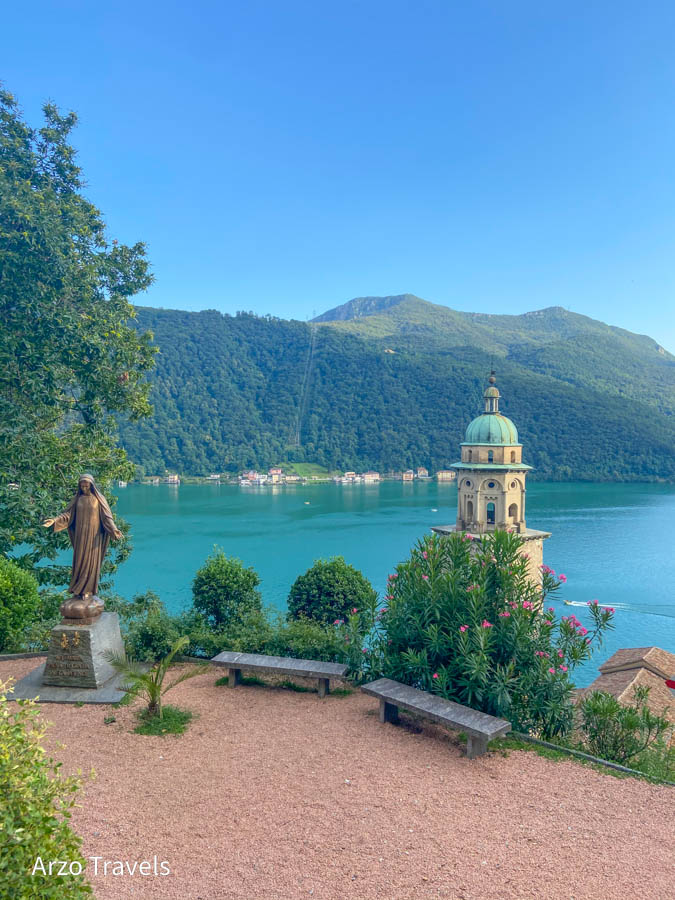
Lugano – sitting on the shores of the beautiful Lake Lugano is known for its incredible views. For an added touch of beauty, take a stroll in the Piazza Della Riforma – pastel-hued buildings with classic designs will surround you!
Head out for some hikes up Monte San Salvatore or Monte Bre – where even more breathtaking scenery awaits! Here is my detailed post on Lugano and its top activities.
Make sure to also stop by Morcote! You can visit this beautiful village in Switzerland easily from Lugano. This beauty is located a bit further and there is not much to do, but it is one of the top 5 most beautiful villages in ALL of Switzerland. Take my word for it (because I am not only a lake expert but also a Swiss village expert).
- Check out my Morcote post for more tips (and pictures)!
Lugano has a unique charm but if you don’t have enough time to explore this remote beauty then head over nearby to Locarno which is not as remote and still packs an incredible Swiss experience.
🛏️ WHERE TO STAY IN LUGANO
If you plan to stay in Lake Lugano, then I recommend staying in Lugano, which is the best base to get around.
Luxury: The View Lugano – One of the most famous 5-star hotels in Switzerland is this property. It is located close to the funicular station of San Salvatore and Lake Lugano.
➡️ BOOK YOUR STAY AT THE VIEW LUGANO HERE
Mid-Rang: Hotel Zurigo Downtown – This 3-star hotel is located just 300 meters from Lake Lugano and in the heart of Lugano.
➡️ BOOK YOUR STAY AT HOTEL ZURIGO DOWNTOWN HERE
Mid-Range: LUGANODANTE – We like you – This is a beautiful 4-star property in the city center of Lugano. This might be the perfect choice if you are looking for something more comfortable and luxurious.
➡️ BOOK YOUR STAY AT LUGANODANTE HERE
Stop 11: Locarno
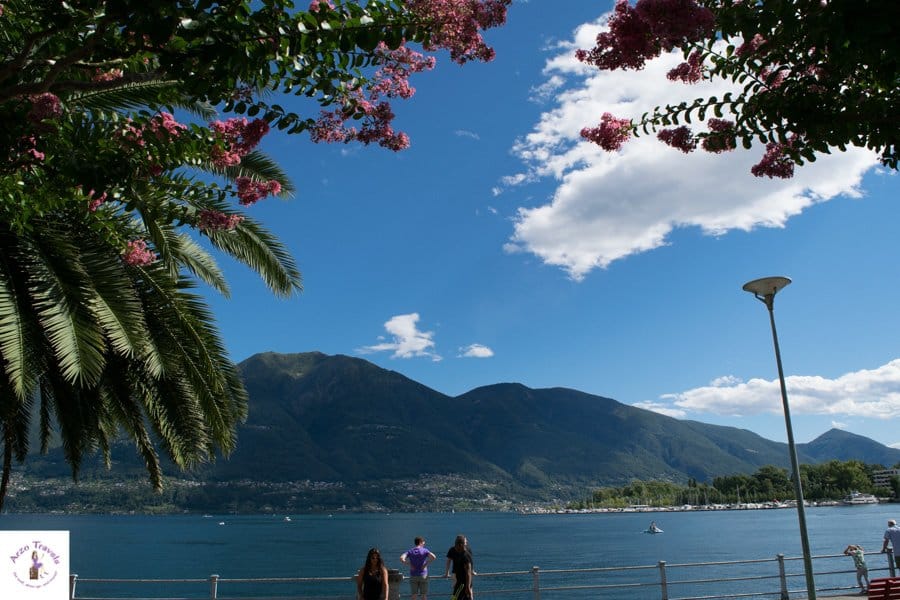
Locarno is way more than just a stunning Swiss lakeside town! Explore the beautiful Valle Verzasca Valley, which has to be seen to be believed.
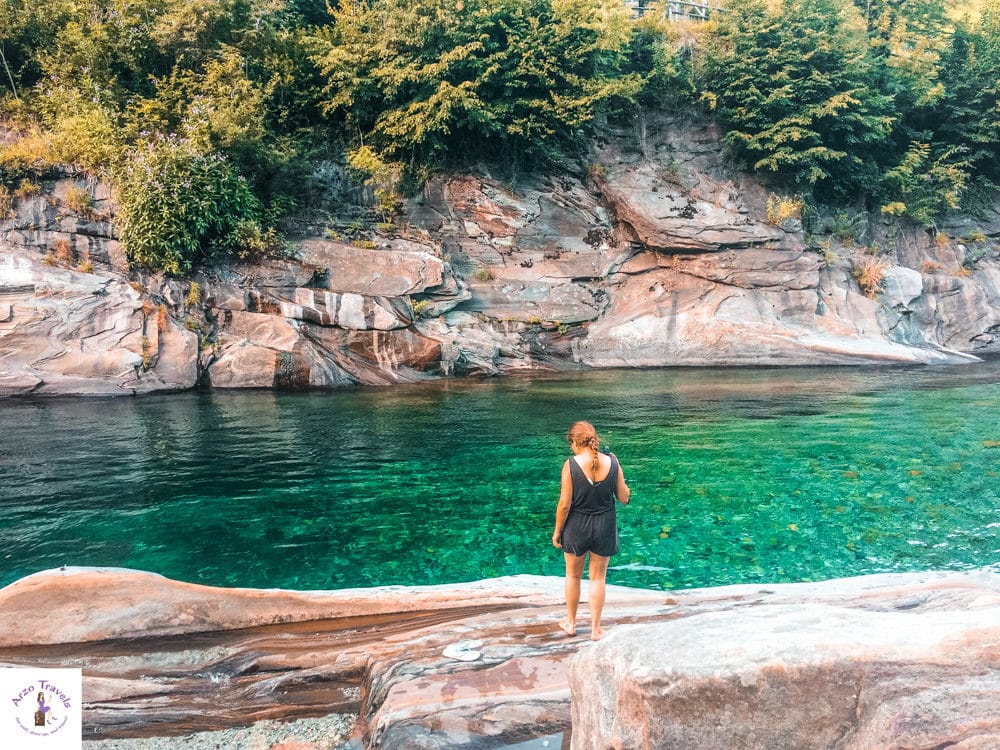
Driving to Valle Verzasca might not be as stressful as in Italy but you can feel the Italian influence when you get here. On the other hand, navigating narrower roads and busier streets can still make for an exciting driving experience! Check out my Locarno guide for more info.
🛏️ WHERE TO STAY IN LOCARNO
Luxury – Villa Orselina- Villa Orselina is a top luxurious small boutique hotel in Orselina, just a few minutes from Locarno. It has become one of my favorite hotels ever.
➡️ Check out prices here.
Mid-Range Hotel Garni Muralto – Though I did not stay here, Hotel Garni Muralto might be a good choice because it is one of the best-rated hotels in that price range.
Stop 12: St. Moritz
Explore the stunning canton of Graubünden (or Grison in English)! This gorgeous area is widely adored by the locals, yet remains a secret gem to foreigners – except St. Moritz , that is!
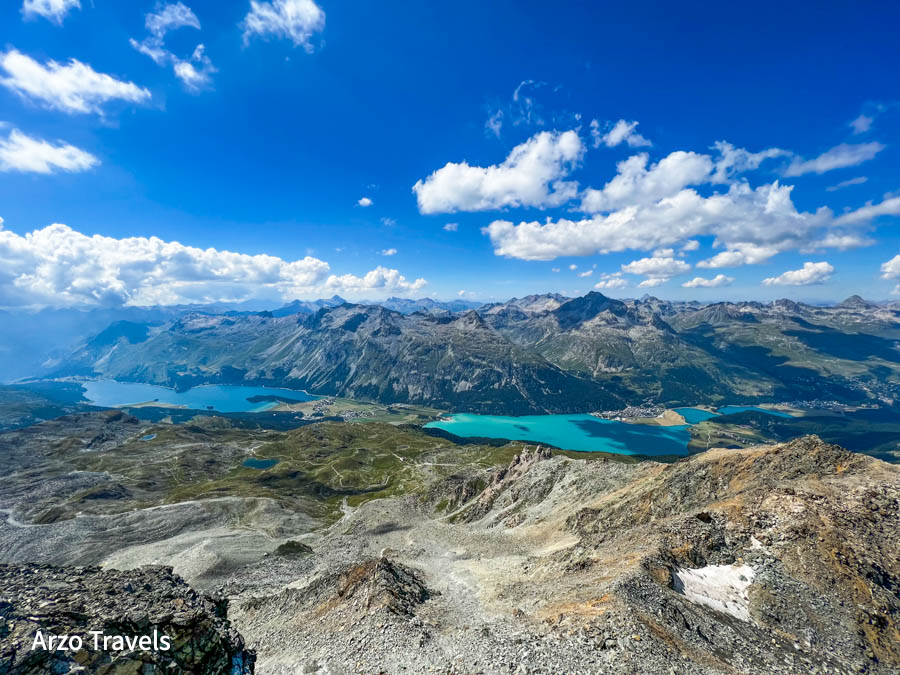
Especially in fall, its beauty is ridiculous with all the fall foliage, but it makes a great destination all year round.
St. Moritz is one of Switzerland’s most stunning spots, and it’s been drawing in visitors from around the world with its majestic mountain views for centuries!
With captivating outdoor sports to take part in during the winter months like skiing, snowboarding, and bobsledding – as well as lush hiking trails that are ideal for an alpine escape come summertime – there’s something here for everyone all year round.
Plus their lakes? Wowzers!
ℹ️ If your travels take you to this special area from mid-May to mid-October, plan for a minimum of two nights and get ready for the best transportation setup ever – totally free public transport plus access to all 13 cable cars!
🛏️ WHERE TO STAY IN ST.MORITZ
To take advantage of the “free public transportation and cable car rides”, book at one of the participating hotels (below mentioned hotels are all part of it) and visit during June and early October.
Luxury – Battrud´s Palace -This luxury hotel has everything you are looking for when booking a 5-star hotel in St.Moritz. From an extensive spa area, a lounge and bar area, luxurious hotel rooms and suites, and more.
➡️ BOOK YOUR STAY AT BATTRUD`S PALACE HOTEL HERE
Mid-Range – Hotel Corvatsch – Hotel Corvatsch is a 3-star hotel located in the lower part of St.Moritz. and only a 3-minute walk from the lake and the Signal Cable Car.
➡️ BOOK YOUR STAY AT HOTEL CORVATSCH HERE
Budget – St.Moritz Youth Hostel – The St. Moritz Youth Hostel is situated at the edge of the forest in the lower part of St. Moritz. During the day, there is a bus that gets you to the St. Moritz train station. The rooms all have shared bathrooms, and breakfast is always included – you cannot find better prices in all of St.Moritz.
➡️ BOOK YOUR STAY AT ST. MORITZ YOUTH HOSTEL HERE
Stop 13: Valposchiavo
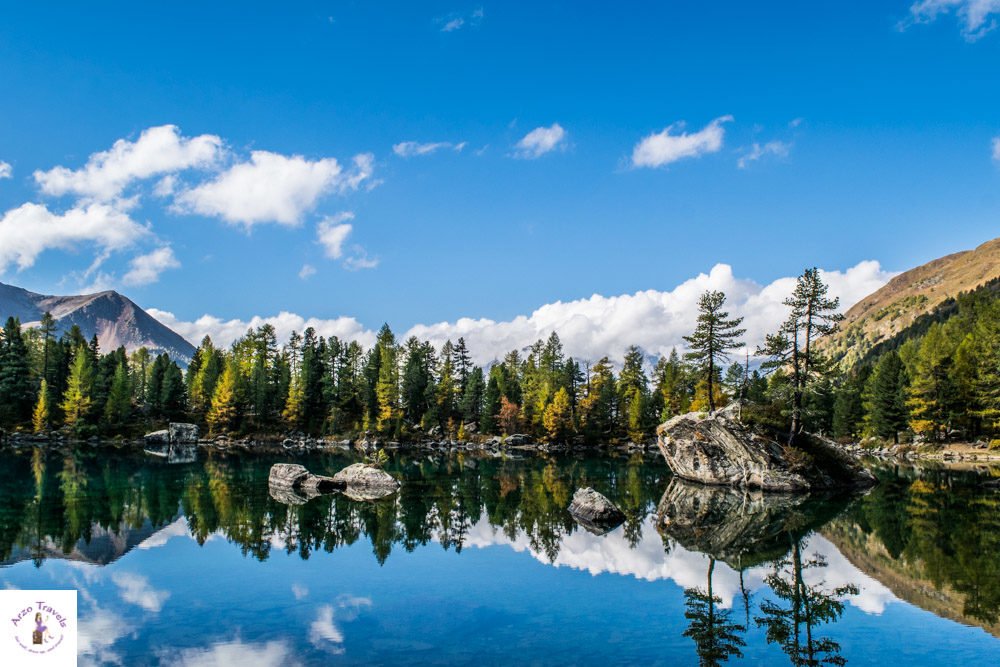
Valposchiavo – its natural beauty is unparalleled – with its tranquil lake views, lush valleys, and charming town center.
It’s definitely one of my favorite places to explore in all of the country! Plus it has that bonus – being so remote means there are very few international tourists visiting here. So it really feels like discovering your secret paradise!
🛏️ WHERE TO STAY IN VALPOSCHIAVO
Similar to St.Moritz, Valposchiavo has an amazing guest card – so leave your car at the hotel, and take advantage of the free public transportation if you book a stay at one of the participating programs and stay for two nights.
Historic Hotel Albrici – Located right in the heart of Poschiavi village, it is a great place to base yourself and get around the stunning Valposchiavo.
➡️ BOOK YOUR STAY AT HISTORIC HOTEL ALBRICI HERE
Stop 14: Appenzell & Ebenalp

And don’t forget to check out The Aescher for a remarkable experience – located on Ebenalp Mountain – a stunning summit at 1.600m above sea level in Appenzell Alps.
Take on an adventure as you choose between hiking up or taking a cable car from Wasserauen Station, either way, rewards await! You can take in panoramic views of Lake Seealpsee looking out from Ebenalp & Aescher Guesthouse. Check out my Appenzell guide for more travel tips.
From here, you can head back to Zurich or continue your journey and head to Southern Germany and explore that beautiful part of the world.
Gasthaus Hotel Hof in Appenzell – The Gasthaus Hotel Hof is perfectly located in the town center (with free parking space), and you could hardly be located closer to the market square. If you are looking for a friendly, welcoming family-run hotel, this might be a perfect choice. It is quite simple and basic but a good choice.
➡️ BOOK YOUR STAY AT GASTHAUS HOTEL HOF HERE
Romantik Hotel Säntis – If you want something fancier, the Romantik Hotel Säntis might be the perfect choice for you. This 4-star hotel is also located in Appenzell and is a great base to get around Appenzellerland.
➡️ BOOK YOUR STAY AT ROMANTIK HOTEL SÄNTIS HERE
PIN ME FOR LATER – ROAD-TRIPPING SWITZERLAND
Here is a pin for you – save it to Pinterest to find this post easily whenever you need it again.
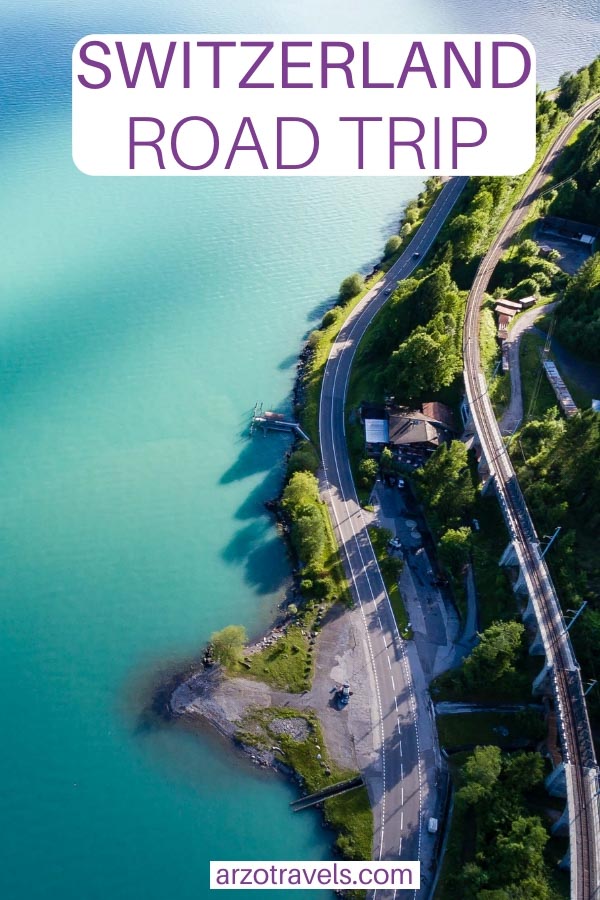
FINAL THOUGHTS – A SWITZERLAND ROAD TRIP
If you’re looking to add some true beauty and adventure into your life, then Switzerland is the place for it! From its stunningly gorgeous landscapes that never fail to leave one in awe, a Switzerland road trip must surely be high on everyone’s bucket list.
Although prices may be steep for a road trip through Switzerland, this won’t stop most from revisiting time and again – so go ahead and treat yourself to an unforgettable journey through its incredible sights & sounds and discover all this and more when road-tripping Switzerland.
Join me as I take you along my ambling Swiss itinerary sure to make any heart skip a beat or two…you’ll love every second of your road trip in Switzerland.
- How expensive is Switzerland
- Best museums in Switzerland
- 7-day Switzerland itinerary

Pin It on Pinterest

Grand Tour of Switzerland
Zurich – st. gallen – davos – lugano – zermatt – montreux – gstaad – lucerne – zurich.
Take an unforgettable road trip through Switzerland at your own pace! The country is small but offers an incredible variety of attractions: from palm-lined, crystal clear lakes to snow-covered mountain peaks, green rolling hills with farms to historic old towns and vibrant cities. Not to forget the culinary delights: You might sample not only the tastiest chocolate and cheese, but also some local specialties in each region. Let your adventure start and book your Grand Tour of Switzerland with us!

Grand Tour of Switzerland - Self Drive
April until October Starting at Double: CHF 1,725 Single: CHF 2,864
Tour Highlights
- St. Gallen’s Abbey precinct with library
- Sunny Engadine valley with its dark-blue mountain lakes
- Lugano’s Mediterranean flair including mountain scenery
- Car-free resort of Zermatt with the world-famous Matterhorn
- Montreux with the terraced Lavaux vineyards , UNESCO World Heritage
- Eiger, Monch and Jungfrau , the impressive peaks in Bernese Oberland
- Bern’s old town with 6km of arcades
- Lucerne with the Chapel bridge , imbedded within an impressive mountain panorama
Tour Program (9 Days / 8 Nights)
Day 1: arrival in switzerland.
Individual arrival in Zurich. Time at leisure to explore the vibrant city with its unique mix of attractions on your own. Overnight in Zurich.
Day 2: Zurich – St. Gallen (approx. 150 km)
Drive to St. Gallen with a stopover at the Rhine Falls, mainland Europe’s largest waterfalls. St. Gallen’s historic Abbey precinct with the cathedral and Abbey Library has been listed as UNESCO World Heritage and belongs to the top attractions along the Grand Tour of Switzerland. Overnight in St. Gallen.
Day 3: St. Gallen – Davos (approx. 160 km)
Drive from St. Gallen to Davos. On your way you pass the small town of Appenzell, situated in a landscape of rolling hills. The Appenzell region is known for rural customs and traditions. As an option you might stop in Eastern Switzerland’s wine area Bündner Herrschaft, before continuing to Davos. Overnight in Davos.
Day 4: Davos – Lugano (approx. 290 km)
On your way to Lugano in Southern Switzerland a visit to Muottas Muragl is recommended, a mountain in the Upper Engadine, overlooking the entire valley including world famous St.Moritz. Continue to Lugano. Stroll through Lugano’s old town to experience the Southern lifestyle. Overnight in Lugano.
Day 5: Lugano – Zermatt (approx. 215km)
Visit Monte Brè or San Salvatore before departing for Zermatt. Drive via Locarno towards Täsch, where you park the car before taking the train to the car-free resort of Zermatt. Overnight in Zermatt.
Day 6: Zermatt – Montreux (approx. 150km)
A trip up to Gornergrat with amazing views of the Matterhorn is not to be missed. Back in Täsch your final leg takes you through the Valais to Montreux, one of the most popular holiday destinations in the Lake Geneva region. Don’t miss out on the historic water Castle Chillon, situated on the shores of Lake Geneva. Overnight in Montreux.
Day 7: Montreux – Gstaad (approx. 330km)
Today you have one of your longest drives but also a very fascinating one with interesting sights along your way to Gstaad. Drive through the orchards and terraced vineyards of the Lavaux to Lausanne and from here continue your drive to Freiburg, which is nestled on a rock promontory. Further on your way you will pass the Gruyère region, home to the world-famous Gruyère cheese. Overnight in Gstaad.
Day 8: Gstaad – Lucerne (approx. 315 km)
Continue your journey either towards Interlaken or Berne, before heading to Lucerne. From Interlaken you can experience the majestic Eiger, Mönch and Jungfrau summits. Otherwise head to Bern, the capital of Switzerland. The old town of Bern is UNESCO World Heritage and thanks to its 6 kilometres of arcades boasts one of the longest sheltered shopping promenades in Europe. Overnight in Lucerne.
Day 9: Lucerne – Zurich Airport (approx. 140 km)
Lucerne is the gateway to central Switzerland, and it is embedded within an impressive mountainous panorama. One of the highlights of Lucerne is the Chapel Bridge. Drive to Zurich Airport for rental car drop off. Departure.
Prices per Person in CHF
Triple and/or Rates for 5-star hotels on request!
Our Package Price includes
- 1 overnight each in Zurich, St. Gallen, Davos, Lugano, Zermatt, Montreux, Gstaad and Lucerne , quality hotels, standard rooms with private facilities and breakfast
- Rental car for 9 days with pick-up and drop-off at Zurich Airport
- Return rail ticket in 2nd class between Täsch and Zermatt
- Grand Tour of Switzerland Road Map and Travel Guide
- Swiss Coupon Pass
Our price does not include
- International flights
- Travel insurance
- Transfers, meals and activities not mentioned in the list of inclusions, personal expenses
- Local taxes
- Car parking
Optional Extras
Upgrade rental car Extension nights possible Combinable with other arrangements (pre‐post tour extension) Open jaw is possible (i.e. starting in Lucerne and ending in Zurich or v.v.)
Grand Tour reservation request
The entire Grand Tour of Switzerland is even longer than the suggested route in above package. If you have more time to discover Switzerland, or would like to do only part of the Grand Tour, we are happy to put together any custom Grand Tour package for you. Please fill in below form:
Personal information
Tour information, additional nights.
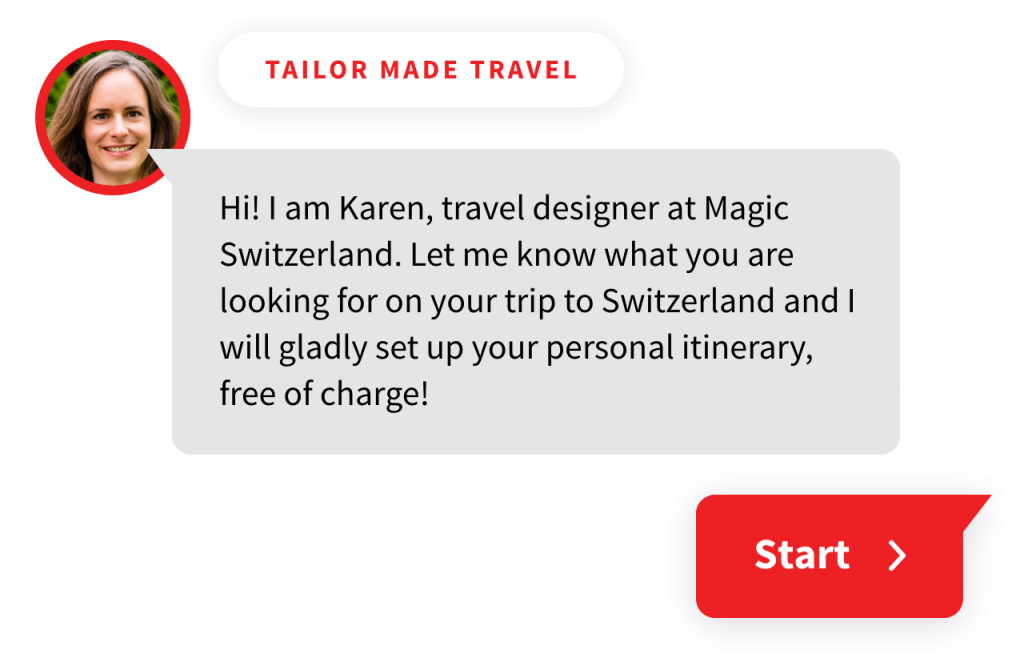

The Grand Tour of Switzerland | 14 day Switzerland itinerary by car
It’s one of Europe’s most scenic countries with towering mountain peaks, sparkling lakes and lush green fields and a 14 day Switzerland itinerary is the best way to discover this gorgeous country by car.
If you’d love to explore everything from modern cities to charming alpine villages at your own pace then a Switzerland road trip is perfect for you.
Choosing which places to visit and which ones to miss on your Switzerland vacation can be difficult so, realising that their country has so much to offer visitors, Switzerland Tourism launched the Grand Tour of Switzerland.
The Grand Tour is a scenic route made up of 25 different sections (or legs), which highlights the best of Switzerland. In most cases it is possible to cover more than one leg each day.
Covering around 1,600 kilometres, the Grand Tour takes in 44 top attractions – eleven of which are UNESCO World Heritage Sites – two biospheres, five mountain passes that are 2000 metres above sea level and 22 lakes, along the route.
Below you’ll find a suggested 14-day itinerary based on the official Grand Tour of Switzerland route but keep reading for my own two week itinerary for touring Switzerland by car.
Whilst the Grand Tour route includes visits to Switzerland’s beautiful cities including Zurich, Luzern, Basel, Geneva and Bern (amongst others), for me the real delight in the scenic itinerary is the chance to enjoy some of the best mountain scenery and views in the world.
Prefer to travel around Switzerland by train? See my Swiss rail itineraries here.

[ This post may contain compensated links. Please see my disclosure policy for more information. ]
What's in this Article
Grand Tour of Switzerland Info
📍 The official Grand Tour route is signposted with distinctive signs to help you stay on track.
📍 Numerous photo points have been highlighted at the most picturesque locations along the route. Special Grand Tour ‘photo frames’ help you to pinpoint the most photogenic viewing points.
📍 The core route can be completed in seven days with at least five hours’ driving each day. It is recommended that you take longer – as we have suggested in the itinerary below – and allow more time for detours and visiting places of interest.
The Grand Tour of Switzerland 14-day itinerary
The following itinerary allows for travel at a relatively relaxed pace and takes two weeks to cover the entire Grand Tour route.
Should you be short on time, by skipping the days allotted for sightseeing in Bern, Lucerne, Zurich and Lake Geneva, you could reduce the route to a 10-day Switzerland itinerary.

Suggested two week itinerary for the Grand Tour of Switzerland
The following itinerary follows the recommended route of the Grand Tour of Switzerland and covers a large part of the country. However it only briefly visits the Jungfrau Region, one of Switzerland’s most popular holiday destinations, so we have provided an alternative, more detailed, itinerary – with a longer stay in the region – later in this guide.
We have included details below of which ‘leg’ of the official Grand Tour each day’s itinerary refers to.
Itinerary summary: Basel > Neuchatel > Bern > Lucerne > Zurich > Appenzell > St. Moritz > Lugano > Zermatt > Lausanne > Neuchatel
Day 1 – Basel > Neuchatel (Leg 21)
- Distance: 158 km / 98 m
- Highlights along the route: Laufen, St-Ursanne, La Chaux-de-Fonds, Lake Neuchatel
Day 2 – Neuchatel > Bern (Legs 22, 23, 24 and 25)
- Distance: 252 km / 156 m
- Highlights: Murten, Fribourg, Gruyeres, Gstaad, Interlaken and Thun

Day 3 – Sightseeing in Bern
Day 4 – Bern > Lucerne (Leg 1)
- Distance: 220 km / 136 m
- Highlights: Emmental region, Aargau
Fun fact: In Solothurn there are 11 fountains, 11 museums, 11 churches, a clock with 11 hands, and even an Oufi-Bier (Eleven Beer)!
Day 5 – Sightseeing in Lucerne
Day 6 – Lucerne > Zurich (Legs 2 and 3)
- Distance: 221 km / 137 m
- Highlights: Sisikon, Einsiedeln, Rapperswil
Day 7 – Sightseeing in Zurich
Day 8 – Zurich > Appenzell (Legs 4 and 5)
- Distance: 175 km / 108 m
- Highlights: Schaffhausen and Rhine Falls, Stein am Rhein, St Gallen
Day 9 – Appenzell > St. Moritz (Legs 6, 7 and 8)
- Distance: 200 km / 124 m
- Highlights: Heidi’s village in Maienfeld, Zernez, St. Moritz

Day 10 – St. Moritz > Lugano (Legs 9, 10 and 11)
- Highlights: Three Castles of Bellinzona, St. Gotthard Pass, Locarno,
Day 11 – Lugano > Zermatt (Legs 11, 12, 13 and 14)
- Distance: 264 km / 164 m
- Highlights: Airolo, Furka Pass, Bettmeralp, Matterhorn
Day 12 – Zermatt > Lausanne (Legs 14, 15, 16 and 17)
- Distance: 178 km / 110 m
- Highlights: St-Maurice, Montreux
Day 13 – Sightseeing around Lake Geneva
Day 14 – Lausanne > Neuchatel (Legs 17, 18 and 19)
- Distance: 190 km / 118 m
- Highlights: Nyon, Yverdon-les-Bains, Creux du Van

To plan your Grand Tour of Switzerland, visit the fantastic interactive Grand Tour website where you’ll find suggested routes and useful information.
If you’d prefer to explore Switzerland from the comfort of the Swiss trains, see my Grand Train Tour of Switzerland itinerary here.
Alternative 14 day Switzerland itinerary for road trippers
If you are planning to explore Switzerland by car but don’t necessarily want to follow the exact Grand Tour of Switzerland route, the following itinerary is for you.
This two-week Switzerland itinerary includes visits to major cities and smaller towns, mountain and lakeside locations and some of the country’s most popular attractions.
There are full days in each location (except Basel) to allow you to explore each destination in more depth.
Itinerary summary: Geneva > Zermatt > Ascona > Lucerne > Interlaken > Bern > Basel > Zurich
Itinerary DAY 1 | Geneva
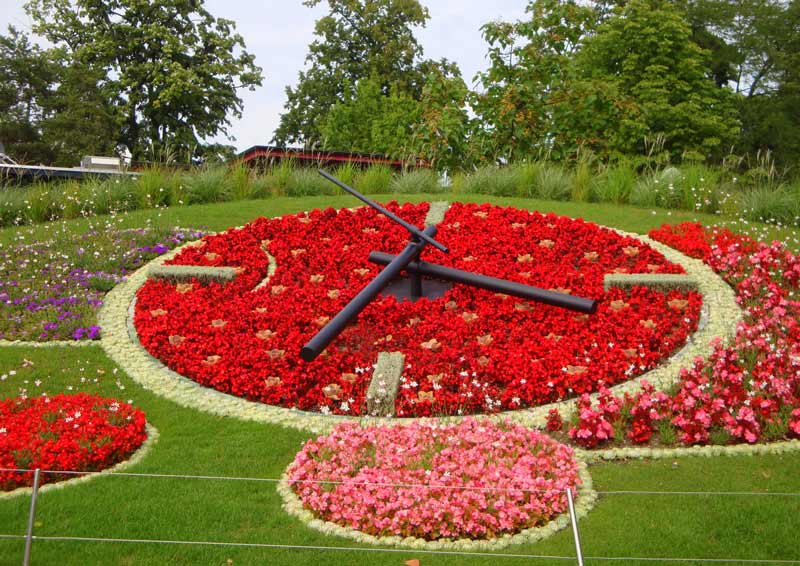
Welcome to Switzerland – it’s time to get your Switzerland road trip underway!
Geneva’s location on the shores of the lake of the same name means it is the perfect spot for relaxing but there are plenty of sights and attractions to visit, too.
Most visitors head straight for the Jardin Anglais (English garden) located beside the lake to admire the l’horloge fleurie (flower clock) which was created in 1955 to commemorate Geneva’s watchmakers.
It’s at the English garden that you’ll probably get your first glimpse of the Jet d’Eau , the city’s emblem. This fountain spurts a huge jet of water 140 metres above the lake, so it’s hard to miss.
Allow some time to stroll around the lake, (called Lac Leman in French), or even relax onboard a paddlesteamer as it chugs its way across the water.
Other attractions in Geneva worth a visit include the Palais des Nations, the European headquarters of the United Nations, and its surrounding park; the Reformation Wall; and the Red Cross and Red Crescent Museum.
For fabulous views of the city and lake, climb the 175 steps of St. Peter’s Cathedral.
Stay: Novotel Geneva Centre – > click here to check room rates
Further reading: Things to do in Geneva
Itinerary DAY 2 | Geneva

Having explored the major sights in Geneva city, it’s time to see more of the lake. There are plenty of lovely towns and villages dotted along the northern shore of the lake including Nyon, Rolle, St. Saphorin, Lausanne and Montreux ( read more about this lovely town here ).
After a leisurely drive around the lake, be sure to visit Chateau de Chillon near Montreux, a turreted Medieval castle that has served as a fort, a summer residence for the Counts of Savoy, and a prison!
Check opening times for Chillon Castle here .
Alternatively, take a drive through the UNESCO World Heritage-listed Lavaux vineyards for stunning views from the terraced vineyards over Lake Geneva.
Stay: Novotel Geneva Centre
Itinerary DAY 3 | Geneva to Zermatt
Distance: 232 km / 144 m
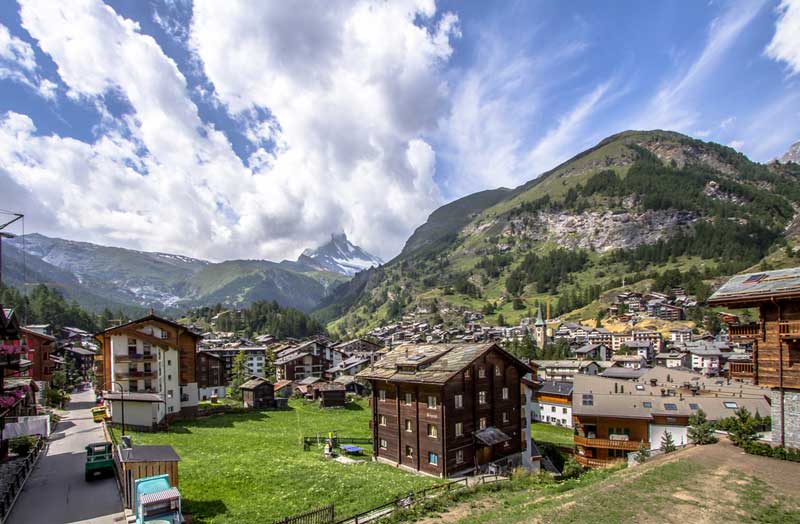
Today’s journey to Zermatt should take around three hours if you don’t stop but I suggest you take a break at Martigny. Here you can visit the 13th century fortress Tour de la Batiaz , the Roman amphitheatre or enjoy a ride around the city aboard the tourist train.
After your break, it’s time to head to the beautiful alpine town of Zermatt. At Visp, the road starts climbing and you’ll be winding your way up the mountain until you reach the village of Tasch.
Zermatt is a car-free town so all vehicles must be parked in one of the parking garages in Tasch. It’s then just a short shuttle train ride to Zermatt. The underground car park adjoining the railway station is the most convenient place to leave your car.
Parking costs CHF 16 per day (24 hours) and shuttle trains from Tasch to Zermatt (and vice versa) run every 25 to 30 minutes – price CHF 17 return per adult. Tickets can be purchased from the machines in the station (English language option available) using a credit card.
After checking in to your hotel, spend the rest of the day exploring Zermatt and admiring the views of the stunning Matterhorn.
Stay: Hotel Mirabeau – > click here for current prices
Itinerary DAY 4 | Zermatt

Spend the day getting up close and personal with the Matterhorn. There are three ways to experience this amazing peak at closer range – either catch the train to Gornergrat or take a funicular and cable car to Rohorn for front on views, or take a cable car ride to Matterhorn Glacier Paradise at the peak of the Kleine Matterhorn for stunning 360 degree views.
The Gornergratbahn is a rack railway that winds its way up from Zermatt to Gornergrat (3089 metres above sea level) where the Matterhorn sits right in front of you. Trains depart every 30 minutes from the Gornergrat station, opposite the main railway station in Zermatt, and the journey takes half an hour.
Alternatively, jump aboard a cable car for a spectacular ride to the Matterhorn Glacier Paradise (3883 m.). There’s plenty to do here, including summer skiing on the glacier and you’re so close to the majestic Matterhorn you’ll almost be able to reach out and touch it.
For Insta-worthy photos of the Matterhorn, hop aboard a funicular and then two connecting cable cars to Rothorn (3104 m.).
At the summit there are numerous things to do including mountain cart and kick bike hire, paragliding and, of course, hiking.
Rothorn can only be reached from May to October but there are frequent funicular and cable car services during this period.
After your day’s sightseeing, head back to Zermatt for some retail therapy or treat yourself to a bit of relaxation in one of the many spas and wellness centers in town.
Stay: Hotel Mirabeau
Further reading: Things to do in Zermatt
Itinerary DAY 5 | Zermatt to Ascona
Distance: 148 km / 91 m

Today we’re off to another popular Swiss holiday resort but this time it’s one with an Italian flavour. During today’s drive, which should take around three hours, you’ll cross into Italy for part of the trip before re-entering Switzerland.
Tip: Make sure you keep your passport handy in case you are asked to present it at the border.
Ascona is situated on Lake Maggiore, the northern tip of which lies in Switzerland. Italian is the main language spoken here and the architecture has a strong Mediterranean influence. The climate, too, resembles the Mediterranean and this part of Switzerland is said to be the sunniest in the country.
Stay: For pure luxury, splurge on a room at Eden Roc Ascona – > click here to check prices
Itinerary DAY 6 | Ascona

There are plenty of ways to amuse yourself today. ( You can find plenty of options in this article .) Why not enjoy a lake cruise to another of the lakeside towns or to the Brissago islands?
Or wander the streets of Ascona’s pretty Old Town where you’ll find plenty of boutiques and galleries lining the narrow cobbled streets. Many of the buildings date back to the 14th Century.
If it’s too hard to make a decision, head to the lakefront and enjoy a cold drink or a coffee whilst you take in the gorgeous views.
Stay: Eden Roc Ascona
Itinerary DAY 7 | Ascona to Lucerne
Distance: 170 km / 105 m

It’s only a two hour drive to Lucerne this morning so you might like to stop on the way at Bellinzona, a fortress town built in the Middle Ages.
Three castles remain in Bellinzona today – Castelgrande, Montebello and Sasso Corbano – and together they have been declared a UNESCO World Heritage Site. Castelgrande is the most impressive with its crenellated walls connecting two square towers.
Allow time to explore Lucerne’s Old Town this afternoon. After checking out the pretty frescoed buildings along the cobblestone streets, the Chapel Bridge should be your next stop.
Other sites worth visiting include the Jesuit Church and the Dying Lion statue.
Stay: Hotel des Alpes – > click here to check room rates
Itinerary DAY 8 | Lucerne

What a choice you have today! There are numerous mountain excursions available from Lucerne including trips to Mt. Pilatus, Mt. Titlis and Mt. Rigi .
Titlis boasts the world’s first rotating cable car or you can ride on the world’s steepest cog railway to reach Mt. Pilatus.
Alternatively you could enjoy a lake cruise or spend a few hours at the fascinating Swiss Transport Museum which houses a huge collection of trains, planes, automobiles and ships. There’s also an IMAX theatre and heaps of interactive displays, as well as a Chocolate Adventure museum.
Stay: Hotel des Alpes
Further reading: Best things to do in Lucerne
Itinerary DAY 9 | Lucerne to Interlaken
Distance: 72 km / 44 m

Your Switzerland road trip continues today with a short drive but the scenery will blow you away.
Allow plenty of time for photo stops as you pass the pretty village of Lungern and drive over the Brunig Pass.There’s a great lookout point at the top of the Pass with room to park off the road.
Further along, you’ll drive along the shore of Lake Brienz. The main motorway is the fastest route into Interlaken but why not take a detour into Iseltwald and follow the smaller road by the lake to Bonigen? You’re then just a couple of kilometres from Interlaken.
A great way to appreciate Interlaken’s location is to take the funicular to Harder Kulm. The station is just a few minutes’ walk from the Interlaken Ost railway station in the town centre and the funicular runs every 30 minutes.
At the top you’ll see that Interlaken is nestled between two lakes – Lake Brienz and Lake Thun – and surrounded by alpine peaks. The Two Lakes Bridge is the perfect spot from which to appreciate nature’s beauty.
Stay: Hotel Derby – > click here to check prices
Itinerary DAY 10 | Interlaken

One of Switzerland’s most scenic train rides is right on your doorstep so if you’ve ever dreamt of visiting the Jungfraujoch, today’s the day. With a journey time of around two hours, you’re advised to set off early to get the most out of your day.
After a scenic train ride, the last thirty minutes of the trip is through a tunnel carved inside the mountain before you emerge at what is known as the Top of Europe. (Alternatively, you can catch a cable car for part of the journey, which reduces the travel time – more info > in this guide .)
There are plenty of activities available at the summit including skiing, sledding and tobogganing in the Snow Fun Park (during summer only). You should also visit the Ice Palace and the Sphinx Observatory which are open year round.
If you don’t fancy a full day excursion, an excursion to the Schilthorn is another great option. Drive to Stechelberg, just past Lauterbrunnen (about twenty minutes from Interlaken) and then take the cable car via Murren to Schilthorn.
The 360° views you get from up here are simply amazing! The Schilthorn is also where the James Bond movie “On Her Majesty’s Secret Service” was filmed sixty years ago, and the Bond Museum is an interactive and fun display of Bond memorabilia. > Click here to check ticket prices
Tip: The cable car stops between Murren and Schilthorn at Birg. Be sure to disembark and check out the Thrill Walk and the Skywalk Platform – if you’re brave enough!
Stay: Hotel Derby
Further reading: 60+ attractions and things to do in Interlaken and surrounds
Itinerary DAY 11 | Interlaken to Bern
Distance: 57 km / 35 m

It’s less than an hour’s drive to the Swiss capital, Bern, so you’ll have plenty of time to see the city’s main attractions, which are all close to the Old Town.
Sites to tick off include the Zytglogge (clock tower), Albert Einstein’s house – he developed the theory of relativity here, the Berner Munster (cathedral) and the Laubengange, a series of covered arcades that stretch for nearly six kilometres around the Old Town.
Cross the Nydegg bridge over the River Aare to Barengraben , a specially-designed park alongside the river that is home to Pyrenean brown bears, Bern’s symbol.
Heading back into the Old Town you’ll find plenty of places to sit and enjoy the atmosphere in this friendly, vibrant city.
Stay: Hotel Savoy – > click here to check room rates
Further reading: Things to do in Bern
Itinerary DAY 12 | Bern to Basel
Distance: 123 km / 76 m

Today’s drive should only take an hour so you’ll have plenty of time to have a good look around Basel. The city, which is close to both France and Germany, is situated on the Rhine River.
Basel’s medieval Old Town sits on the south bank of the Rhine and it’s here you will find the Romanesque-Gothic Munster (cathedral), the brightly painted Rathaus (town hall) and Marktplatz , where a busy market is held every weekday morning.
There are plenty of ancient alleyways and modern shopping streets to explore, too, as well as some wonderful gourmet restaurants in Basel .
Stay: Steinenschanze Stadthotel – > click here for current prices
Further reading: Things to do in Basel
Itinerary DAY 13 | Basel to Zurich
Distance: Varies according to which route you choose

Although you’re probably keen to reach the lively Swiss city of Zurich, why not stop enroute at Baden, one of Switzerland’s oldest health resorts?
Take some time out to immerse yourself in the healing waters of Baden’s spa centre which are rich in sulphur before getting back behind the wheel and continuing on your way.
The water theme continues at Rhine Falls, just outside of Schaffhausen, and this makes a great detour should you wish to see Europe’s largest waterfalls.
From both Baden and Schaffhausen it’s only a short drive to Zurich giving you just enough time to decide how you’ll spend your time in the city.
A city tour is a good way to get your bearings and get a quick lesson in Zurich’s history at the same time but if you’d rather do your own thing, grab a city map from your hotel or the Tourist Office and start exploring on foot.
Stay: Sorell Hotel Zurichberg – > click here to check prices .
Further reading: How to spend 48 hours in Zurich , Hotel Sorell Zurichberg Review
Itinerary DAY 14 | Zurich

It’s the final day of your Switzerland itinerary and whilst you probably won’t need your car today, there’s still plenty to see and do.
Highlights of Zurich include the Old Town with the Fraumunster and St. Peter’s Kirche (church), the upmarket shopping street Bahnhofstrasse, Limmatquai, and the Grossmunster cathedral.
For great views of the city, head to Lindenhof across the river from the Old Town or take the cable car to Uetliberg, Zurich’s own mountain.
Be sure to wander down to Quaibrucke (bridge) where the Limmat flows into Lake Zurich. Not only do you get fantastic views of the many bridges spanning the river but this is also the place to hop aboard a boat for a pleasant lake cruise.
Before you call it a day, head to Zeughauskeller , a former weapons warehouse that is now home to a popular restaurant serving traditional Swiss meals.
The house specialty, Zürcher Art schnitzel, a pan-fried veal schnitzel with creamy mushroom sauce, is delicious! It’s the perfect way to end your Swiss vacation.
Final Thoughts
This 14-day Switzerland itinerary covers a good part of the country without requiring long travel distances. It provides the opportunity to explore cities, holiday towns and mountain resorts at a leisurely pace with plenty of jaw-dropping scenery along the way.
I hope it has encouraged you to see Switzerland by car.
Prefer to get around Switzerland by train? No problem! Click here to read my recommended Switzerland itinerary for train travellers.
Important info for driving in Switzerland

📍 Before you set off on your road trip, be aware that Switzerland law requires that all vehicles travelling on motorways have a toll sticker (called a vignette) attached to the windshield.
📍 If your rental car does not have a Swiss vignette, you can purchase one from any gas station for CHF 40 (valid for 12 months).
📍 The maximum speed permitted on Switzerland’s motorways is 120 kilometres per hour.
📍 > Click here to check prices for car rental in Switzerland
Ready to hit the road? You can read my full guide to driving in Switzerland > here .
Switzerland Travel Essentials
Swiss Travel Pass
Private Transfers
Rail Packages
Self-Drive Packages
Accommodation
Sightseeing.
Jungfrau Travel Pass
Berner Oberland Pass
Group Tours
Private Tours

Carolyn Schönafinger
Carolyn Schönafinger is a frequent visitor to Switzerland, the country she fell in love with more than 30 years ago. She now visits Switzerland every year in her quest to explore every inch of the country. Carolyn is a certified Switzerland Travel Expert and she has achieved the Swiss Travel System Travel Expert diploma. She loves sharing her Switzerland travel expertise and helping others to plan their dream Swiss vacation on this website and the Holidays to Switzerland Travel Podcast. Read more

Best Hotels in Zermatt

Episode 37: Trip Report - Traveling Switzerland at a slower pace
We travelling to Switzerland.
© Holidays to Switzerland 2024. All Rights Reserved . About • Privacy Policy • Disclaimer/Disclosure • Contact

Everything You Need to Know About Driving in the Swiss Alps
What's In This Article?
Are you planning on renting a car for your upcoming trip to Switzerland? You might be wondering what it is like driving through the Swiss Alps . Before you embark on your epic Swiss road trip there are a few practical things you should know to make the experience stress-free.
I traded in my Canadian license for a Swiss license years ago when I moved to Switzerland. As much as we love the public transportation system in Switzerland, we still explore a lot of the country by car.
This guide on driving in the Swiss Alps you’ll learn:
- Tips for renting a car in Switzerland that will save you time and money
- How to manage the road conditions of the Swiss Alps safely
- The most famous mountain passes in Switzerland
- Everything you need to know about tolls, fuel, and parking
Driving in the Swiss Alps – What You Need to Know
Driving in Switzerland can be a daunting task. Especially if you’re unfamiliar with the language or the roads. But don’t worry; this guide covers it all! By following these tips, you will be prepared for any journey that awaits you while driving through the Swiss Alps. So let’s get started with a few insider tips and tricks.
Tips for renting a car in Switzerland
When it comes to exploring the Swiss Alps, renting a car opens up a world of convenience and flexibility. Having your own wheels is the best way to explore at your own pace.
If you plan on renting a car Switzerland, a few handy tips can go a long way. It’s a good idea to book your rental car in advance . This is essential during peak travel seasons, to secure the vehicle of your choice.
Research and compare prices from different rental companies. This will help you find the best deal for you budget. It’s also worth considering renting a car with GPS navigation. This will help you navigate the winding mountain roads with ease.
Switzerland has several rental car companies with excellent reviews and top ratings. Among them are AVIS Rent a Car , EuropCar , and Sixt . These companies have built a reputation for their quality service and reliable vehicles. This makes them popular choices for travelers exploring Switzerland.
When you choose a rental car company in Switzerland, it’s important to consider a things. First, check the company’s border crossing policy. Some rental car companies have restrictions or fees for crossing certain borders.
Additionally, it’s essential to review the fuel policy of the rental car company. Some companies provide a full tank of fuel at the beginning of the rental and need you to return the car with a full tank. Others may operate on a “pick up full, return empty” policy or have variations thereof. Understanding the fuel policy will help you plan your refueling stops.
Be mindful of any mileage limits imposed by the rental car company. Some companies may have a daily mileage limit. If you exceed these limits you might be charged extra. Familiarizing yourself with these details will ensure a smoother rental experience. It also helps you avoid any unexpected costs.
Road Conditions and Safety for Driving in the Alps
When driving in Switzerland, it’s important to consider the road conditions. The alpine roads are generally well-maintained. But, it’s essential to keep in mind that driving in mountainous terrain can tricky.
The roads often wind through steep inclines, narrow roads, and hairpin bends. These conditions require careful attention. You’ll also have to pay attention to speed limits. Additionally, weather conditions can change rapidly in the mountains. It’s advisable to check weather forecasts and road reports before setting off.
Stay up to date with weather conditions and road reports and adjust your plans if necessary. Driving conditions are more ideal during the summer months. During the winter months, snow and ice can make the roads slippery. You may have to use snow chains in certain areas. Winter tires are not required by law in Switzerland but Swiss drivers are encouraged to use them.
Ensure your vehicle is in good condition before embarking on your journey. Check the brakes, tires, and lights to guarantee optimal performance. Know your route ahead of time. Make sure to plan your itinerary ahead of time. It’s best not to rush so give yourself lots of time to reach your destination.
When you’re in the mountains, keep a safe distance from other vehicles. This is important when driving uphill or on winding roads. Pay close attention to road signs. Especially those that indicate sharp turns or steep descents. Be mindful of cyclists and hikers sharing the road.
It’s also important to be on the lookout for wildlife. Be respectful of their habitat and drive cautiously.
Switzerland has a well-regulated traffic system. Get to know the rules of the road the key road signs . Keep an eye out for signs indicating the speed limit. These will vary depending on the location and type of road. Don’t forget, you cannot make a right-hand turn at a red traffic lights in Switzerland.
In all areas of Switzerand, you must drive on the right side of the road. There are also some warning signs you might not recognize. Signs with a red triangle warn of potential dangers ahead, such as sharp turns or steep inclines. Blue signs with white symbols give mandatory instructions. These could be giving way or parking restrictions.
When you drive in Switzerland you have to buckle up. This is the law. Always carry a valid driver’s license, vehicle registration documents, and proof of insurance.
Looking for More Swiss Inspiration
Check out our other posts on the Bernese Oberland
Famous Passes in the Swiss Alps
Ready to take the scenic route? You’ll have the opportunity to traverse some of the most famous mountain passes in the world. These iconic Swiss passes boast breathtaking beauty and snow capped mountains.
As you wind your way through the alpine landscapes, enjoy the scenery that surrounds. The summer is the best time to explore these passes as in the winter many of them are closed.
Furka Pass and its Breathtaking Beauty
The Furka Pass is a legendary mountain pass complete with trilling hairpin turns and steep slopes. It’s a truly unforgettable driving experience. It’s located in the cantons of Uri and Valais, the pass connects the Urseren Valley with the Obergoms region.
What makes the Furka Pass particularly special is it rich cinematic history. It gained worldwide fame when it was featured in the iconic James Bond movie “Goldfinger,”. Remember when Agent 007 raced his Aston Martin across its hairpin bends? As you drive along the pass you may even see trains in the Furka pass chugging along the mountains.
As you wind your way to the top of the pass, enjoy the scenery that surrounds. The summer is the best time to explore these passes as in the winter many of them are closed. It’
Gotthard Pass and its Historical Significance
In Central Switzerland, you’ll encounter the Gotthard Pass. It’s a legendary mountain pass that holds immense historical significance. It connects the German-speaking region with the Italian-speaking region of Ticino. This pass has been a vital route for centuries.
It was as a trade and transit route that attracted merchants, pilgrims, and explorers. Today, modern engineering marvels like the Gotthard Base Tunnel have made the pass more accessible and efficient.
Simplon Pass and its Alpine Charm
The Simplon Pass is a captivating mountain pass the Valais region of Switzerland.
As you make your way through the pass, you’ll see majestic peaks, lush meadows, and even waterfalls.
The Simplon Pass has a rich history dating back to Roman times when it served as a vital trade route. Today, it remains a favorite among road trip enthusiasts.
St. Bernard Pass and its Scenic vistas
Bernard Pass is a true gem for those seeking awe-inspiring scenic views. It lies on the Italian-Swiss border at an elevation of 2,469 m (one of highest mountain passes in Switzerland).
Towering peaks, rolling green meadows, and pristine alpine lakes will greet you at every turn. The Great St. Bernard Pass holds a special place in history as a significant trade and pilgrimage route.
The Col De La Bonette In The French Alps
The Col de la Bonette is a famous mountain pass located in the French Alps including. It is known for its breathtaking views and challenging driving experience. The pass reaches an elevation of 2,715 meters, making it one of the highest paved roads in Europe.
Driving through the Col de la Bonette allows you to witness stunning alpine landscapes, including snow-capped peaks and winding mountain roads. It’s a thrilling and memorable journey for anyone seeking adventure and natural beauty in the French Alps.
Susten Pass and Grimsel Pass – Hidden Gems of the Swiss Alps
The Susten Pass and Grimsel Pass are two spectacular mountain passes that showcase the majestic beauty of the Swiss Alps. As you navigate the winding roads of the Susten Pass, be prepared to be mesmerized by its dramatic landscapes, including towering peaks, cascading waterfalls, and emerald-green valleys.
Pass Closures
Please note that these closure periods are subject to weather conditions and may vary slightly from year to year. It’s always advisable to check for the most up-to-date informatio n before planning your journey through these passes.
Planning on Visiting the Bern Region?
Check out our One Day In Bern Itinerary
Tolls and the Motorway Vignette
Are there toll roads in Switzerland? There are, but they don’t look how you’d normally imagine them. You might notice that cars in Switzerland have a sticker with the calendar year on the windshield. This is a motorway vignette. It’s like a ticket that allows you to use the Swiss motorways without having to pay tolls at the gates. You need to have this vignette to drive on the motorways, and it lasts for a whole year.
The money from the vignette helps keep the roads in excellent condition. The good news is that when you rent a car in Switzerland, the vignette is usually already included . So you don’t have to worry about buying it separately. It makes exploring the beautiful Swiss Alps by car easy and convenient. Just make sure to ask the car rental company if the vignette is included before you start your Alpine adventure.
Cross Boarder Tolls
Local tip : If you plan on driving into Austria during your road trip you need a pickerl. This is a sticker that you need to have to drive on roads in Austria. As you approach the boarder you can buy a pickerl at any gas station. They’re only 5.80 Euros for 10 days and are well worth it as fines can be up to 100 Euros if you’re stopped and don’t have one.
You might notice a CH sticker on your rental car. This is required to drive into other European countries. They require country identification, and the red cross on Swiss number plates doesn’t meet their requirements
Driving Through Tunnels
In Swiss Alps, you’ll in doubt encounter several tunnels along your route. You might not have experience unique driving experience. Here are a few tips for navigating Swiss tunnels with ease.
Firstly, always ensure your headlights are turned on, this is mandatory in Swiss tunnels. Secondly, maintain a safe distance from the vehicle in front of you and adhere to the posted speed limits.
Swiss tunnels are well-maintained with ventilation systems. But it’s still a good idea to keep your windows closed to reduce exposure to exhaust fumes.
Availability and Locations of Gas Stations
Gas stations are pretty easy to find in Switzerland. So you can fuel up your vehicle without any worries. You can rest assured that you’ll find gas stations in towns, villages, and along major highways.
It’s still a good idea refueling stops in advance. Especially if you’re venturing into remote areas or embarking on a long journey. This way you can enjoy your drive through the Swiss Alps without any fuel-related issues. Usually you have to pay for fuel in advance inside the gas station using cash or a credit card.
Like most things in Switzerland, gas is expensive. Let’s look at gas prices so you can budget accordingly. American travelers, you’ll find that gas prices in Switzerland are much higher compared to the United States.
Additionally, gas is sold in liters rather than gallons , so keep this conversion in mind while calculating costs.
To estimate your fuel expenses, research the current gas prices in Switzerland. Then calculate the average fuel consumption of your vehicle.
This will help you create a realistic budget for your trip. Remember that exploring the Swiss Alps might require more fuel than anticipated. This is due to winding mountain roads and scenic detours.
Parking Options
In popular alpine towns and cities, you’ll find designated parking areas and garages. Here you can safely leave your vehicle while exploring on foot.
Parking fees usually apply, so it’s a good idea to carry some Swiss francs for payment. You will usually find a parking meter in the center of a parking lot. To make your parking experience even more convenient, consider using helpful apps like “ ParkNow ” or “ EasyPark .” These apps allow you to locate parking spots, check availability, and then pay for parking directly from your smartphone.
Driving in the Swiss Alps is an experience like no other. From the breathtaking mountain landscapes to the winding and challenging roads, the Swiss Alps offer a unique adventure for drivers seeking a thrilling and unforgettable journey. While it may seem daunting at first, with the right preparation, patience, and attention to safety, driving in the Swiss Alps can be a safe and rewarding experience. Whether you’re traveling with family or friends, or embarking on a solo road trip, exploring the Swiss Alps by car is a trip you’ll cherish for years to come. So, pack your bags, buckle up, and get ready to hit the road!
Frequently Asked Questions About Driving in the Swiss Alps
Can you drive through the swiss alps.
Yes, you can drive through the Swiss Alps! The Swiss Alps are a beautiful mountain range in Switzerland, and there are many roads and passes that allow you to drive through them. It's a great way to explore the breathtaking scenery and enjoy the picturesque views. However, it's important to drive safely and follow the traffic rules. Some roads may be narrow and winding, so it's important to take your time and be cautious. Make sure to check the road conditions and weather before your trip and be prepared for steep climbs and descents. So, buckle up and get ready for an exciting adventure through the Swiss Alps!
Can I drive in Switzerland as a tourist?
As a tourist, you can drive in Switzerland. Switzerland allows tourists to drive with a valid driver's license from their home country. But your license must translated into German, French, Italian, or English). If it's not, make sure to get an international driving permit (IDP) along with your driver's license. The minimum driving age in Switzerland is 18 years old.
Related Posts
Interlaken to lauterbrunnen – getting there by train, bus, or car.
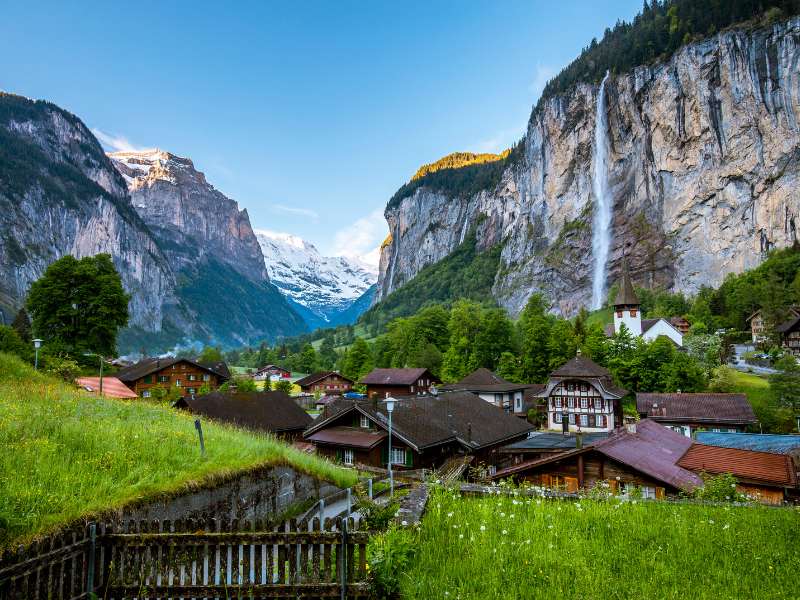
The Complete Switzerland Packing List For Summer 2023
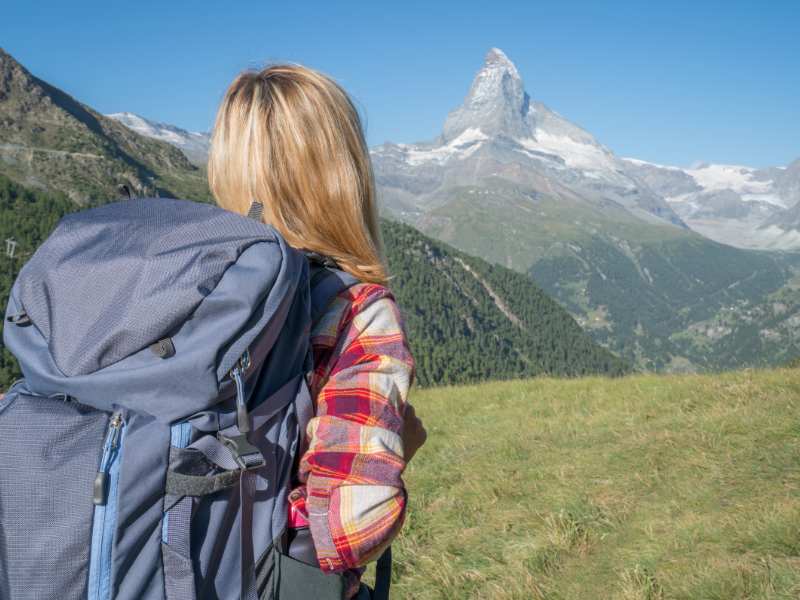

- Trip Finder
- Newsletter Signup
- Request a Call
- Crete Sea to Summit
- Best of the Swiss Alps
- Exploring The Jungfrau
- Italian Dolomites
- Best of the French Alps
- St Moritz to Italy
- Exploring Croatia
- Italian Lakes Discovery
- Best of Slovenia and the Julian Alps
- Tour of the Giants
- Italian Dolomites Alta Via 1
- Chamonix-Zermatt Haute Route
- Deluxe Haute Route
- Deluxe Tour du Mont Blanc
- Via Alpina - Swiss Alpine Route
- Deluxe Bernese Oberland Traverse
- Eiger to the Matterhorn
- England Coast to Coast
Scenic Alps by Rail
- Cheese, Chocolate, & the Alps
- Self-Guided - Scenic Alps by Rail
- Self-Guided- Glacier Express
- Christmas in Switzerland
- Scenic Alps by Rail - Christmas Edition
- Self-Guided Haute Route
- Self-Guided Tour du Mont Blanc
- Self-Guided Jungfrau
- Self-Guided Via Alpina
- Self-Guided Bernese Oberland Traverse
- Self-Guided Eiger to the Matterhorn
- Self-Guided Swiss Alps
- Self-Guided Austria Zillertal Alps
- Private Guided and Custom Trips
- Appenzell -Alpstein Range
- Zermatt and the Matterhorn
- Leukerbad -Thermal Hot Springs
- Principality of Liechtenstein
- Saas-Fee - Pearl of the Alps
- Tour Calendar
- Where We Stay
- How We Travel
- FAQ – Alpenwild Experience
- FAQ - Tour du Mont Blanc
- FAQ - Haute Route
- FAQ - Alps Hiking Tours
- FAQ- Scenic Alps by Rail Tour
- A Self-Guided Tour FAQ
- Self-Guided FAQ - Haute Route
- Self-Guided FAQ - Tour du Mont Blanc
- Self-Guided FAQ - Rail Tours
- Travel Agents + Alpenwild
- Why You'll Love The Alps
- Packing List – Alps Trekking Tours
- Packing List – Alps Hiking Tours
- Packing List – Alps Walking and Sightseeing Tours
- Packing List - Winter Tours- Christmas in Switzerland
- Weather In The Alps
- Haute Route Essentials
- Tour du Mont Blanc Essentials
- Is a Self-Guided Trip for me?
Car Travel in Switzerland
- Maps & Books
- Book Your Trip
- Make a Payment
- Why Choose Alpenwild
- The Alpenwild Story
- Guides and Trip Leaders
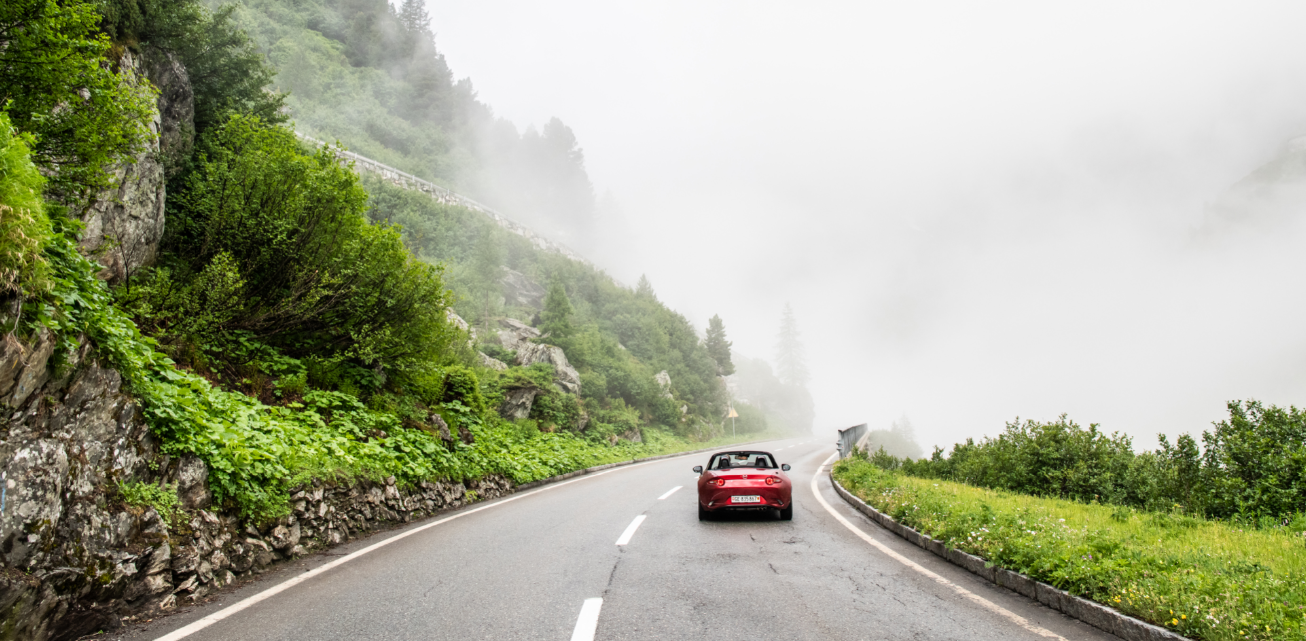
Traveling by Car in Switzerland
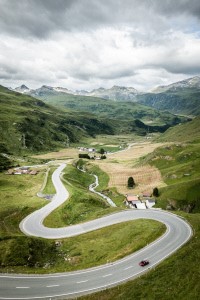
Switzerland has an excellent train and public transportation system, and for most travelers the famously efficient, punctual, and integrated Swiss Travel System is a great way to travel. But there are situations and itineraries where traveling by car might be the best option.
As you plan your trip, feel free to call an Alpenwild destination specialist to help you plan your itinerary and select the best travel method for you. Here are some pros and cons worth considering as you plan your trip:
Reasons to Travel by Car:
- You plan to visit remote areas and small villages with limited public transportation.
- You want to travel primarily on backroads and on roads over the mountain passes.
- You have more luggage than you can easily manage by yourself.
Reasons to Travel by Train:
- Your itinerary involves inn-to-inn hiking and staying in berghotels
- You plan to visit and stay in car-free resorts like Zermatt, Murren, or Wengen
- You want to include mountain excursions and scenic trains like the Jungfrau Railway, the Glacier Express, or the Gornergrat, as well as trams, funiculars, and lake steamers
- You plan on staying primarily in the larger cities (Zurich, Geneva, Lugano, Basel, Bern, Luzern, Lausanne) where driving in the urban center is restricted and parking is a challenge.
- You won't be subject to speeding cameras and fines
Taking the Wheel in Switzerland?
1. Yes, a driver’s license is required in Switzerland
Like a driver’s license is required anywhere else in the world, they are required in Switzerland as well. Individuals must be 18 years or older to drive in Switzerland. An International Driver's License in Switzerland is not required by law—your locally-issued license is all you need—but it can be helpful to have one available while traveling in Switzerland and elsewhere in Europe.
2. Rental Requirements
It is wise to book a rental car before your trip to ensure a vehicle will be ready for you when you arrive to Switzerland. There are many rental companies to choose from. Be sure to research what airport you will be arriving at and what car rental facilities are available there. You don’t want to reserve a car in Geneva if you are flying into Basel, unless you plan on catching a train!
Most Swiss car rental agencies require rental driver to be at least 25 years of age. Some agencies allow younger drivers to rent cars; however, the insurance rates will certainly increase.
When you inspect your rental vehicle at pick-up, be sure to ensure that your car comes with a vignette on the inside of the windshield and a warning triangle (used in the case of an accident). It is required by law to have one of each in the vehicle at all times.
3. Vignette
Any person that uses the Swiss highways must pay for a vignette, also known as the motorway (highway) tax. Vignettes cost 40 CHF each (about $40 USD) and show that you have paid the motorway tax. Most rental cars will come with a vignette. In the case that your vehicle doesn’t, you should be able to purchase a vignette at a border crossing, gas station, or post office. The vignette should be placed on the inside of your windshield, failing to do so could result in a fine.
There are very few toll roads in Switzerland (just a few key mountain tunnels) and the vignette does not cover those tolls. Be sure to plan your routes accordingly. You can buy a Swiss Half Fare card to receive discounts on cable car rides.
4. Light the way
In Switzerland, drivers are required to drive with their car head and tail-lights on day and night, regardless of the weather. Failing to do so can result in a fine. Just don’t forget to turn them off when you leave the car and explore!
5. Speeding Cameras
There are speeding cameras throughout Switzerland, and when you least expect it you'll see a flash, meaning you've been caught speeding. Fines are steep—typically CHF 100 for going just 10km per hour over the speed limit. And when driving a rental car the ticket is sent to the rental car company and then forwarded to you with a 'service charge' of about CHF 30 tacked on top. We know one American who traveled by rental car in Switzerland for about 10 days and came home to a stack of speeding tickets totaling over $1500.
6. Road signs
Home to four national languages plus English, road signs are used to visually direct drivers and keep the peace. Here is a Switzerland sign guide:
- Red triangles warn
- Inverted triangles mean “No right of way”
- Blue rectangles & squares direct to something (i.e. like hospital signs in the U.S.)
- Blue circles instruct (i.e. turn right)
- Red circles prohibit certain things (like the red circle with a slash in the U.S.)
- Grey and white circles or rectangles tell you what is ending (speed zone, train lane etc)
- Yellow diamond indicates when a highway starts or begins
- Green roadway with an overpass indicates the beginning or end of a motorway - watch for a speed limit change
- Orange arrows indicate detours
(1).png)
Now you’ve got the basics to eoy your self-guided Alpenwild road trip! If you have second thoughts and would rather join a guided tour, don’t hesitate to contact your Alpenwild Destination Specialist or email [email protected] . We are certain you will fall in love with Switzerland just like we have!
Other Switzerland Driving Do’s and Don’ts:
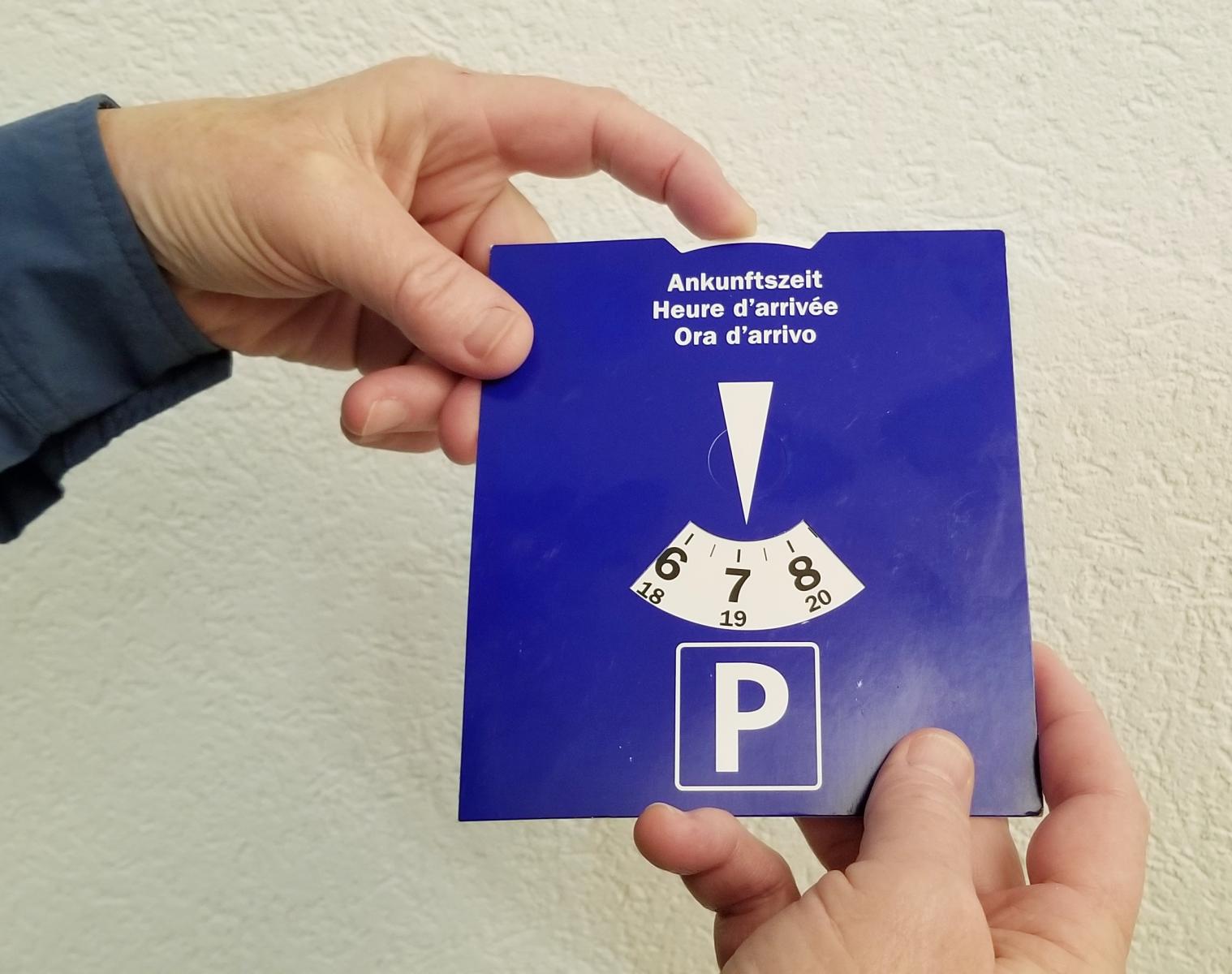
- Swiss are very obedient when it comes to speed limits. Hidden speed cameras are located throughout Switzerland. And the fines are stiff. If you’re speeding in a rental car, the ticket will be sent to the rental car agency and passed on to you weeks or even months after your visit, with a processing surcharge tacked on top.
- Pedestrians have the right of way at any crosswalk. Swiss drivers will always stop for pedestrians, even before they step foot into the street. Always yield the right of way to pedestrians.
- Right turns on a red light are prohibited in Switzerland.
- You may not text while driving, but you may use hands-free cellular features.
- Parking can be difficult to find. Do not park on sidewalks or pedestrian paths.
- Blue zones require a blue tag to be displayed to park in the zone, be aware of the parking time limit, and adjust the parking time dashboard dial that often comes with rental cars. (See image to the right; adjust the dial to match the time of arrival.)
- Red zones require red tags to be displayed to park in the zone, be aware of parking time limits.
- Park and ride lots allow you to pay for, park, and ride on public transportation.
- If you can find them, solid white lines indicate free, unlimited parking along the street.
Grand Tour of Switzerland
To give automobile travelers the best possible experience, Switzerland Tourism has come up with the Grand Tou r of Switzerland , a well-marked, pre-planned, suggested driving routes throughout Switzerland, and supported with a map and guidebook. The route is both comprehensive and adaptable. It takes you from palm-lined lakeshores to glistening glaciers; from quaint medieval villages to buzzing cities. You’ll discover Switzerland at your own pace, but with lots of inspiration at your fingertips.

You May Also Enjoy
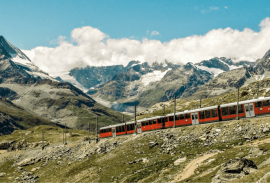
Train Travel in Switzerland
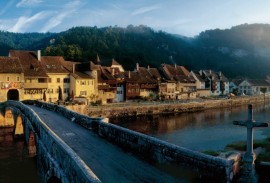
Self-Guided Alps
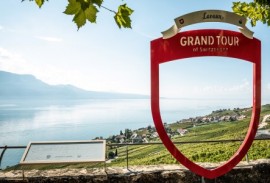
The Grand Tour of Switzerland

Sign Up for Our Email Newsletter
Stay up to date on the latest Alpenwild news. You're free to opt out at any time. See our Privacy Policy .
See our Privacy Policy .
Travel to Zurich by Car
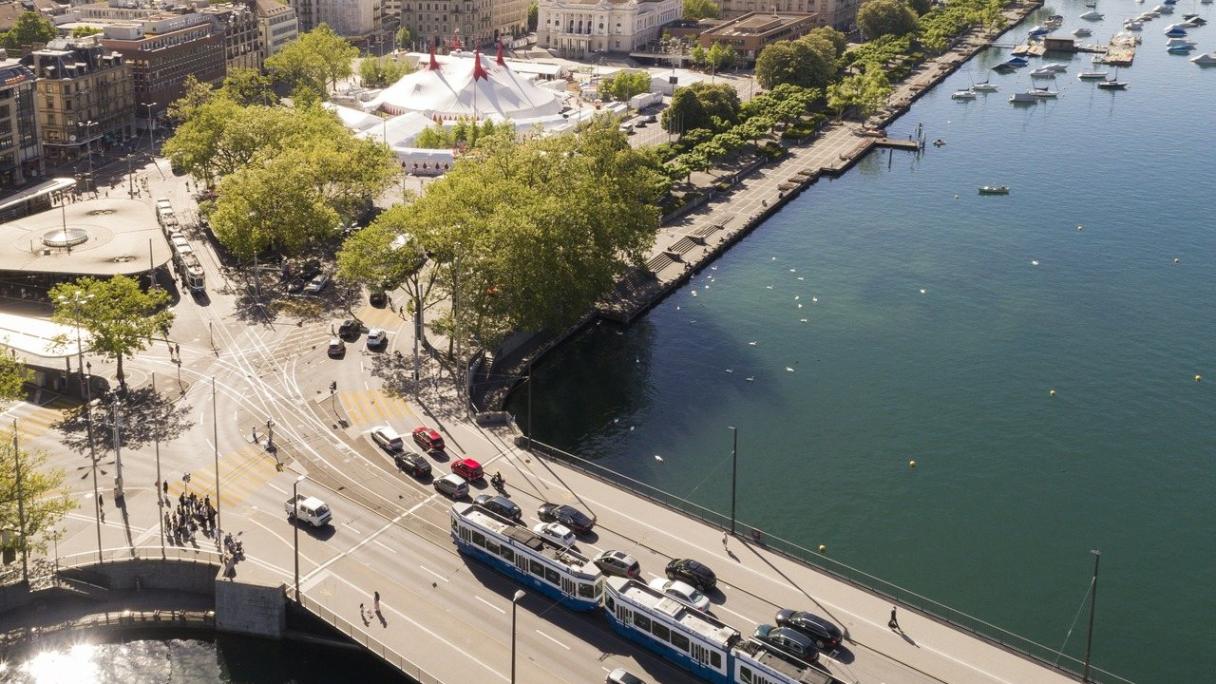
Thanks to Switzerland's well-developed national road network, Zurich is easily reached from other large Swiss cities and neighboring countries in a short time.
The speed limit on Swiss motorways is 120km/h, and that of urban motorways between 60 and 100 km/h. There is a toll to pay for the use of most motorways. The motorway toll, Vignette, comes in the form of a badge and costs CHF 40 per year and vehicle. The motorway Vignette is available for purchase at post offices, petrol stations and TCS offices (Touring Club Switzerland).
Distance to Zurich
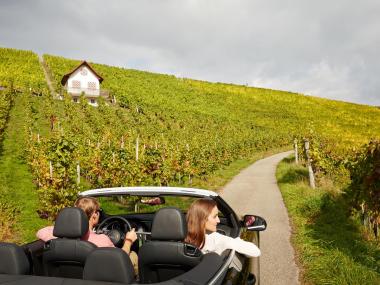
Driving in Switzerland
Are you traveling to Zurich by car? Here you can find some useful information about Swiss traffic regulations.
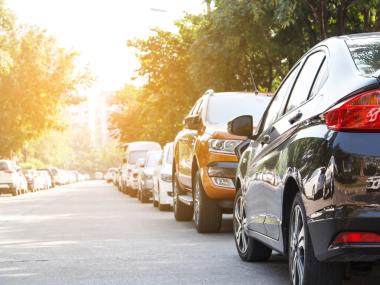
Parking in Zurich
All you need to know about parking regulations in Zurich.
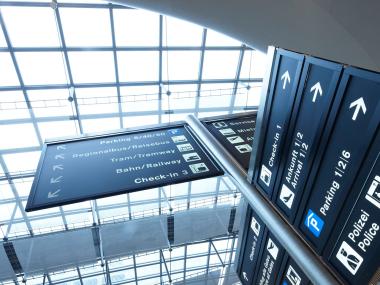
Parking at the Airport
Useful information about parking at Zurich Airport.
Other Stories You Might Like
Multifaceted Zurich
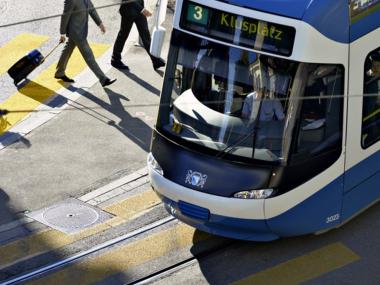
Zürich Card
All benefits, information, and prices at a glance.
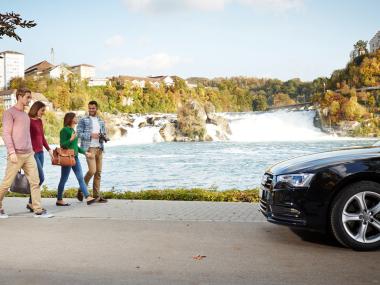
Grand Tour of Switzerland
The Grand Tour of Switzerland leads past cultural and scenic gems. A perfect road trip to discover Switzerland by car.
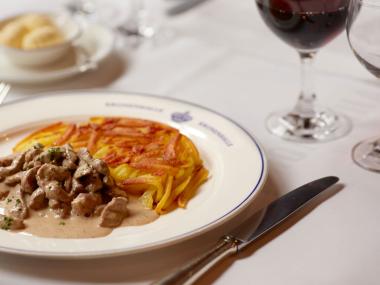
Restaurants in Zurich
Feasting in Zurich: Swiss cuisine, gourmet restaurants and international street food.
Navigate to myswitzerland.com
Destinations
Your swiss holiday time.
Holiday destinations
- Summer holiday destinations
- Winter sports & ski resorts
- Family destinations
Attractions
- Top attractions
- UNESCO World Heritage sites / biospheres
- Travel by train, bus or boat
- Top museums
- Swiss Parks
- Scenic nature
Experiences
Additional content about subnavigation experiences.
- Family excursions
- Food & Wine
- Group excursions
- Guided tours
Summer & Autumn
- Bicycle & Mountain bike
- Adventure & Sports Summer
- Zoo & animal experiences
- Ski and snowboard
- Cross-country skiing
- Snowshoe and winter hiking
- Tobogganing
- Winter excursions
- Christmas in Switzerland
Cities & culture
- Parks, Gardens and Squares
- Architecture
Experience Tour
- Car, motorcycle - Grand Tour
- Train, bus, boat – Grand Train Tour
- Mountain excursions
Accommodation
- Typically Swiss Hotels
- Wellness & Spa
- Family Hotels
- Bike Hotels
- Boutique Hotels
- Inspiring Meeting Hotels
- Swiss Historic Hotels
- Luxury hotels
- Winter sports hotels
Other types of accommodation
- On the farm
- Bed and Breakfast
- Mountains huts
- Group accommodation
Transport & Stay
- Travel to Switzerland
- Barrier-free travel
- Tickets public transport
- Service & support
- Money and shopping
About Switzerland
- General facts
- Custom and tradition
- History of Switzerland
- The Swiss Art and Culture Scene
- Health Travel
- Sustainability
Weather & Climate
- Climate in Switzerland
- Snow Report
- Water and pool temperatures
- City offers
- Touring offers
- Wellness offers
- Nature and outdoor offers
- Offers for families
Where are you from?
- België (Nederlands)
- Belgique (Français)
- Deutschland
- Netherlands
- Russia (Россия)
- Schweiz (Deutsch)
- Suisse (Français)
- Svizzera (Italiano)
- Switzerland (English)
- United Kingdom
- Canada (English)
- Canada (Français)
- China 中文简体
- China 中文繁体
- Gulf countries العربية
- Japan 日本
- Korea 한국어
- United Arab Emirates
- New Zealand
- International
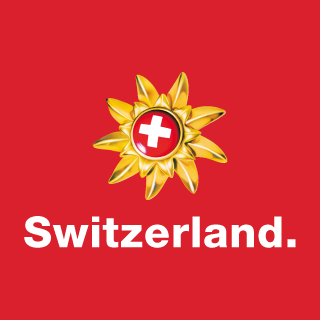
Language, region and important links
- Slovenština
Service Navigation
- Help & Contact
Travel by car
Designated disabled parking spaces are available. These can be used by people who are in possession of a disability ID. Place the disability ID inside the windscreen or in any other clearly visible spot.
- Foreign visitors who are in possession of an equivalent disability ID issued in their country of origin can park in disabled parking spaces https://asa.ch/strassenverkehrsaemter/parkierungserleichterung-fuer-gehbehinderte-personen/ , further information in the leaflet, e.g. area of validity of the disabled parking card
- Disabled parking spaces: https://www.paramap.ch/
- Europcar enables people with disabilities and their companions to get around quickly and conveniently. A modern fleet of VW Caddy Maxis has been specially converted to meet the needs of disabled people and their companions. https://www.europcar.ch/mobility-for-disabled-people
- Other providers: Enquiries to Procap (information office for barrier-free travel): [email protected]
Disability transport services
- handi-cab suisse Schweizerischer Verband der Behindertenfahrdienste (Swiss association of disability transport services): https://www.handi-cab.ch/verband / > Members
- easyCab offers paramedic-accompanied stretcher transport and wheelchair and ambulatory transport throughout Europe: http://easycab.ch/kontakt/
- The Claire & George Foundation offers tours with driver/tour guide, e.g. the Accessible Grand Tour of Switzerland
More information about barrier-free travel
Assisted rail travel, barrier-free accommodation, excursions and leisure activities, leisure time for people with disabilities.

How to Get Around Switzerland: A Guide to Swiss Transportation
Wondering how to get around Switzerland? This guide will help you learn how to use the public transportation system and how to get around by car.
Don’t have time to read a bunch of reviews and blog posts? Here are our top picks for visiting Switzerland:
Wanderlust switzerland guide.
Need a quick day-by-day, open-and-go itinerary for Switzerland? Get my guide and let me do the work for you!
Our favorite Hotels in Switzerland
- Zurich : Baur Au Lac
- Lucerne : Burgenstock Alpine Hotel & Spa
- Zermatt: The Omnia
- Interlaken : Victoria Jungfrau Grand Hotel
- Bern : Hotel Schweiserhof
- Geneva : Swiss Luxury Apartments
- Montreaux : Eurotel Montreaux
Getting Around Switzerland
- Unlimited Train Rides : Swiss Pass
- Renting a Car : Cheap Rental Cars or Expedia Cars
Our favorite activities and tours in Switzerland
- Paragliding
- Lindt Chocolate Tour
- Lake Lucerne Cruise
How do I get around Switzerland?
There are many ways to get around Switzerland , the two main ways are using public transportation and renting a car. I’ll highlight the best way to get to each destination below. This Switzerland itinerary can easily be used with either a car or by train.
If you choose to get a rental car in Switzerland, I always recommend using this site to compare rates and cars.
If you choose to use public transportation in Switzerland, I recommend getting the Swiss Travel Pass to maximize your time and save you money. The Swiss Travel Pass offers unlimited train rides on most lines, free or discounted gondola rides, and discounts to many attractions though Switzerland.
I find that it’s especially worth buying the Swiss Travel Pass if you are planning to visit Zermatt because the expensive Gornergratt train is quite expensive, and it’s half off with the pass. If you’re comfortable riding trains and buses, I think it’s the best way to travel in Switzerland.
Where do I purchase my Swiss Travel Pass?
You can purchase your Swiss Travel Pass here . Just select the correct number of days for your Switzerland itinerary and check out. The pass begins on your selected date and runs continuously. The Swiss Travel Pass comes in. 3, 4, 6, 8, and 15 day increments.
Swiss Half Fare Card
If you’re unsure of your dates or the amount of time your Switzerland itinerary will be, it might be a good idea to purchase a Swiss Half Fare Card instead. This pass is good for one month and will offer 50% off most trains. There seems to be less of a discount on shorter journeys. I prefer to purchase the more expensive Swiss Travel Pass just for ease of use while I am in the country. But the Swiss Half Fare Card may be a better option if you are only planning on taking several long and expensive rail journeys. You can purchase the Swiss Half Fare Card here .
Renting a Car in Switzerland
If you want a little more freedom during your trip, you may want to consider renting a car in Switzerland . You’ll have the ability to reach some more off-the-beaten-path places that trains can’t reach. Driving in Switzerland is easy, especially if you’re from the US because they drive on the right side of the road.
Download the SBB App for Switzerland Transportation
SBB App – Public transportation in Switzerland is shockingly punctual, clean, fast, and efficient. The SBB app will tell you when and where to get your trains and buses to take you where you want to go. This is the most important app you’ll need in Switzerland if you’re only traveling by public transportation.
I hope this guide to Switzerland transportation will help you get around the country with ease. Be sure to check out the most beautiful places in Switzerland and our Switzerland Itinerary.
There are lots of pros and cons to renting a car in Switzerland and using public transportation. Here’s a good list
Here is a list of pros and cons for traveling Switzerland by train vs. by rental car:
Traveling by Train in Switzerland
- More scenic views out the window
- Can relax and enjoy the ride
- No need to focus on driving/navigation
- Environmentally friendly
- Arrive directly in city centers
- Less flexibility with schedule/stops
- Can be more expensive
- Limited luggage space
- More flexibility with schedule and route
- Can stop wherever you want
- Usually cheaper than train
- More privacy
- Can carry more luggage
- Less scenic views
- Have to focus on driving
- More planning required for navigation
- Have to find and pay for parking
- More environmental impact
I hope this helps you plan your trip to Switzerland!
The post How to Get Around Switzerland: A Guide to Swiss Transportation appeared first on Wanderlust Crew .
![Wondering how to get around Switzerland? This guide will help you learn how to use the public transportation system and how to get around by car. How do I get around Switzerland? There are many ways to get around Switzerland, the two main ways are using public transportation and renting a car. I’ll highlight the [...] Wondering how to get around Switzerland? This guide will help you learn how to use the public transportation system and how to get around by car. How do I get around Switzerland? There are many ways to get around Switzerland, the two main ways are using public transportation and renting a car. I’ll highlight the [...]](https://img-s-msn-com.akamaized.net/tenant/amp/entityid/AA17Mj4i.img?w=768&h=512&m=6)

10 Best Places To Visit In Switzerland By Car
Travel author
I have a passion for the English countryside and especially anywhere in Yorkshire. I drink far too much Yorkshire tea on my travels and even take it with me when abroad. My passion is to share travel experiences with my readers which may help them plan their holidays and save money.
As an Amazon Associate, I earn from qualifying purchases
Switzerland is home to beautiful lakes, breathtaking mountains, and chocolate.
The country might look tiny on a map, but every inch of it is gorgeous. While flying is fast and economical, there is something about driving to a specific location.
Read on to find out the best places to visit in Switzerland by car.
Table of Contents
Best Places To Visit In Switzerland By Car
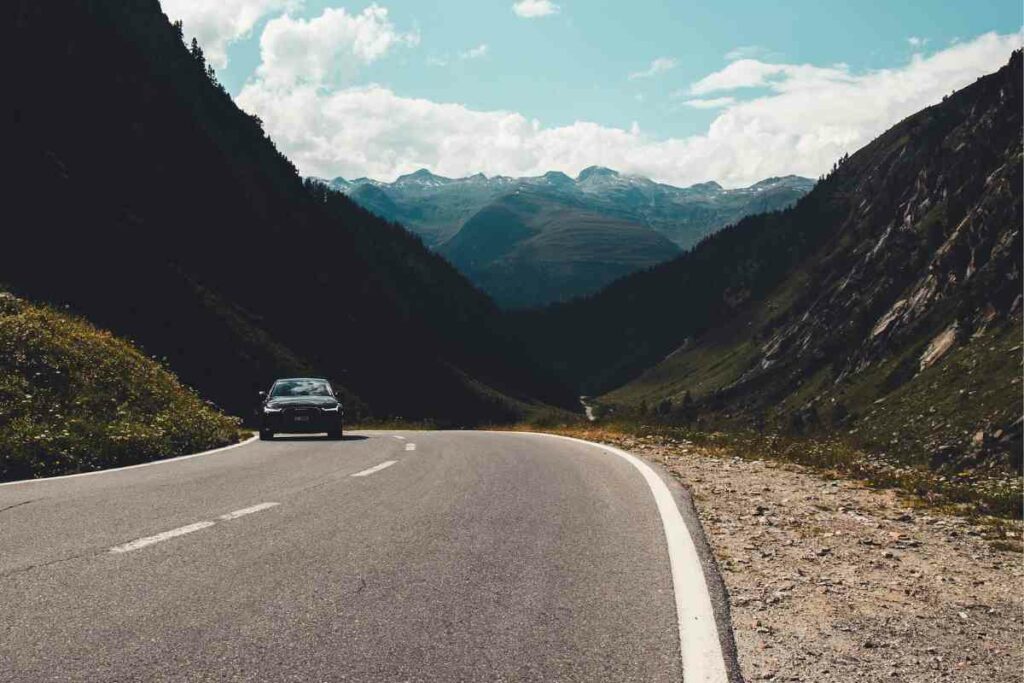
Switzerland is packed with mountains, lakes, medieval castles, old villages, and beautiful towns.
If you are planning to explore Switzerland by car, here is a list of the best places to visit.
1. Lake Lucerne
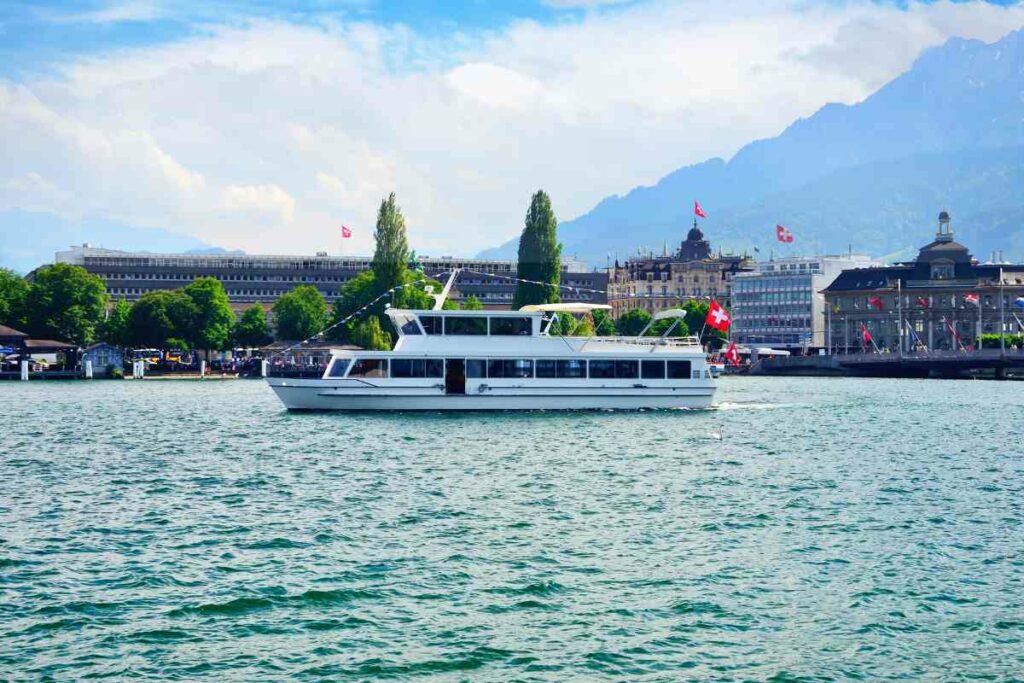
Lake Lucerne is a glacial lake that was formed about 12 000 years ago. It is surrounded by four cantons Usi, Schwyz, Unterwalden, and Lucerne.
The lake is about 44 square miles and 702 feet deep.
Lake Lucerne has 9 bays and each one of them is breathtaking:
- Bay of Lucerne
- Bay of Weggis
- Bay of Gersau
- Kreuztrichter
- Bay of Stands
- Lake Alpnach
- Bay of Horw
- Lake Kussnacht
To visit Lake Lucerne by car, start at the city of Lucerne and drive to Burgenstock. It is a 30-minute drive.
From there you can go to Rutli which is about 40 minutes further.
To finish the Lake Lucerne road trip, head over to Meggenhorn which is about 2 hours away.
With a total of 3 hours drive, you will be able to visit all of the Lake Lucerne bays and enjoy the breathtaking view.
2. Lake Geneva
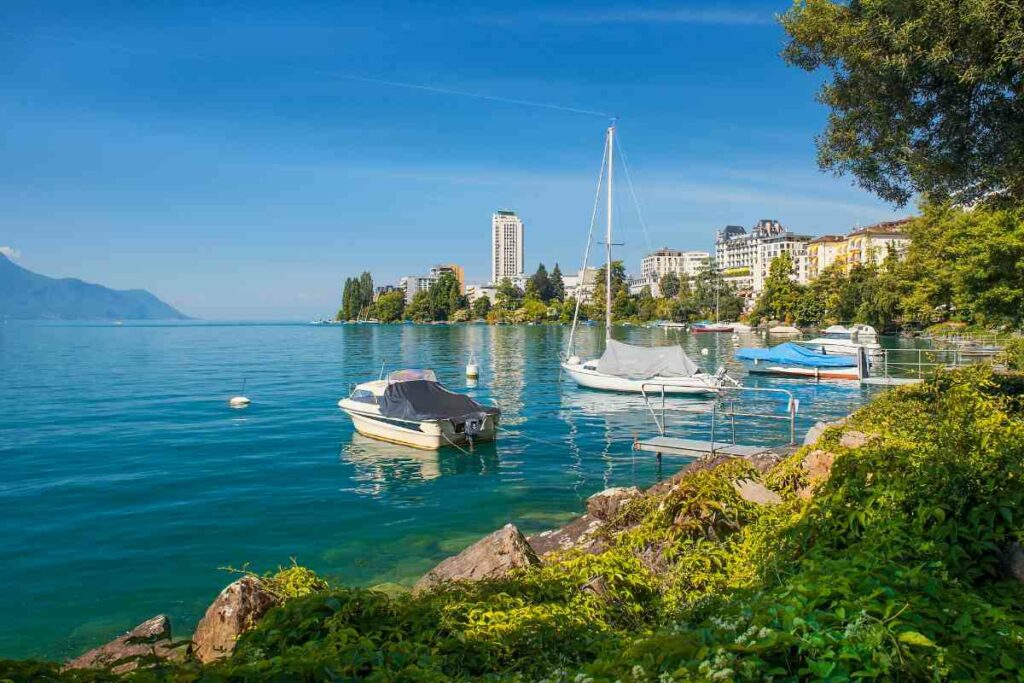
Lake Geneva is located between southwest Switzerland and Southeast France.
The lake is 134 square miles on the Swiss side and about 90 square miles on the French side.
Lake Geneva is 151 miles away from Zurich, 145 miles from Lucerne, and about 10 miles from Geneva.
You may also like 📖
- Things To Do In Geneva This Weekend (2 Day Guide)
- Free Things To Do In Geneva
- Places To Visit In Switzerland
To get the best out of the road trip around Lake Geneva, visit these places:
- Lake Geneva Public Library
- Blacktoft (Lakefront estate)
- Flowerside Inn (beautiful estate with a view of the lake)
- Glen Annie (A famous house with a view of the lake)
- Cedar Point Park (Beautiful park with access points to the lake)
- Congress Club (Vacation spot founded by Chicago families)
- Yerkes Observatory (It is the largest refracting telescope in the world)
3. Grindelwald
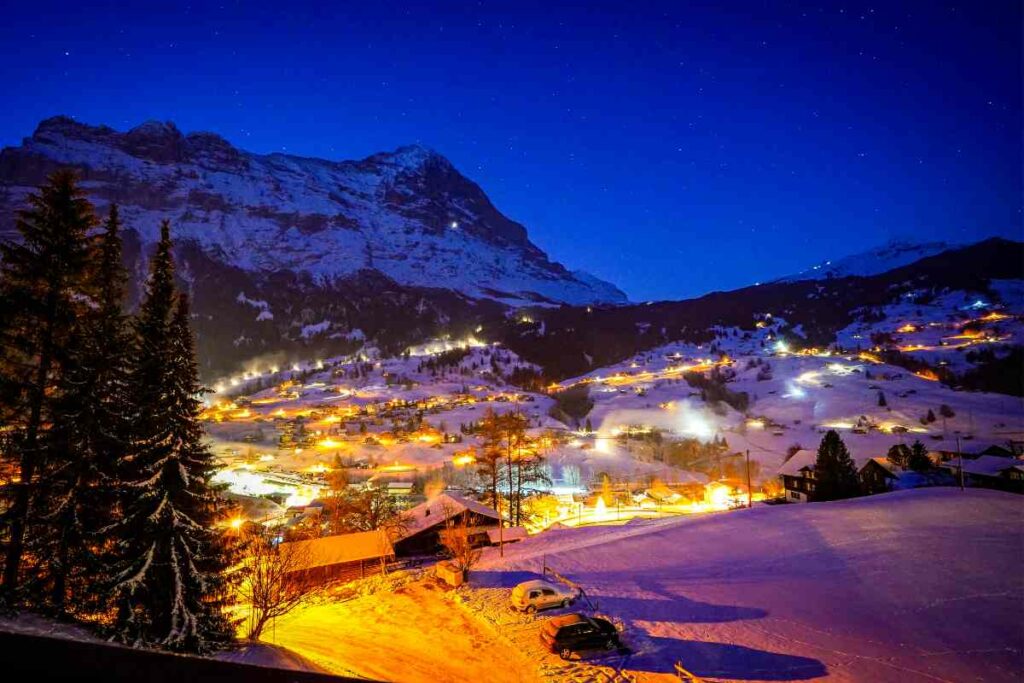
Grindelwald is a mountain village 3,392 feet above sea level.
It is located in the Interlaken-Oberhasli administrative district (canton of Berne).
Grindelwald is 85 miles away from Zurich, 53 miles from Lucerne, and about 46 miles from Berne.
Grindelwald is also known as a hiker’s paradise. The cliff walk built into the side of the rocky mountain offers a breathtaking view of an alpine lake.
Apart from hiking you can hop on a zip line, ride a cart downhill, or pedal a Trottbike scooter down the mountain.
The activities in Grindelwald cost:
- Cable car: 32 CHF (Swiss Franc) per person
- Zip Line: 31 CHF
- Cart: 12 CHF
- Trottbike scooter: 21 CHF
4. Interlaken
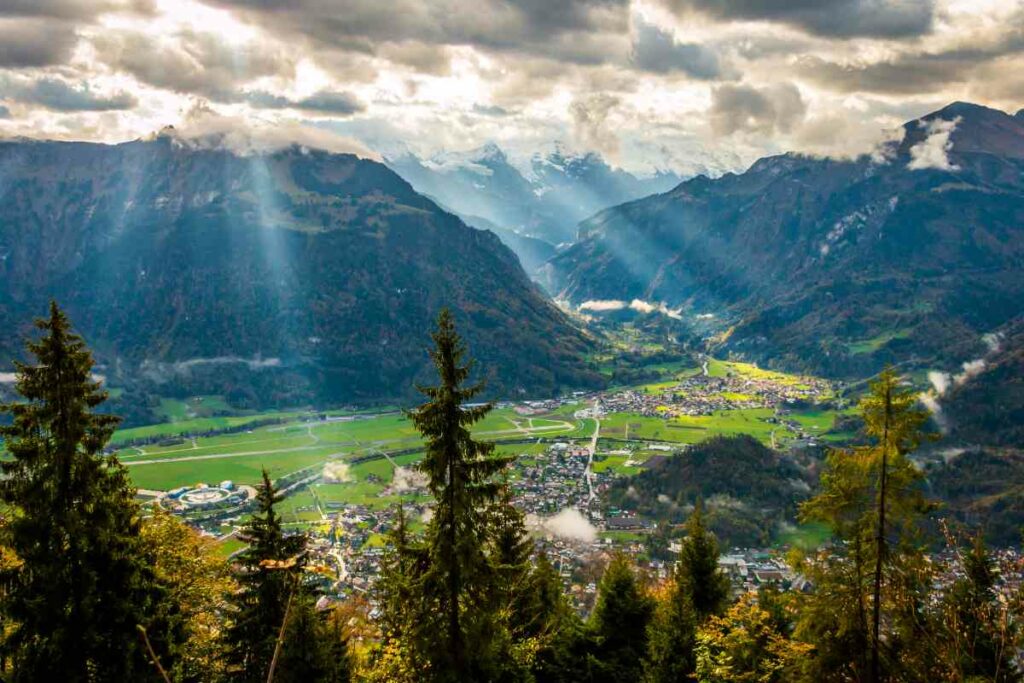
Interlaken is also known as the oldest and most popular summer holiday resort in Switzerland.
The first visitors came in the 17th century, and more and more people are visiting the place since.
Interlaken is 35 miles away from Bern, 42 miles away from Lucerne, and about 73 miles from Zurich.
There are six lakes around Interlaken: Lake Thun, Brienzersee, Blausee, Bachalpsee, Oeschinensee, and Engstelensee, each one more beautiful than the previous.
While in Interlaken, you can hike the Schynige Platte trail, visit the St. Beatus cave and waterfalls, paraglide, cruise the lakes, or kayak on lake Brienzersee.
Best Viewpoints in Interlaken include:
- Harder Kulm (altitude 4337 feet)
- Sigriswil Panorama Bridge (altitude of 1000 feet)
Guide for Women & Men
- What To Wear In Switzerland
5. St. Moritz
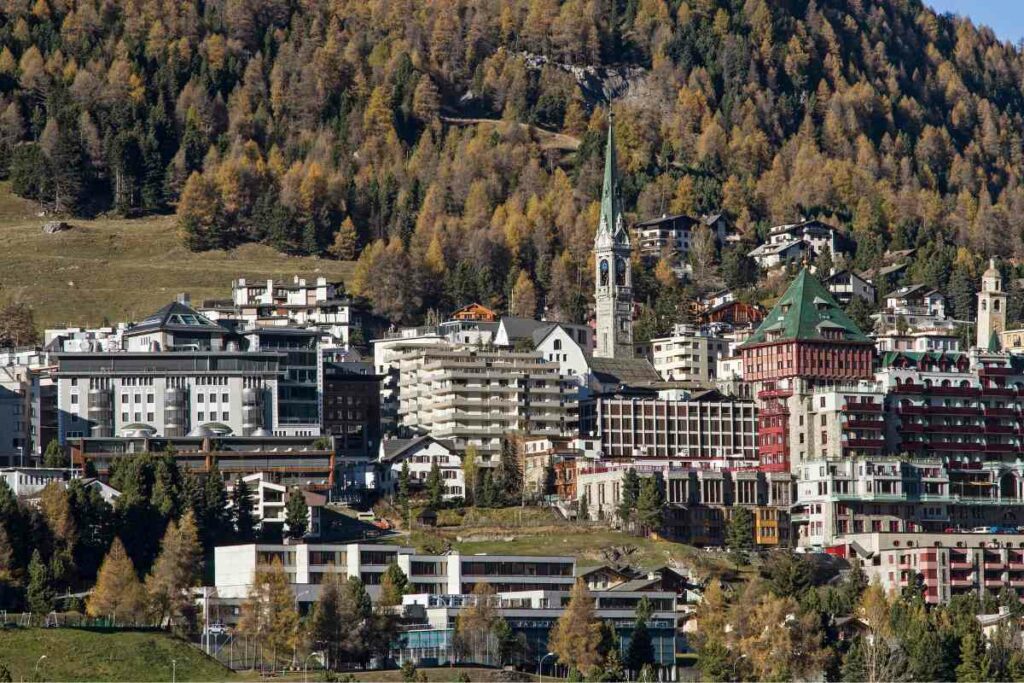
St. Moritz is located in Engadine, Switzerland, and it is a high Alpine resort town.
With an elevation of 5,910 feet above sea level, St. Moritz is a skiers’ paradise. St. Moritz is 126 miles away from Zurich, 140 miles away from Lucerne, and about 200 miles away from Berne.
It is reachable by car, but you have to make sure that you have winter tires and chains if visiting in winter.
Once you get to St. Moritz, there are a lot of fun activities to do, including:
- Skiing and winter sports
- Take a cabin cable car to Corviglia station
- Ride in the Glacier Express (from St. Moritz to Zermatt)
- Hike around the St. Moritz Lake
- Enjoy water sports in the nearby lakes
7. Lauterbrunnen Valley
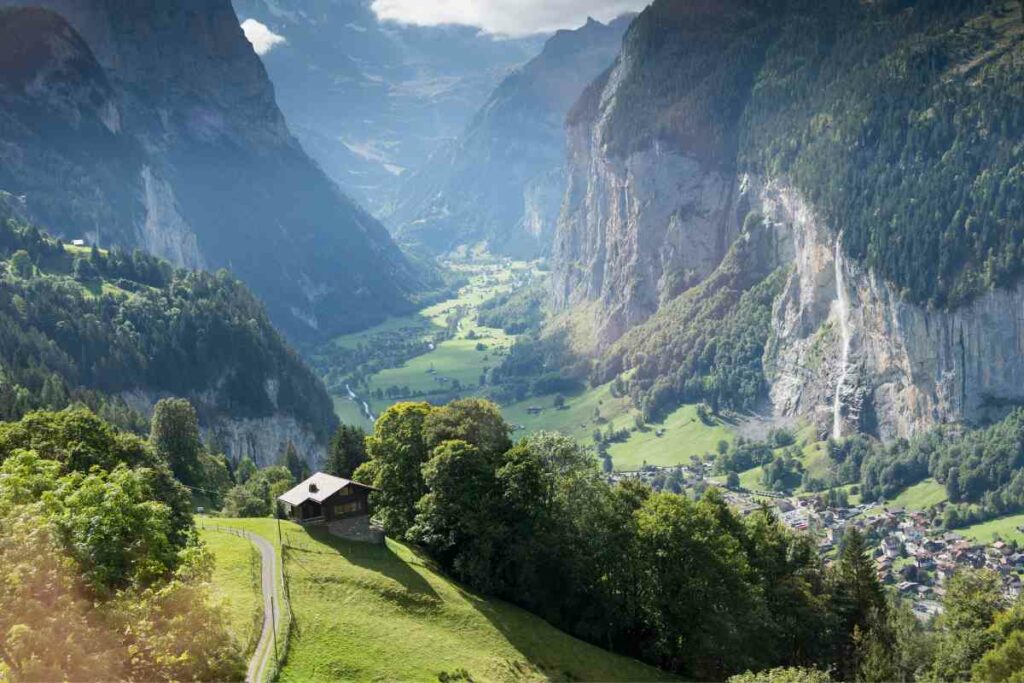
Lauterbrunnen is a small village in the canton of Bern, Switzerland.
The Lauterbrunnen valley is one of the most beautiful valleys located in between gigantic rocks and numerous mountain peaks.
There are a whopping 72 waterfalls throughout the Lauterbrunnen valley which makes the place seem surreal.
- Norway vs. Switzerland – Travel Guide
The Lauterbrunnen valley is reachable by car and is 41 miles away from Berne, 49 miles away from Lucerne, and 80 miles from Zurich.
Here are some cool things to do in Lauterbrunnen valley:
- Hike the famous Lauterbrunnen – Muren Trail
- Visit Staubbach Falls (the largest free-fall waterfall in Europe)
- Enjoy the alpine views from Wengen
- Visit the Sphinx Observatory (highest altitude structure in Europe)
- Explore Trummelbach Falls
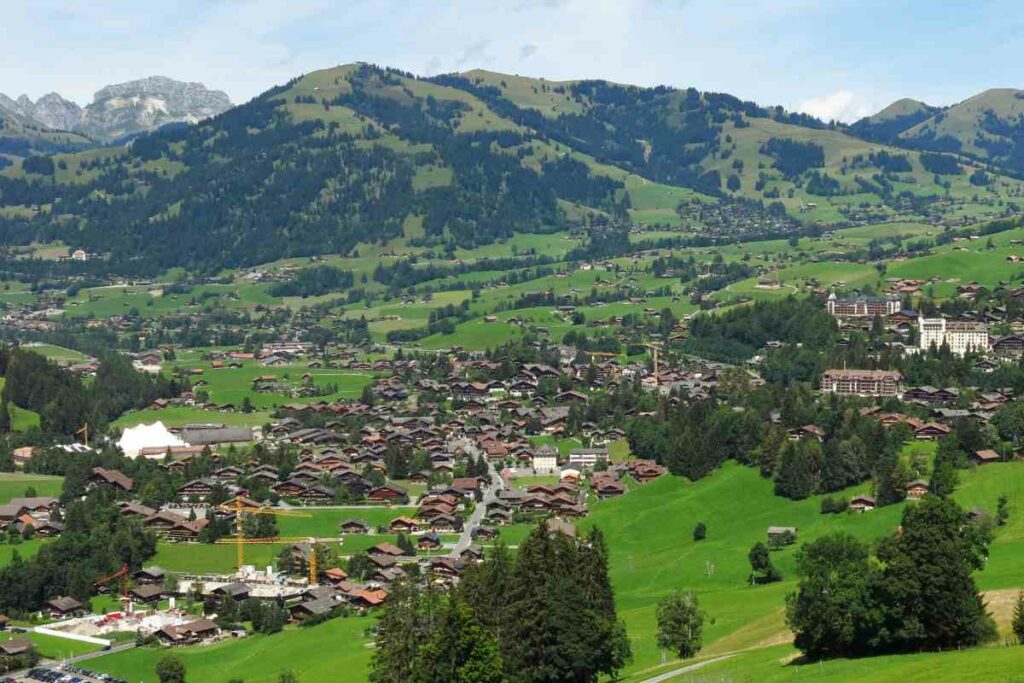
Gstaad is a famous place for hiking and walking trails.
It is a small town located in the Canton of Bern and is 127 miles away from Zurich, 85 miles away from Lucerne, and 53 miles from Berne.
Gstaad is known for winter sports, hiking, outdoor pools, and beautiful lakes.
Here are some fun activities to do while in Gstaad, Switzerland:
- Visit Mount Eggli by a cable car
- See Mirage Gstaad (a beautiful mirror house on the mountain)
- Dine at the luxury hotel The Alpina Gstaad
- Treat yourself at the Spa center at Le Grand Bellevue
- Visit Le Petit Chalet (a cozy log cabin that serves delicious Swiss specialties)
- Ski at Glacier3000
9. Engelberg
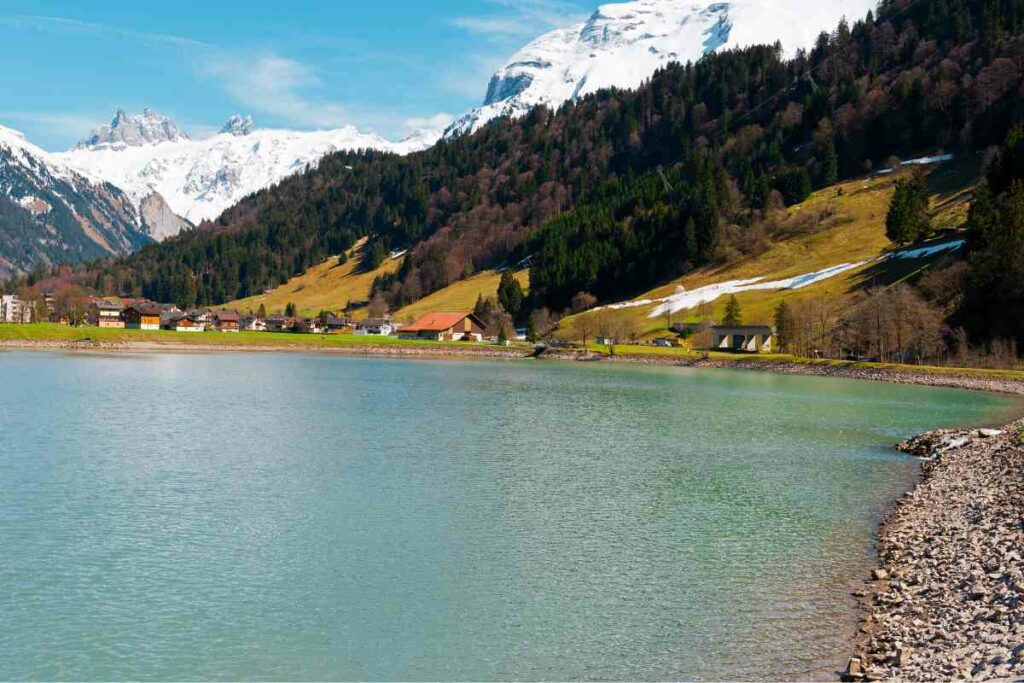
Engelberg is a village resort located in Obwalden Canton, Switzerland.
It is a great place to visit by car and it is 83 miles away from Berne, 22 miles away from Lucerne, and about 53 miles from Zurich.
Before becoming a village resort, Engelberg was a medical monastery.
Here are some fun things to do in Engelberg, Switzerland:
- Visit Engelberg Abbey (Benedictine Monastery)
- Visit Mount Tiltis by gondola
- Cross the 100-meter-long bridge on Mount Tiltis
- Enjoy skiing and snowboarding
- Hike the slopes of Mount Brunni
- Hike around the Truebsee Lake (elevation of 4000 feet)
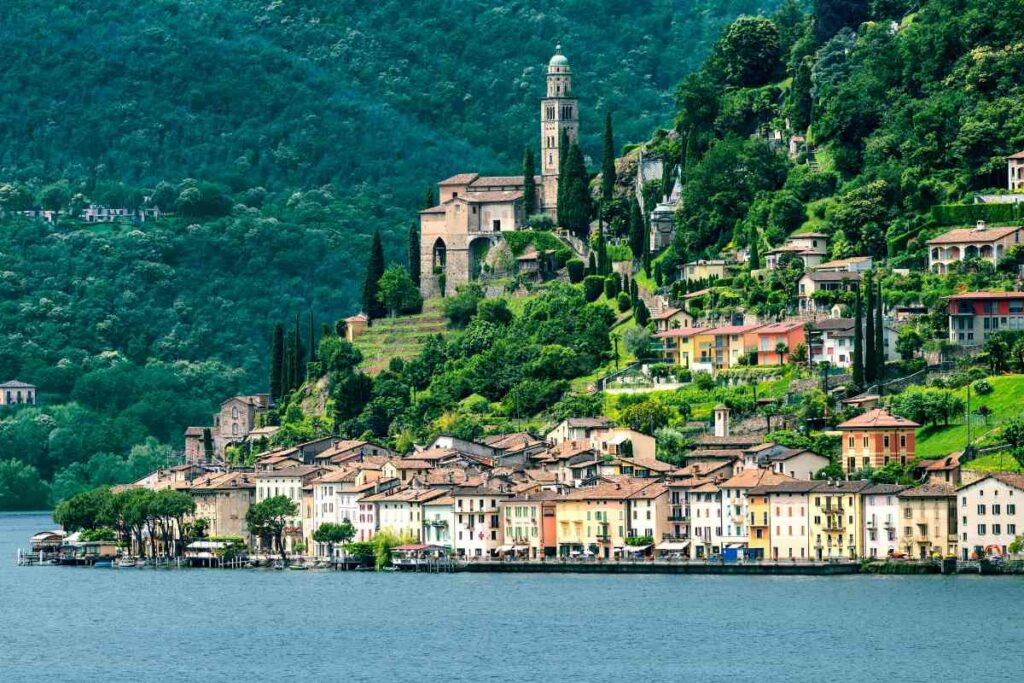
Ticino is a Canton located in the south of Switzerland.
Mainly, Ticino is known for Swiss wine, but it also has beautiful lakes, beaches with palms, medieval monasteries, and delicious cuisine.
By car, Ticino is 134 miles away from Zurich, 111 miles from Lucerne, and 178 miles from Berne.
Here are some cool things to do in Ticino, Switzerland:
- Explore Locarno (a town located on Lake Maggiore)
- Sail to the botanical garden
- Get to the top of the mountain by a cable car
- Explore the Maggia Valley by bike
- Walk along the Maggia River
In Conclusion
Switzerland is known for its mountains, beautiful lakes, chocolate, and winter sports. What is best about Switzerland is that all of its beautiful places are reachable by car.
Book your hotel on Booking.com and start exploring Switzerland by car.
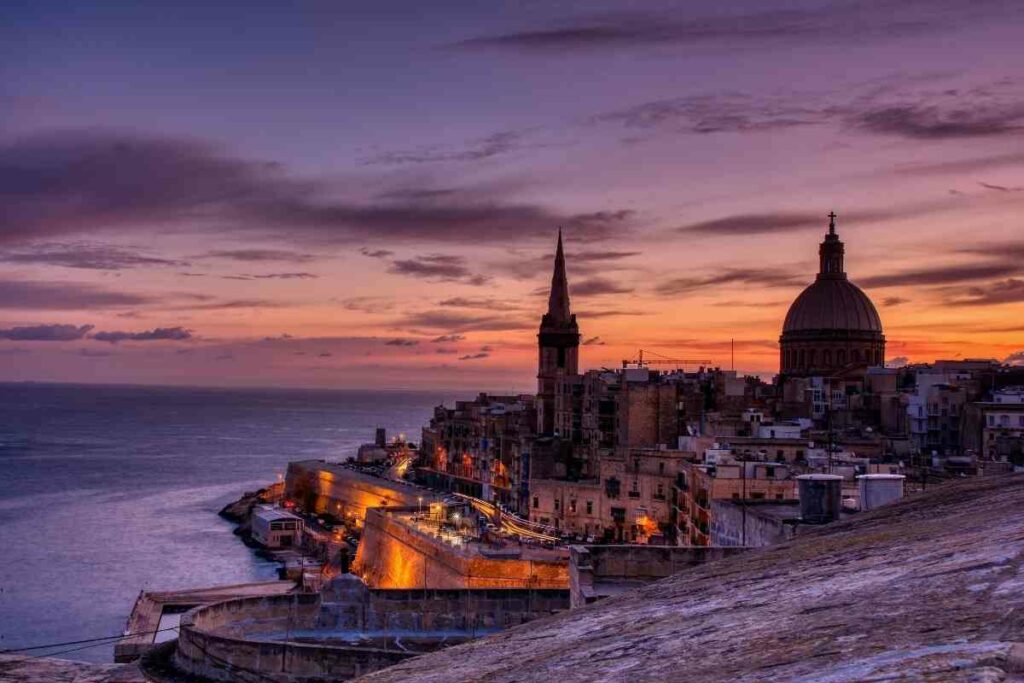
Affiliate Disclaimer
As an affiliate, we may earn a commission from qualifying purchases. We get commissions for purchases made through links on this website from Amazon and other third parties.
Latest posts
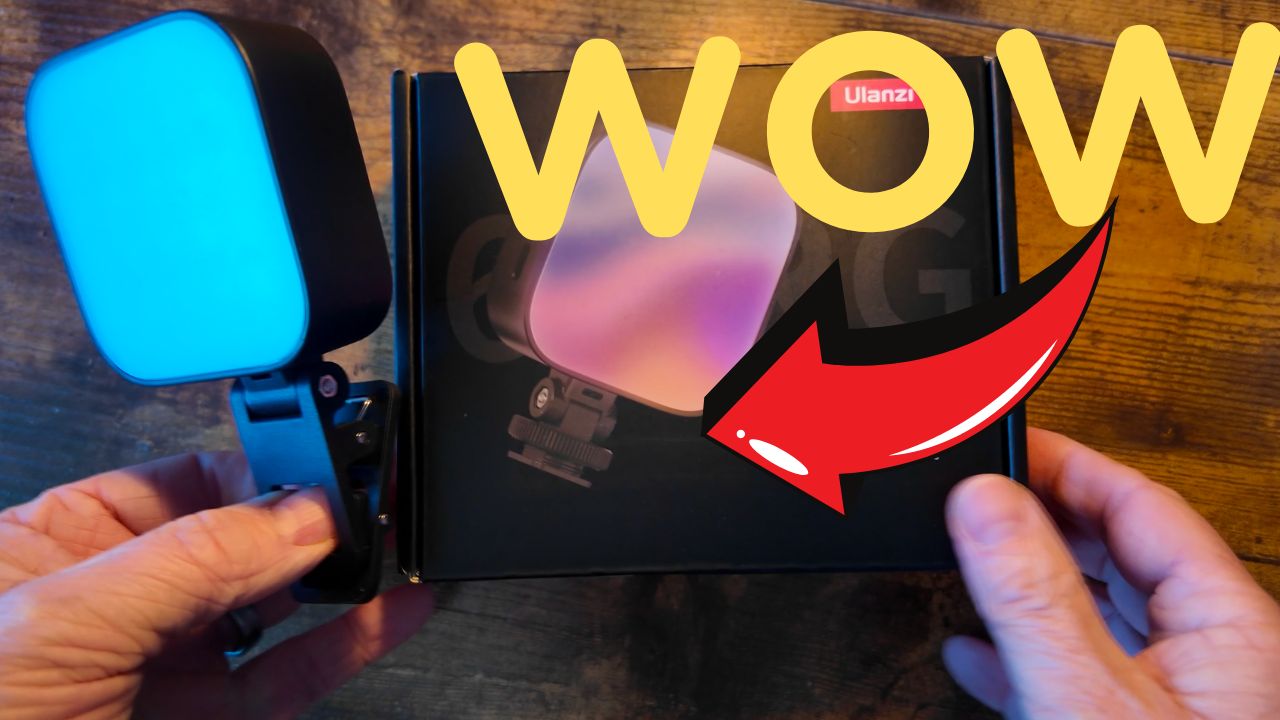
Ulanzi U60 RGB Video Light Review: Top Vloggers’ Choice?
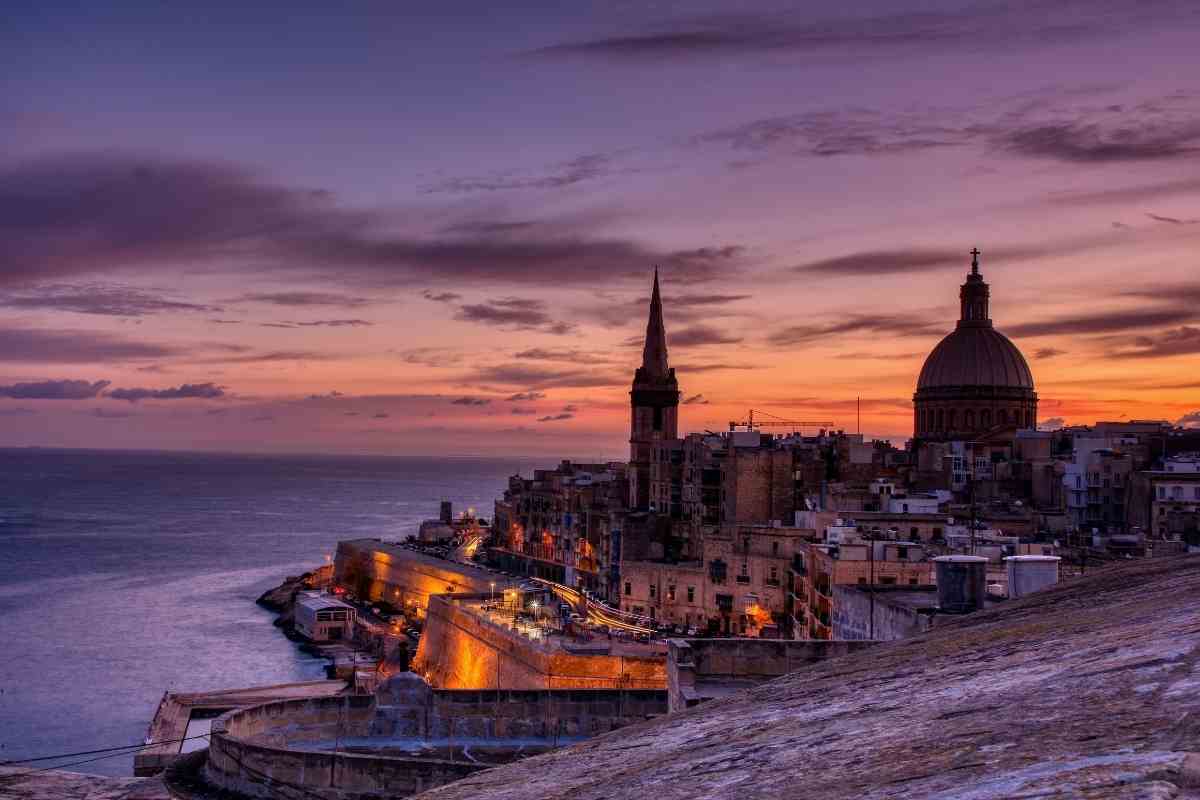
What Is Malta Famous For? Malta Local History and Past Events
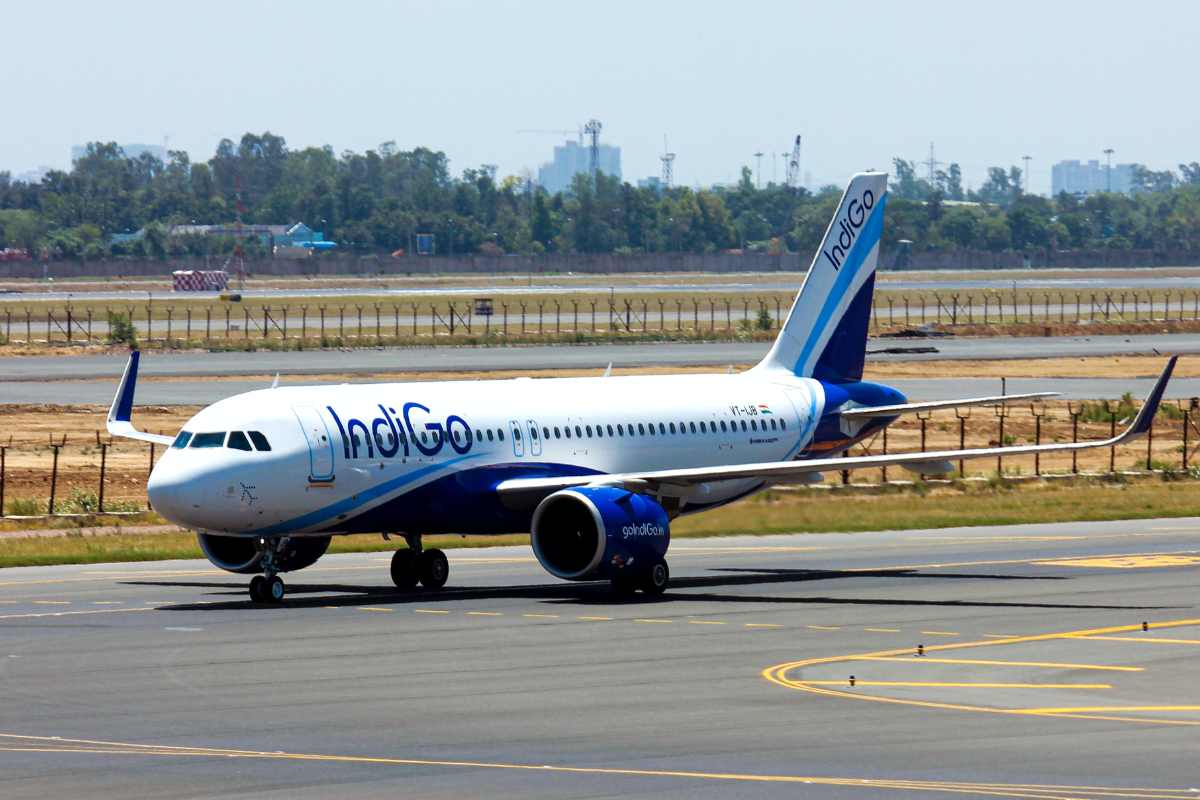
Do IndiGo Airlines Provide Headphones? In-Flight Entertainment Explained

Swiss Vignette Switzerland: Costs & Rules Explained
Greetings, fellow travelers! If you’re planning a road trip through scenic Switzerland, there’s something you need to be aware of before hitting the highways – the Swiss Vignette.
This little sticker is a legal requirement for all vehicles using the Swiss autobahns; it’s your passport to a hassle-free drive on the Swiss motorway network.
Stick with us as we navigate the ins and outs of the Swiss Vignette, ensuring your adventure is as smooth as the country’s famous chocolate!
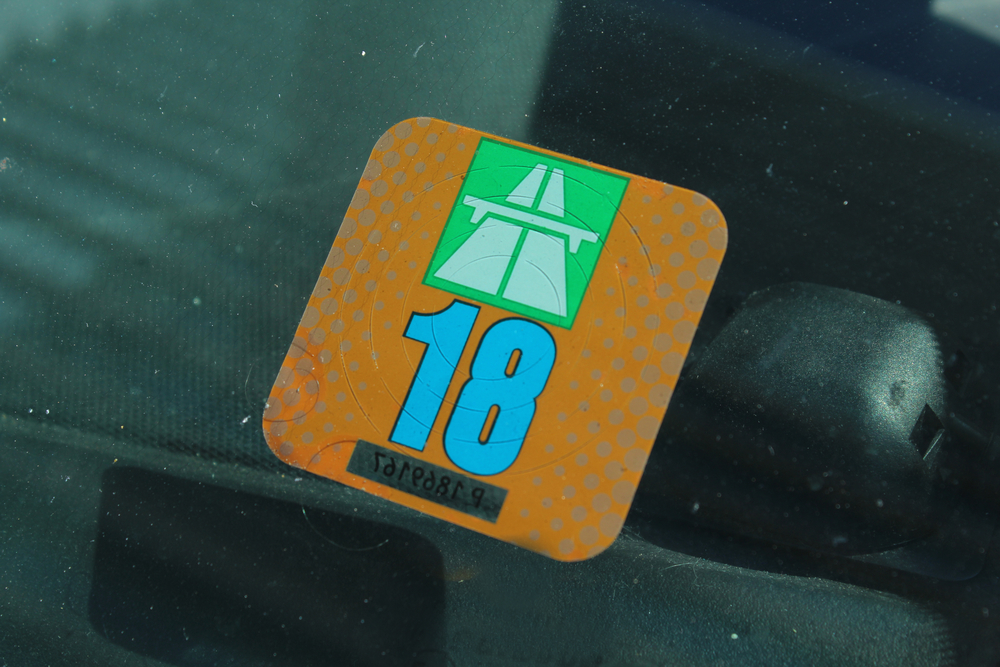
In this detailed guide, we’ll go over everything you need to know to make sure you avoid getting fined on the highway (yes, it happens), including what it is, how much it costs, how long it is good for, and more.
So buckle up, roll down the windows, and let the adventure begin.
What is the Swiss Vignette?
The Swiss Vignette is a small, stick-on toll sticker that lets you legally drive on Swiss highways. The vignette system was implemented in 1985 to help maintain and improve the country’s high-quality road network and ensure everyone contributes to keeping the expressway safe and sound.
The vignette’s function is to give you hassle-free access to Swiss highways during its validity period.
For the most part, it is mandatory as it works like a road tax sticker for all motor vehicles and trailers, including cars, motorcycles, and large vehicles.
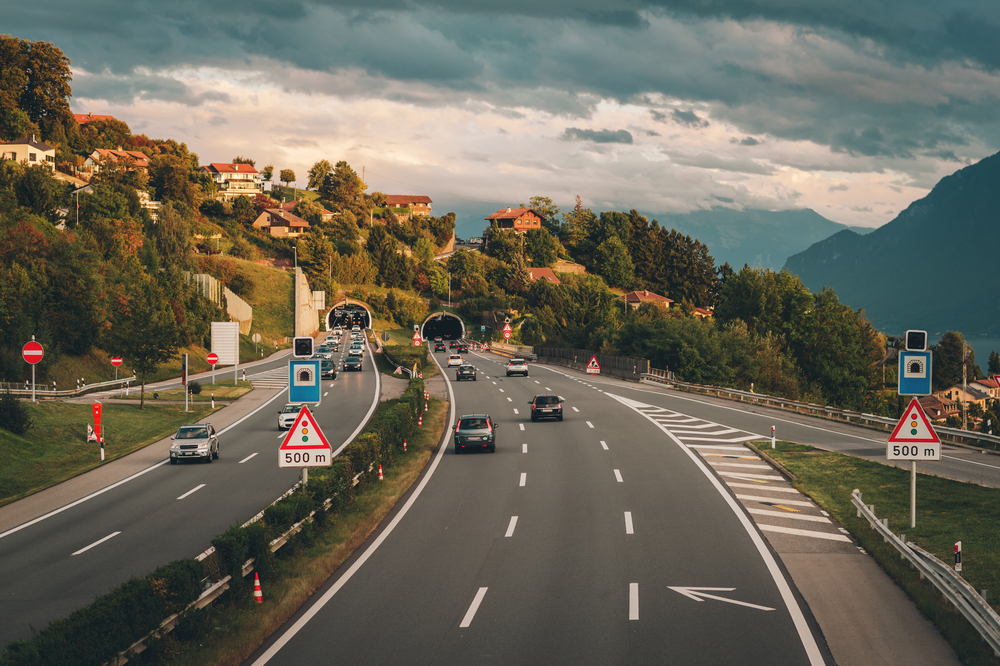
How Much Does a Swiss Vignette Cost?
Let’s break down the costs involved:
- For private cars costs CHF 40 (45 USD), while a vignette for motorcycles will cost you CHF 32 (37 USD). For large vehicles (over 3.5 tons), the price increases to CHF 100 (114 USD), and an additional CHF 150 (172 USD) for trailers.
- The validity of the 2023 sticker is from 1 December 2022 until 31 January 2024, for example. So it is not valid for a year as such. Basically, if you are driving or want to drive in that period, even for a week in that period, you need to have it on your vehicle.
- The electronic vignette (e-vignette) will be launched in a dual system alongside the sticker vignette on August 1st, 2023. The e-vignette will be available through a web shop operated by the Federal Office of Customs and Border Security.
- Another important point is; if you drive without a vignette and you get caught, you will be penalized CHF 200 (229 USD) and must purchase the vignette CHF 40 (45 USD)
To escape fines or other penalties, you must correctly put the vignette on your car’s windshield, so it is clearly visible before you hit the Swiss motorway.
Where to Buy the Swiss Vignette?
The official vignette can be purchased at a variety of authorized points of sale, making it convenient and accessible to both Swiss residents and international visitors.
You can get the Swiss motorway vignette two ways; Online and Offline. Let’s check out both options.

1. Offline Options
- Post Offices : Swiss Post Offices, located throughout Switzerland , also act as official points of sale for the motorway vignette. If you are already in Switzerland and want to purchase the vignette in person, going to a local post office is an easy option.
- Gas Stations : The Swiss motorway vignette will be available at most gas stations near Swiss borders and main entry points into the country. When crossing the border, gas stations with signs indicating the availability of the vignette are easy to see. However, remember that not all petrol stations in Switzerland sell the vignette, so ensure you get it at the first available point of sale or online before you drive.
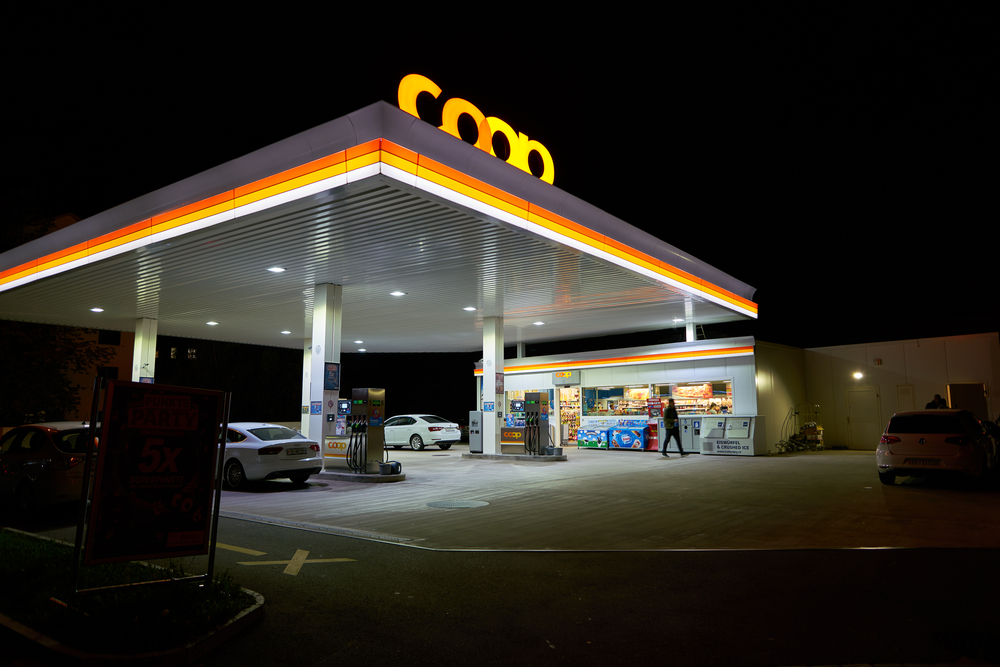
- Customs Offices at Border Crossings: Customs offices at several border crossings in Switzerland sell the motorway vignette.
2. Online Options
In this digital age, purchasing the motorway vignette online has become increasingly popular and offers the advantage of avoiding potential long queues at gas stations!
Several official websites and authorized vendors allow you to purchase the vignette in advance.
All you need is internet access and a valid payment method, and the vignette will be delivered to your doorstep, ready to be affixed to your vehicle’s windshield, before you start your trip.
Use these websites to purchase your Vignette online:
- Official Swiss Motorway Vignette website
- TCS Switzerland
In this case, the delivery may take a few days, and it’s essential to have the motorway vignette sticker displayed on your windshield before driving on Swiss motorways.
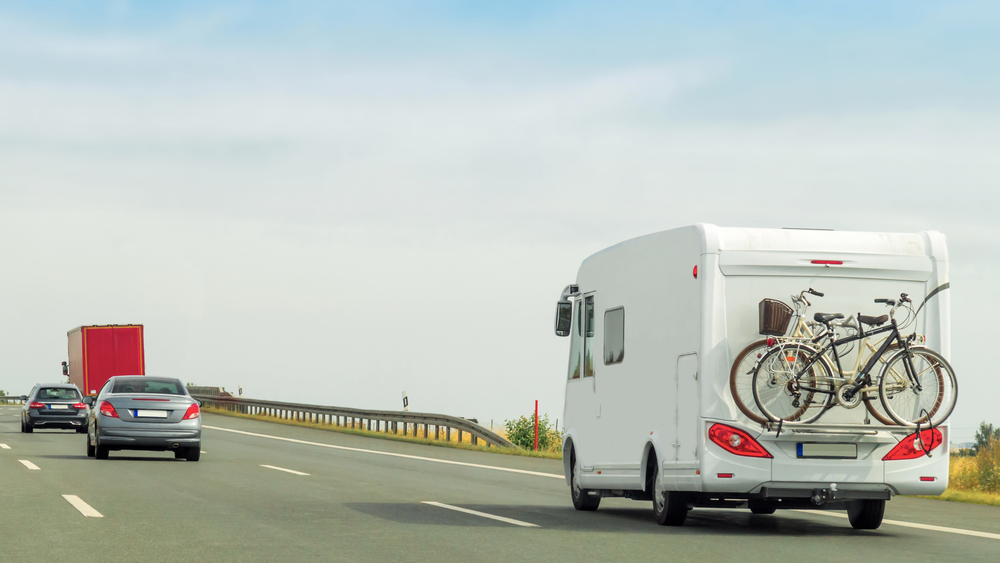
Whether you purchase it offline, at a service station, post office, or online, having the sticker appropriately affixed to your windshield is mandatory.
But, as of 2024, the vignette system is changing. You will be able to buy online and get an e-vignette immediately. This will be related to your number plate, and you won’t need to wait for a physical version.
When to Buy the Swiss Vignette
Buy before you drive. Very simply, you need to have it before you enter the motorway, and that’s it.
Don’t risk not buying it, the fine is expensive, and the Swiss Police keep an eye out for this type of thing, especially since it is now becoming linked to your number plate.
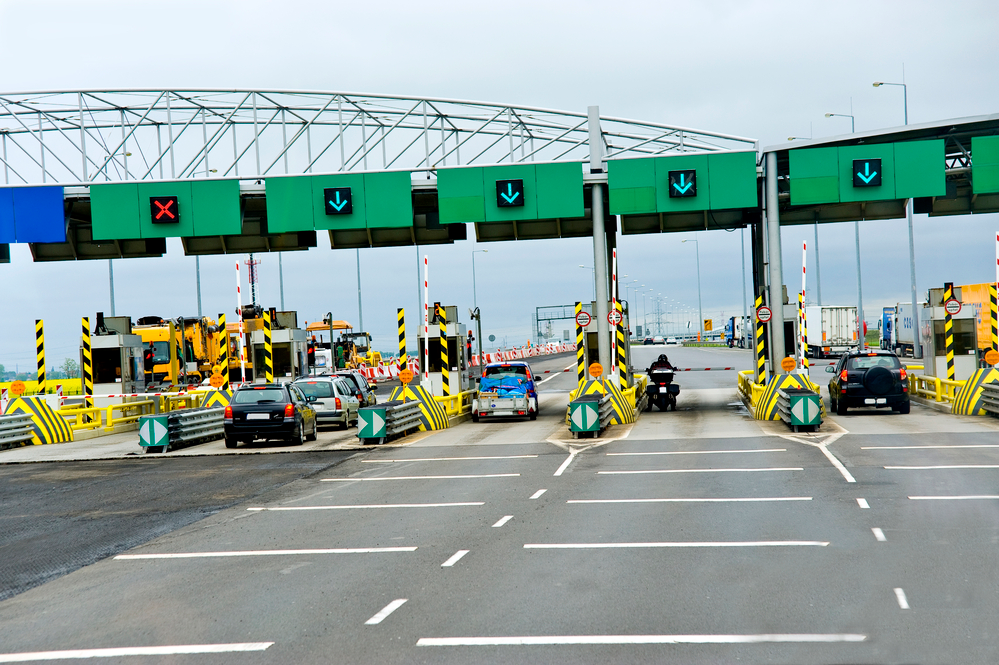
How to Affix Remove a Swiss Vignette
It is essential to apply and remove the vignette carefully. This is one sticky little sticker, and it’s easy to wreck it.
Here’s a step-by-step guide to attaching and removing the vignette:
1. Instructions for Affixing
Before affixing the vignette to your vehicle’s windscreen, ensure the area is clean and dry.
I always go for the inside passenger’s side of the windscreen where it won’t obstruct your view as a driver.
Carefully peel off the backing paper from the sticker and apply it to the glass. Press firmly, ensuring the vignette adheres without any bubbles or gaps.
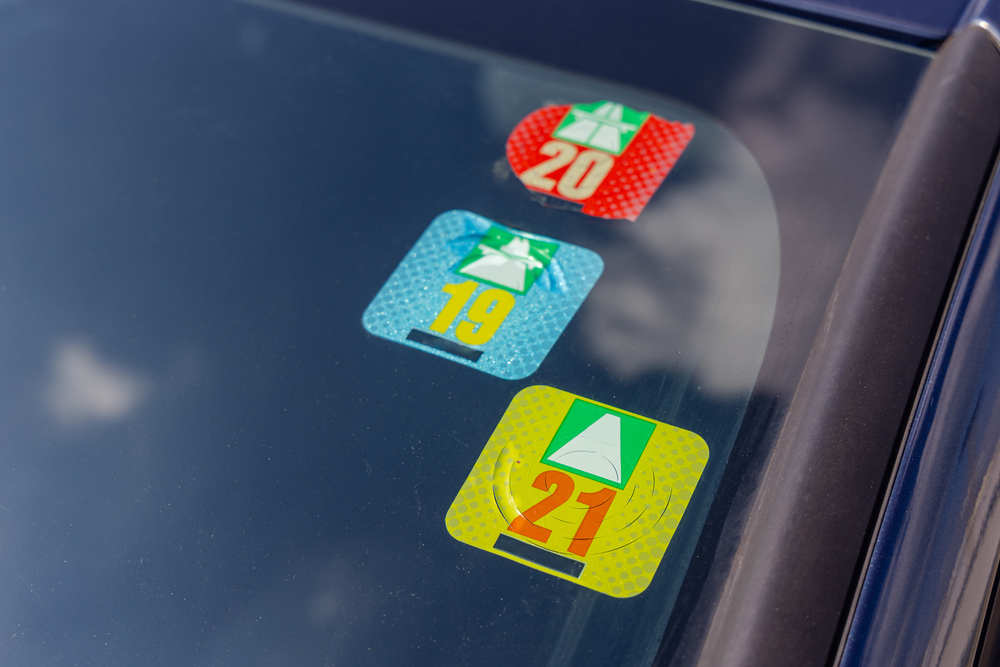
What about removing it? Well, you will see that many people never do! Haha, like the pic above.
But it is actually easy to do; read on.
2. Removal Techniques
When it’s time to remove the motorway vignette from your windshield, the sticker can be quite stubborn and requires a little effort to remove it :
- Scraper/razor blade : Use a plastic scraper, a similar non-abrasive, or a clean razor blade tool to lift the vignette’s edges gently. Once you grip it, slowly peel it away from the glass.
- Heat : Apply heat to the vignette using a hairdryer or a heat gun on a low setting. This method helps soften the adhesive, making it easier to remove the sticker.
- Cleaning Benzene : Apply some cleaning benzene to a soft cloth and gently rub the edges of the vignette. This solvent can help break down the adhesive, allowing you to remove the sticker easily. Please note that you should use benzene in a well-ventilated area, as it can emit strong fumes.
Remember that, once removed, the vignette cannot be re-used or transferred to another vehicle. Purchase a new vignette if you need to replace your windscreen or change vehicles.

Do Rental Cars Have a Vignette Included?
If you’re renting a car in Switzerland, check with your rental company to ensure a vignette is included.
Most rental companies provide cars with vignettes already attached to the windshield. If the rental car doesn’t have a vignette, you’re responsible for purchasing one and attaching it during your rental period.
Renting a car from nearby Italy or France and driving through Switzerland , make sure you buy one!
Can You Drive in Switzerland Without a Valid Vignette?
You can drive without a vignette if you stay off the highways. Most of the time, your trouble is not worth the money you’ll save. But you might not need a valid vignette for short trips to and from Switzerland.
If you want to drive on a highway without a vignette, you must avoid the roads marked with white text on a green background. The word A comes before the number on these roads, another way to tell the difference.
Getting around the highways takes more time. Also, you’ll have to drive more carefully because you’ll use local roads instead. These roads go through towns and have traffic lights and places for people to cross.
I love this couple, they explain everything Swiss so well, and their videos are awesome!
Final Thoughts
Overall, the Swiss Vignette is more than a toll sticker; it is your key to discovering the captivating beauty of Switzerland’s expressway.
The vignette assures you’re on the correct path, both legally and visually, as you travel through the gorgeous Alps, stunning lakes, and charming towns.
To avoid any issues, buy one before you drive; it’s that simple.
Have a safe trip!
Frequently Asked Questions
1. how much does it cost.
The Swiss vignette costs CHF 40 ( 45 USD) per year. This cost covers all national highways and expressways in Switzerland, giving you unlimited access to these roads during the validity period.
2. Do I need to buy one?
You must have a vignette if you plan to drive on Swiss motorways. It is mandatory for all vehicles, including motorcycles and cars, regardless of their country of registration. You don’t need a vignette for local or regional roads.
3 . Where can I buy it?
You can purchase a Swiss vignette at various locations, including at the Swiss border, gas stations, post offices, and online.
As of writing, the e-vignette is now starting to be sold online; it relates to your number plate. It’s best to obtain it before entering Switzerland to avoid any inconvenience.
4. Is there an e-vignette?
Yes!, As of 1st August 2023, the “Via Portal” of the Federal Office of Customs and Border Security (FOCBS) is where you may get your electronic toll sticker (e-vignette).
5. Are there daily options?
Swiss vignettes are only available as annual passes and are valid for the calendar year. There aren’t any daily, weekly, or monthly options available. Therefore, even if you plan to use the motorways briefly, you still need to purchase the annual vignette.
6. Can I avoid tolls?
If you prefer not to purchase a vignette, you can avoid toll roads by taking local or regional roads instead. Remember that this alternative may increase travel time, as these roads are usually slower and busier than motorways. Adjust your GPS settings to avoid highways, and follow the routes marked as “vignette-free roads.”
Leave a Comment
Your email address will not be published. Required fields are marked *
- All Destinations
- Bustling Cities
- Beautiful Towns
- Charming Villages
- Culinary Experiences
- Historical Monuments
- Zoos, Parks and Aquariums
- Image Gallery
- Comparative Analyses
- Hiking Time Calculator
- Travel Information
- Frequently Asked Questions
- Affiliate Disclaimer
- Favorite Resources
- Privacy Policy
Do You Need a Car to Tour Switzerland?
- May 29, 2023 March 13, 2024
- General Information
Last Updated on March 13, 2024 by Admin
Switzerland is famous for its stunning lakes and mountains, charming old towns, and breathtaking natural scenery. If you’re planning a trip to this picturesque country for a few days, weeks, or even months, you may wonder whether it’s necessary to rent a car or if public transportation is reliable enough. This article aims to address this question and provide insights into whether you need a car to tour Switzerland .

Pros and Cons of Driving in Switzerland

Pros of Driving in Switzerland
- Flexibility : If you have a car, you’ll have the freedom to travel whenever and wherever you want. Additionally, you can stop at any scenic spot that catches your eye. Driving in Switzerland is quite safe and roads are easily accessible.
- Scenic Drives : Certain scenic drives in Switzerland, such as mountain passes and secluded mountain resorts or valleys, may not be as easily accessible by bus, making having a car an advantage. With Switzerland being a country filled with winding roads and mountain passes, embarking on a road trip by car can be an exciting and memorable adventure.
- Convenience : Having a car allows you to bring your luggage with you without the hassle of lugging it around on buses and trains. Simply store your belongings in the trunk of your car or van. This can be especially convenient for parents with smaller or multiple children.
- Privacy : When traveling with friends or family, having a car can offer a comfortable and private atmosphere to enjoy the journey together. Additionally, you can have control over the music, temperature, and stops along the way.
- Time-saving : Assuming there is little to no car traffic, having your own car can save valuable time, especially when planning difficult day trips that require multiple train connections. With a car, you won’t have to spend time waiting for the next train or bus to arrive, allowing you to fit more places into your itinerary.
Cons of Driving in Switzerland
- Cost: Renting a car in Switzerland can be expensive, and you will also have to pay for parking. Additionally, parking spot prices in some areas can be quite high, especially if you have to pay per hour. Finally, it is important to be aware of the tricky speed limits in Switzerland to avoid costly fines.
- Traffic : While using a car to drive to secluded places can save you time, driving into cities or popular destinations can mean you are stuck in heavy traffic. During long weekends or school breaks, it’s worth noting that popular driving routes like the Gotthard Pass may experience heavy traffic and long waiting times for those traveling from the north of the Alps to the south and Italy.
- Navigation : Although we have GPS in our cars, reports have shown that relying solely on this technology has led some individuals to the wrong destination or on roads not suitable for cars. Navigating unfamiliar roads can be a challenging and stressful experience. Additionally, narrow and one-way mountain roads can also add stress to driving, as encountering a yellow Post bus coming from the other direction may require reversing to a nearby bay and waiting for them to pass.
- Hazard : If you are not familiar with driving in snowy and icy conditions, it is important to be cautious. In mountainous regions, roads can become extremely slippery, particularly during winter. Additionally, some areas may require special tire chains for safe driving. It is important to take these precautions seriously to ensure your safety on the road.
- Environmental Impact : Compared to driving a car, taking public transportation has a significantly lower environmental impact. Fortunately, Switzerland’s extensive network of trains and buses makes it easy to access most tourist destinations without a car. Additionally, the country has made significant efforts to reduce its carbon footprint.
Public Transportation Options

Switzerland offers a plethora of public transportation options for those who prefer not to drive. With an extensive network of trains , buses, cable cars, and ships , you can easily explore the country’s stunning landscapes. Some of these public transportation options even offer panoramic views, with large windows or open decks to enjoy the high mountain peaks. Examples include the cable cars in Stanserhorn and Männlichen .
In addition to being scenic, public transportation in Switzerland is incredibly convenient. Most areas where people live or work have regular bus and train connections. Tickets are also affordable and easy to purchase. By using public transportation, you can avoid the stress and expense of renting a car, as well as contribute to Switzerland’s efforts to reduce carbon emissions.
Overall, if you have the option to use public transportation, it is highly recommended. You can combine it with renting a car for specific instances, such as exploring a secluded valley or navigating a mountain pass. With so many transportation options available, you can enjoy all that Switzerland has to offer while minimizing your environmental impact.
Popular Destinations and How to Reach Them

A comparison table has been provided below to assist you in making an informed decision based on your preferences and desired accessibility to various destinations in Switzerland. The table lists popular locations that can be reached via both public transportation and personal vehicles. Whether you choose to travel by train or car, this resource will help you determine the best option for your needs.
- Car-friendly destinations are typically those with limited or no public transportation connections, such as mountain passes or hamlets, which is why bringing a car is recommended.
- Train-friendly destinations are those that are convenient to reach by train. These are usually places like Wengen or Zermatt, which cannot be accessed by personal vehicles anyway, or locations with frequent train connections from various cities in Switzerland, making it more practical to travel by train.
Tips for Renting a Car
- Research : To ensure a successful car rental experience, it’s important to conduct thorough research. Browse websites like RentalCars.com to compare cars that fit your needs and budget, and be sure to check for any hidden fees or insurance coverage limitations. Additionally, plan your itinerary and route ahead of time and make yourself aware of local driving rules and regulations.
- Book in advance : To secure availability and the most competitive pricing, I recommend booking your rental car in advance. A helpful resource for booking is RentalCars.com .
- When renting a car : It’s crucial to thoroughly inspect the rental car for any scratches, dents, or mechanical issues before driving it off the lot. It’s also recommended to take photographs of the car beforehand, particularly if you notice any minor scratches or dents.
- While driving the car : It’s essential to drive responsibly and abide by traffic regulations, as well as park the rental car in designated areas. Additionally, keep vital documents and emergency contact information readily accessible.
- When giving back the car : Confirm with the car rental company the rules about filling up the gas tank before returning the vehicle. Additionally, ensure that you return the rental car on time to avoid any additional fees.
Final Thoughts: Do You Need a Car to Tour Switzerland?
Are you wondering if renting a car is necessary for your upcoming trip to Switzerland? One of the benefits of Switzerland is that it has an efficient public transportation system that makes it easy to find departure locations and times. Therefore, you can generally get around without a car. However, there are a few circumstances where renting a car might be beneficial, such as if you plan to visit secluded areas that are not easily accessible by public transportation, or if you have a lot of luggage or are traveling with children and need extra space. Additionally, if you enjoy driving scenic routes, renting a car can be a great way to explore Switzerland’s stunning landscape.
If you’re planning on staying in major cities and towns, public transportation is a convenient and cost-effective option. Switzerland has an extensive network of trains, buses, and trams that connect cities and towns throughout the country. The Swiss Travel Pass is a popular option for visitors who plan to use public transportation frequently, as it provides unlimited travel on trains, buses, and boats, as well as free entry to over 500 museums.
While public transportation is sufficient for most travelers, renting a car can offer a unique and flexible travel experience . Renting a car can be advantageous if you plan to visit rural areas or off-the-beaten-path destinations. You’ll have the freedom to create your itinerary and explore Switzerland’s breathtaking mountain passes and scenic drives at your own pace. Renting a car can also be a practical option if you’re traveling with a group or have a lot of luggage.
In conclusion, whether you need to rent a car for your trip to Switzerland largely depends on your travel plans and preferences. If you’re comfortable using public transportation and plan to stick to major cities and towns, you can easily get around without a car. However, if you’re planning to visit secluded areas, have a lot of luggage, or enjoy driving scenic routes, renting a car can offer a unique and convenient travel experience. Whatever you decide, be sure to do your research ahead of time to ensure a smooth and enjoyable trip.
* Disclosure: By clicking on our affiliate links, you may support TouringSwitzerland.com while incurring no additional costs. We appreciate your support!
Related Posts
- 9 Most Useful Travel Apps to Use in Switzerland
- Top 10 Car-Free Ski Resorts in the Swiss Alps
- 12 Charming Car-Free Villages in Switzerland
Darla Uhl is the owner of TouringSwitzerland.com. Her home is in the German-speaking part of Switzerland. Having lived almost 20 years in Switzerland, she's traveled extensively all over the country.
Darla's favorite regions to visit in Switzerland include Engadin, Lake Geneva, Bernese Oberland, Ticino, and Valais. She loves spending time with her family, hiking, visiting museums, and reading books.
- Darla Uhl https://www.touringswitzerland.com/author/tswriter/ Feet First: Exploring the Appenzell Barefoot Trail
- Darla Uhl https://www.touringswitzerland.com/author/tswriter/ Spielzeug Welten (Toy Worlds) Museum Basel Review
- Darla Uhl https://www.touringswitzerland.com/author/tswriter/ The Peaceful Village of Bellwald, Switzerland
- Darla Uhl https://www.touringswitzerland.com/author/tswriter/ Museum Mühlerama - An Honest Review
Featured Posts

What Time Does Marshalls Close-Open?
You think to yourself, “Do I have time to run into Marshalls quickly?” You check the clock and see that it is already 6:30 pm. “Oh no, they are probably going to close soon. So, “What Time Does Marshalls Close-Open?”

Does Target Take WIC? Let’s find out
Target is a retail powerhouse. With stores all across the country, it is a one-stop shop for everything from clothes to home goods to food. But what about people on assistance programs? Does Target take WIC?…

Does UPS Deliver on Sundays?
As customers continue to demand from retailers and shipping companies to post their package sooner rather than later, have UPS hopped on the bandwagon offering 7-day deliveries? Let’s find out …

15 Places to Sell a Broken TV
You accidentally dropped your flat-screen TV, and it’s completely broken. The good news is you can still get some money out of the broken television. But knowing where to go to get the best deal can be tricky…

Gas Stations That Take Apple Pay
Apple Pay is a digital wallet service that allows users to make payments with their Apple devices. It can be used at a variety of merchants, including gas stations. So, let’s take a look at the Gas Stations That Take…

Ralphs Holiday Hours Open/Closed
If you are having the family round for the holidays, then a trip to Ralphs is in order. With plenty of delicious food and treats available, it is the perfect place to do all your grocery and holiday shopping …
As Featured in

Career Resources
You will discover tips on crafting resume, cover letters, job applications, and valuable career advice from experts.

Explore opportunities to earn money online and offline, freelancing skills, and smart financial strategies.

Top articles on the most affordable and safe places to live, areas to avoid, Near Me Locator guides, property rentals, home sales.

Shopping Advice
We share smart shopping tips, product reviews, and recommendations on how to save money while shopping.

Discover exciting travel destinations, tips for planning your trips, and insights on making the most of your adventures.

Top articles about companies, competitors, alternatives, business owners, their assets, and related industries.
OUR MISSION
Our mission is to empower individuals with knowledge and practical guidance, helping them navigate the complexities of modern life. We are dedicated to providing valuable resources on a diverse range of topics, fostering personal growth, informed decision-making, and an enriched lifestyle.
Our team is a passionate and diverse group of experts in various fields, committed to delivering high-quality content and insights to our readers. We take pride in our collaborative efforts, ensuring that our audience receives well-rounded perspectives and information across all our featured topics.
Our vision is to create a vibrant and engaged community of lifelong learners, where individuals come to seek wisdom and share knowledge. We aim to be the go-to destination for those looking to expand their horizons and make informed choices in a rapidly evolving world.
Visit Switzerland for $4,000 — including airfare out of SLC
By dick jensen & alan mckay tours | posted - april 8, 2024 at 9:49 a.m., (dick jensen & alan mckay tours).
Estimated read time: 4-5 minutes
Ah, Switzerland. It's the European country that brought you world-renowned chocolates, cheeses, fairy tales, army knives and watches. It offers beautiful landscapes with towering alpine mountains and pristine, otherworldly lakes.
The only thing keeping you from crossing this particular location off your bucket list is probably the price. Unfortunately, for all of its many positive attributes, cheap travel and affordability isn't one of them.
But what if you could take care of lodging, transportation, a daily guided itinerary full of must-see sites and activities and roundtrip airfare all for one reasonable, surprisingly affordable price? That's the benefit of traveling with Dick Jensen and Alan McKay Tours — and they've got a Switzerland tour coming up this fall that you won't want to miss.
Here's everything you need to know.
Your tour cost includes airfare out of Salt Lake
Don't let expensive travel costs stop you from visiting some of the greatest, most beautiful sights in the world. With the right tour group, you can make all your adventuring dreams come true. And you'll be hard-pressed to find a more affordable way to travel than with Dick Jensen and Alan McKay Tours . Their exceptional travel packages offer the biggest bang for your buck.
Here's how they save you money: The agency purchases blocks of airfare 11 months before the departure date to ensure the best deal on international airfare. Their group contracts also save people a lot of money — and since it's a family-run business with low overhead and many automated processes, they pass the savings on to you!
The Switzerland tour is $3,999 per person when you travel with a companion — and, as mentioned previously, that includes airfare out of Salt Lake on Delta Airlines!
Here's everything else that's covered with that price:
- Airport transfers
- Accommodations
- Activities and tours listed on the itinerary
- Private transportation
- Local tour guides
If you were to price each of those things out individually with airfare on top, you'd quickly realize just what a bargain this deal is. Plus, consider how much more relaxed you'll be knowing that someone else has taken care of all of the planning and coordinating. All you have to do is sit back, relax and enjoy an unforgettable trip.
Here's what's on the itinerary
Speaking of making plans, you'll want to mark your calendar for Sept. 25 to Oct. 3. That's the next chance you'll get to take the Dick Jensen and Alan McKay Tours' Switzerland tour — and spaces are on sale now.
In between that first and last day, here are a few of the other activities you'll enjoy in one of Europe's most picturesque countries:
- Tour the Lindt Chocolate Museum and Factory
- Take a walking tour of Lucerne
- Enjoy breathtaking scenery from the Grindelwald First Gondola
- Take a train to the Top of Europe (Jungfraujoch)
- Visit Trummelbach Falls
- Cruise on Lake Thun
- See the Bundeshaus, Zytglogge Clock Tower and Old Town in Bern
- Visit the Gruyeres Cheese Factory
- Experience panoramic views of the Matterhorn
But this list barely scratches the surface. To see the full itinerary, visit djamtours.com/switzerland .
Refer a friend and save even more
In addition to their excellent prices, Dick Jensen and Alan McKay Tours offers a referral program to help you save even more money. For every referral from you that books with them, you get $100 and your referrals get $50 off the price as well. And you don't have to go on the trip to get your $100 reward! Visit the referrals page for more information.
Save a spot on the next available Iceland tour
Remember — the next available Switzerland tour will be Sept. 25 through Oct. 3, but don't wait to secure your spot! The April and early September tours have already sold out, so it's important to act fast before the tour fills up.
In the meantime, you can browse the list of other upcoming trips Dick Jensen and Alan McKay Tours offers. In addition to Switzerland, the agency also offers expertly guided tours through Europe, Africa, Asia, the Americas, the Pacific, the Middle East and even Antarctica. Visit their website to view upcoming travel itineraries and plan that next great trip today.
Related topics
More stories you may be interested in.

Teen wanted in shooting at South Salt Lake TRAX station surrenders

Eagle Mountain woman charged with torturing dog

Trump says states should determine abortion law; no mention of national ban
Most viewed.
- Other states are dealing with squatters. Here's why Utahns don't need to worry
- Sunday afternoon session: Summaries from Latter-day Saint general conference
- Tens of thousands of live salmon fell off a truck in Oregon – and into a creek
- Man who saved friend during grizzly attack receives prestigious national honor
- Provo family projected to sell half a million glasses for total solar eclipse
- Severe storms may pose a threat to solar eclipse viewers
- Red Rocks advance to 48th straight nationals after poor start in regional final
- Johnny Juzang's career-night not enough as Jazz lose 12th straight
- A total solar eclipse races across North America as clouds part along totality
- President Nelson announces new temples in West Jordan, Lehi, 13 other areas
STAY IN THE KNOW

KSL Weather Forecast

Traveling through the Austin airport for the solar eclipse? Here's how to plan.
Travelers will flood the state of Texas to catch the total solar eclipse on Monday afternoon.
This means that Austin-Bergstrom International Airport is preparing for a "high volume" of travelers during the solar event.
Whether you are flying in or picking someone up from the airport, here is everything you need to know about traveling in Texas during the eclipse.
What will traffic be like in Austin, Texas, for the solar eclipse?
Prepare for heavy traffic on roads around the Austin-Bergstrom International Airport. Presidential Boulevard is the main entrance to the Barbara Jordan Terminal. If it is busy, drivers can use Spirit of Texas to access the terminal instead, according to a news release from the Austin airport. Travelers should plan to spend more time than usual in traffic due to congested major highways and roadways across Central Texas.
Busy times will be 8 a.m. April 9 on Highway 71, north of the airport. So leave the house with plenty of time to spare.
"Airport roadways will be busy and congested and could contribute to delays for passengers and staff getting to the airport," according to the news release.
More: Cloud coverage will 'most likely' impede eclipse viewing in Texas, NWS reports
Will there be flight delays for the solar eclipse?
Possibly, the Austin airport warned of flight disruptions in air travel due to recently issued air traffic procedures by the Federal Aviation Administration for the eclipse. This could cause delays or changes to flights.
Expect lines for rental cars, airline ticket counters and security screening checkpoints. Build this additional time into your travel plan.
"AUS is prepared to utilize every square foot of the terminal to ensure a safe and smooth operation," according to the news release. "Extra Department of Aviation staff will be in the terminal to provide assistance to passengers and to help keep ticket counter and security screening lines organized."
More: Where to buy solar eclipse glasses, according to the experts
Can I still get a rental car at the airport for the solar eclipse?
Rental cars will be in high demand due to the nature of the event. Visitors will drive into Austin and fly out after the eclipse is over. The airport expects a high volume of rental car returns at the Rental Car Facility, making lines and wait times longer. Rental agencies are "100% booked" for available rentals on the day of the eclipse. They are also expected to be booked on April 9.
"The Department of Aviation is working with our rental car operators to support their operations contingency plan," according to the press release.
More: Austin airport's rental car agencies are '100% booked' for eclipse
Where to drop off passengers at the Austin airport?
Drop-off can happen at the upper departures or the lower arrival levels of the airport. The airport recommends dropping passengers off at whichever location is least congested.
Tips for traveling during the solar eclipse
- Get to the airport early: Plan to arrive at least two and a half hours before departure for domestic flights. International flights should arrive at least three hours in advance. If you have to return a rental car, check luggage or have a large group, plan to arrive even earlier than the two-and-a-half-hour early recommended arrival time.
- Keep traffic conditions in mind: Roadways outside of the airport will also be congested. Austin-Bergstrom airport recommends allowing for extra time while traveling to the airport.
- Returning a rental car: Rental cars must be returned by the renter in person at the Rental Car Facility. Plan to wait in line and allow for extra time on April 9 at the car drop-off.
- Getting assistance: There will be additional aviation staff on the day of the eclipse and after to provide support to travelers. You can also call the airport at 512-530-2242 if you need any assistance. The airport also will provide real-time updates via its X account .
Flying cars are coming! Here's how they could change the way you travel.
If you'd told me a few weeks ago that flying cars will change the way we travel, I probably would have laughed at you.
But when Elon Musk hinted there might be a flying Tesla soon, the internet started buzzing with flying car news. And now people are talking.
“There's absolutely a sense that the time has come,” said aviation industry investment banker Joey Smith at Cassel Salpeter & Co . "Numerous well-funded companies are racing to build a viable production vehicle, and they could take to the skies as early as next year."
Check out Elliott Confidential , the newsletter the travel industry doesn't want you to read. Each issue is filled with breaking news, deep insights, and exclusive strategies for becoming a better traveler. But don't tell anyone!
What's more, attitudes toward Advanced Air Mobility (AAM) – that's a fancy term for flying cars and other personal flying vehicles – have shifted. A new study suggests Americans, and particularly younger urban consumers, are warming to the idea of flying to their next destination. Even so, the definition of a flying car is a little hard to pin down. I'll explain in a minute.
Don't expect to open your apartment window and see a scene out of a sci-fi movie like "Minority Report" anytime soon. (You know, lanes of flying vehicles lining the sky.) It'll be a slow rollout, but it has the potential to change the way we travel like we haven't seen since the introduction of the jet engine.
'Flying feels different': Here's how air travel has changed recently
Air travel smells worse than ever. Here's how to fix it.
What kind of flying vehicles are out there?
Personal flying vehicles defy simple classification, which may be part of their allure. There are STOLs and VTOLs, quadcopters, octocopters and hexacopters. Some are electric, some are gas-powered.
Don't be confused by all the acronyms. I think it's OK to just call them flying cars.
Right now, the ones generating the most noise are electric vertical takeoff and landing vehicles (eVTOLs). These aircraft take off and land like a helicopter. For example, Joby's air taxi service in Manhattan plans to use its eVTOL , which looks like an oversized drone, to shuttle passengers from New York to JFK Airport next year.
My categorization is a little unconventional, but here's how I see it: There are really just two types of flying cars. The first are cars that can drive on the road and fly, just like the ones in "Back to the Future."
One of the most high-profile of these is the Model A being developed by Alef Aeronautics . It's an eVTOL that looks like a sports car. But once it takes off, the passenger cabin pivots and the vehicle flies sideways, which looks a little jarring but very cool.
The second type of flying vehicle doesn't even bother with the road. For example, the Lilium Jet is both a fixed-wing aircraft and an eVTOL. But you won't see it on the highway unless it's making an emergency landing – so technically, it's not a flying car.
Like I said, these flying vehicles aren't easy to categorize. And it hasn't really mattered until now because you could only find them in aviation magazines and science fiction movies. But now there are serious discussions about flying cars, and developers have started taking orders. The future is almost here.
Flying cars aren't cleared for takeoff – yet
Don't get too excited. A few things still have to be worked out, say experts. For example, eVTOL manufacturers have struggled with several challenges. It's not just how to design lightweight aircraft made from the right composite materials and with adequate battery life. It's also piloting the flying car. Issues such as autonomous flight capability and pilot training have proven to be big barriers.
There are also regulatory roadblocks. The Federal Aviation Administration, which has oversight of these new vehicles, has adopted a "crawl-walk-run" approach. And it's still in "crawl" mode. Last year, it laid down some rules for flying cars. Among them: They have to use existing heliports and they must have a human pilot. But there are no special traffic lanes in the sky for these vehicles yet.
The UK is also preparing for flying cars. In March, the government said it envisioned eVTOLs taking to the skies within four years .
Observers are skeptical of the proposed timeline. Charles Leocha, president of the consumer group Travelers United , has worked on regulations for low-level unmanned aerial vehicles for the last decade. He said the wheels are turning slowly.
“The FAA is at least a decade away from allowing or approving any kind of flying car," he added.
All of that has made people reluctant to order a flying car – if they can afford one. Most vehicles can range from $150,000 to as much as $10 million.
"Prospective buyers are likely to hold off until regulatory barriers are dismantled," said Francesco Cerroni, a mobility expert at the design firm Buro Happold .
Pay less to fly: New strategies for finding cheap airfares now
Air travel may be about to get better. Here's what it means for your next flight.
Where to find personal flying vehicles now
If you want to see a flying vehicle for yourself, here's where to find them (outside of the movie theater):
- Lift Aircraft , which manufactures a single-seat eVTOL called Hexa, is offering test flights on its single-seat Hexas this spring. It's scheduled to be in Lakeland Linder International Airport in Florida in April and Austin in May.
- Early next year, you'll be able to hail an air taxi from Abu Dhabi and Dubai on a four-passenger Midnight aircraft. The eVTOL, operated by UAE-based Falcon Aviation , will cover the 81-mile trip in just 30 minutes. By road, the drive can take a few hours in traffic.
- There's even a flying car driving school. Netherlands auto manufacturer PAL-V will show you the ins and outs of flying a car. They even have a flying car showroom in Munich where you can buy your own gyroplane/car combination. (It'll cost you about $550,000.)
Bottom line: Flying cars remain rare. But change is on the horizon.
How flying cars could change the way we travel
High prices and continued doubts about the viability of zipping around town like George Jetson haven't stopped people from thinking about the future. Experts seem to agree that safe VTOLs with FAA approval could change travel forever.
"It would reduce congestion by removing some traffic on the road and create a new aviation sector, with new jobs," said Raj Rajkumar, professor of computer engineering at Carnegie Mellon University.
Flying cars could dramatically cut the drive time between destinations typically served by short-haul commercial flights. So instead of catching a shuttle flight from Washington to New York, you'd just fly there in your own car in a fraction of the time it used to take to drive.
But that's just the beginning. As these vehicles become faster and more affordable, they hold the promise of competing with commercial aviation. Imagine flying your family car from the suburbs of an East Coast city to Florida for your next vacation in less time than it would take you to go to the airport, get through security, wait for your departure, fly, land, collect your luggage and rent an earthbound car?
The thought of ditching airlines, with their awful customer service and addictive loyalty programs, may be the greatest promise of the AAV revolution.
If you'd asked me a few weeks ago if such a future was possible, I would have been very skeptical. Now, I'm just a little skeptical.
This is the second of a two-part series on the future of air travel .
Christopher Elliott is an author, consumer advocate, and journalist. He founded Elliott Advocacy , a nonprofit organization that helps solve consumer problems. He publishes Elliott Confidential , a travel newsletter, and the Elliott Report , a news site about customer service. If you need help with a consumer problem, you can reach him here or email him at [email protected] .

IMAGES
VIDEO
COMMENTS
Traveling in Switzerland by Car. The Swiss make it easy to see their breathtakingly beautiful country, with great roads and a well-managed and maintained network of trains, boats, and cable cars. It's surprisingly easy to see the mountains and gain real elevation without being a super-fit hiker - everywhere you go, there are mechanical ...
Several mountain villages and regions are car-free: you need public transport there. If you want to use the Swiss motorways, you need a motorway vignette. Driving in Switzerland requires experience, focus, and caution. You need to know the traffic rules and the expected behavior on pass roads. Even if you travel by car, you'll probably make ...
Grimselpass. Driving time: 1 hour and 40 minutes (90 km/56 miles) from Täsch to Grimselpass. You will follow the Grimselpass, one of the most scenic roads that you'll encounter during this 2 week Switzerland road trip itinerary.
1. Furka Pass. Best road trip for glaciers and mountain peaks. Obergoms-Andermatt; 35km (22 miles) The wows never leave your lips, and the Alps never leave your rear-view mirror on this astonishingly steep, snaking, stop-the-car-and-grab-the-camera drive from the remote valley of the Goms in Valais to mountain-encrusted Andermatt in Uri.
It offers unlimited traveling in Switzerland, including all the trains, buses, and boats your heart could desire. ... This adventure begins much like most others in Switzerland: you take a cable car. But then-then, you can ride the Alpine Coaster, ride a bus on the glacier, traverse the world's first suspension bridge, and eat at a ...
Last Updated on January 7, 2024 by Michela . Road trips are one of the best ways to explore new places, and Switzerland is just one of those countries that must be discovered by car. While the public transport system is very well-connected, the flexibility of having a car allows you to customize your itinerary as you go and easily reach all the best sites, whether it be the peak of mountain ...
The best time for the Grand Tour of Switzerland is between April and October. In spring when the snow slowly melts and the passes open up, the mild weather and the road beckon. The months of April and May are perfect for a city break. The summer months are high season for taking the Grand Tour. The best way to experience it is to combine the ...
Use low gears when driving up steep inclines. This will help to increase your control over the car and reduce brake wear. Keep a safe distance between you and other vehicles, as it can be difficult to pass on mountain roads. Take breaks when necessary, as driving in the mountains can be physically and mentally taxing.
1 overnight each in Zurich, St. Gallen, Davos, Lugano, Zermatt, Montreux, Gstaad and Lucerne, quality hotels, standard rooms with private facilities and breakfast. Rental car for 9 days with pick-up and drop-off at Zurich Airport. Return rail ticket in 2nd class between Täsch and Zermatt. Grand Tour of Switzerland Road Map and Travel Guide.
If you are planning to explore Switzerland by car but don't necessarily want to follow the exact Grand Tour of Switzerland route, the following itinerary is for you. This two-week Switzerland itinerary includes visits to major cities and smaller towns, mountain and lakeside locations and some of the country's most popular attractions.
1. Renting a car is cheaper than train traveling. Driving a rental car can be cheaper than using public transport, but it depends on what you'll be doing in Switzerland. Real costs can be underestimated. Download a spreadsheet from this page to compare train and car costs. Take these costs into account:
Must-knows about traveling by car in Swiss winters. Driving in Switzerland is possible during winter, but it requires experience and good preparation. In many cases, public transportation is a better option. Winter tires and snow chains aren't obligatory. But you're not allowed to cause danger to yourself or others by driving a car that's ...
When it comes to exploring the Swiss Alps, renting a car opens up a world of convenience and flexibility. Having your own wheels is the best way to explore at your own pace. If you plan on renting a car Switzerland, a few handy tips can go a long way. It's a good idea to book your rental car in advance. This is essential during peak travel ...
Traveling by Car in Switzerland . Traveling in Switzerland is fun, exciting and exhilarating as you explore personal, uncharted territories. However, when traveling on a self-guided Alpenwild tour, the learning curve for local rules and travel regulations can put a damper on your journey if you're not prepared.We want to help you avoid headaches by sharing five insider tips that will help ...
Travelling to Zurich by car is easy thanks to a well-developed network of roads. Thanks to Switzerland's well-developed national road network, Zurich is easily reached from other large Swiss cities and neighboring countries in a short time. The speed limit on Swiss motorways is 120km/h, and that of urban motorways between 60 and 100 km/h.
Other providers: Enquiries to Procap (information office for barrier-free travel): [email protected]. The Claire & George Foundation offers tours with driver/tour guide, e.g. the Accessible Grand Tour of Switzerland. Designated disabled parking spaces are available. These can be used by people who are in possession of a disability ID.
Here is a list of pros and cons for traveling Switzerland by train vs. by rental car: Traveling by Train in Switzerland. Pros: More scenic views out the window; Can relax and enjoy the ride;
Hire car driving tips. The national speed limit on motorways in Switzerland is 120km/h (74 mph). On a main road outside a built-up area it's 80km/h to 100km/h. For built-up areas it's 50km/h. Dial 112 in an emergency. If seat belts are fitted to your car, they must be worn by both drivers and passengers.
Kreuztrichter. Bay of Stands. Lake Alpnach. Bay of Horw. Lake Kussnacht. Lake Uri. To visit Lake Lucerne by car, start at the city of Lucerne and drive to Burgenstock. It is a 30-minute drive. From there you can go to Rutli which is about 40 minutes further.
A beautiful road we drove with our car rental Switzerland. Before you even start driving around and filling your new wheels up with delicious diesel or gas (whatever the case may be), the average car rental in Switzerland will cost you an average of $359 per week. That's $51 a day, though it truly all depends on the season.
For private cars costs CHF 40 (45 USD), while a vignette for motorcycles will cost you CHF 32 (37 USD). For large vehicles (over 3.5 tons), the price increases to CHF 100 (114 USD), and an additional CHF 150 (172 USD) for trailers. The validity of the 2023 sticker is from 1 December 2022 until 31 January 2024, for example.
Cost: Renting a car in Switzerland can be expensive, and you will also have to pay for parking. Additionally, parking spot prices in some areas can be quite high, especially if you have to pay per hour. ... While public transportation is sufficient for most travelers, renting a car can offer a unique and flexible travel experience. Renting a ...
Exploring Switzerland's Enchanting Car-Free Villages As an Ecotourism Specialist, I've had the opportunity to explore the stunning landscapes of Switzerland. One of the most enchanting aspects of this country is its car-free villages. These unique destinations offer a peaceful and sustainable travel experience, allowing visitors to immerse themselves in the natural beauty of the Swiss …
The Switzerland tour is $3,999 per person when you travel with a companion \u2014 including airfare out of Salt Lake on Delta Airlines! Visit Switzerland for $4,000 — including airfare out of ...
Plan to wait in line and allow for extra time on April 9 at the car drop-off. Getting assistance: There will be additional aviation staff on the day of the eclipse and after to provide support to ...
Traveling to Switzerland by train is highly recommended. There are excellent, frequent connections from the surrounding countries Italy, France, Germany, and Austria. A train journey from other European countries is possible too. Your benefits: There are no check-in or check-out procedures as with planes. Just show up on time and board the train.
Early next year, you'll be able to hail an air taxi from Abu Dhabi and Dubai on a four-passenger Midnight aircraft. The eVTOL, operated by UAE-based Falcon Aviation, will cover the 81-mile trip in ...
According to the citation, the driver was clocked on radar, traveling 150 miles per hour. A citation issued to a driver clocked at 150 mph in a 55mph Zone (Courtesy Trooper Chad Crittenden, KHP ...
WCK said in a statement Tuesday that its team was traveling in a "deconflicted zone" in two armored cars and one unarmored vehicle, after dropping off more than 100 tons of food supplies at a ...
Blinken and other State Department officials who are in Europe for talks about the wars in Ukraine and Gaza were forced to ride by car between Paris and Brussels Wednesday because the Air Force C ...